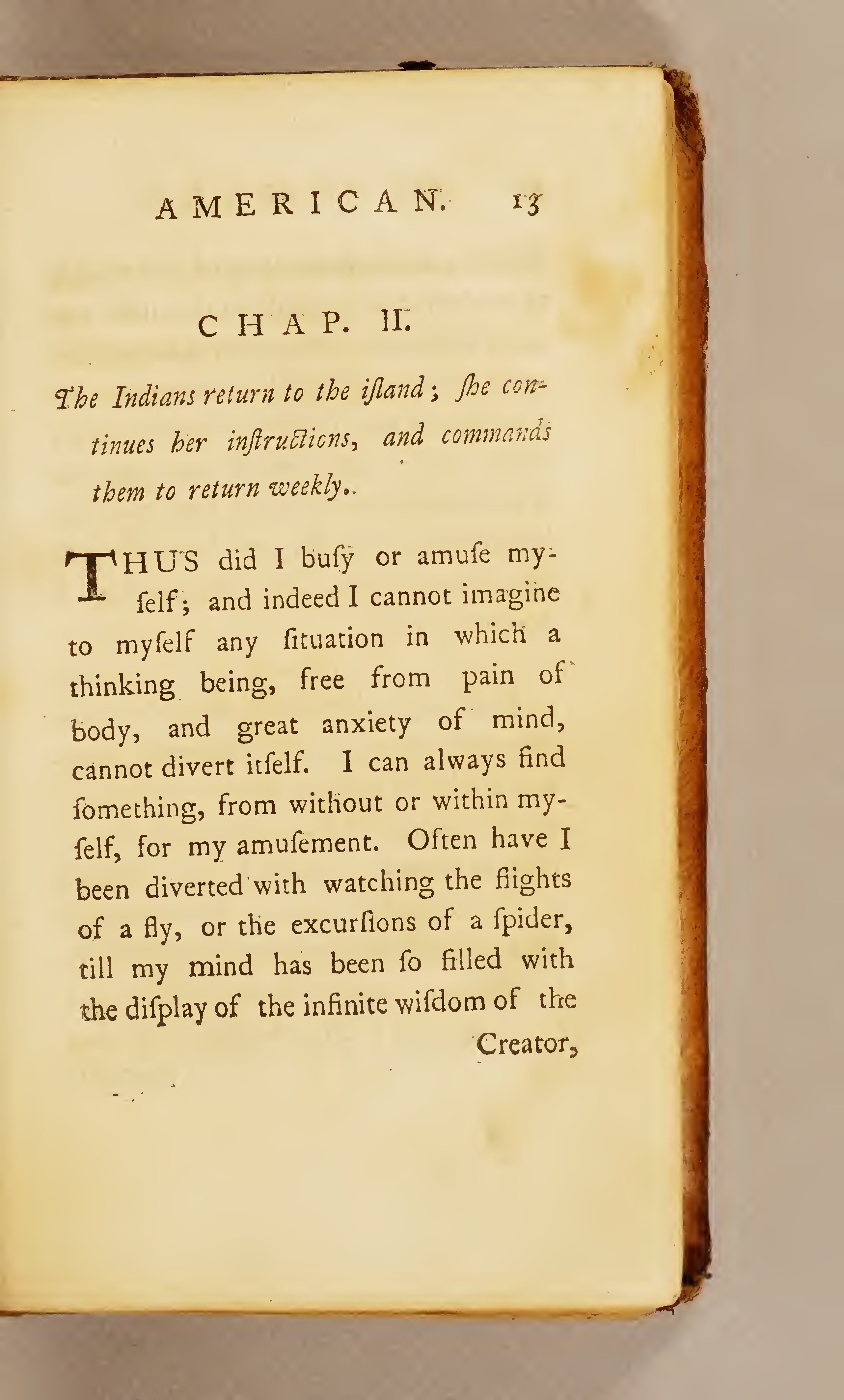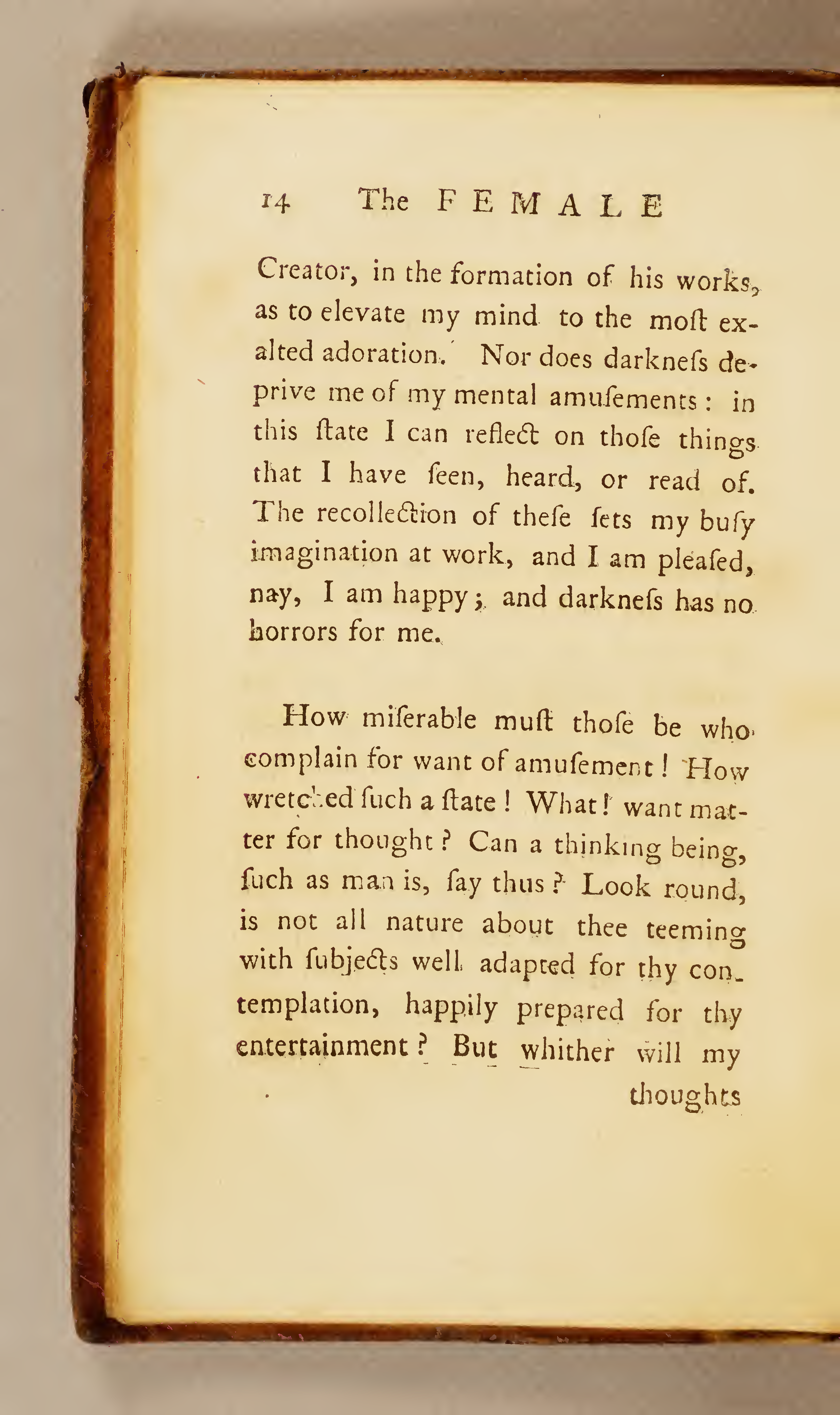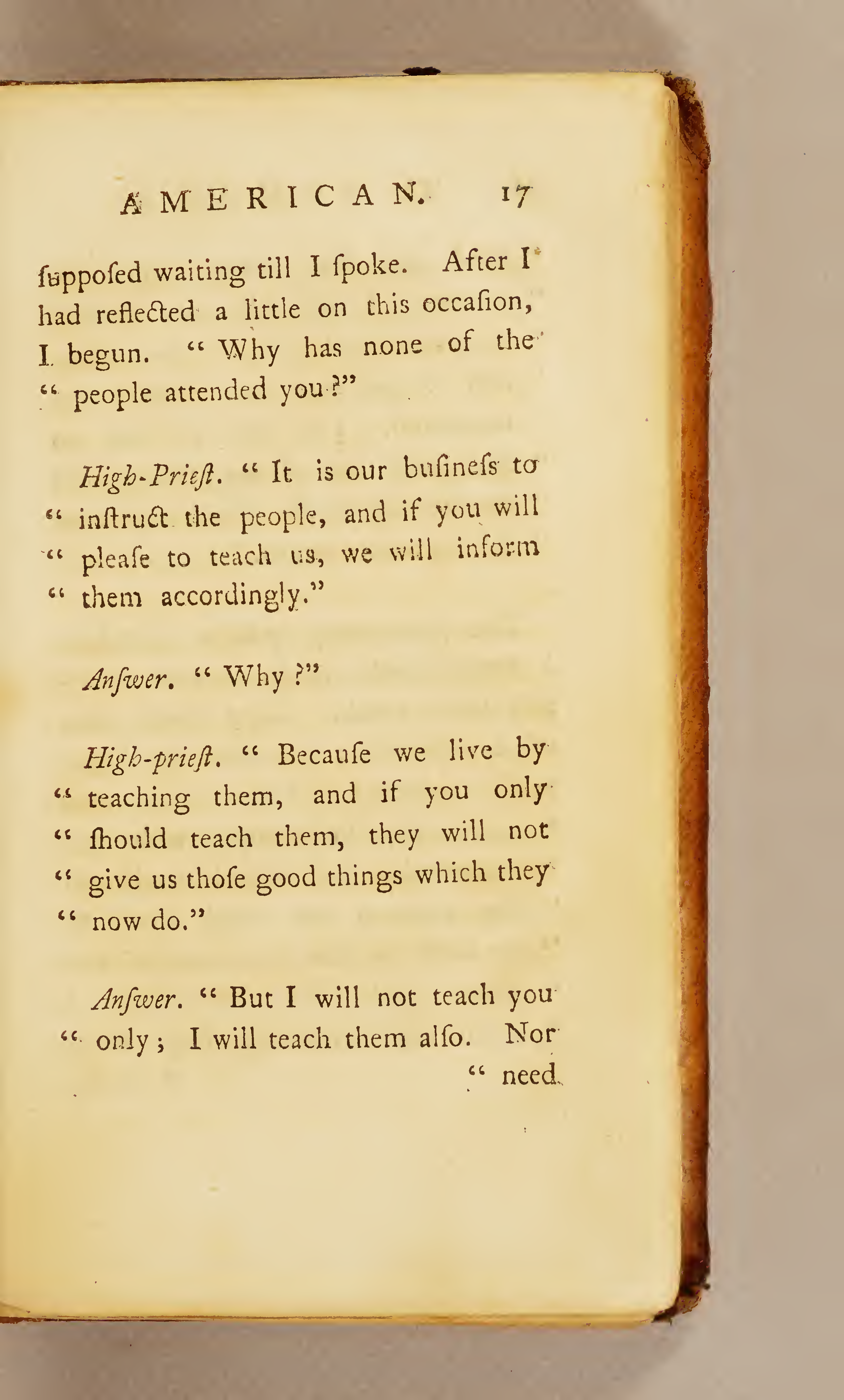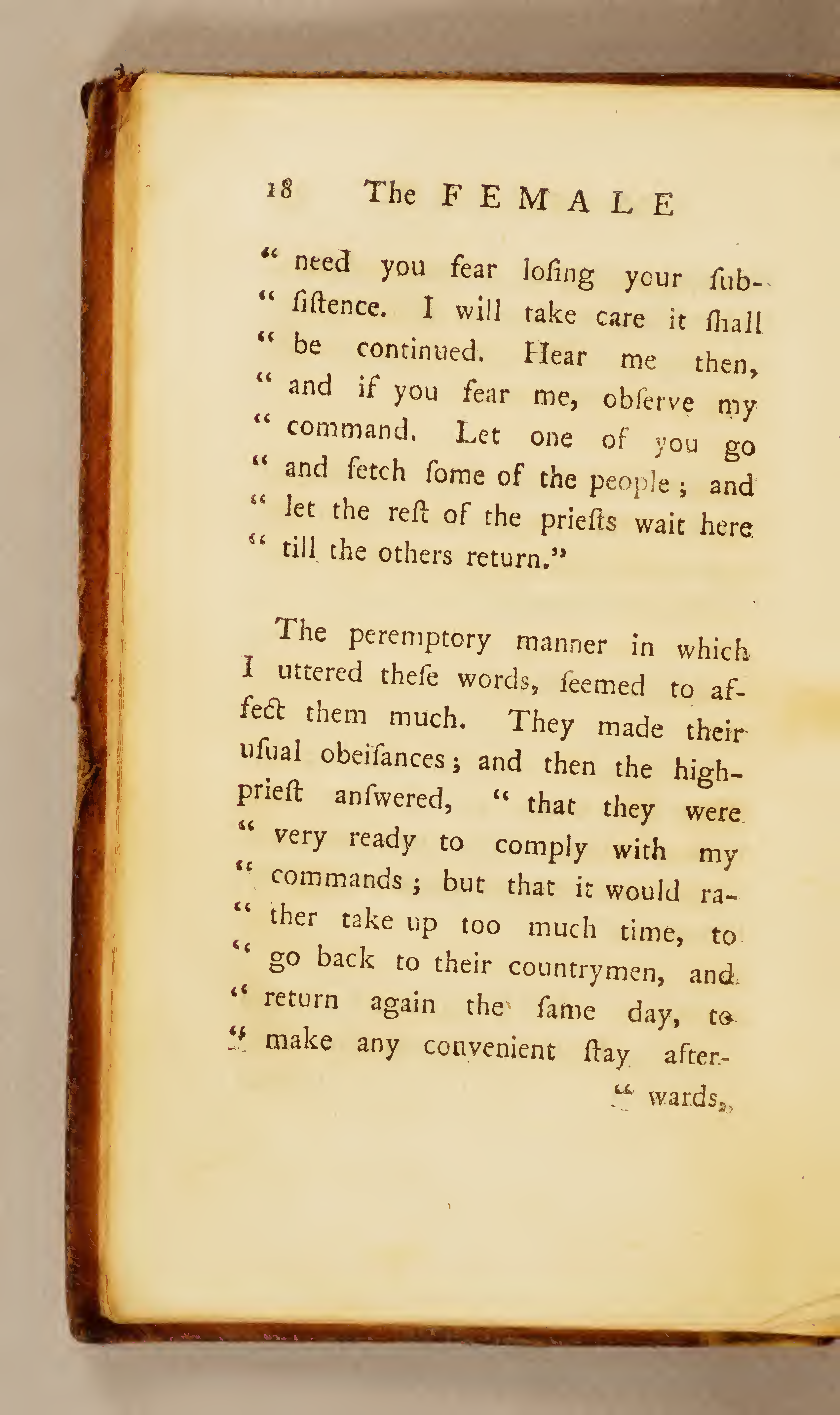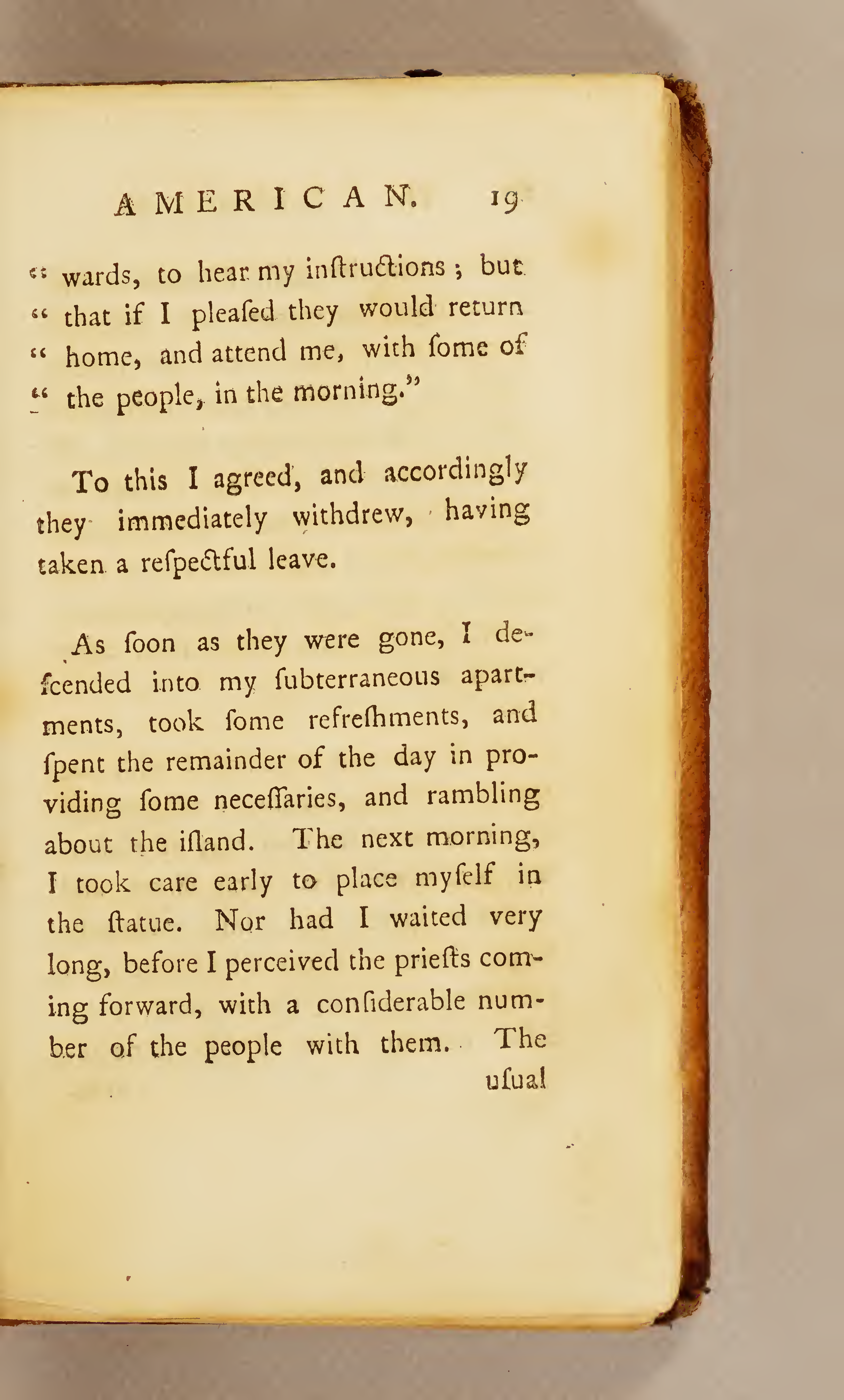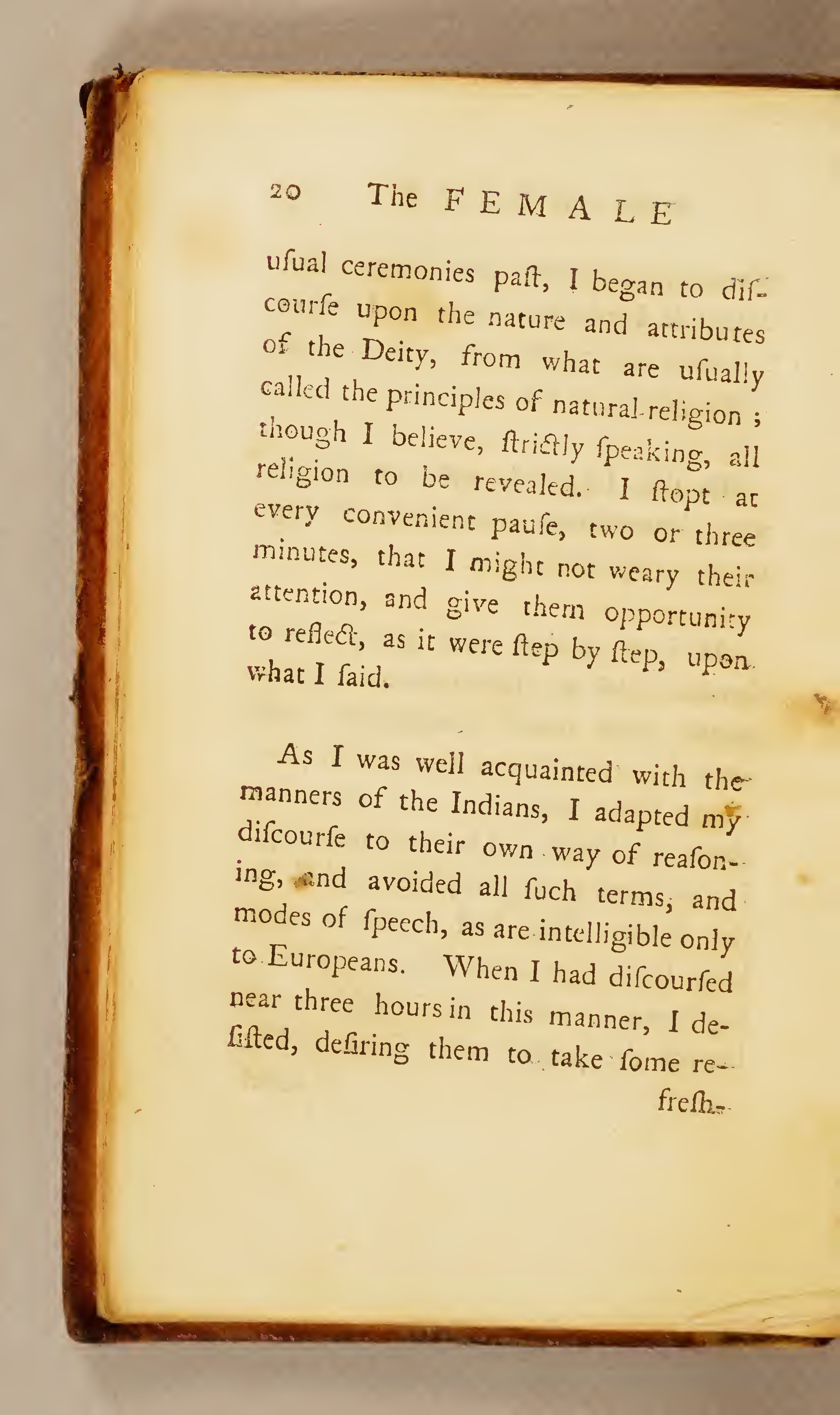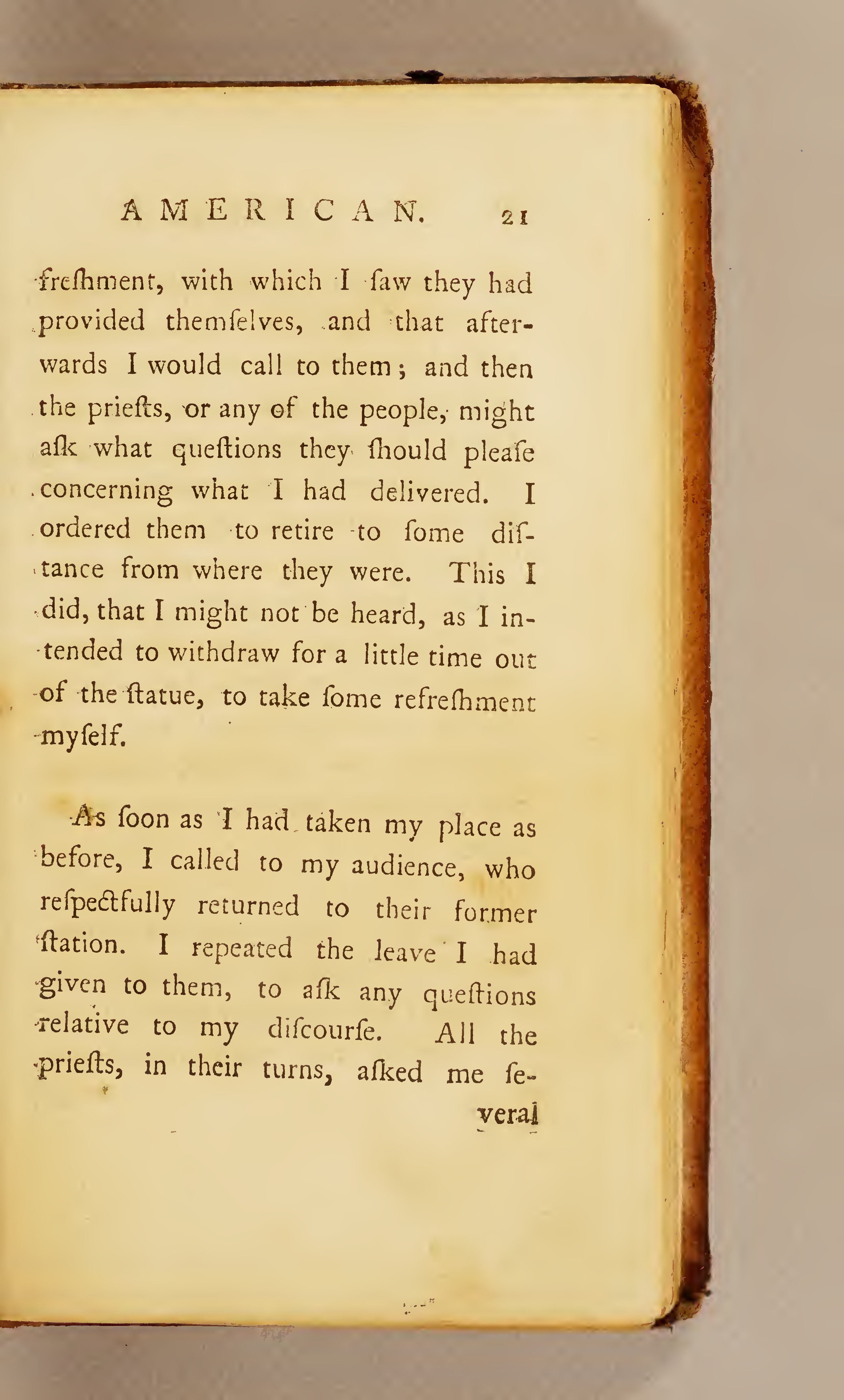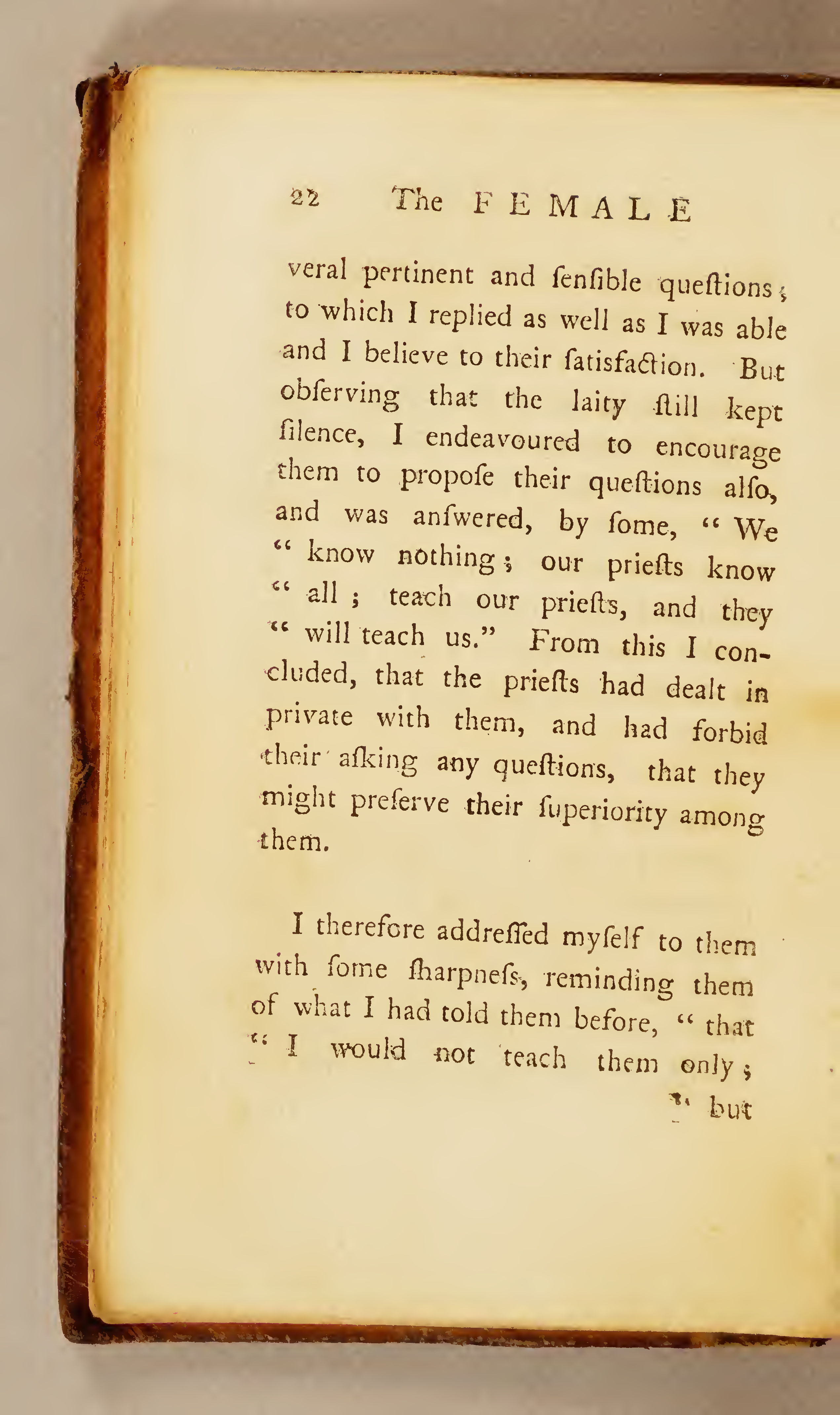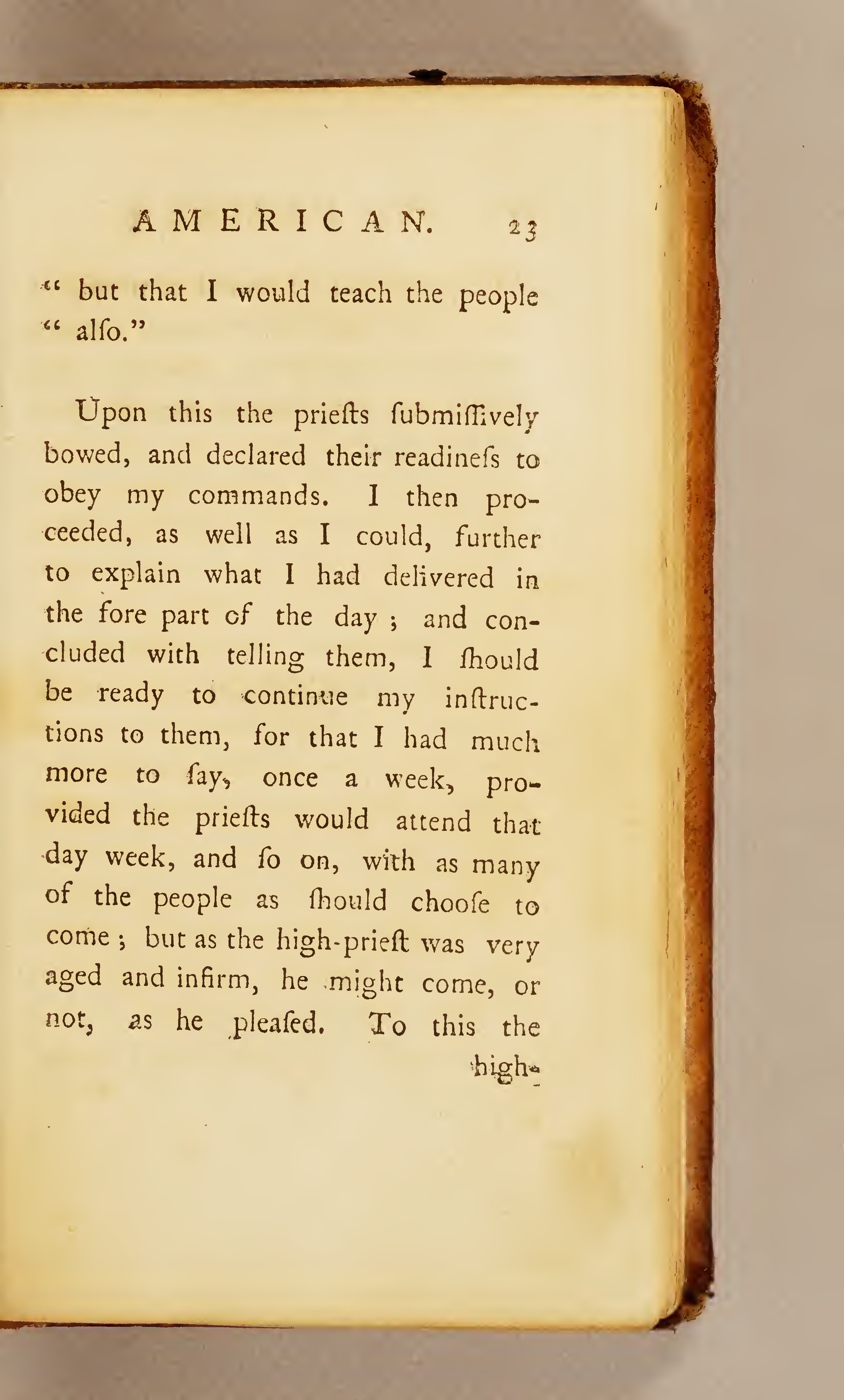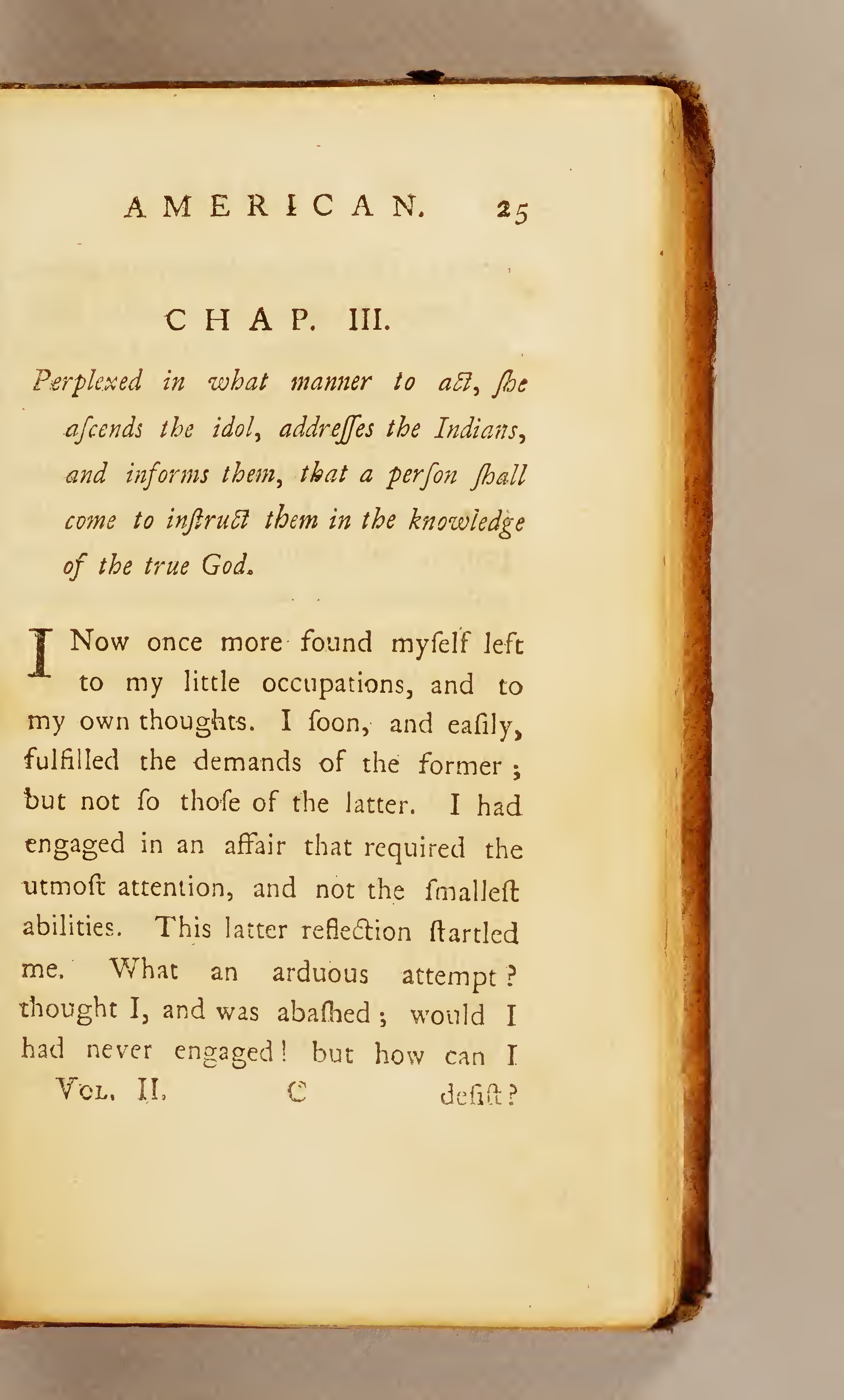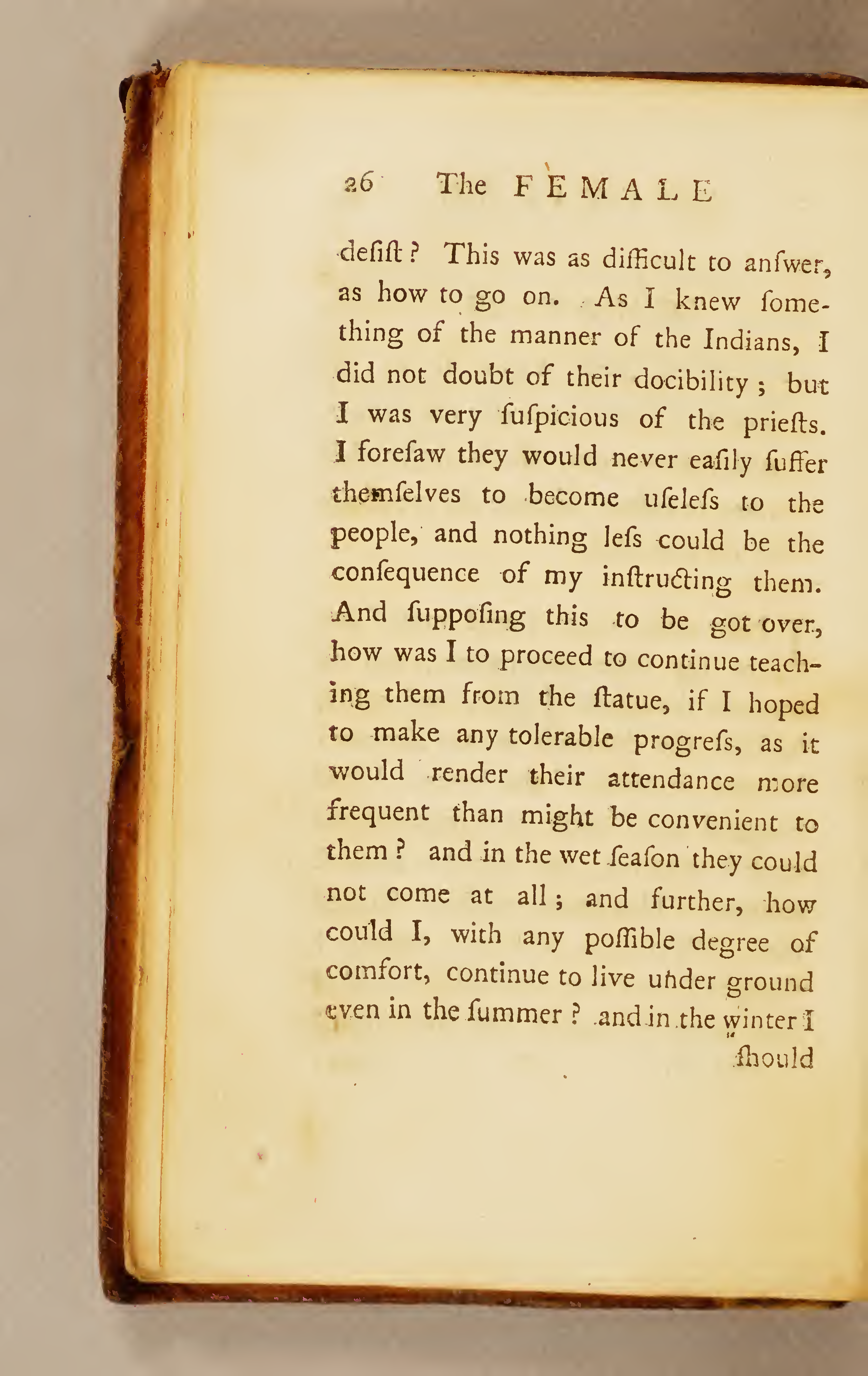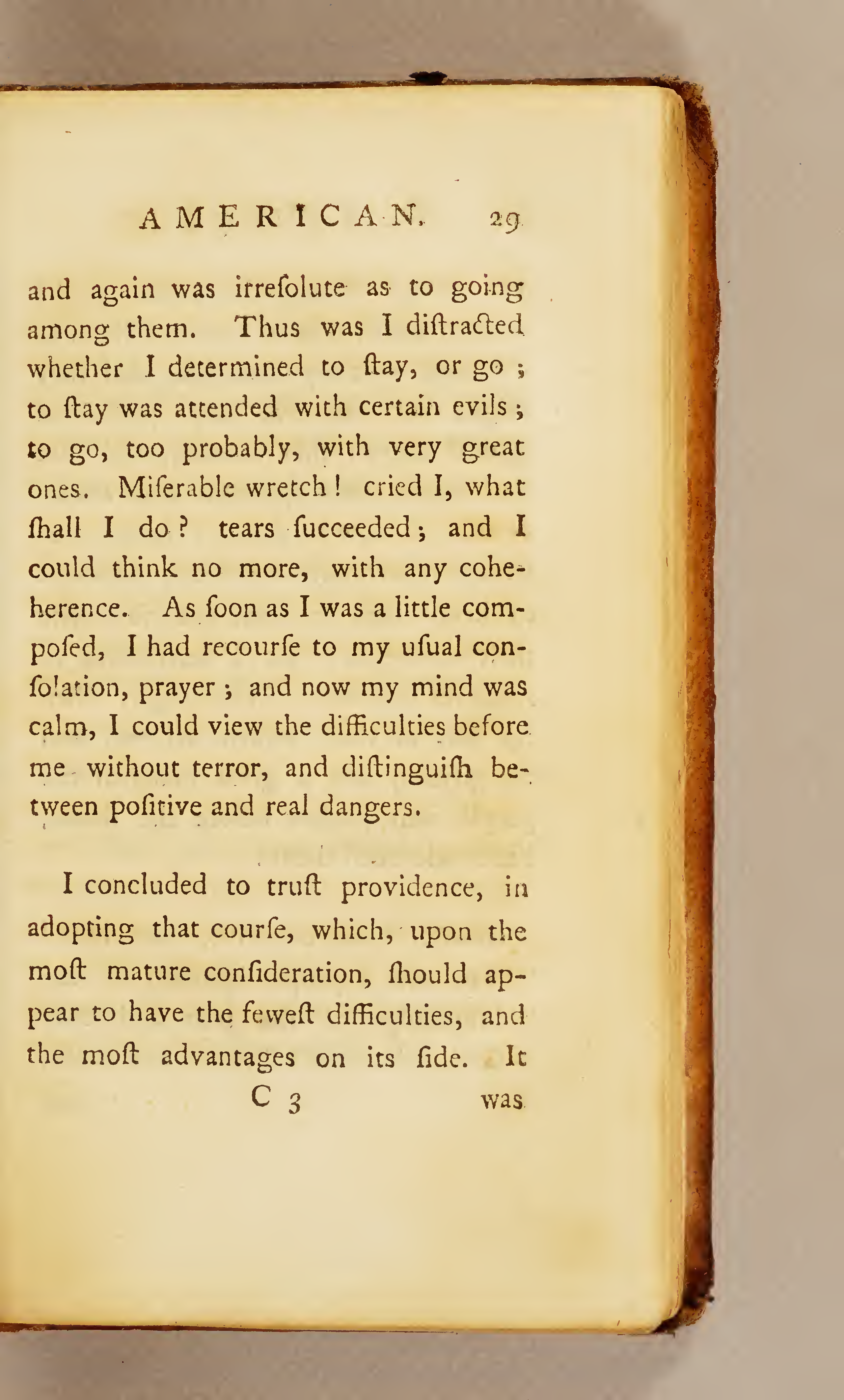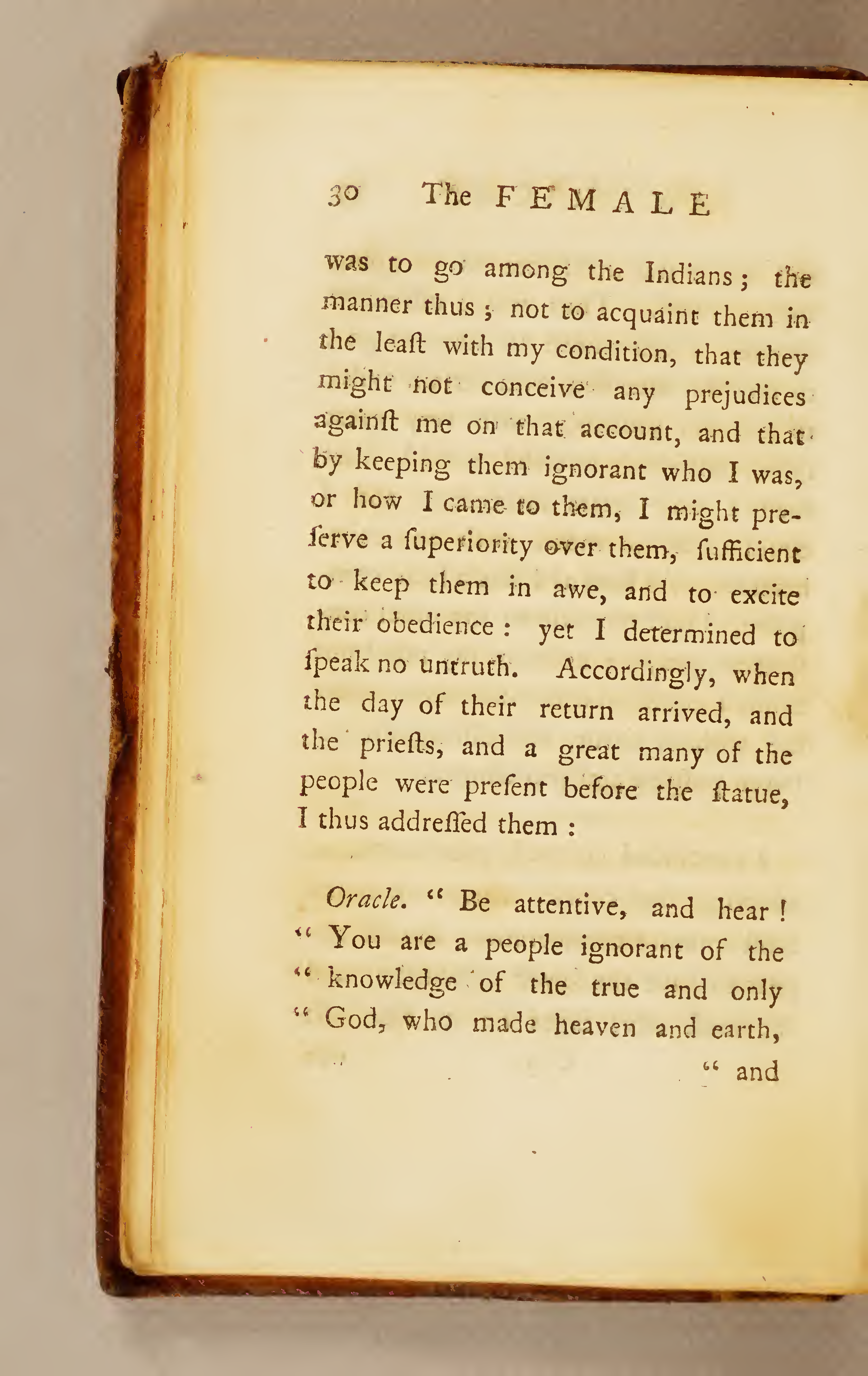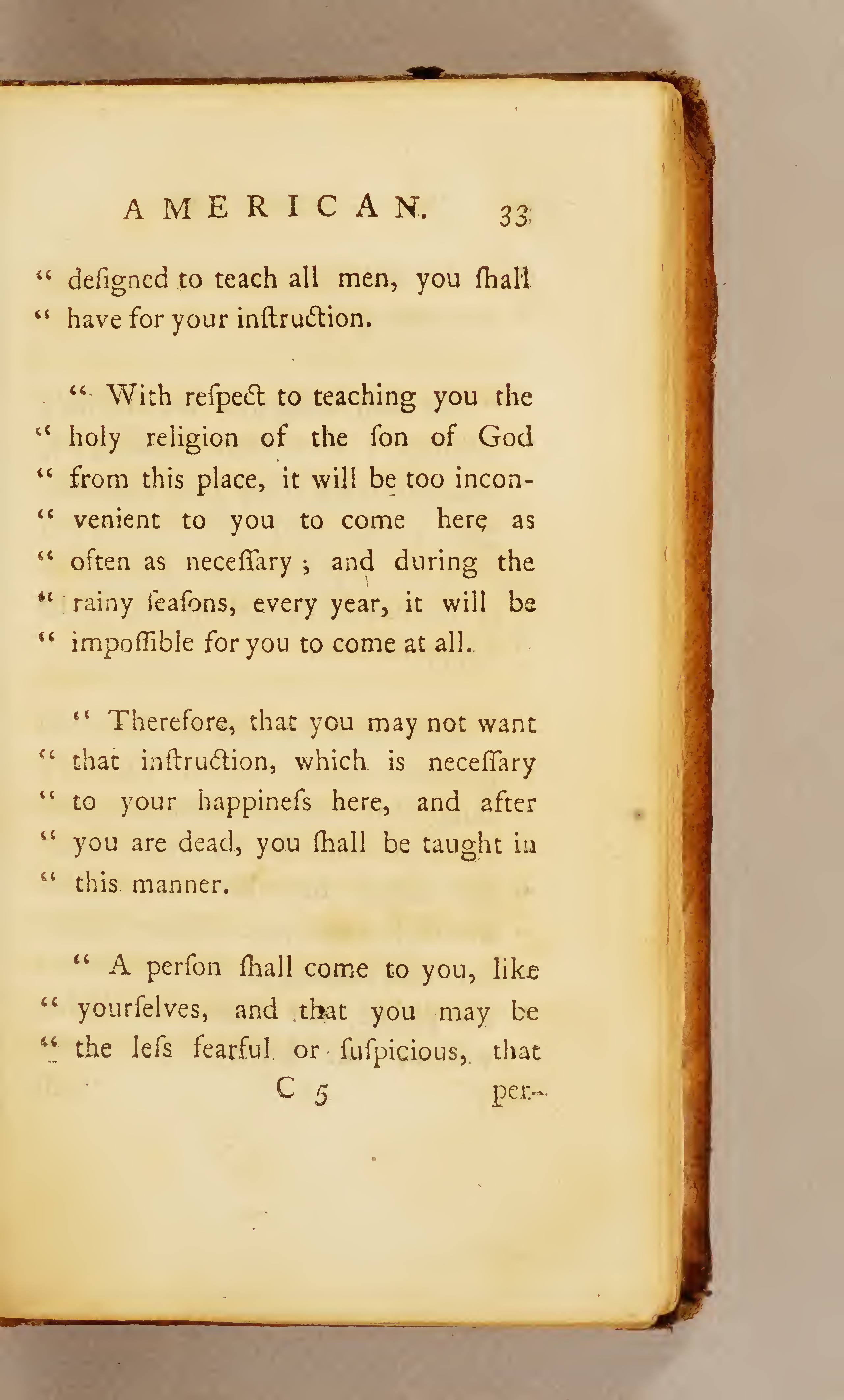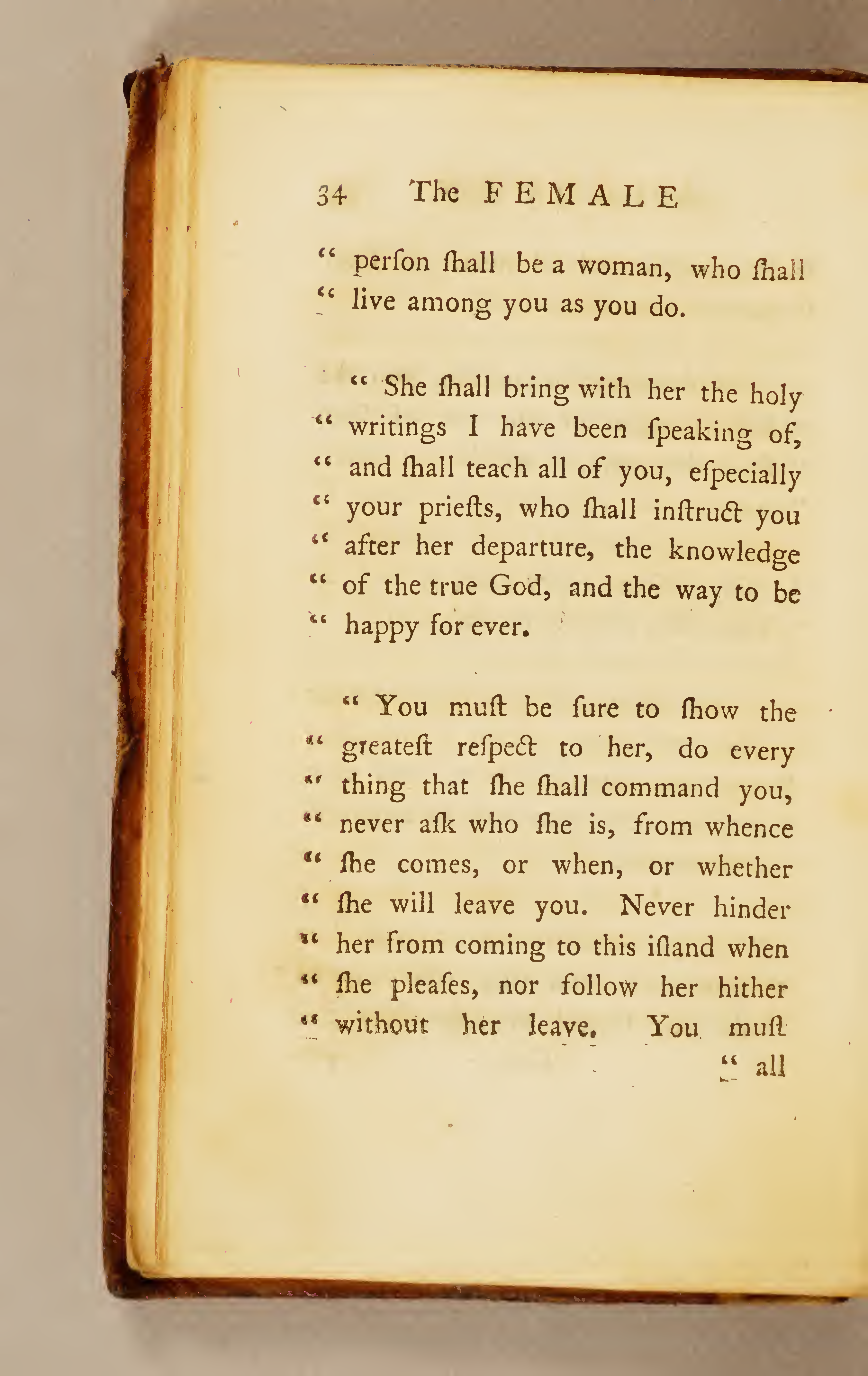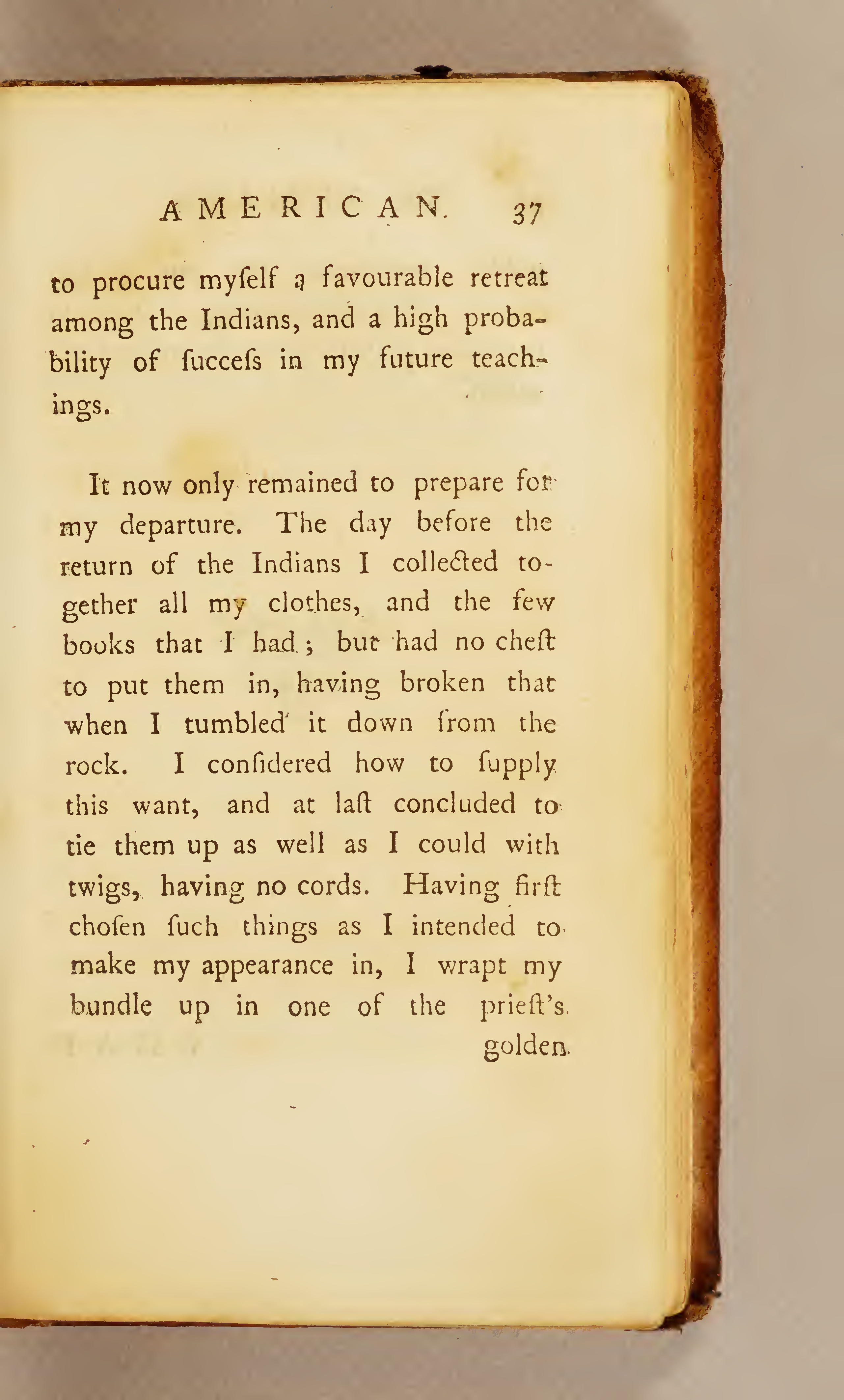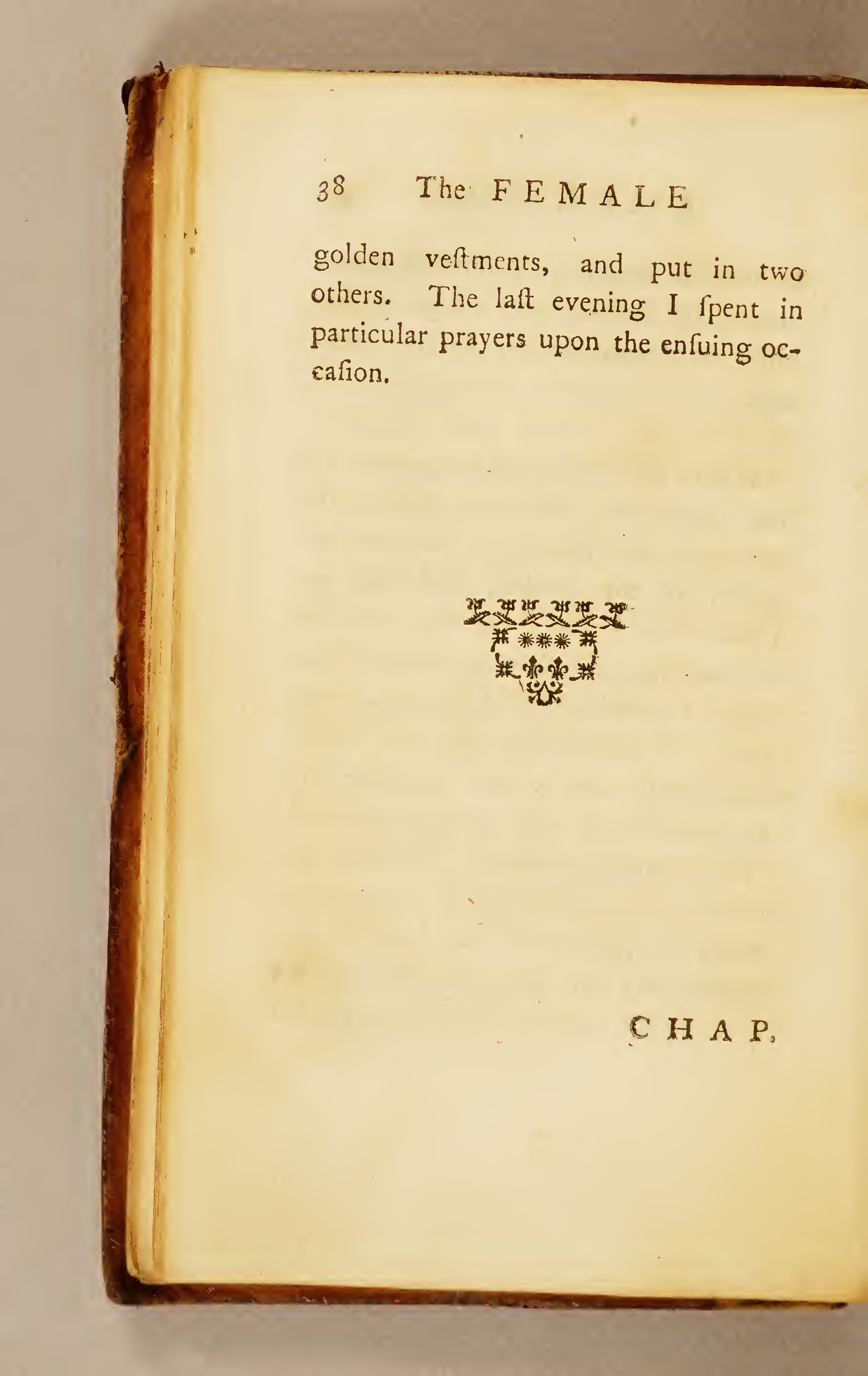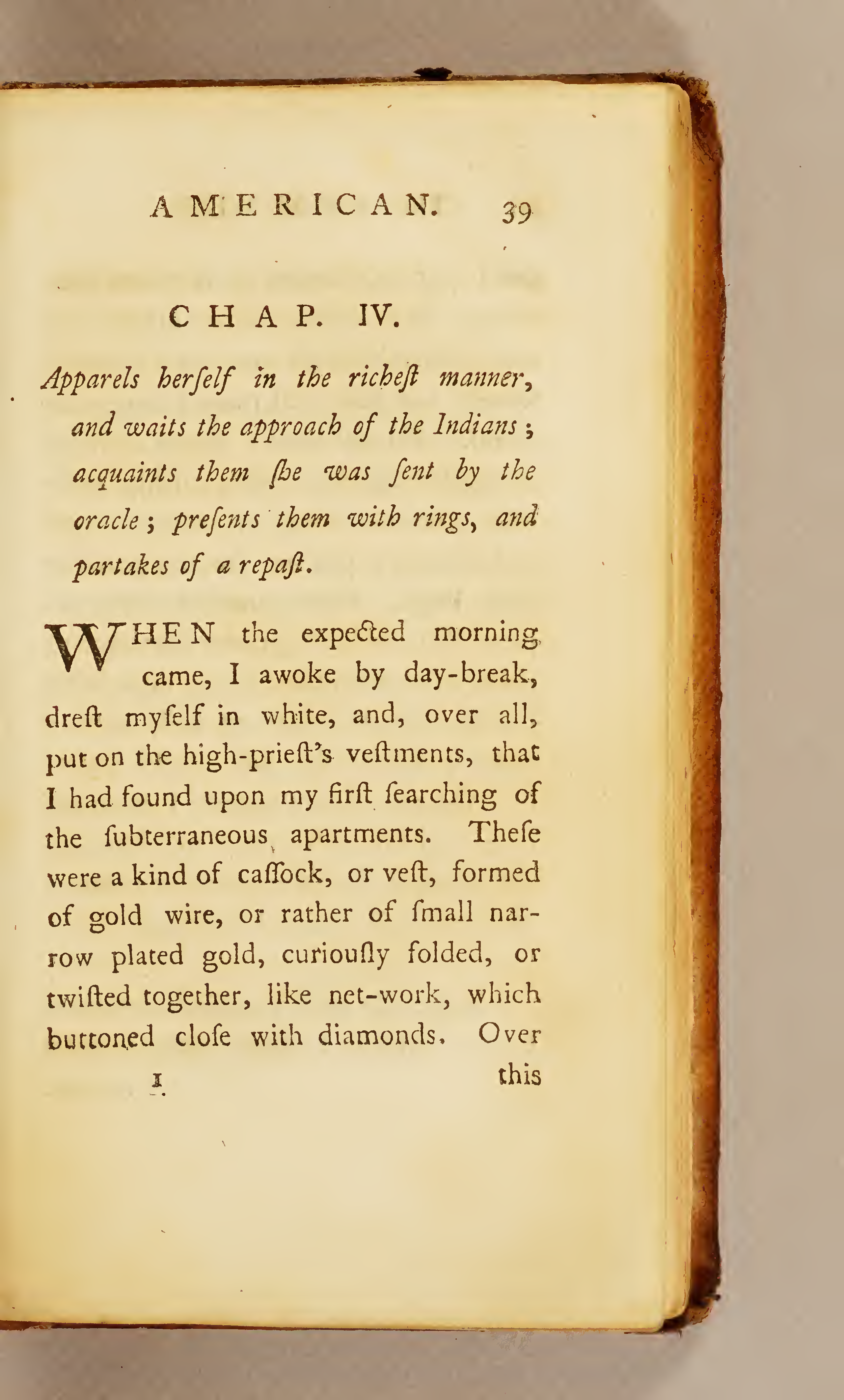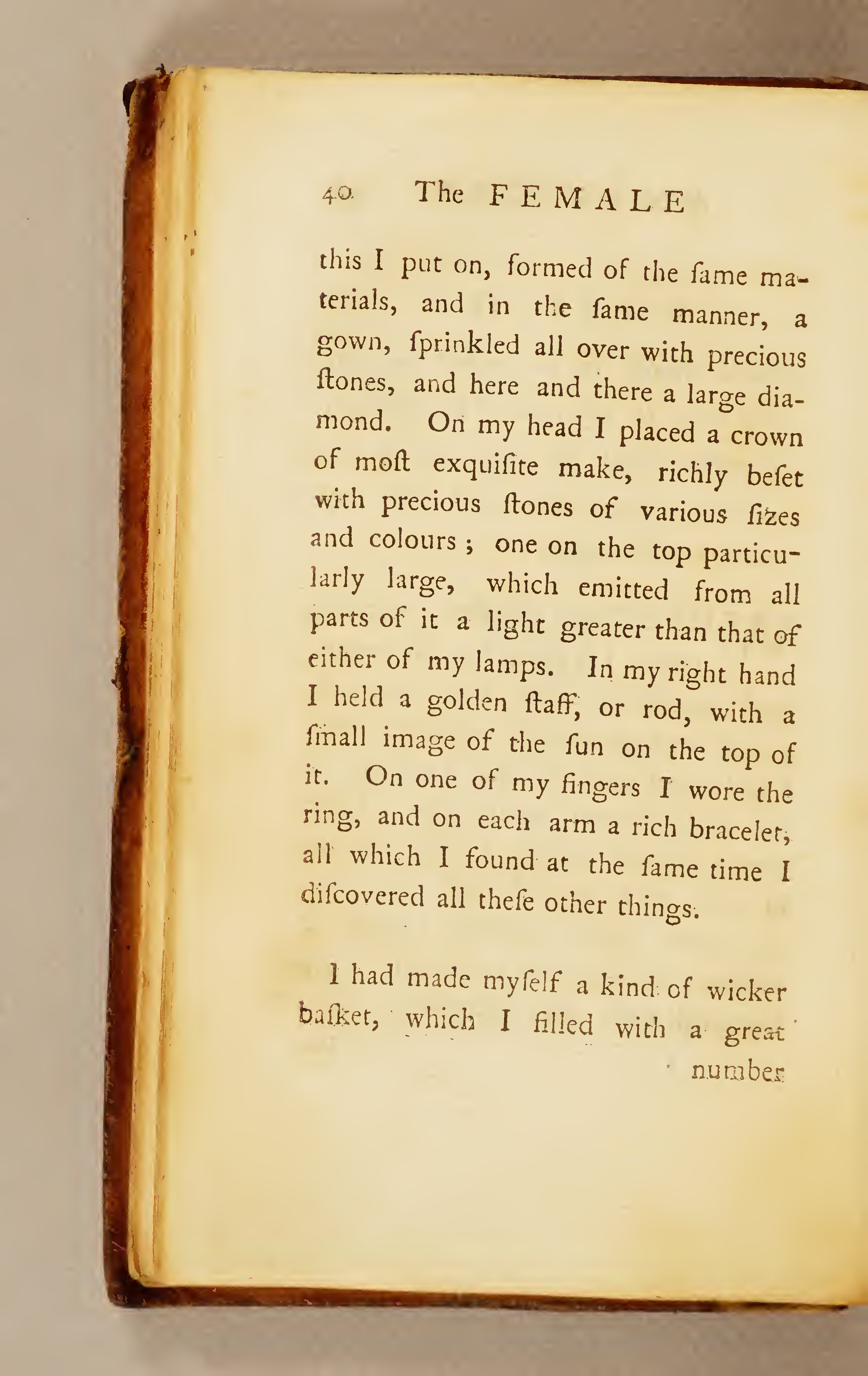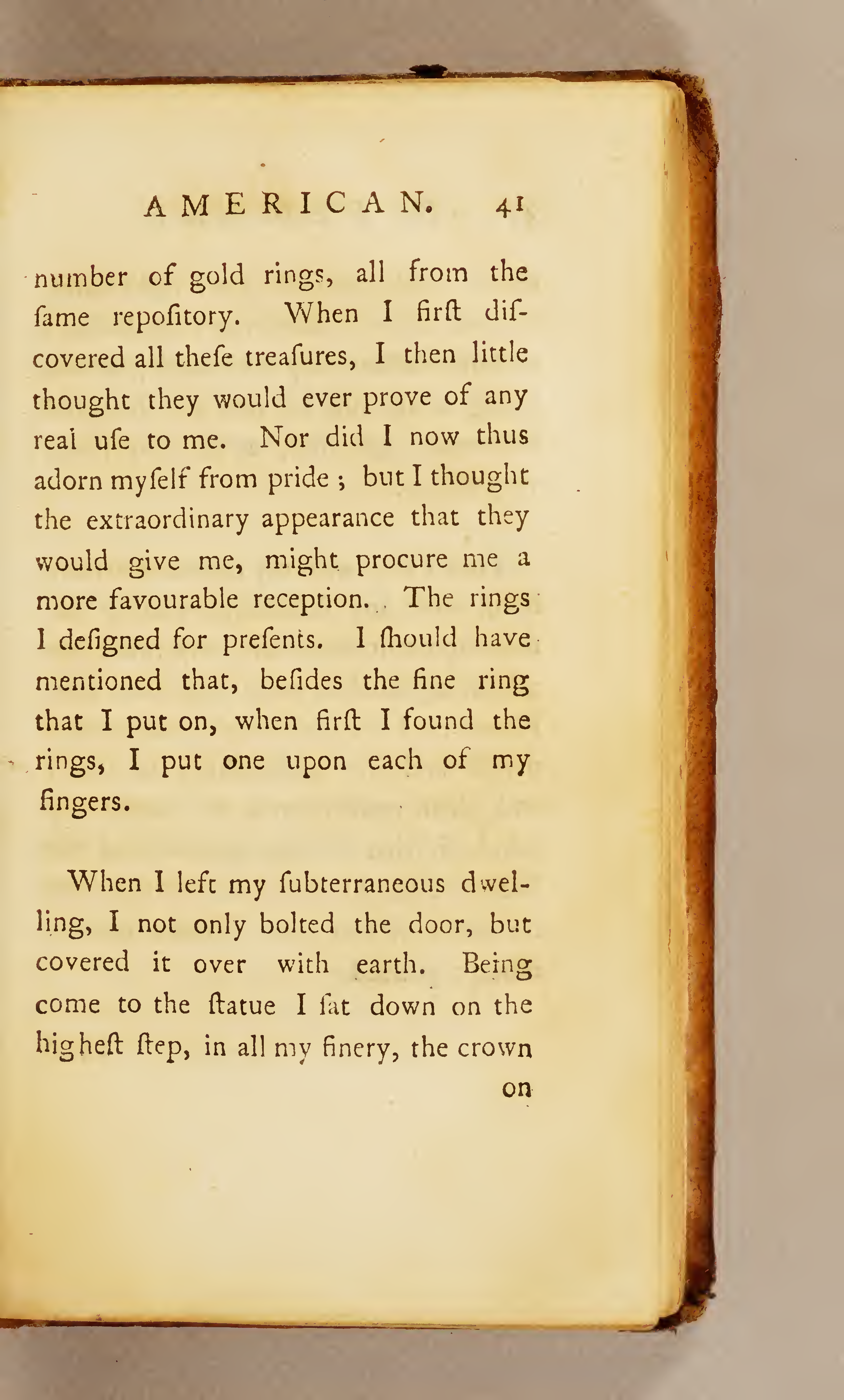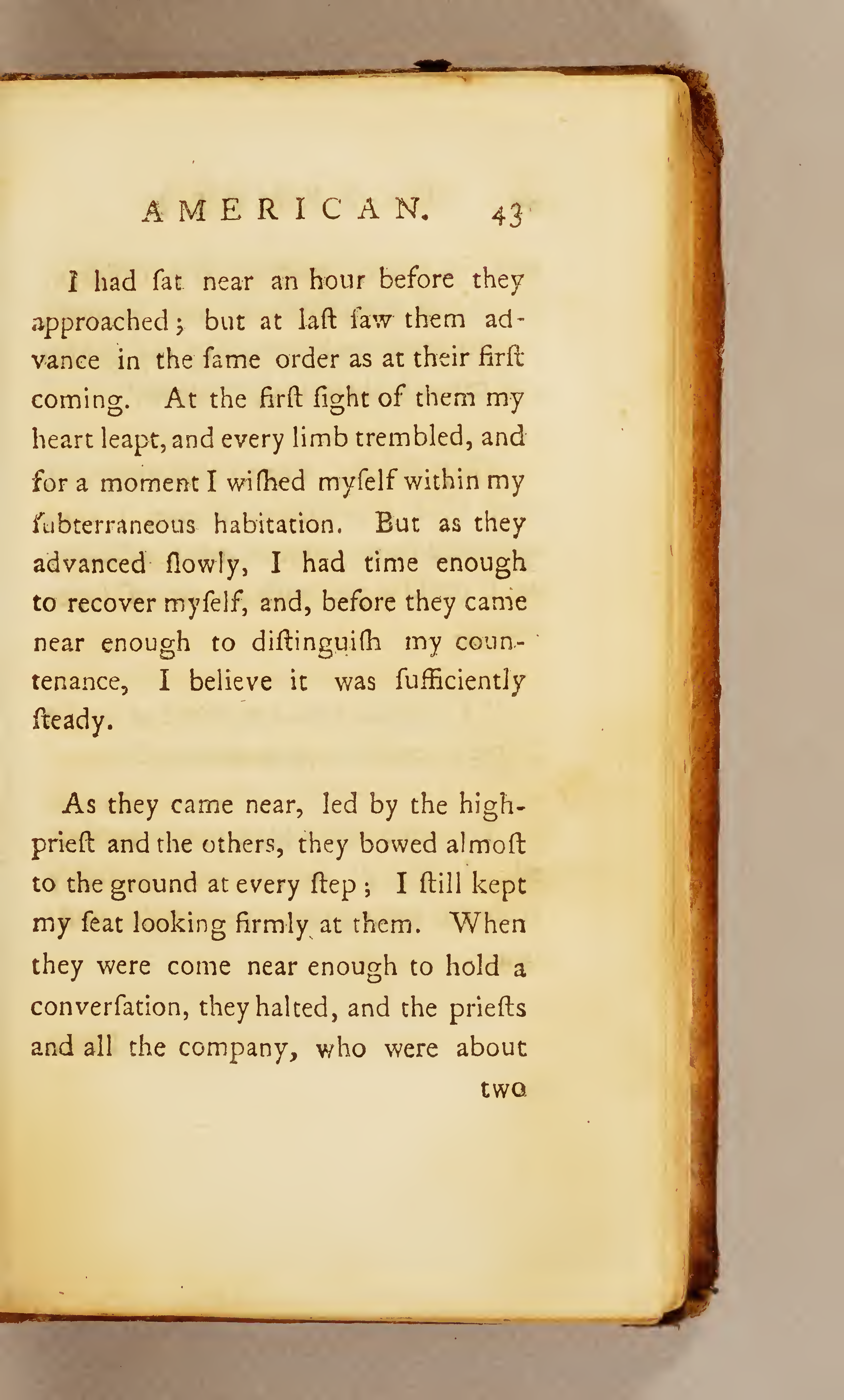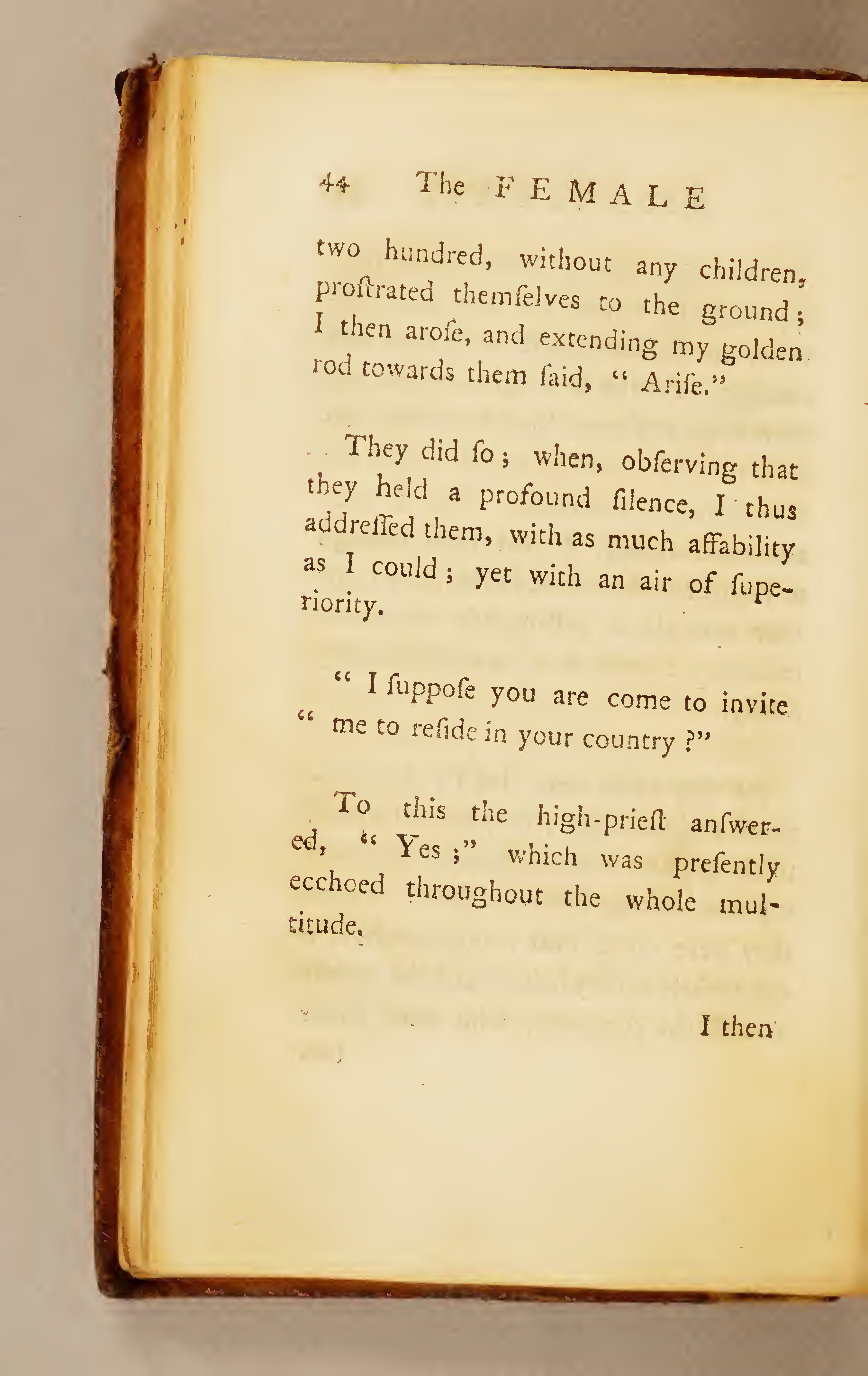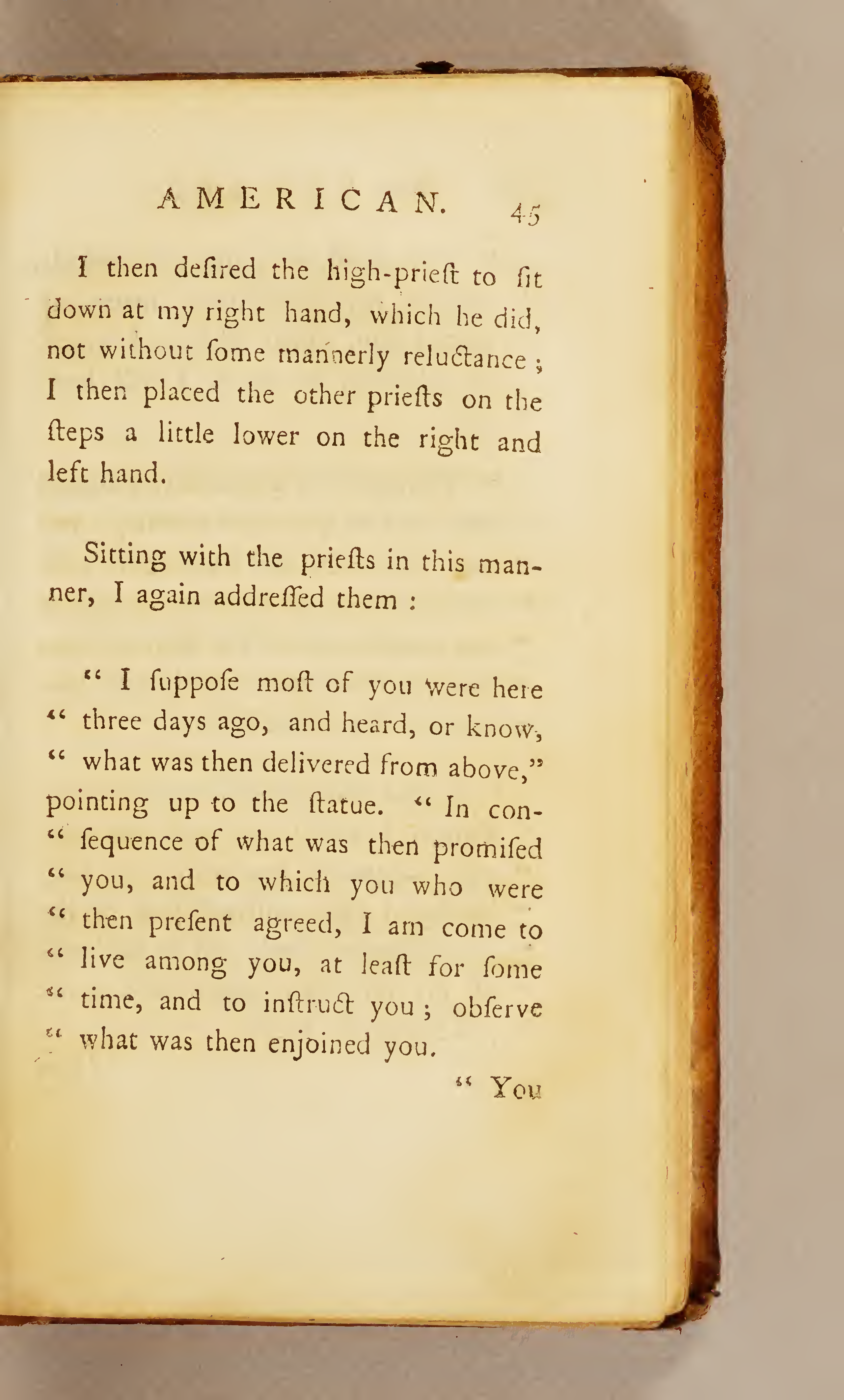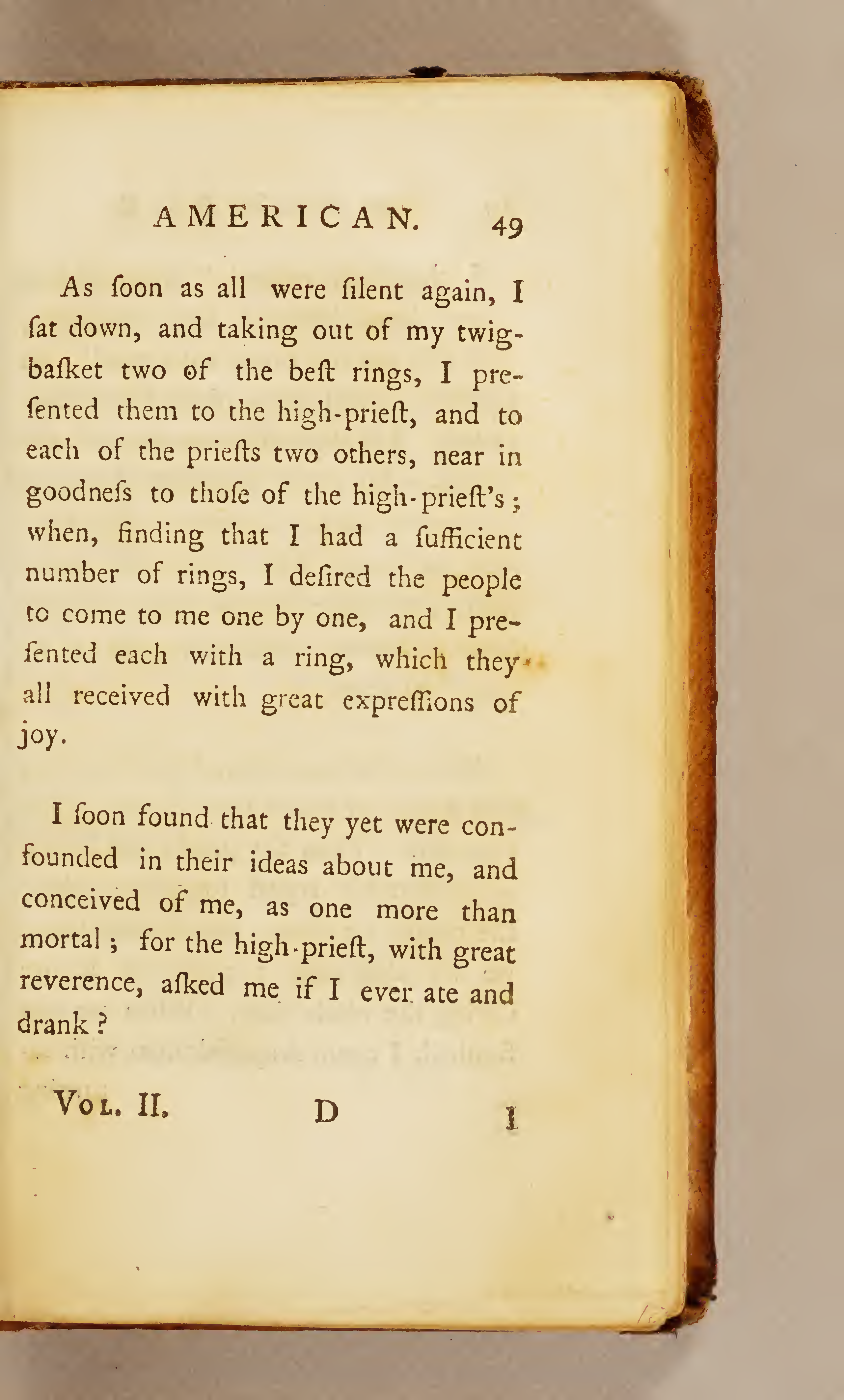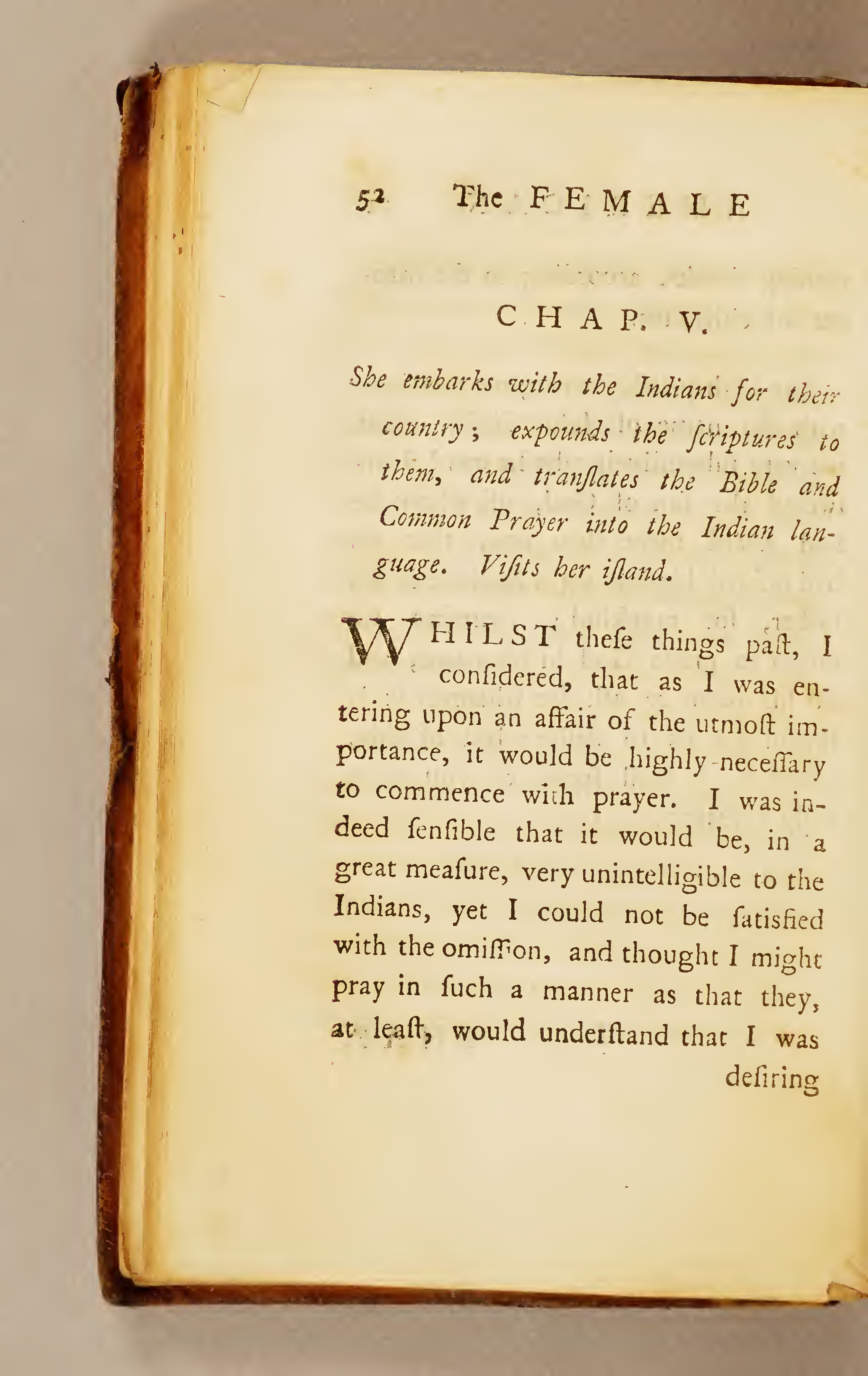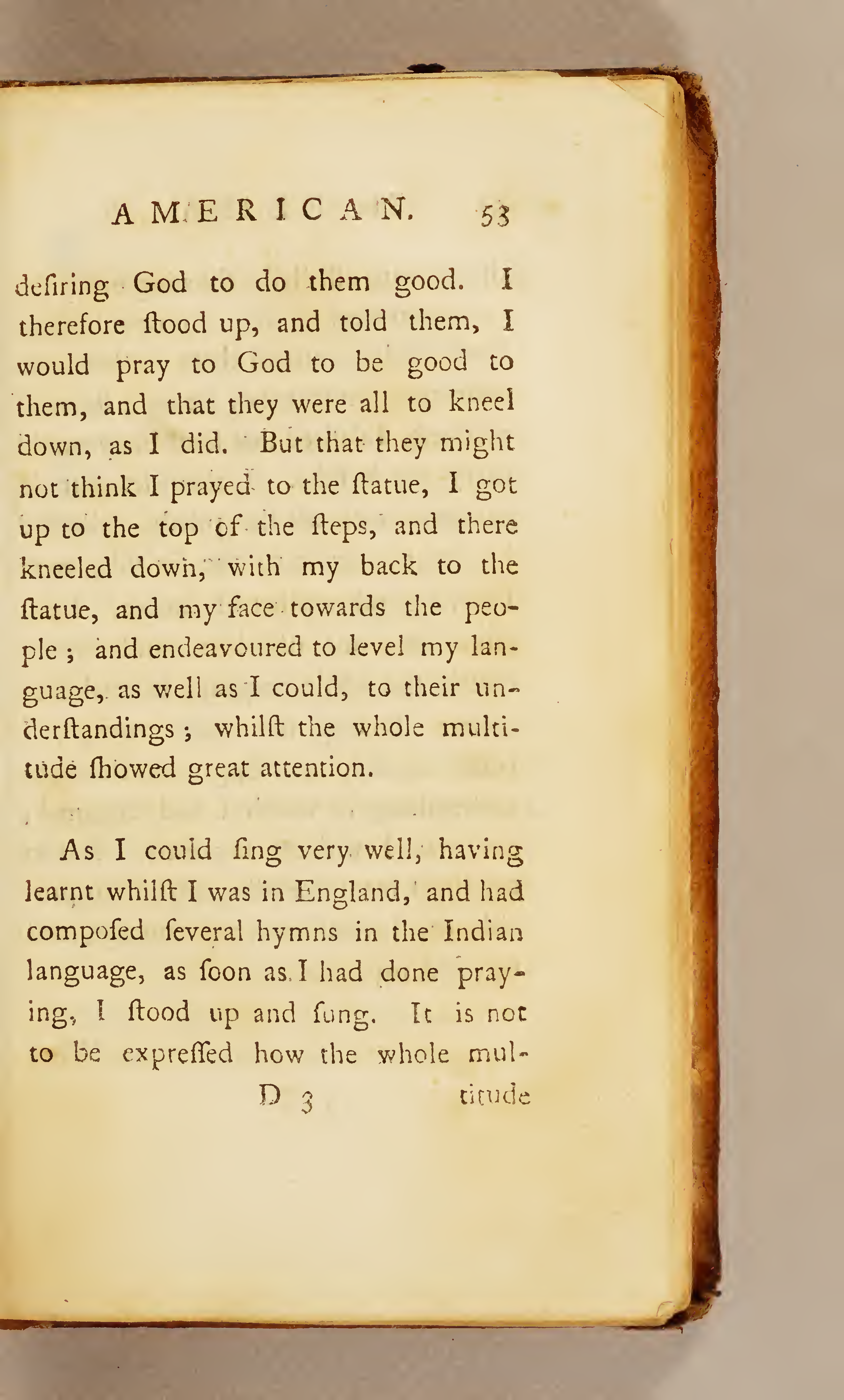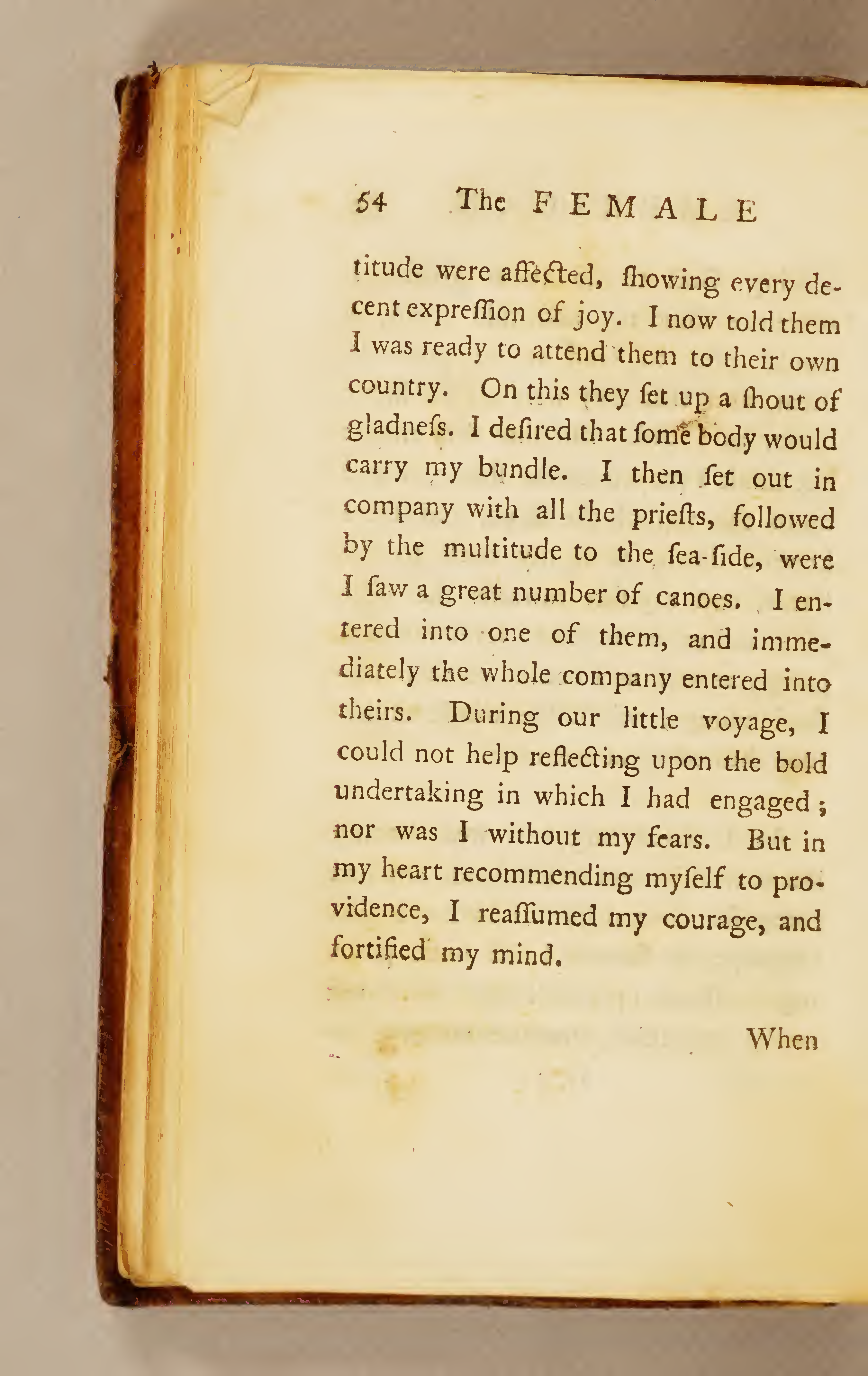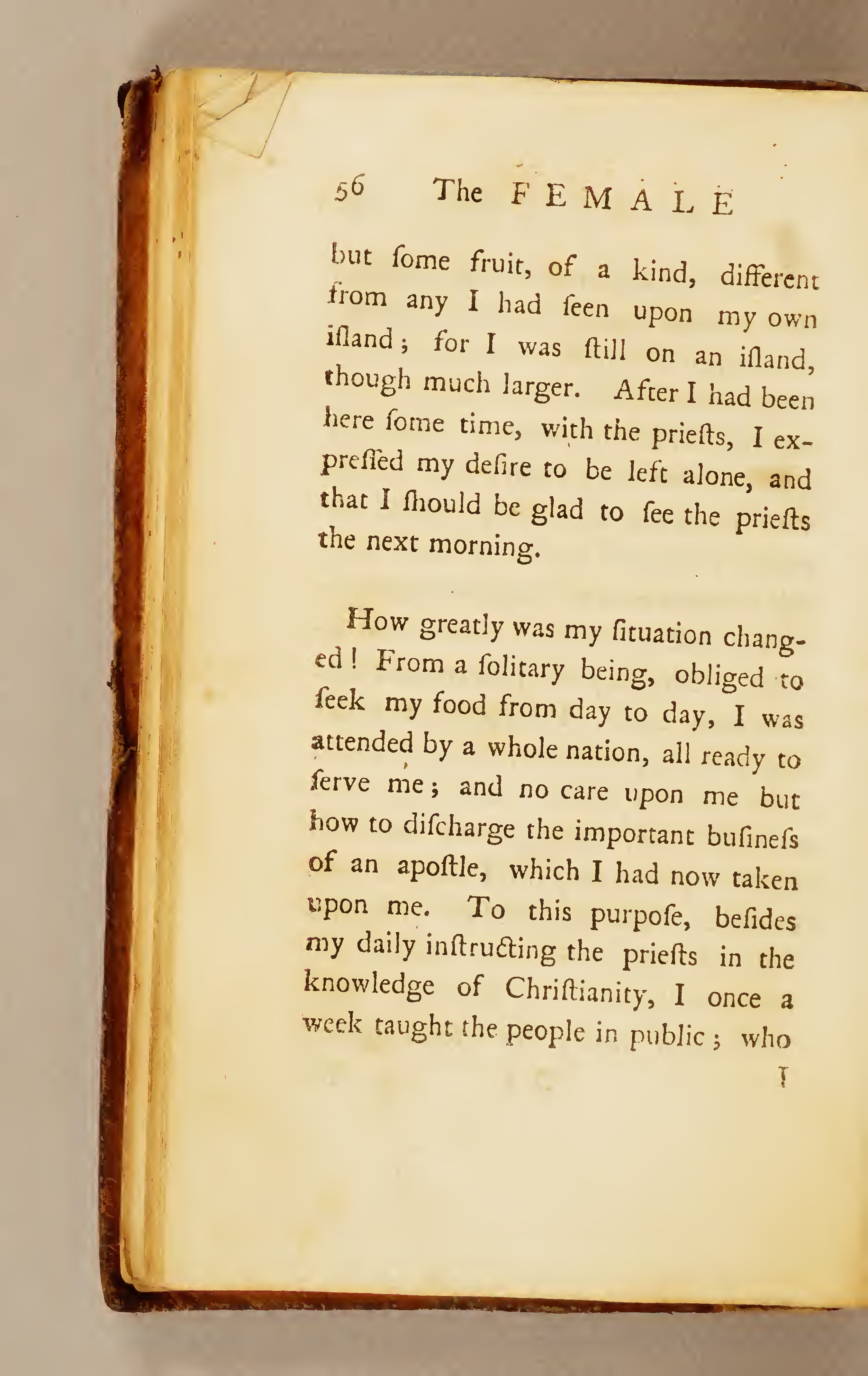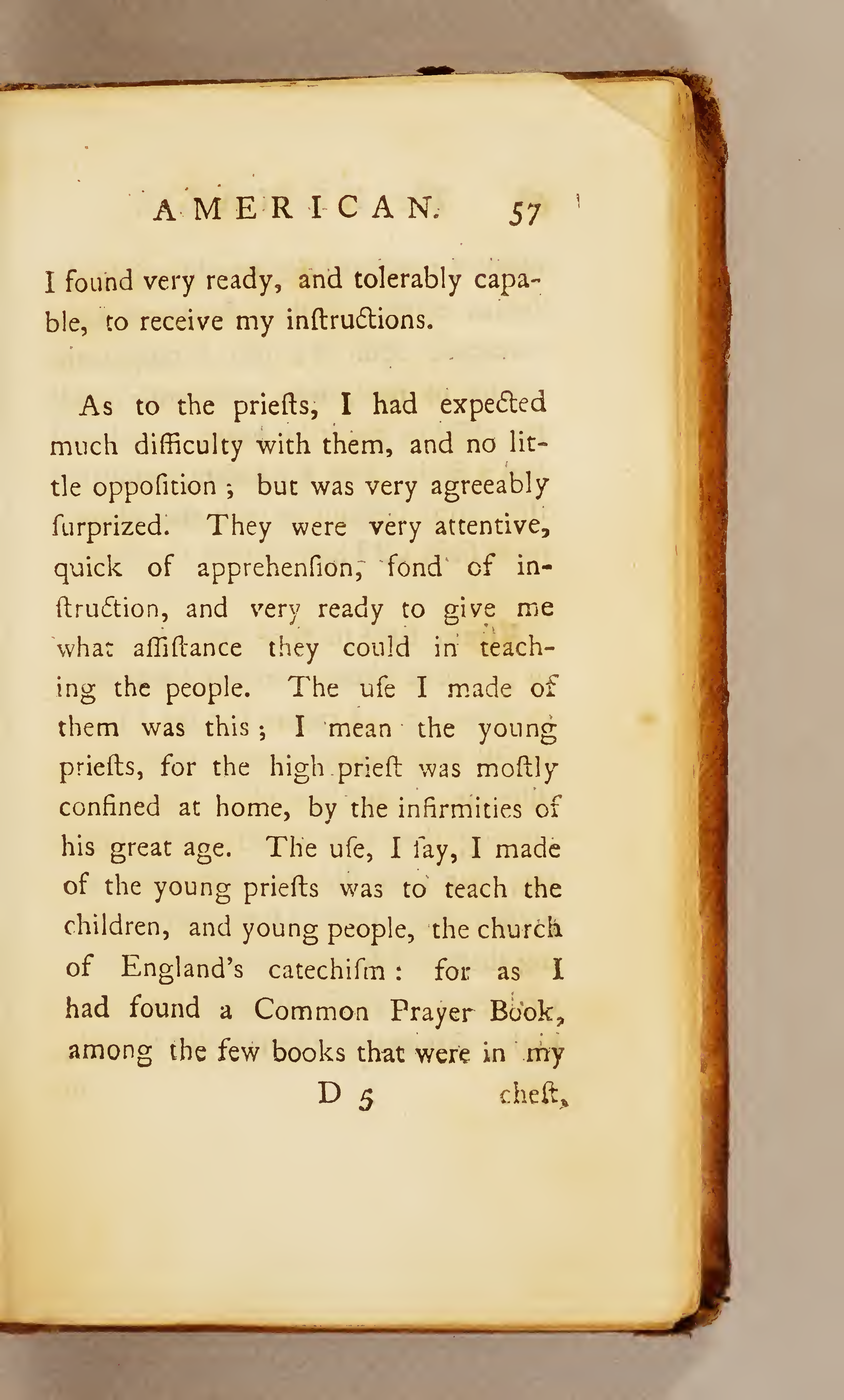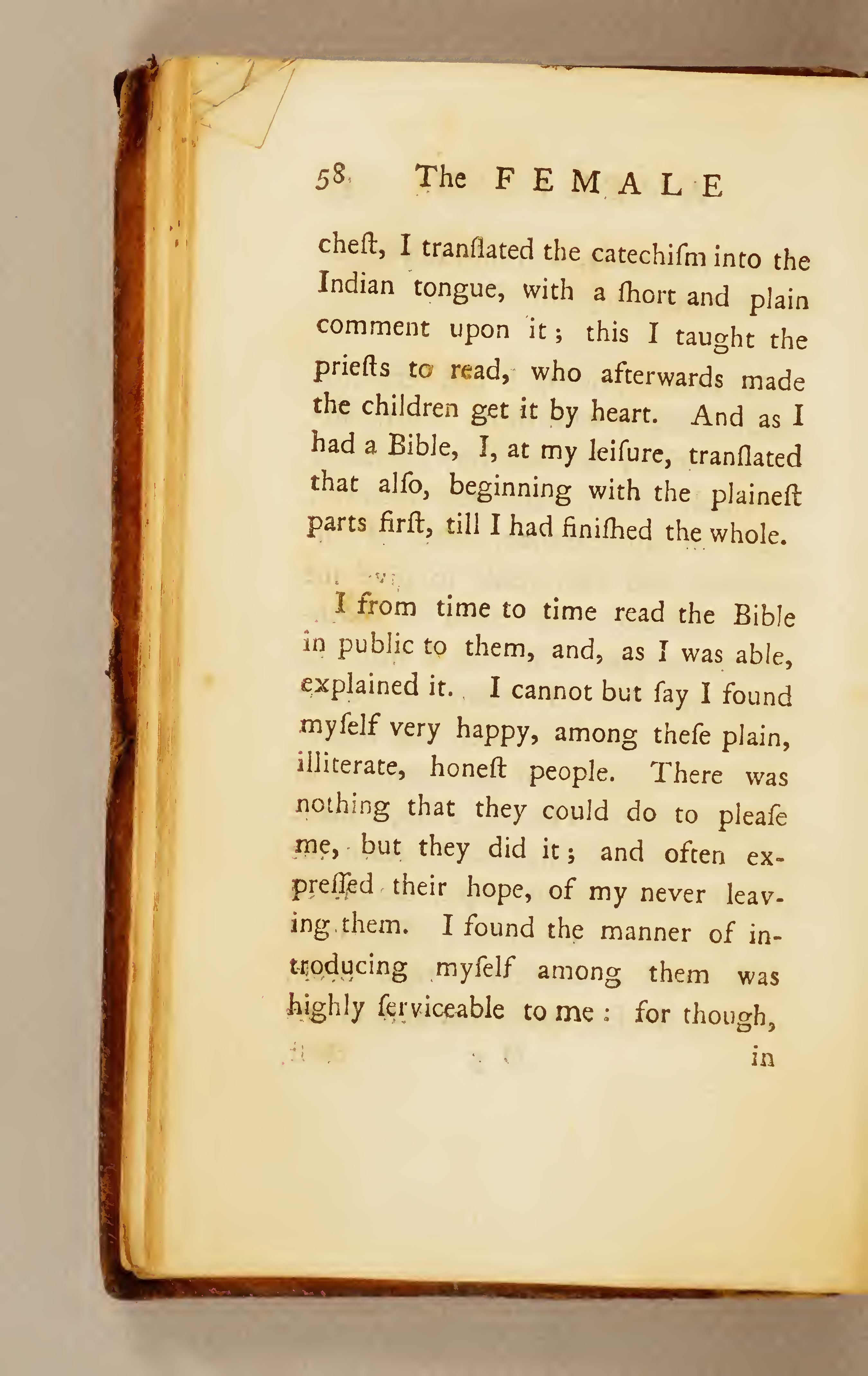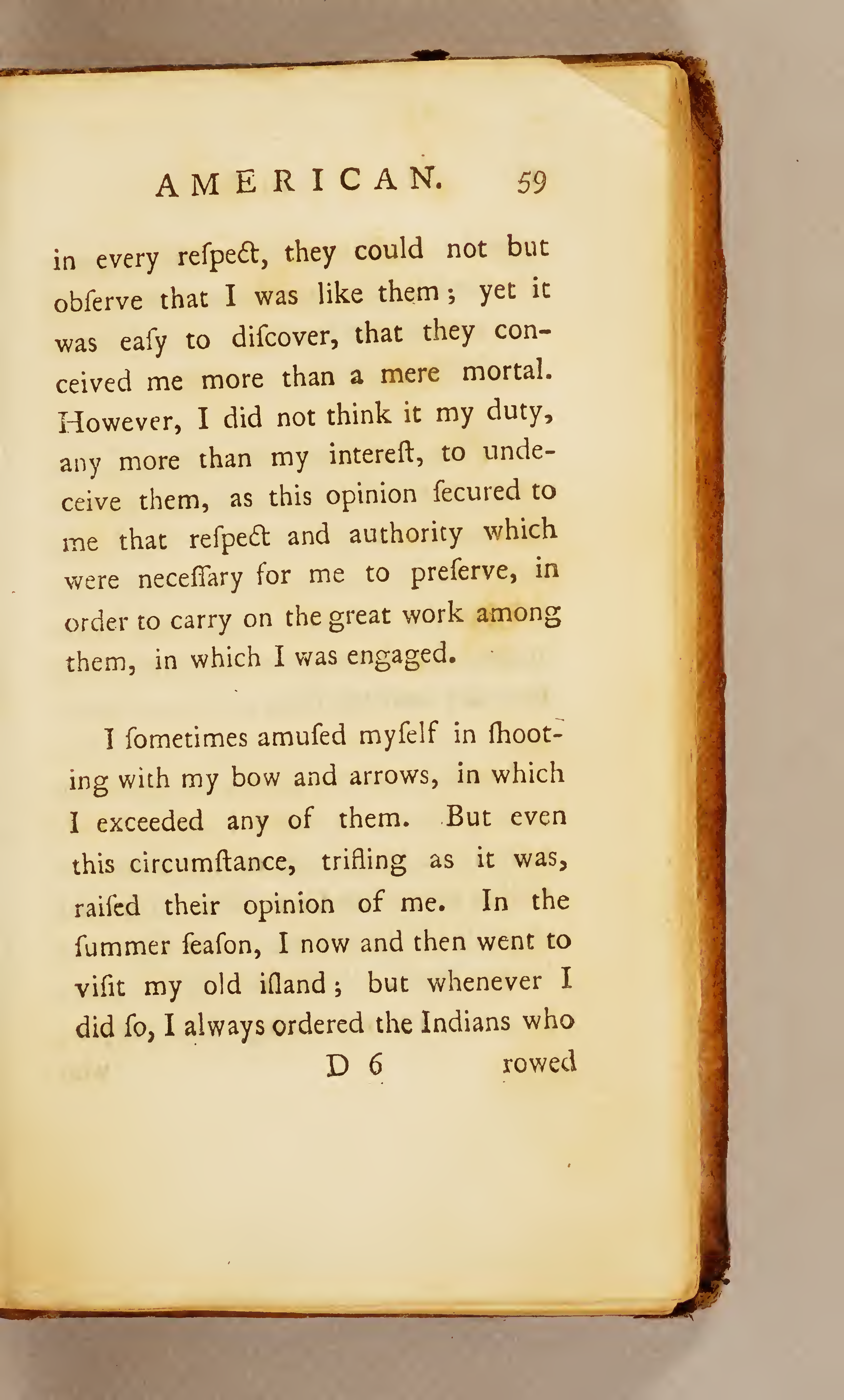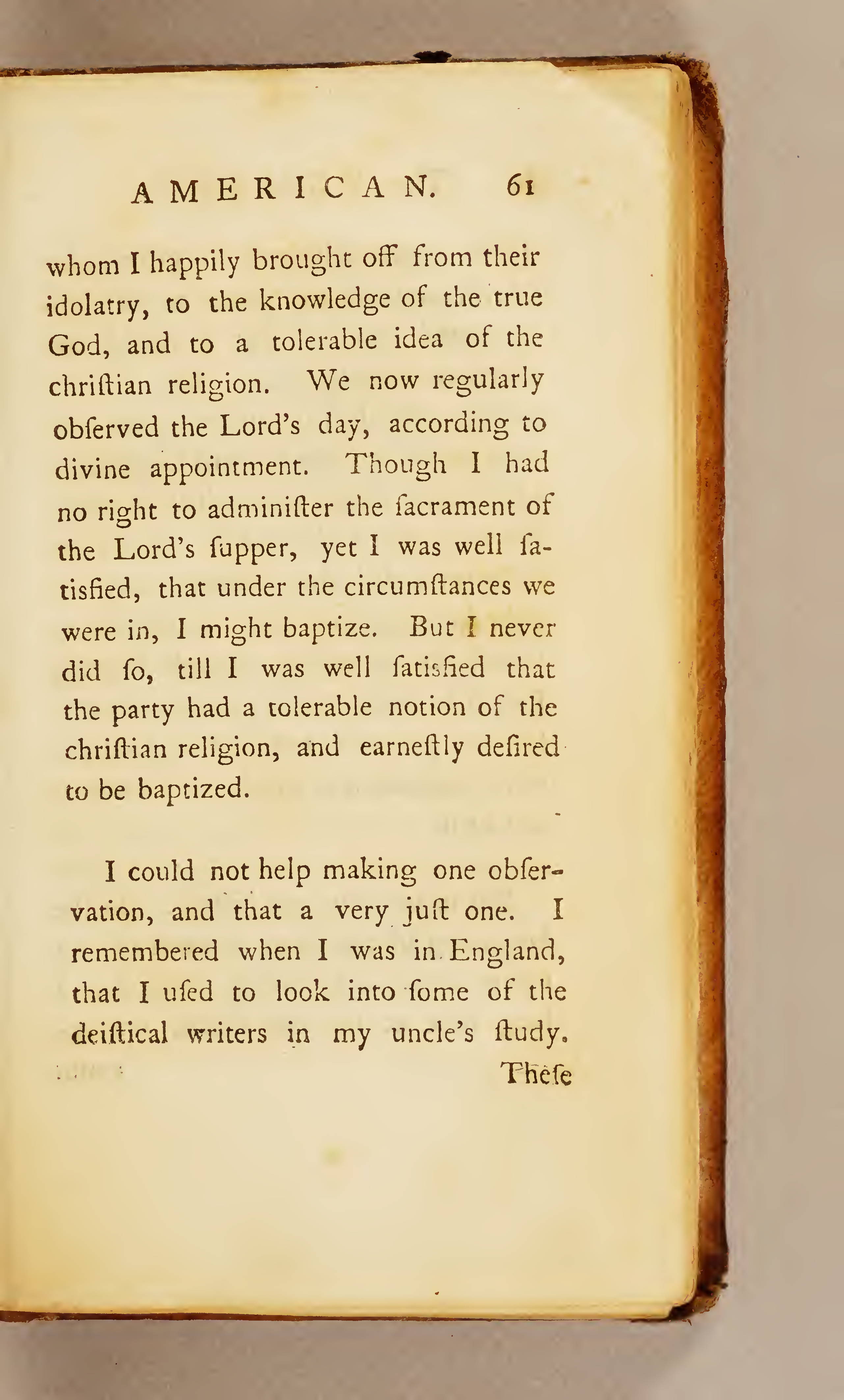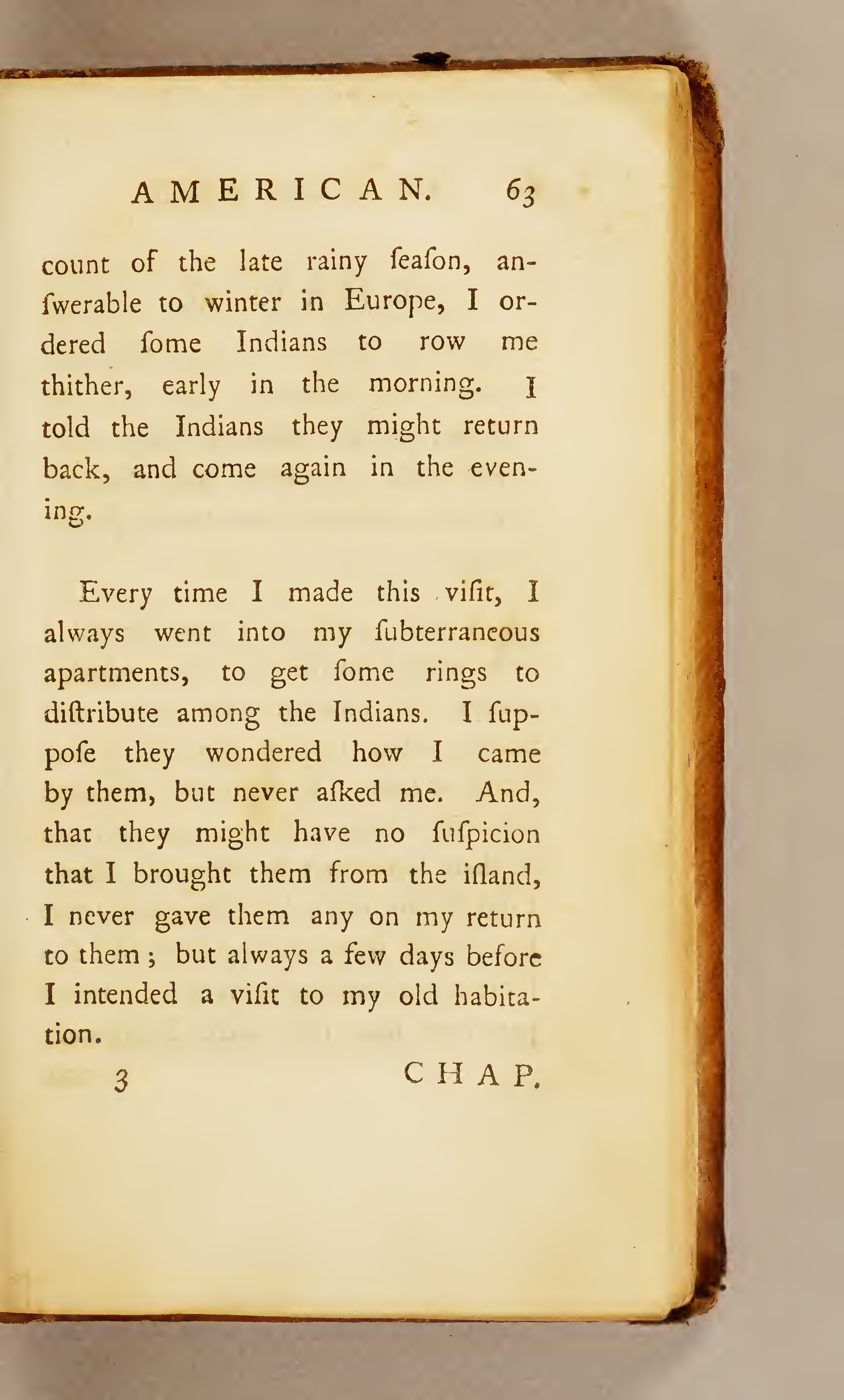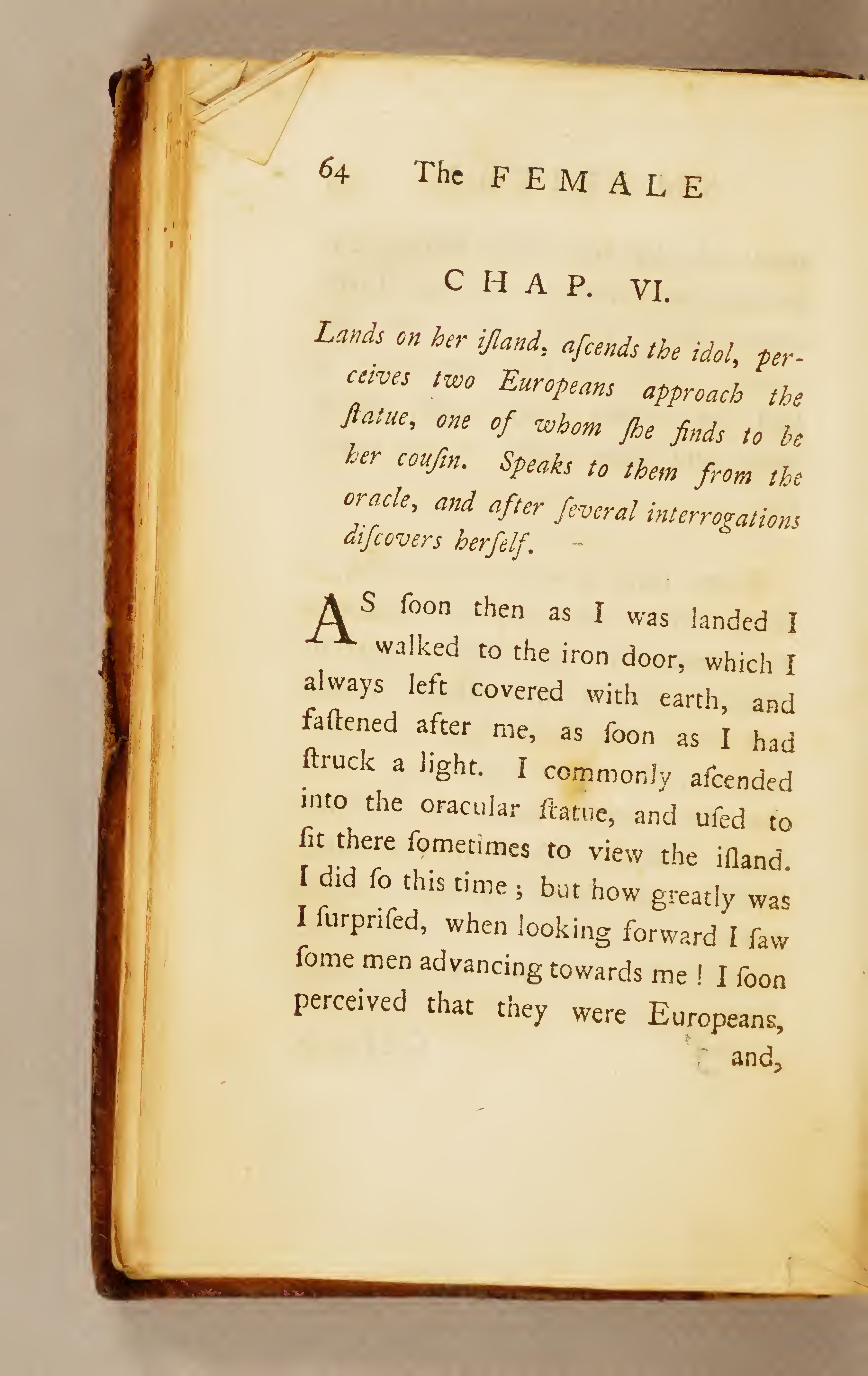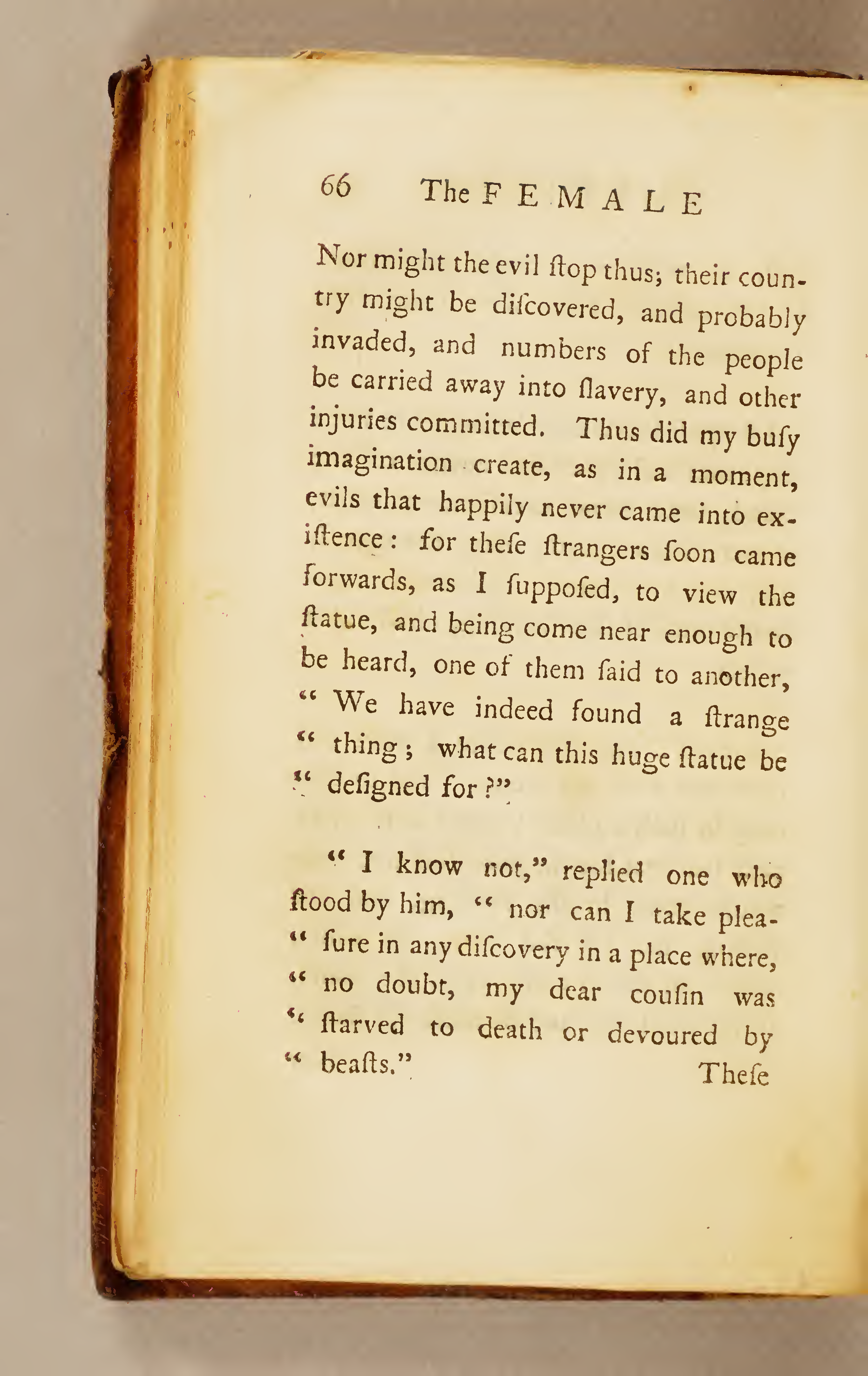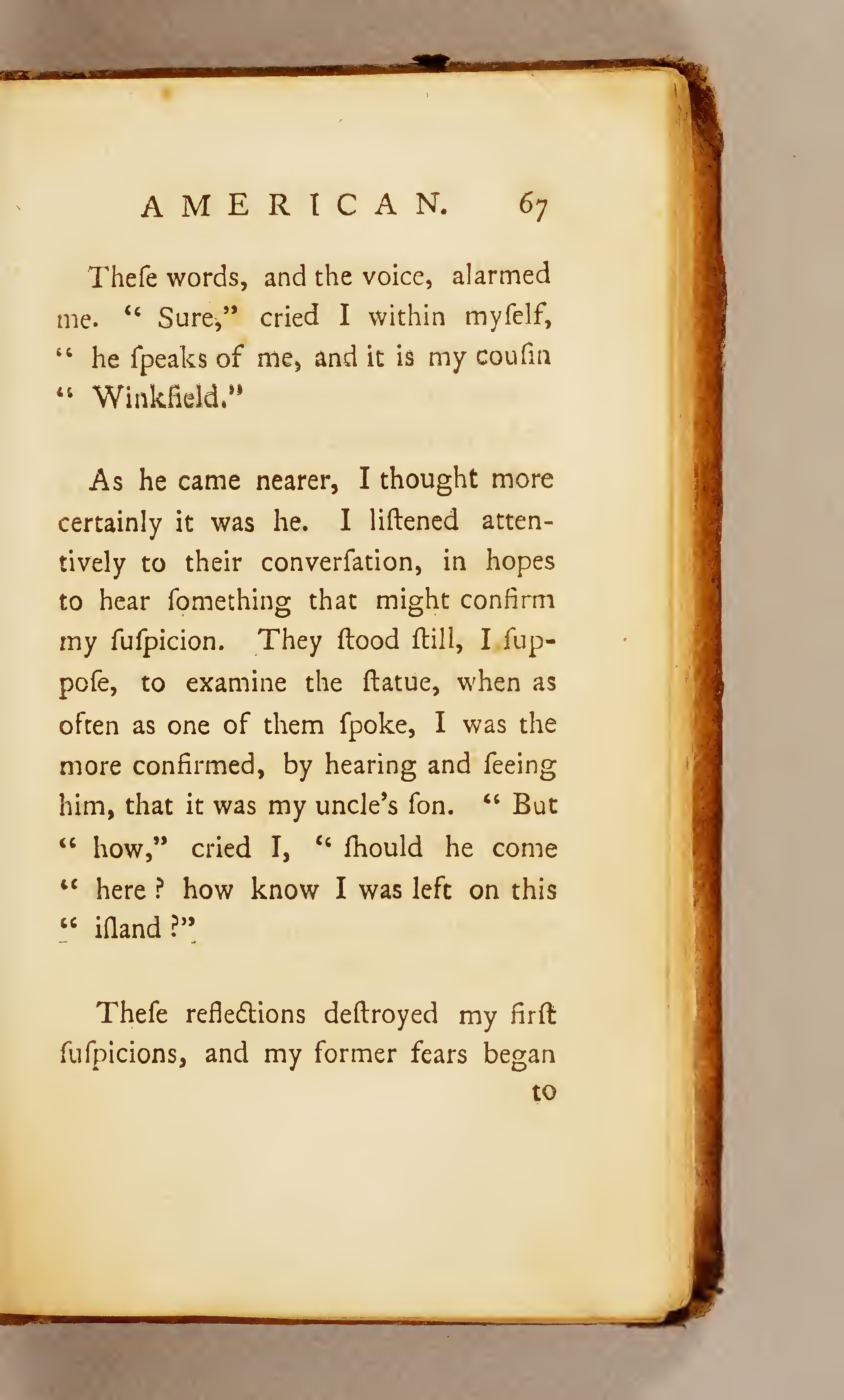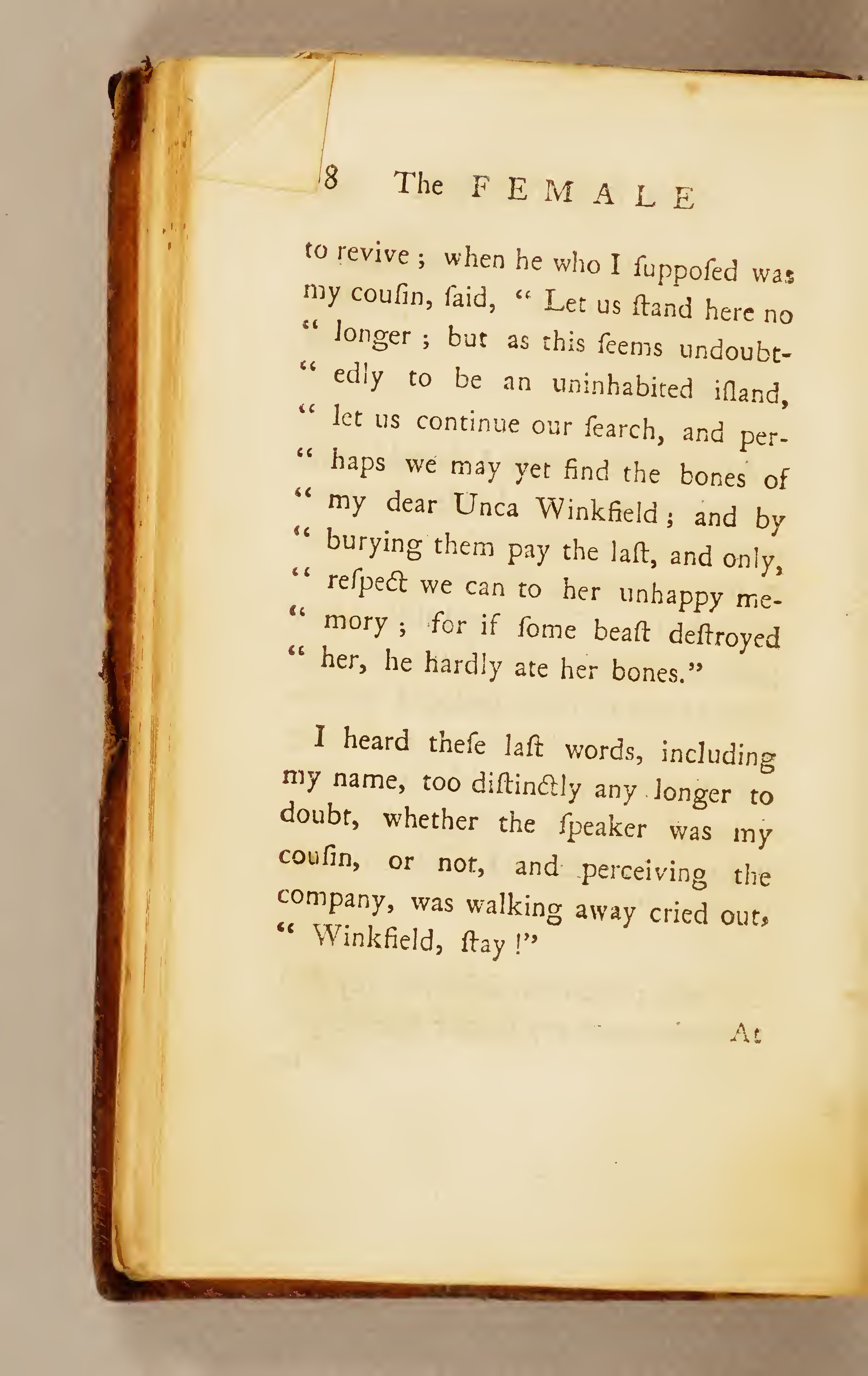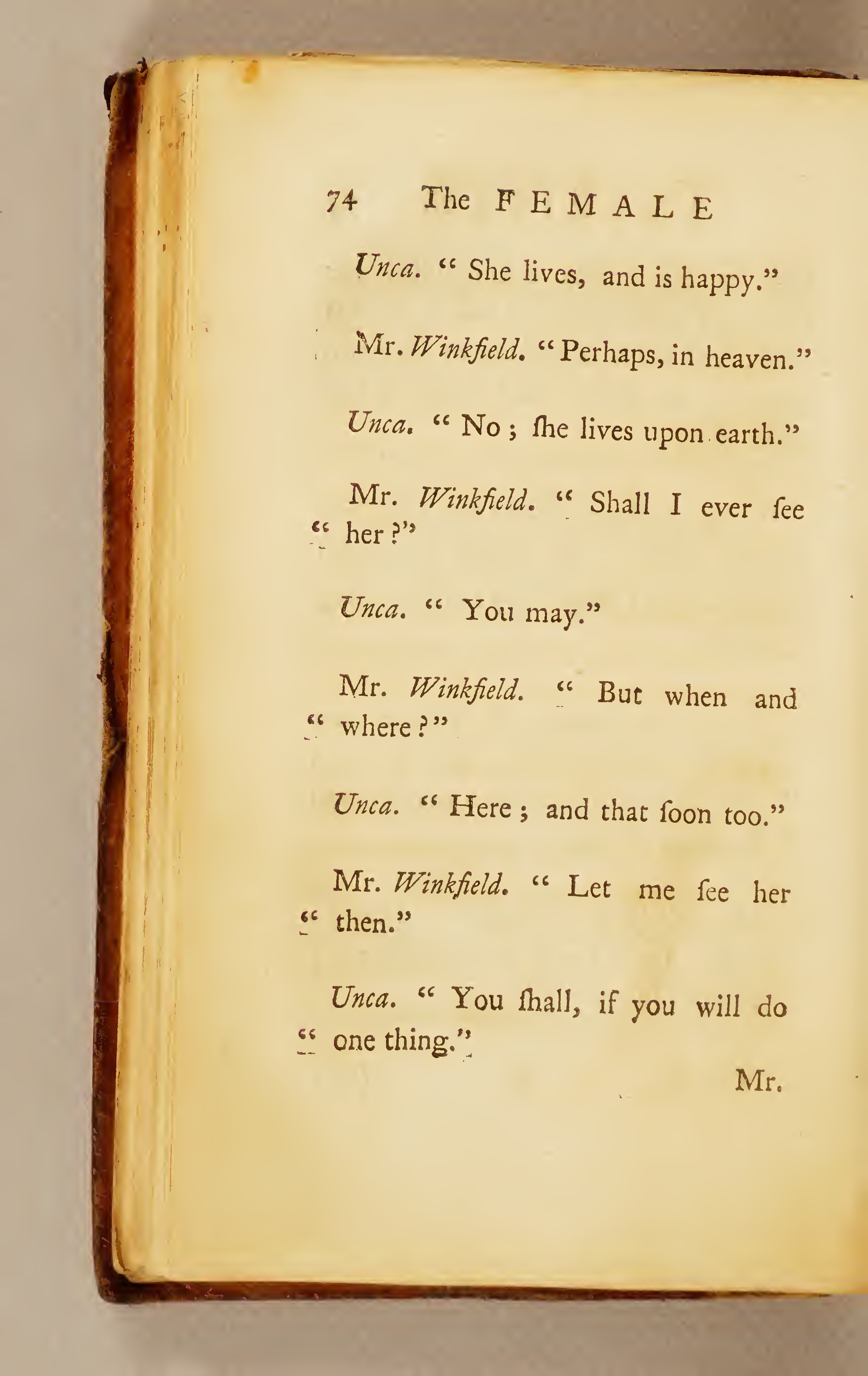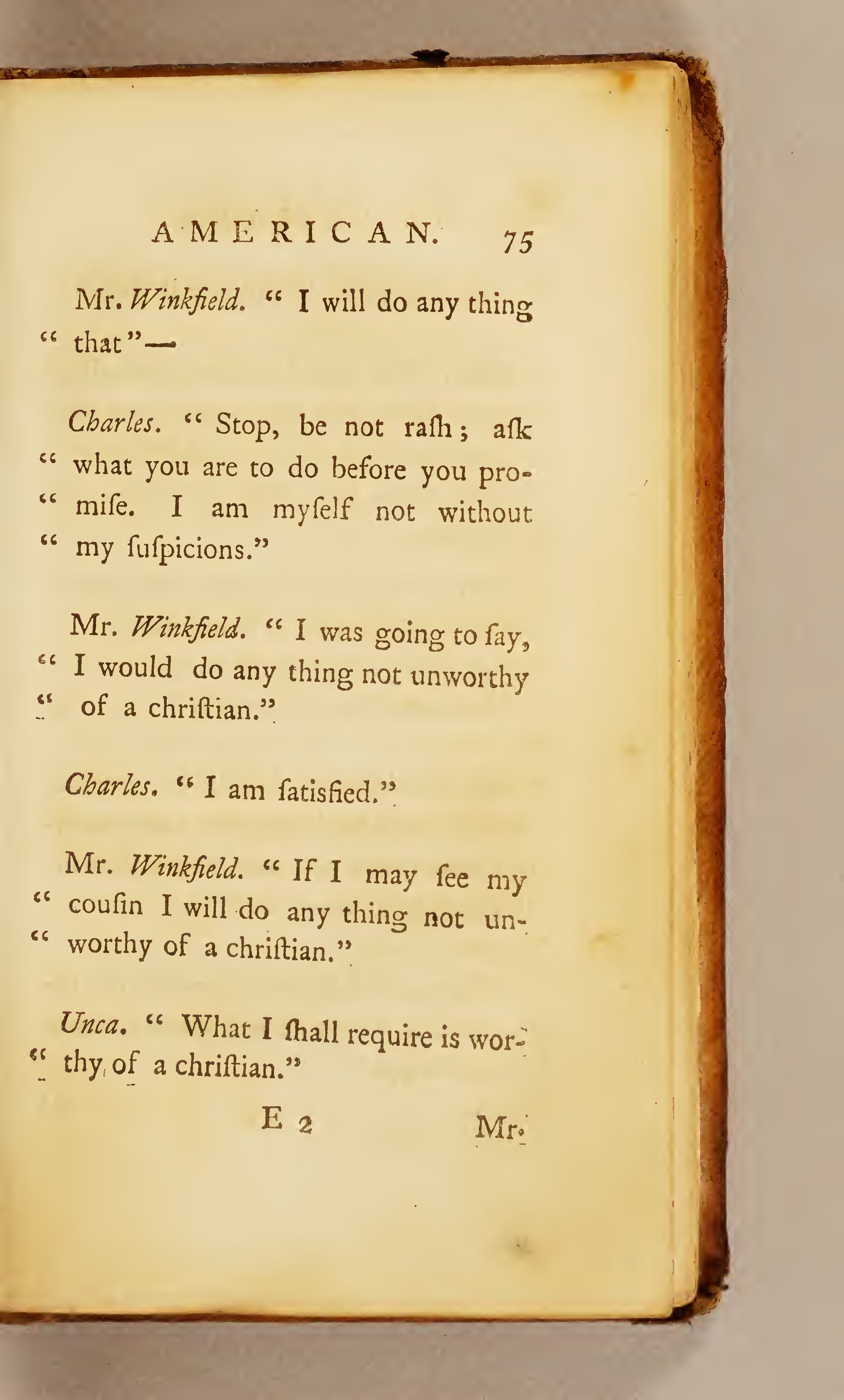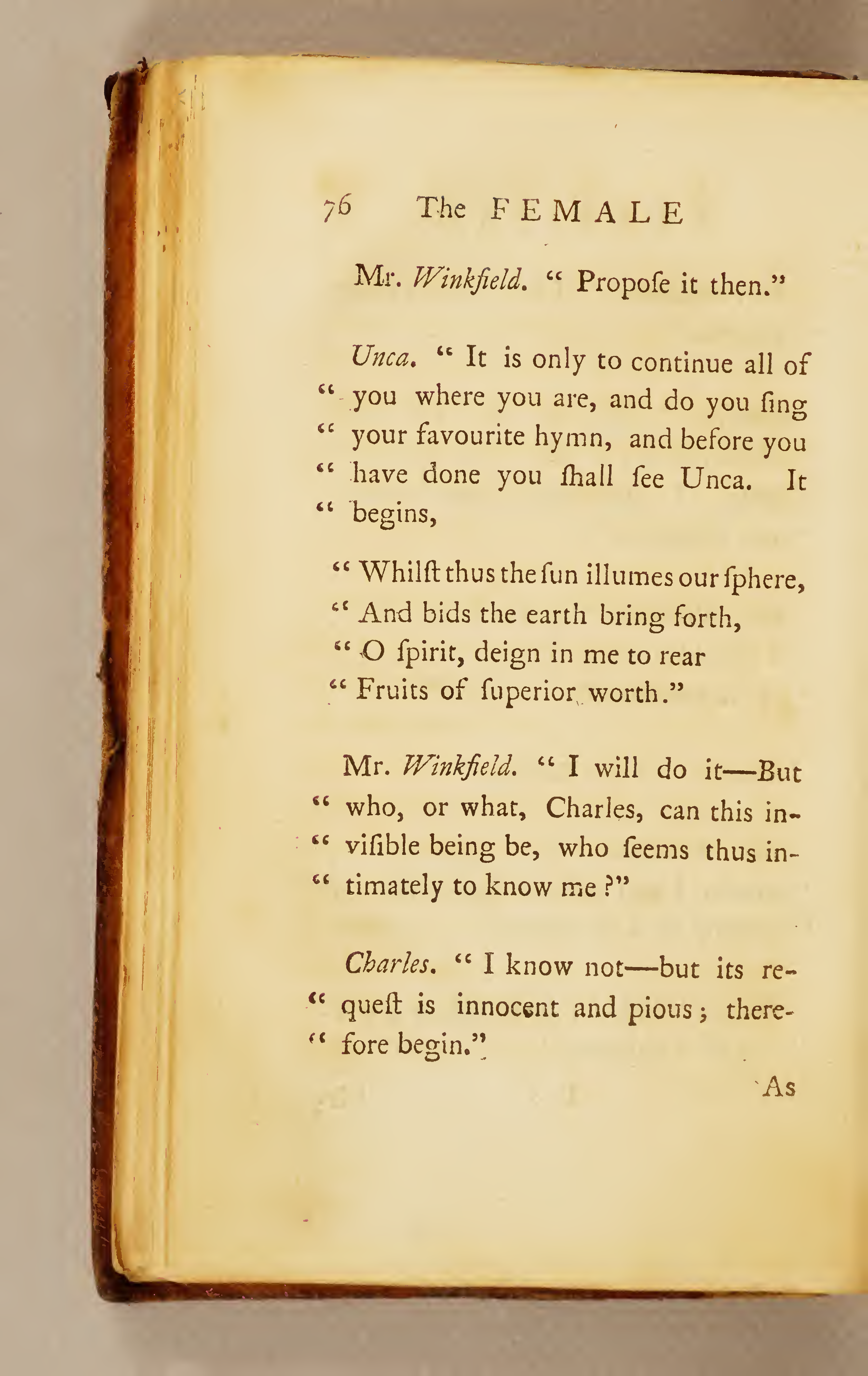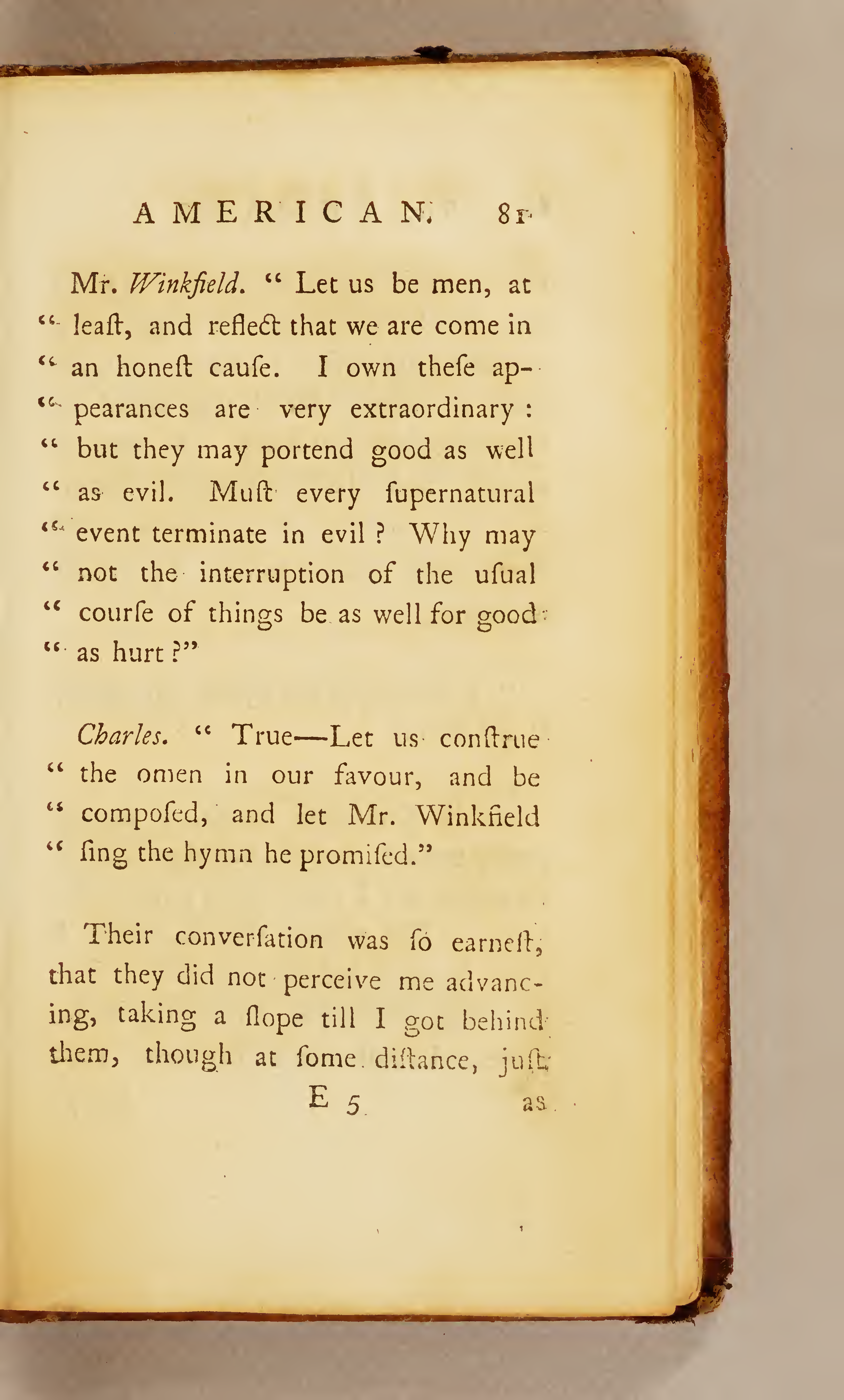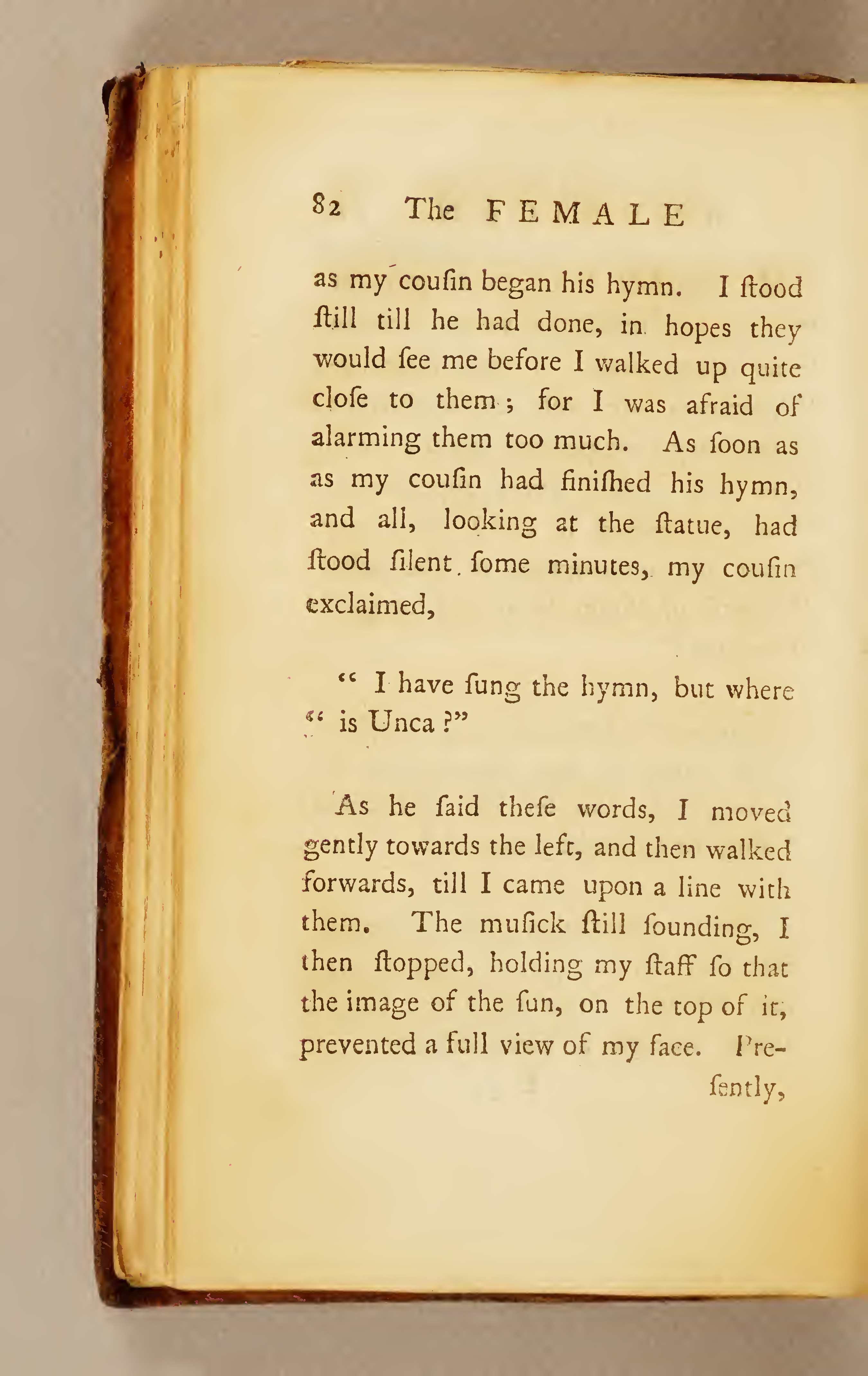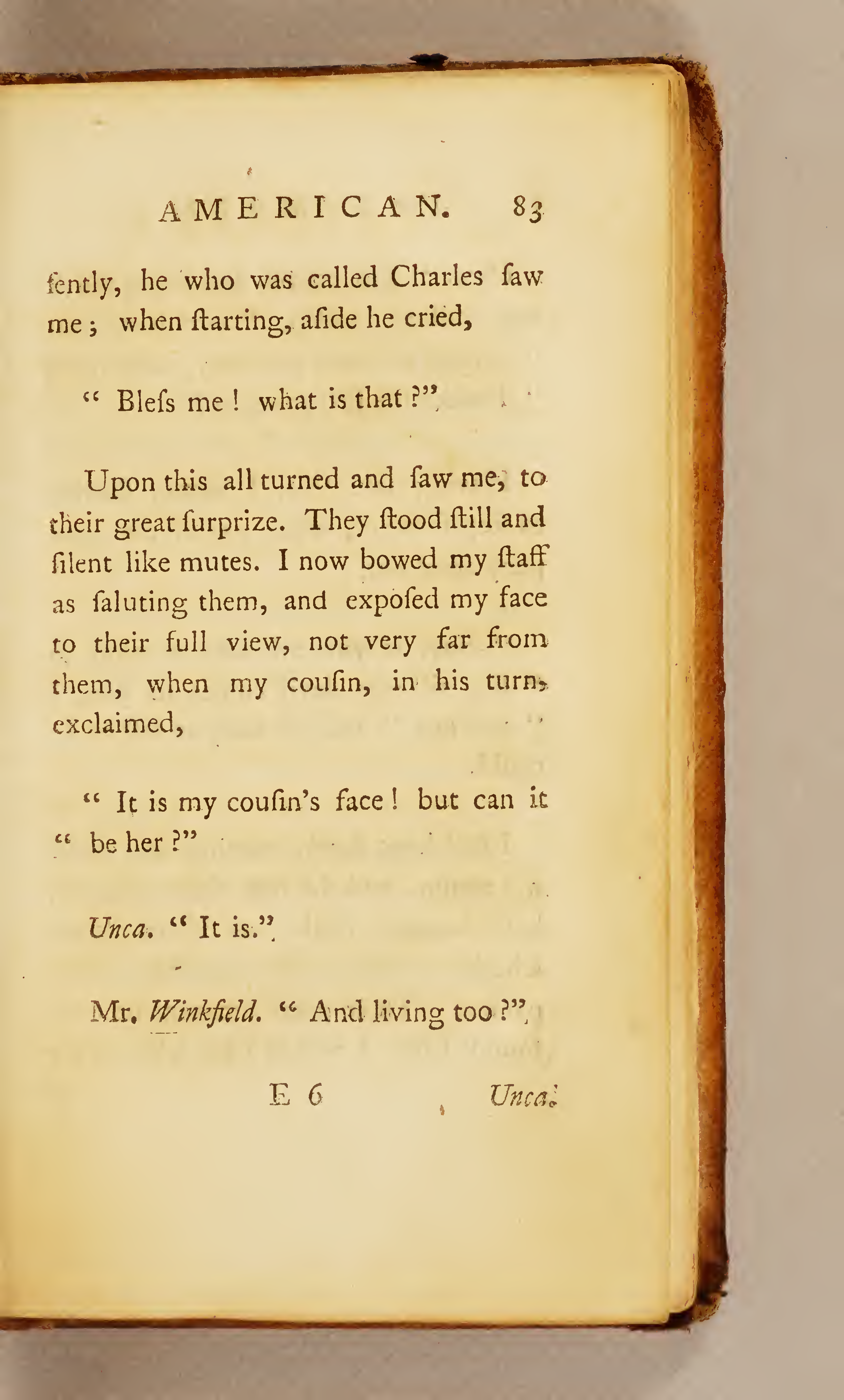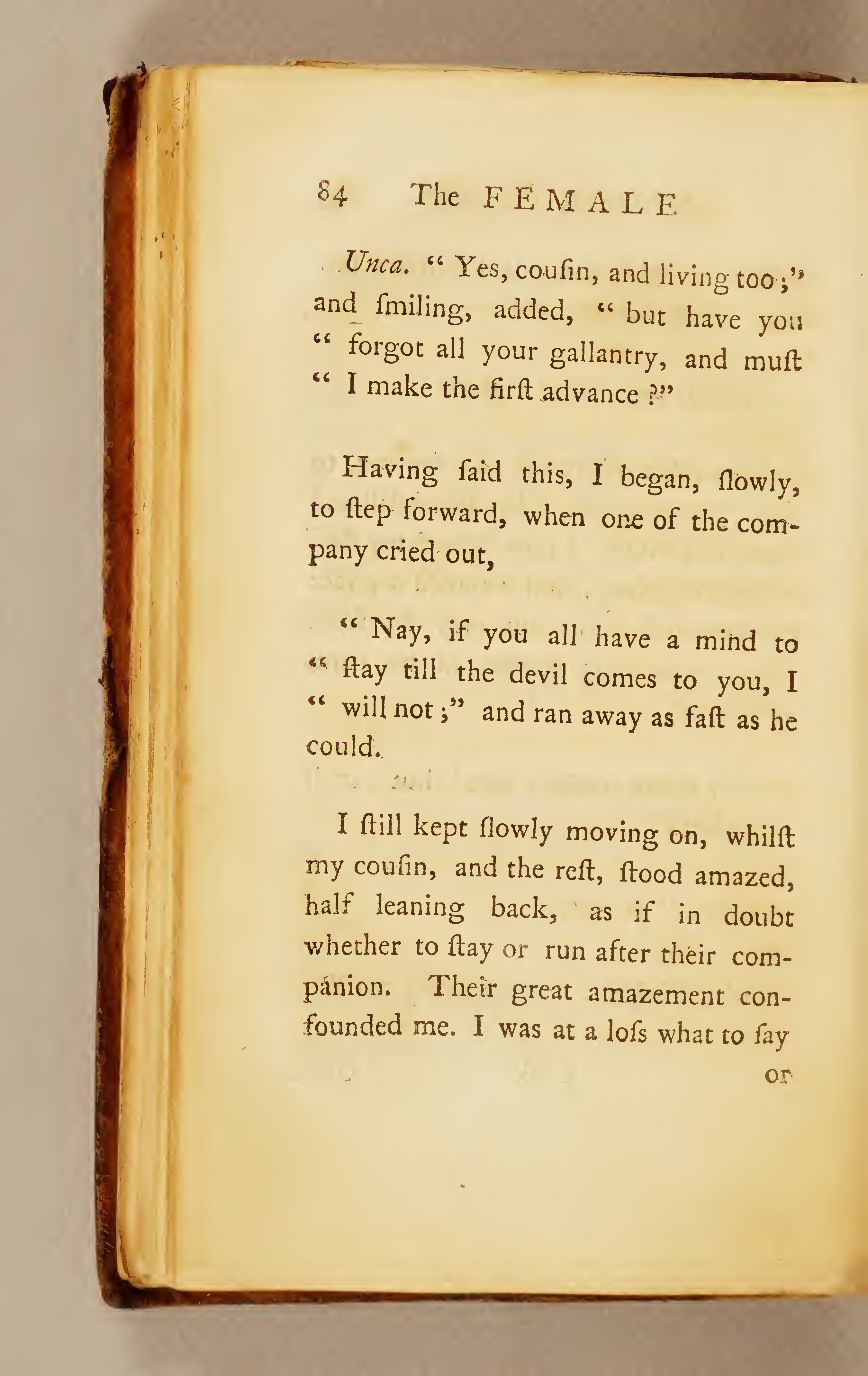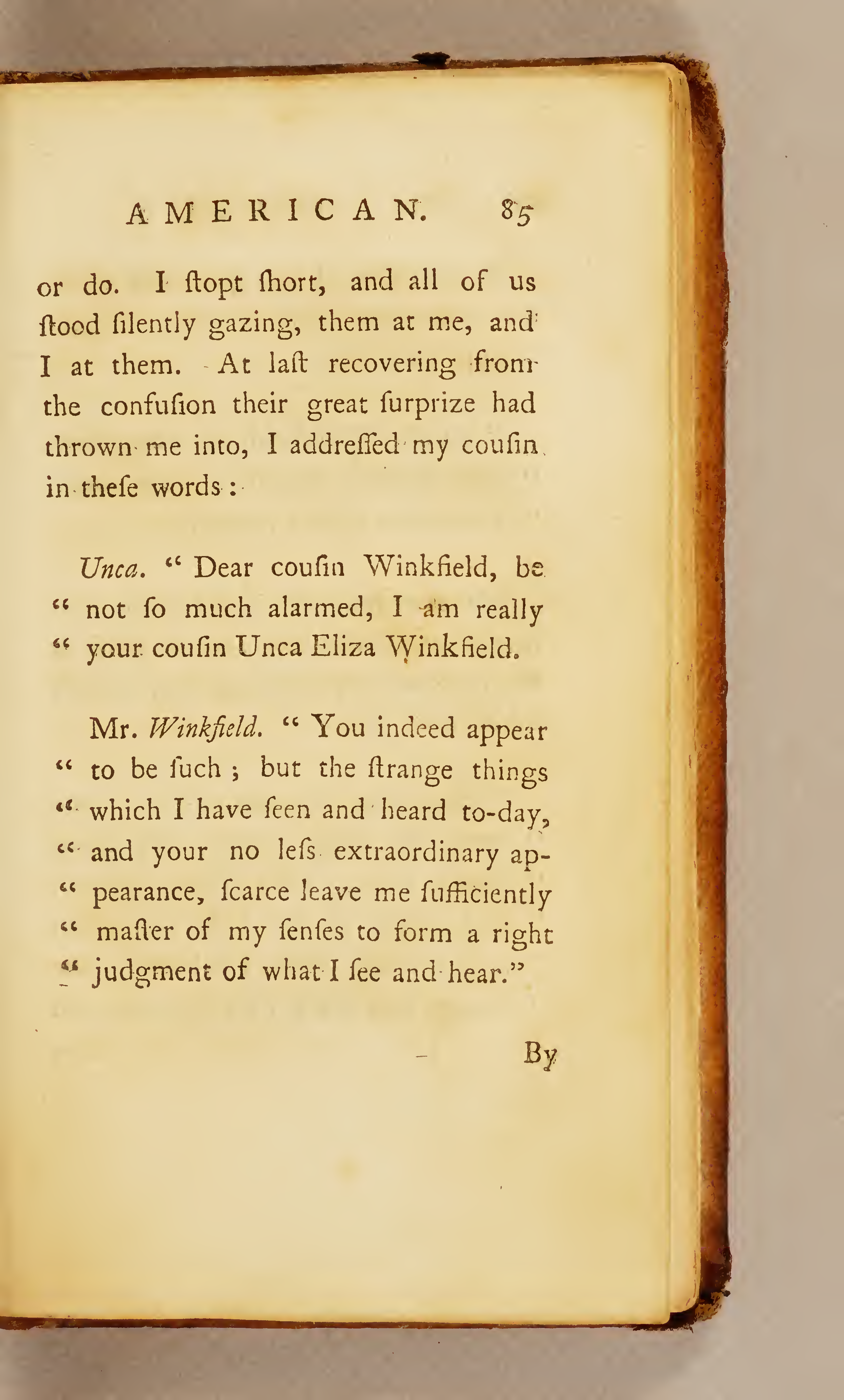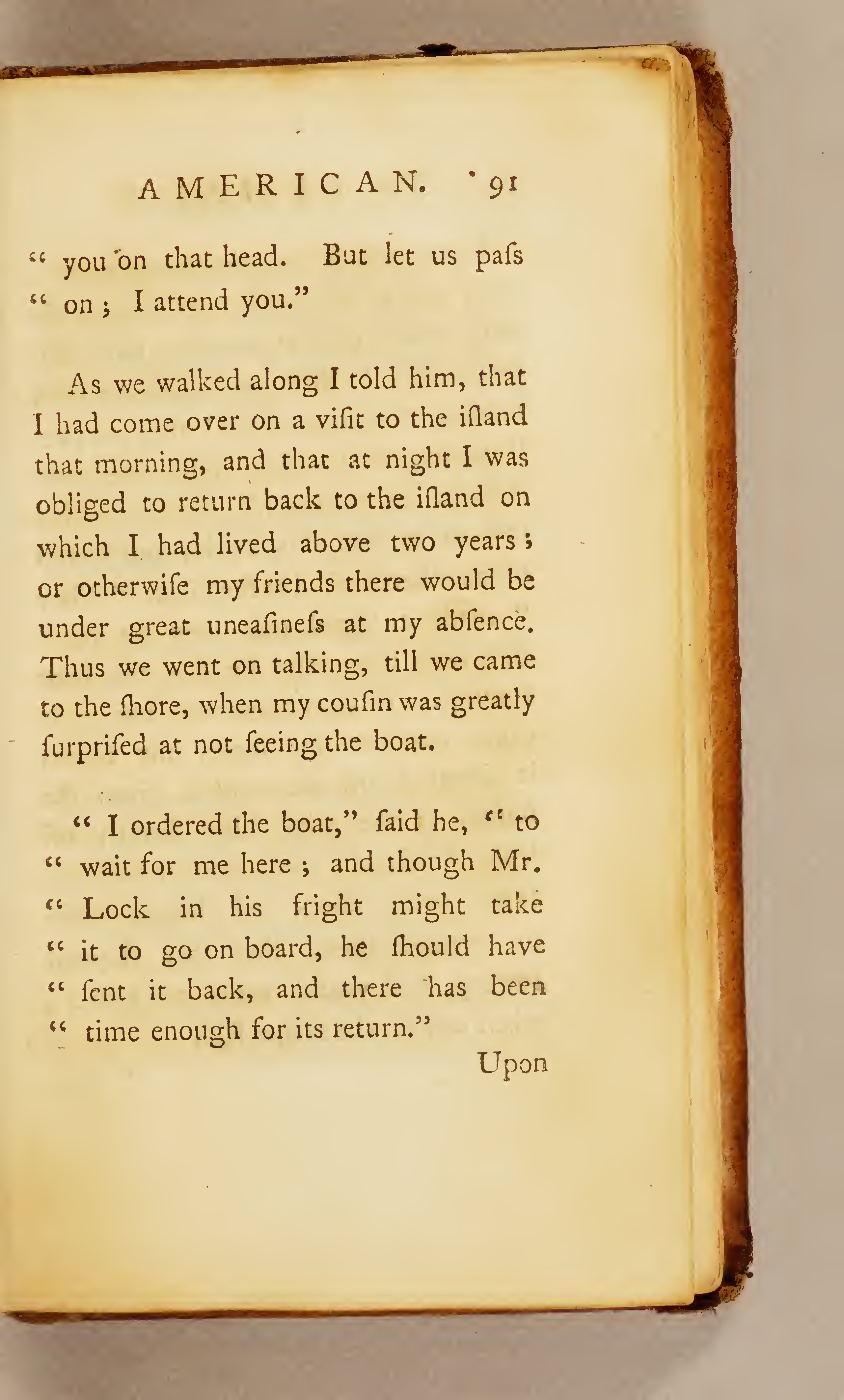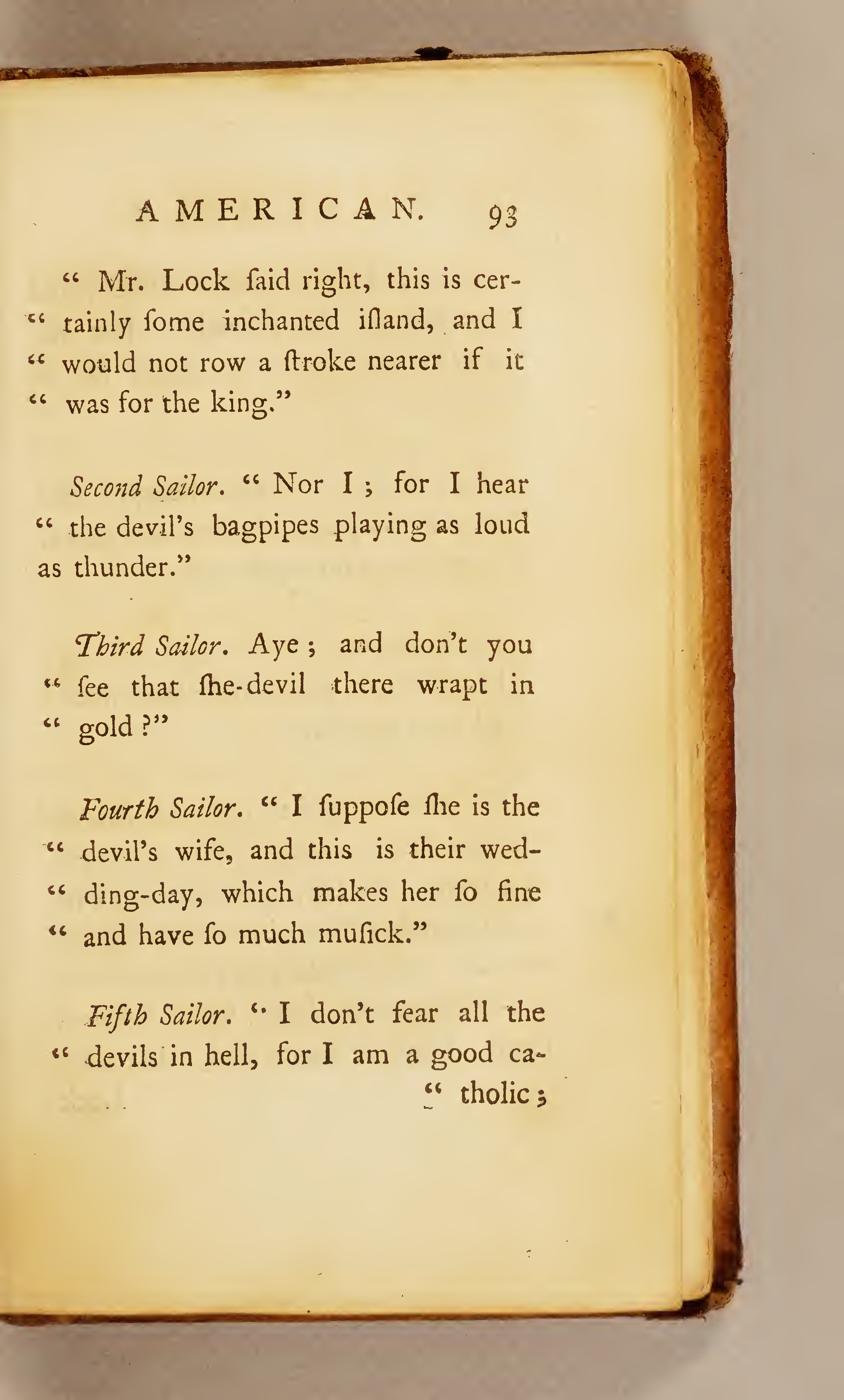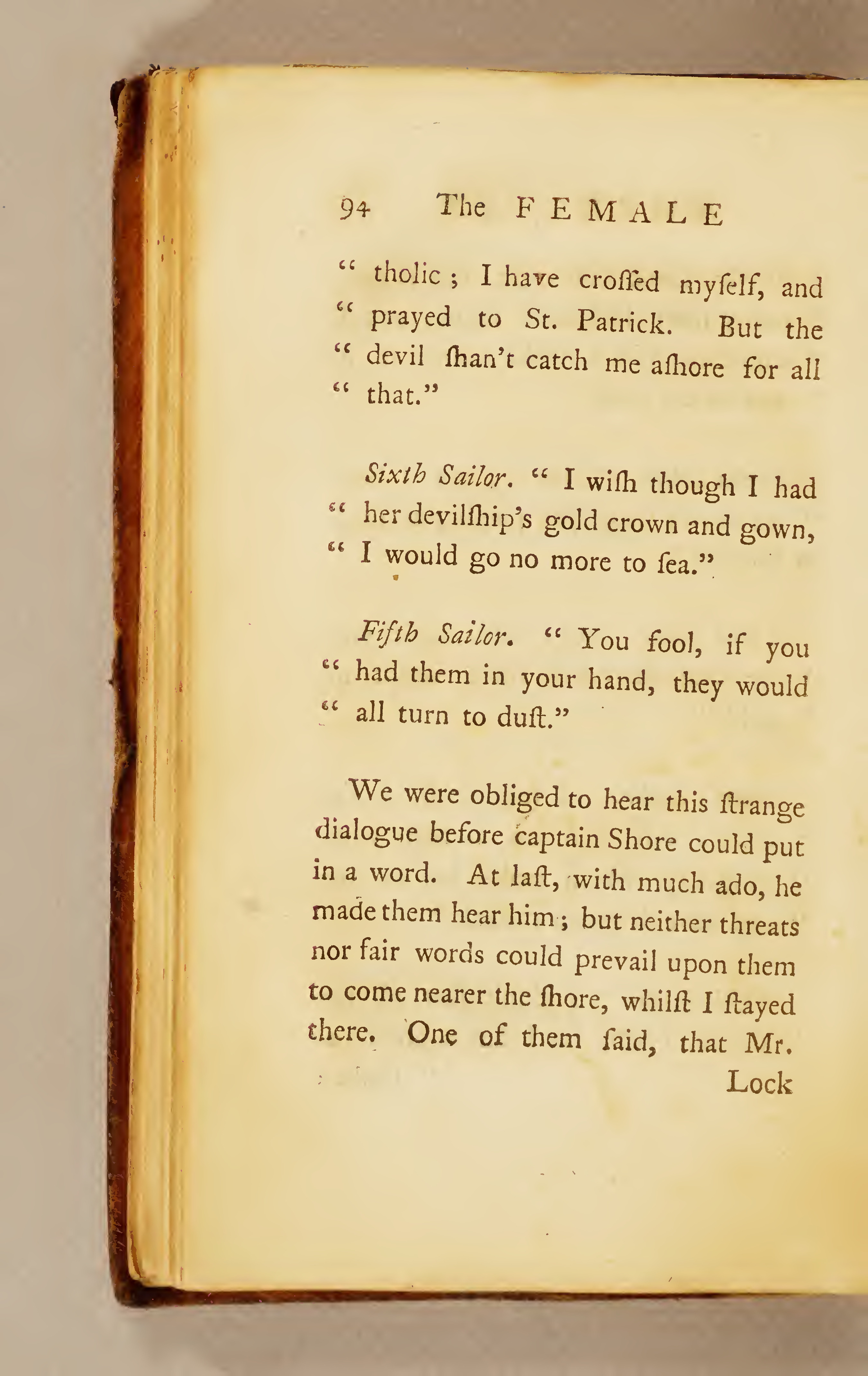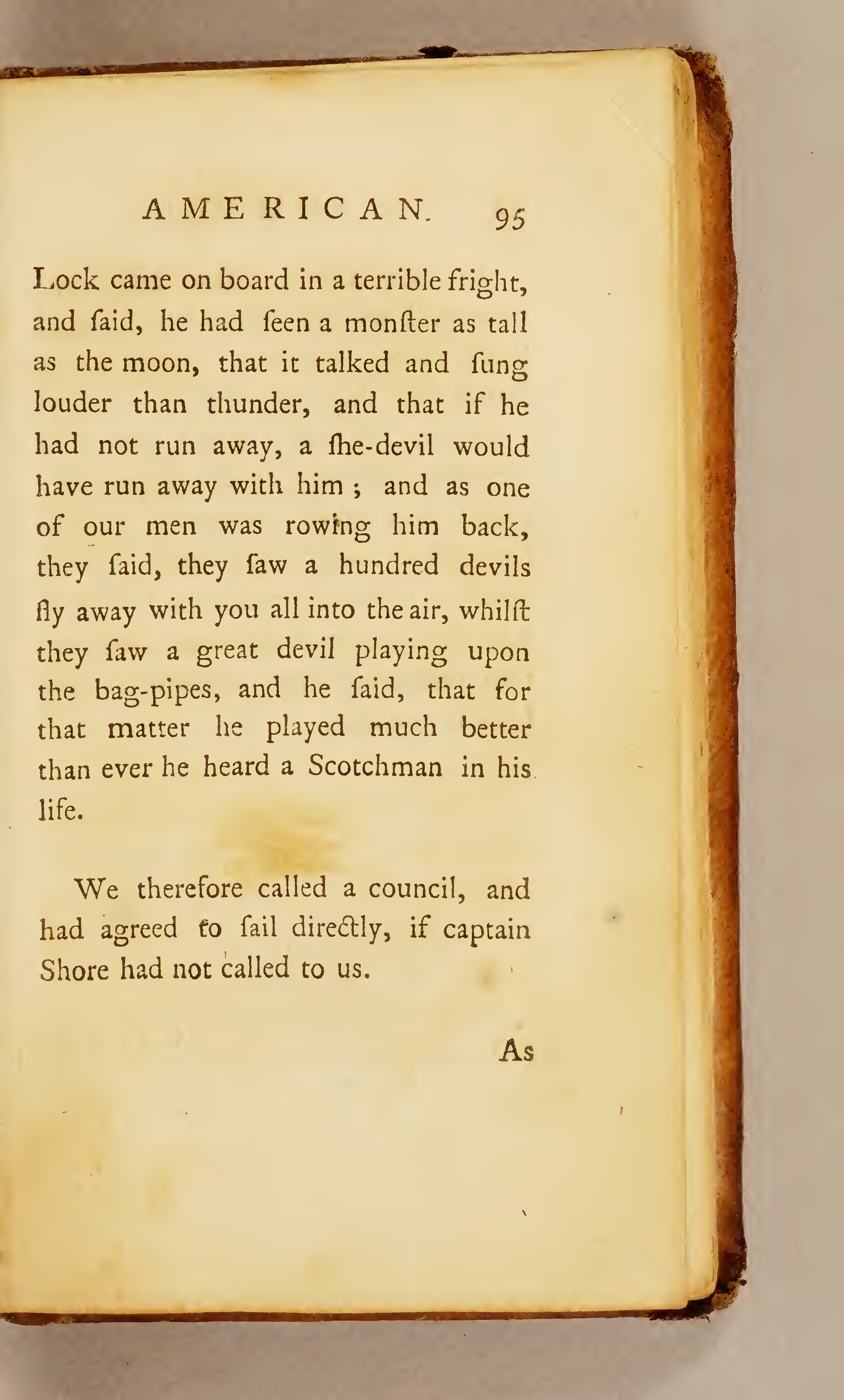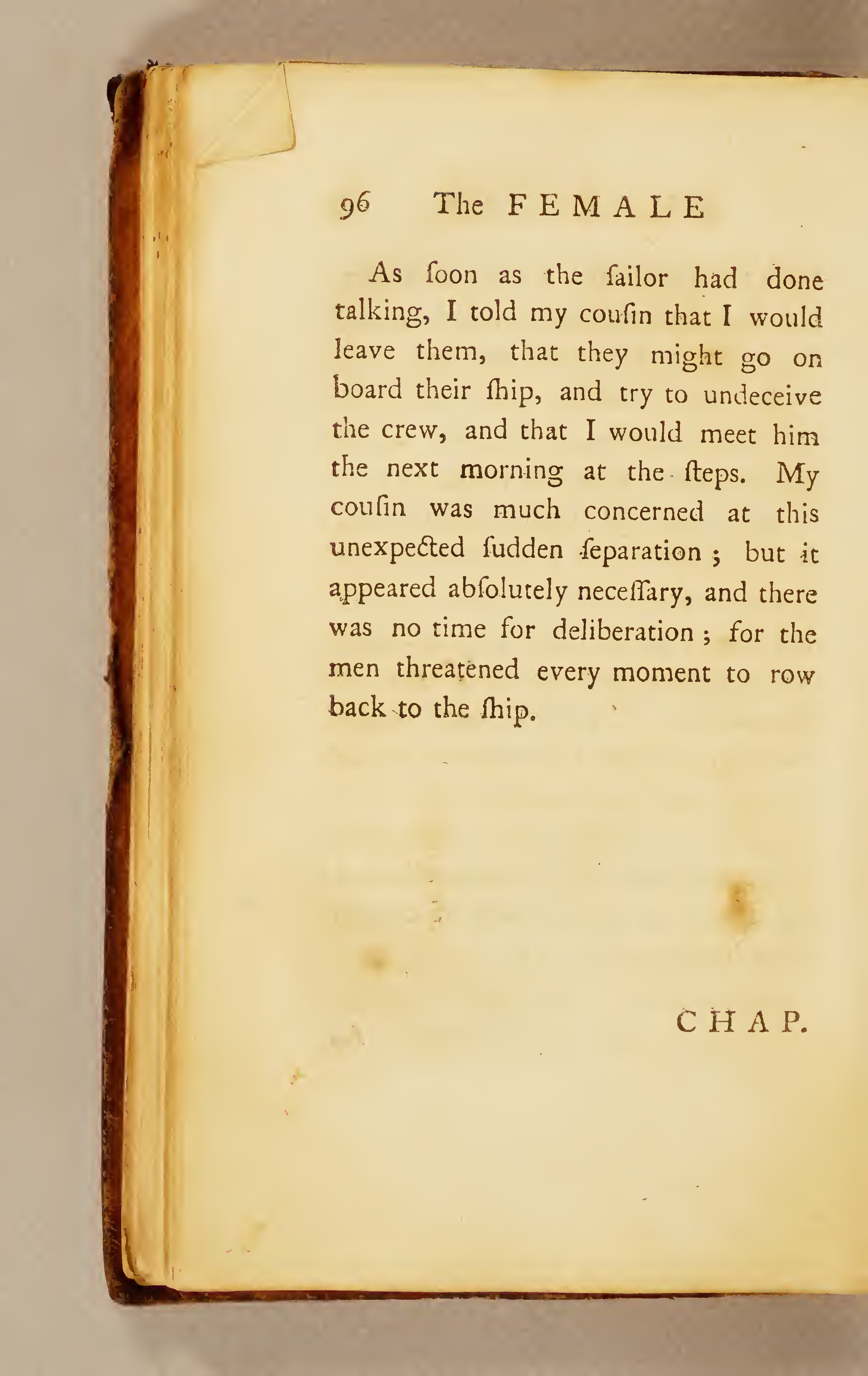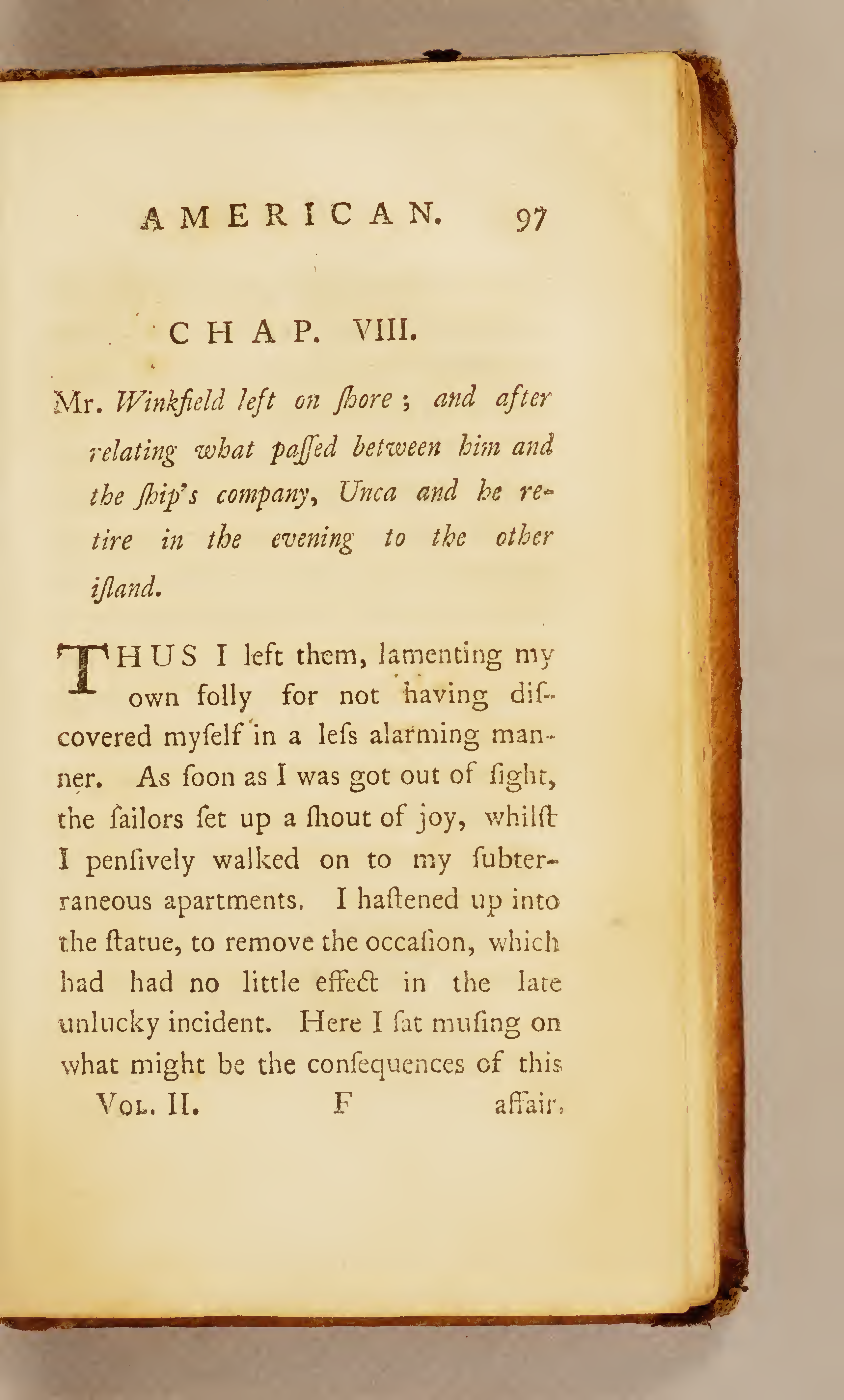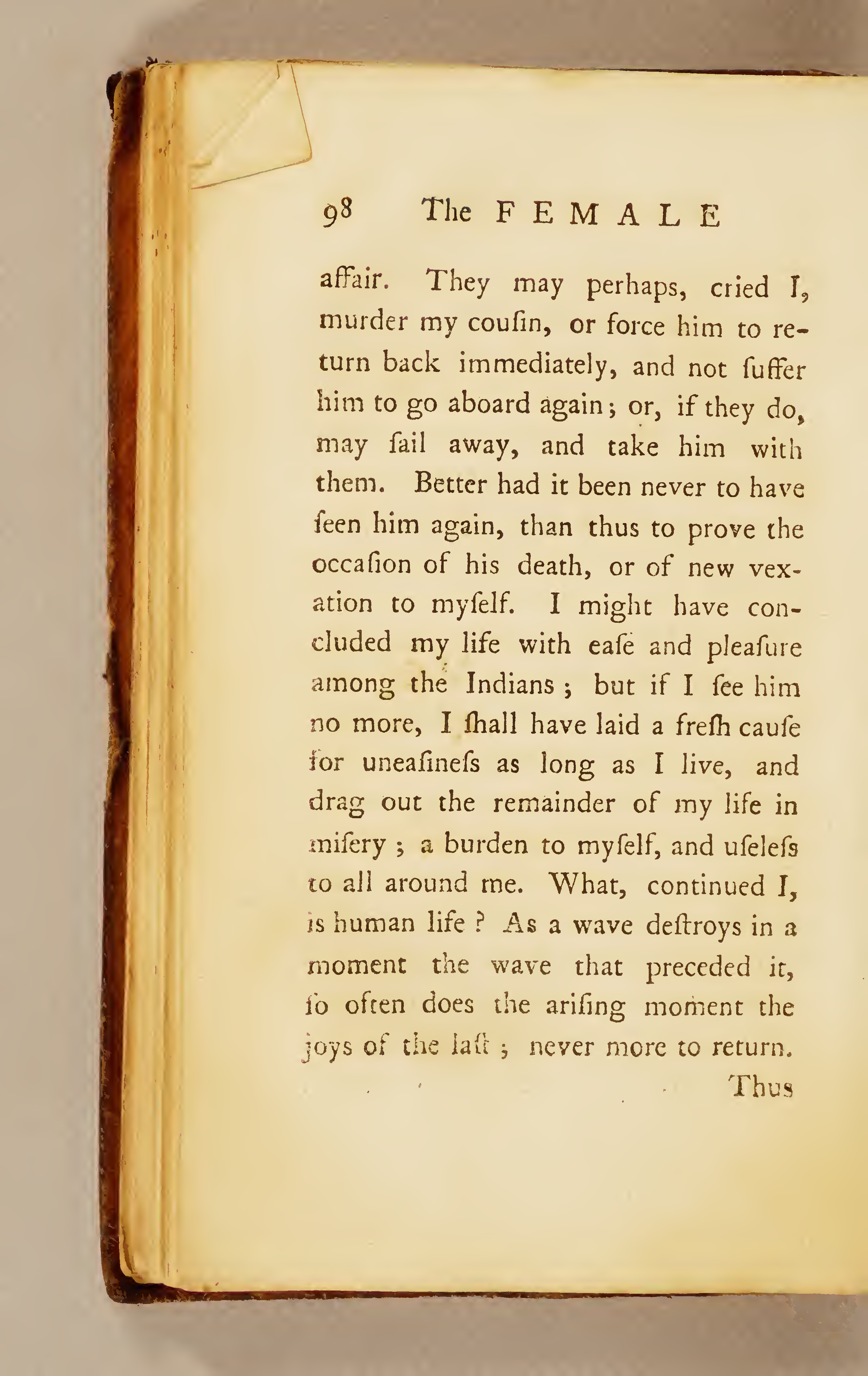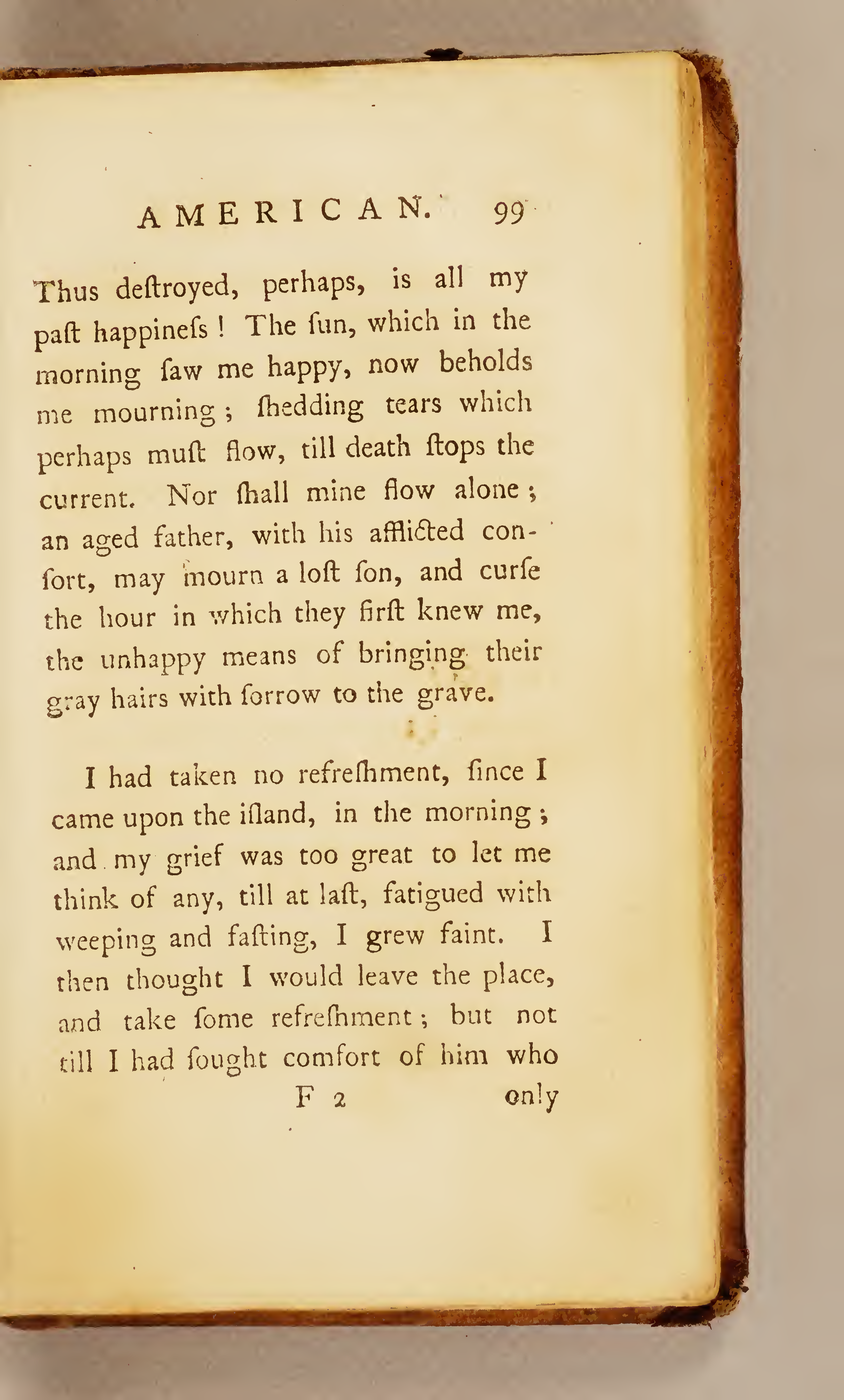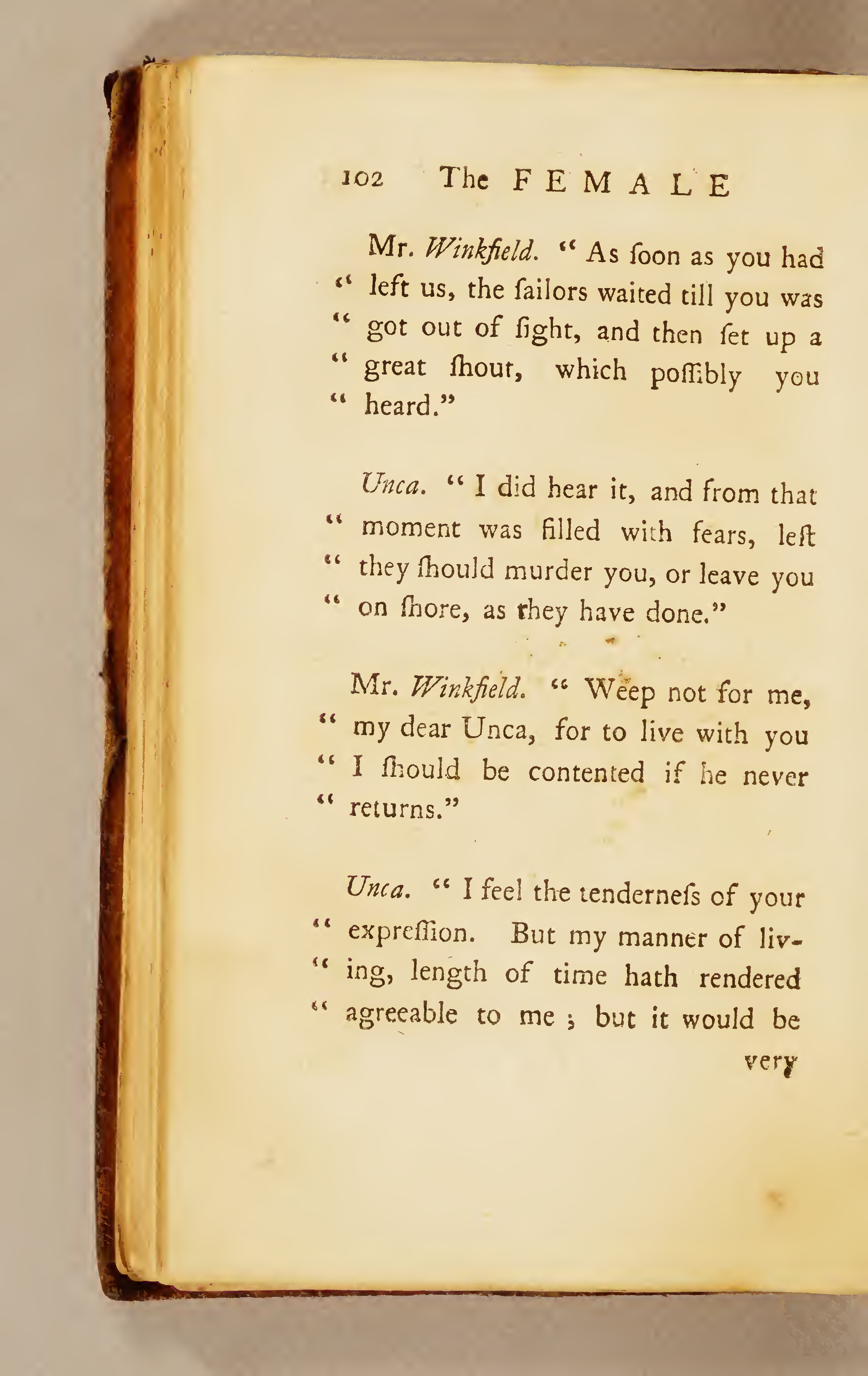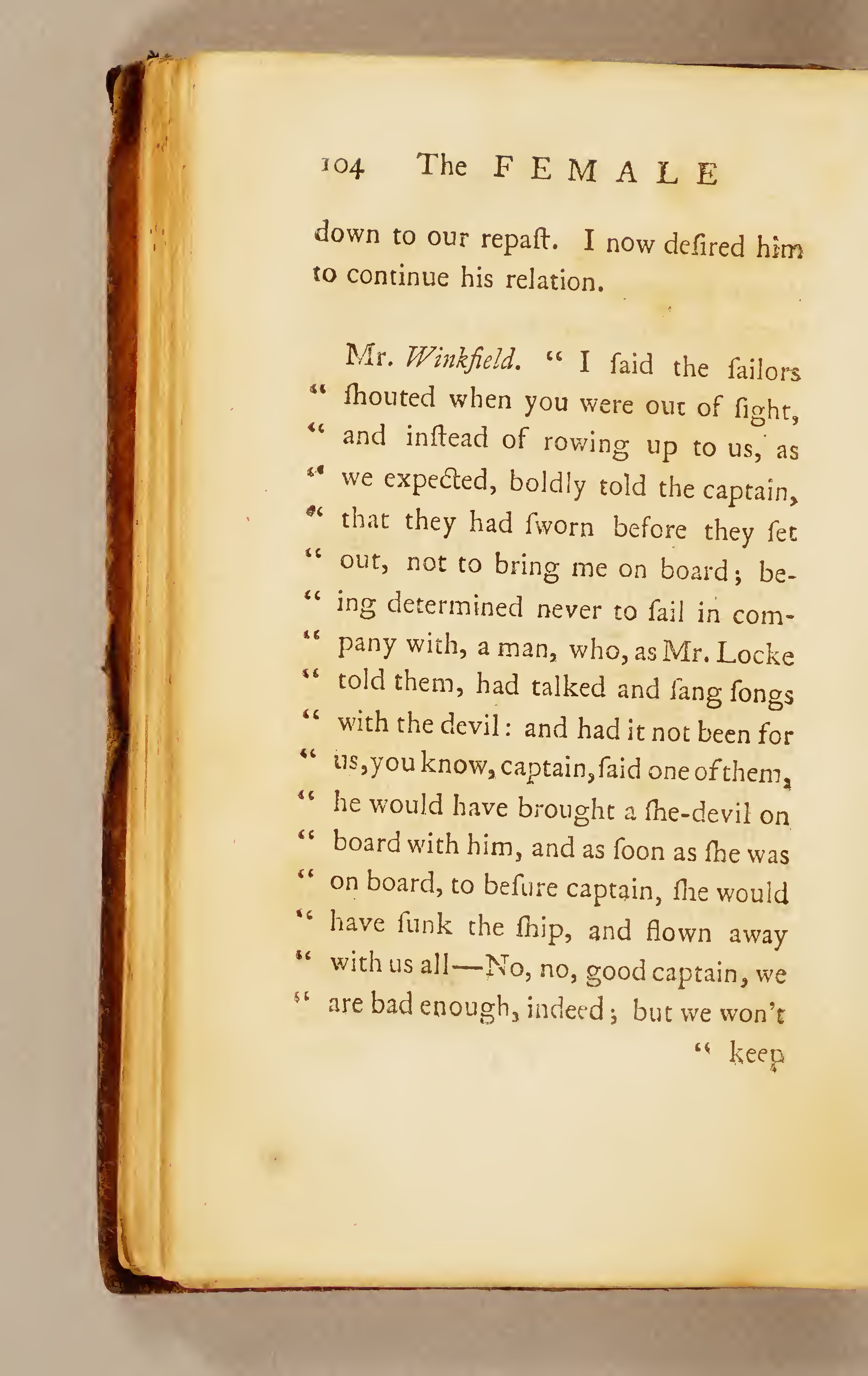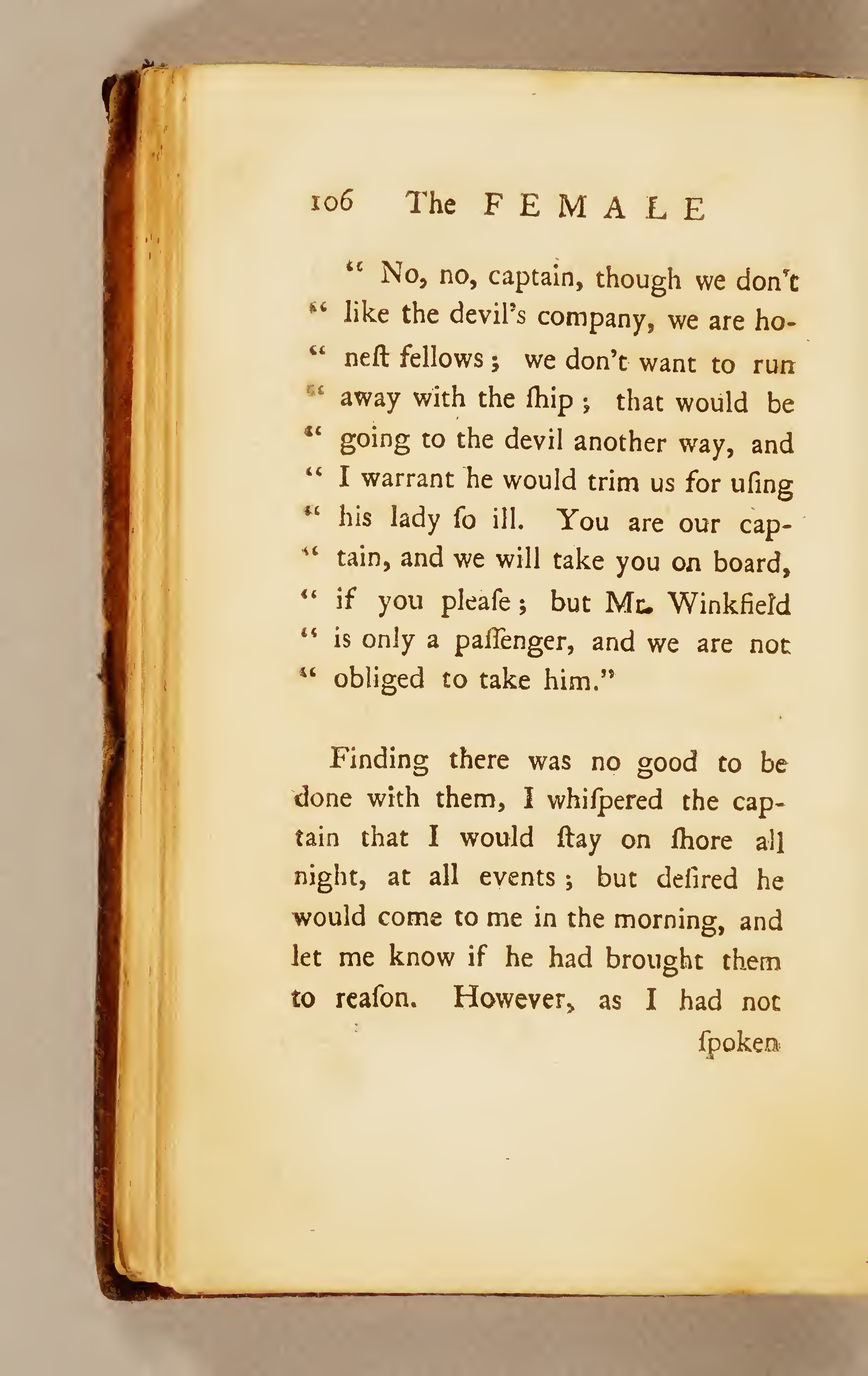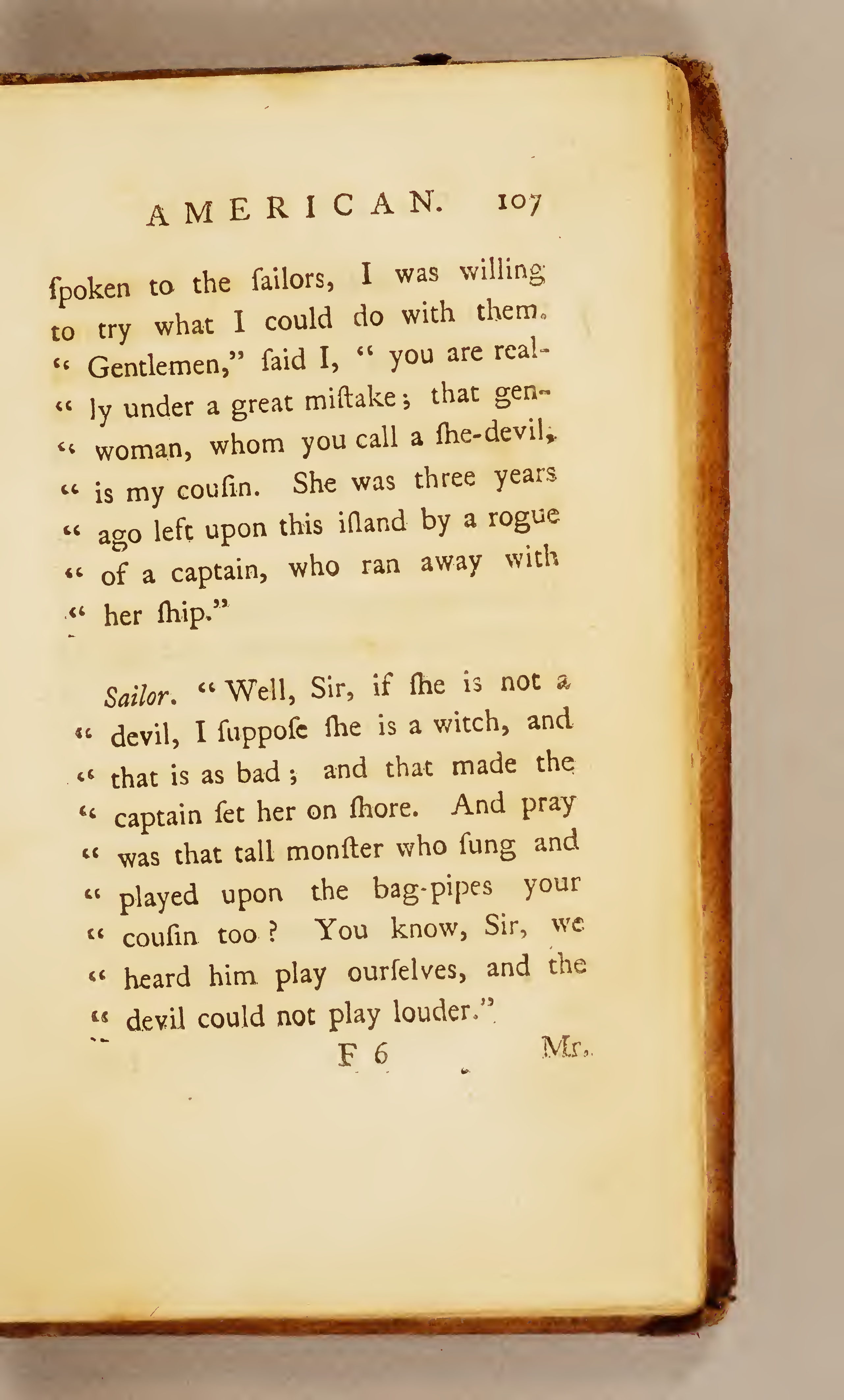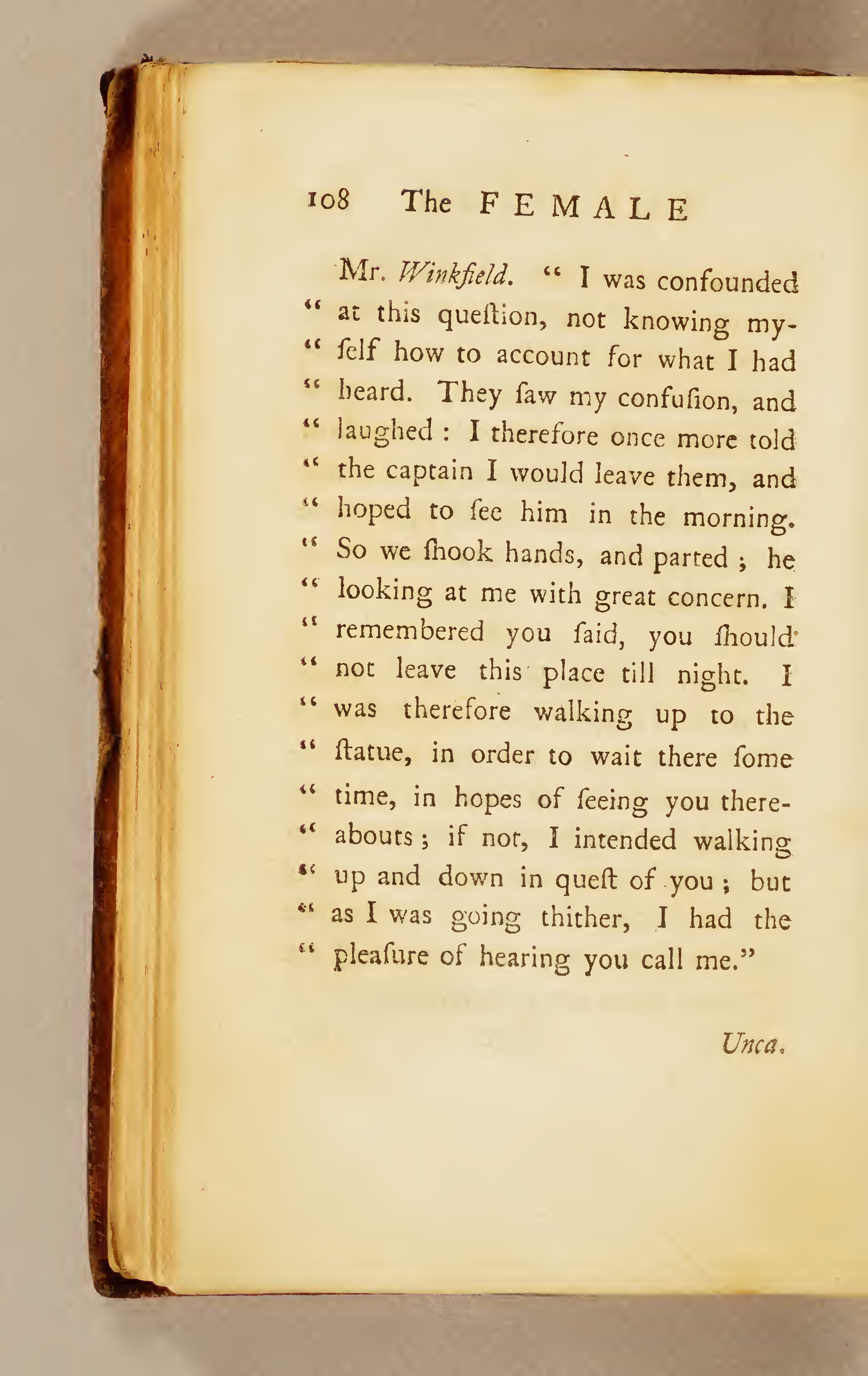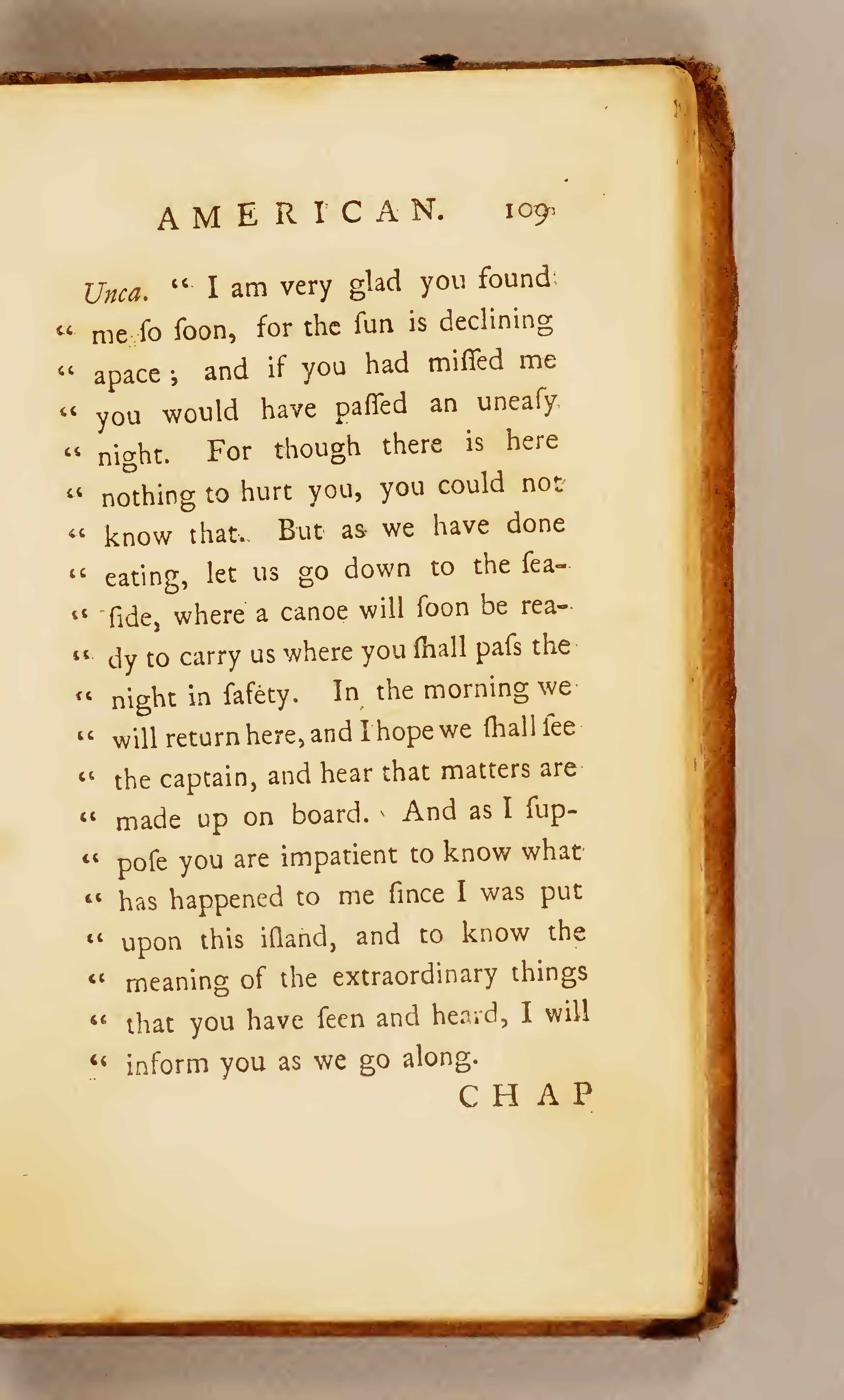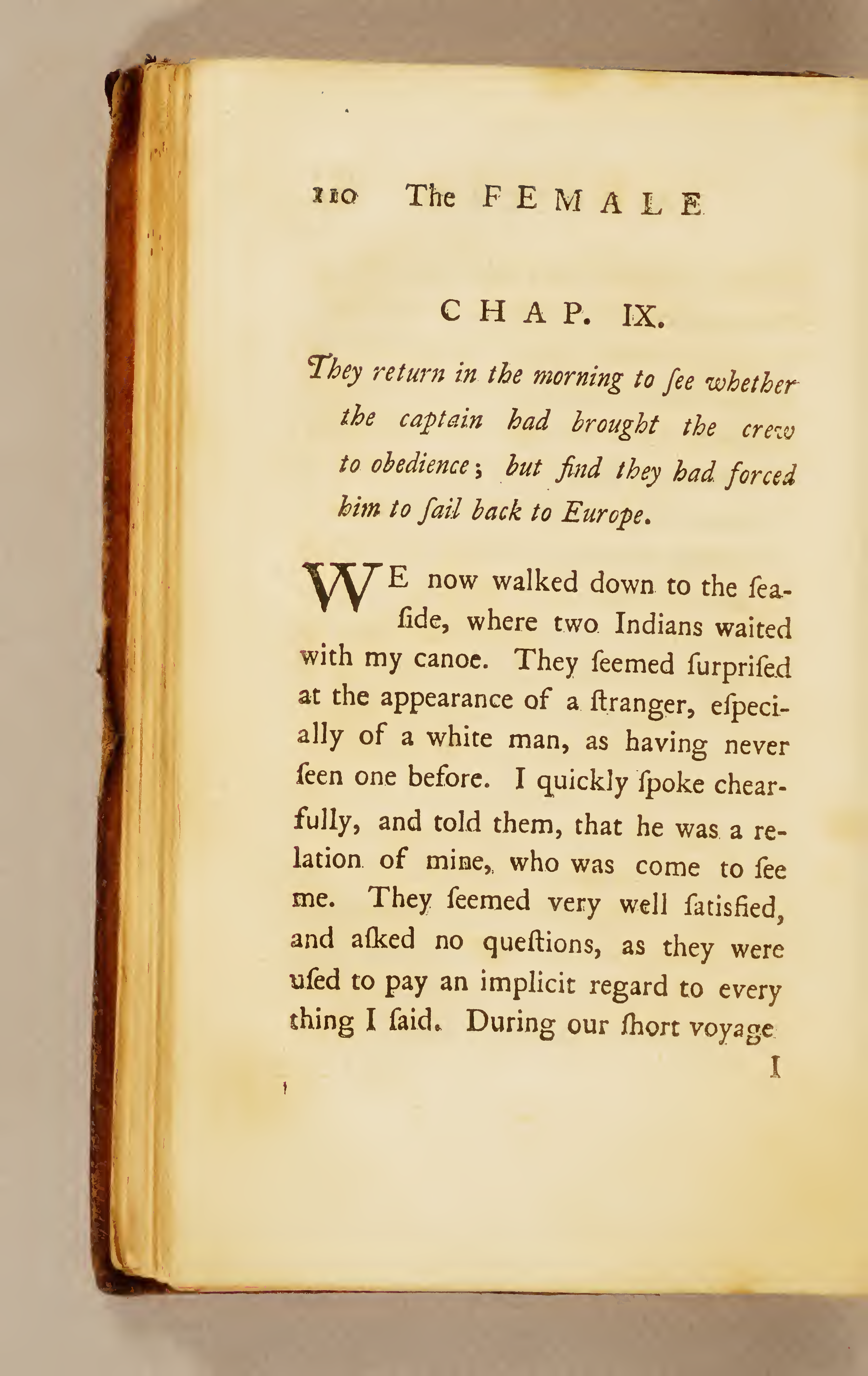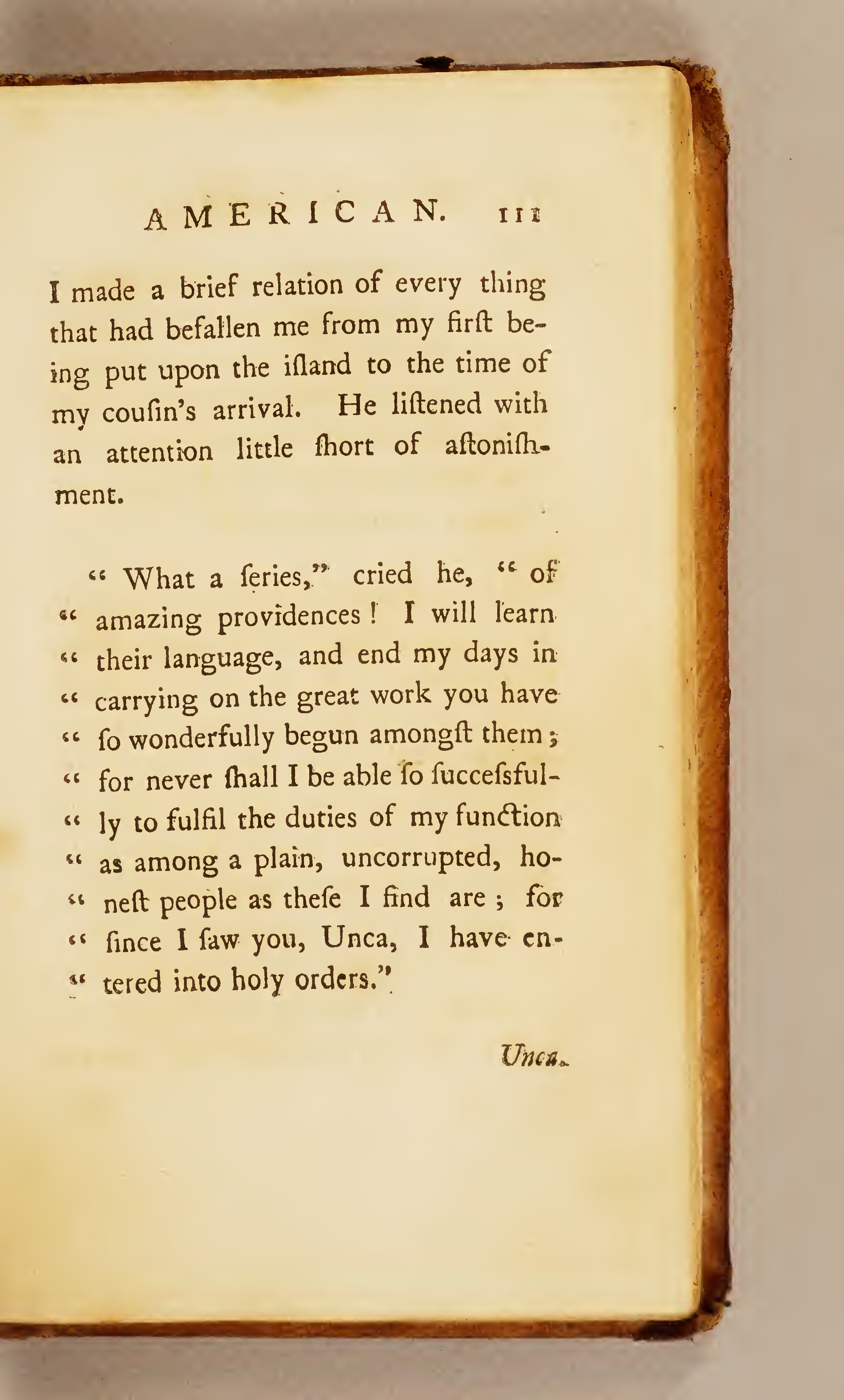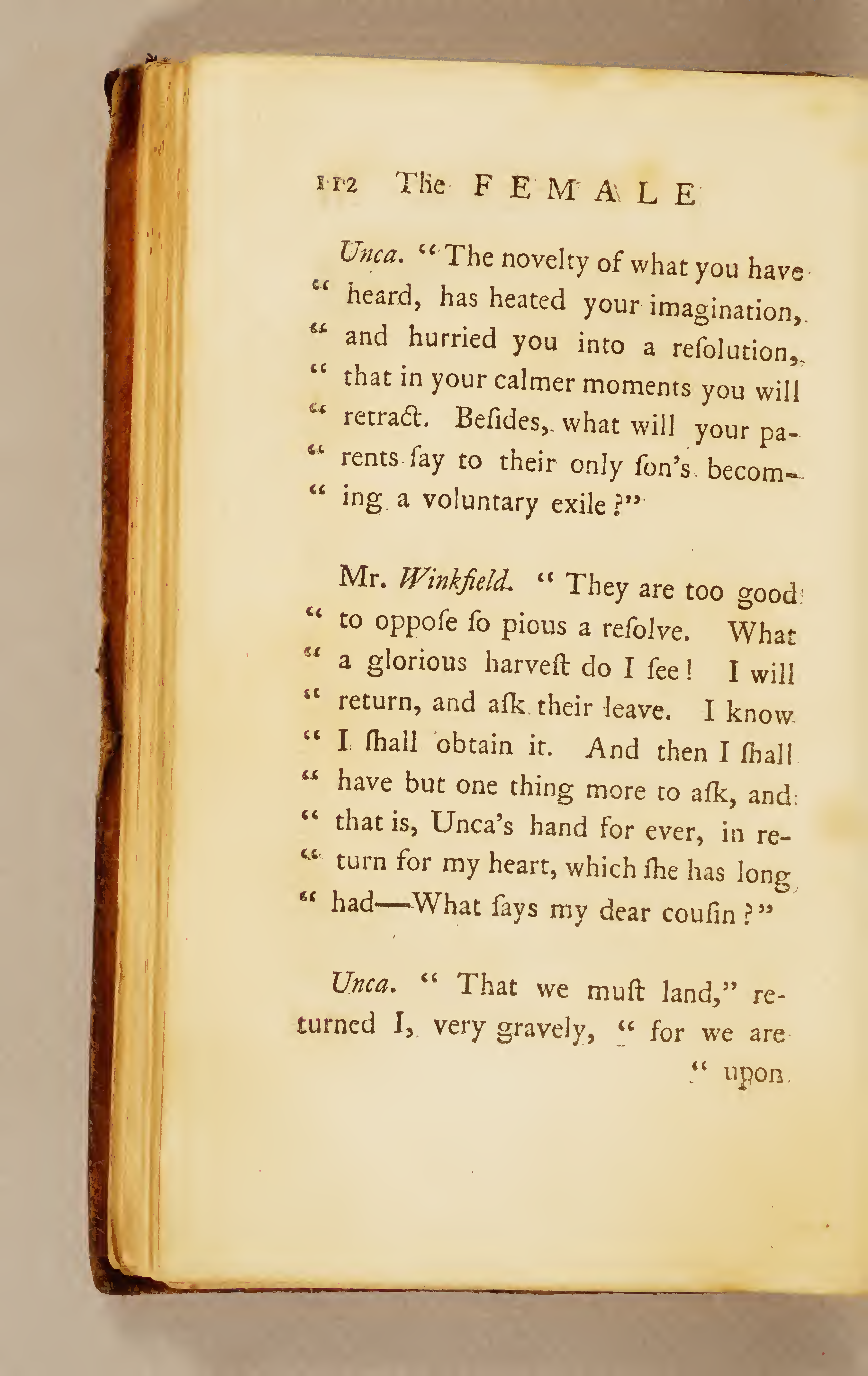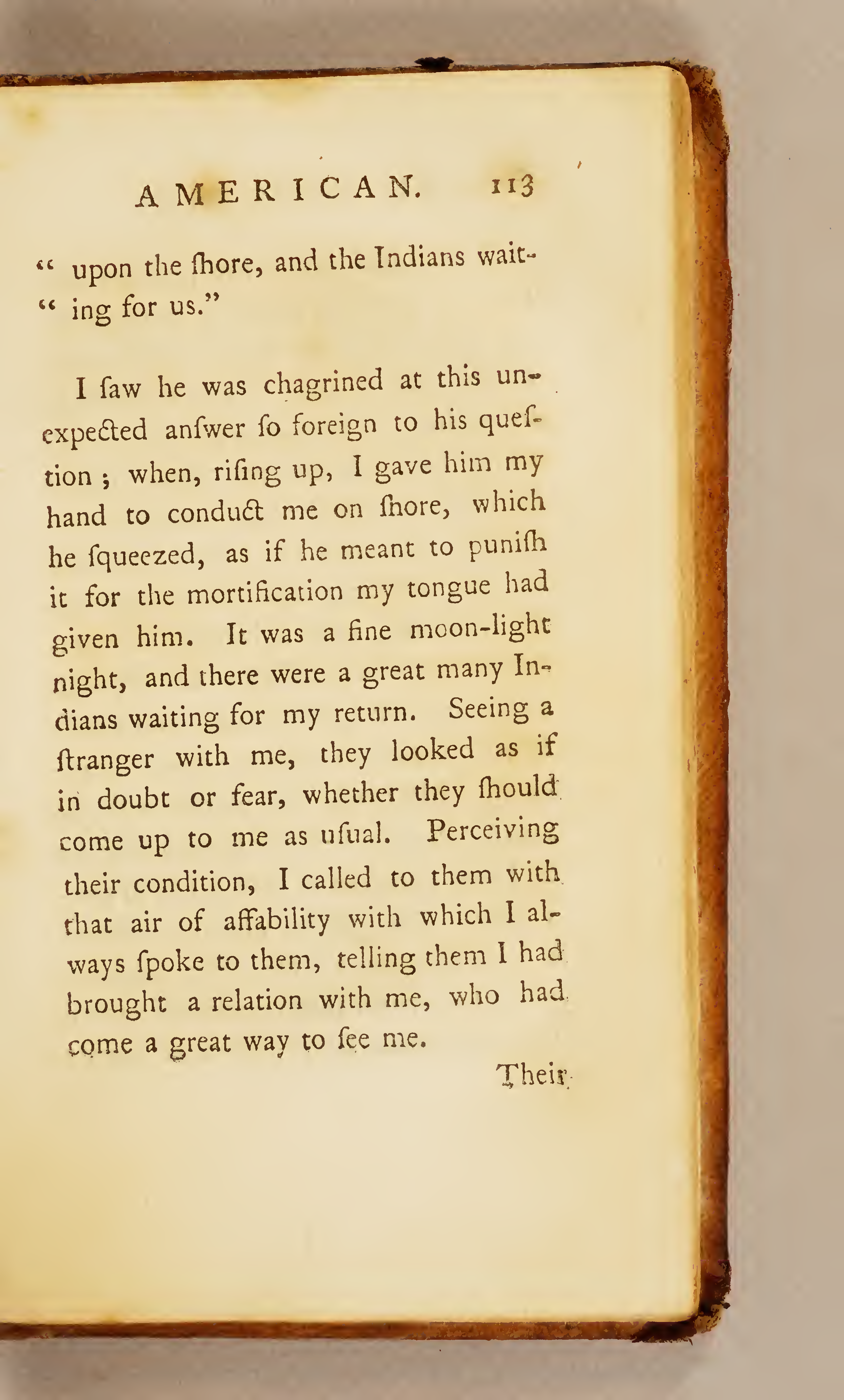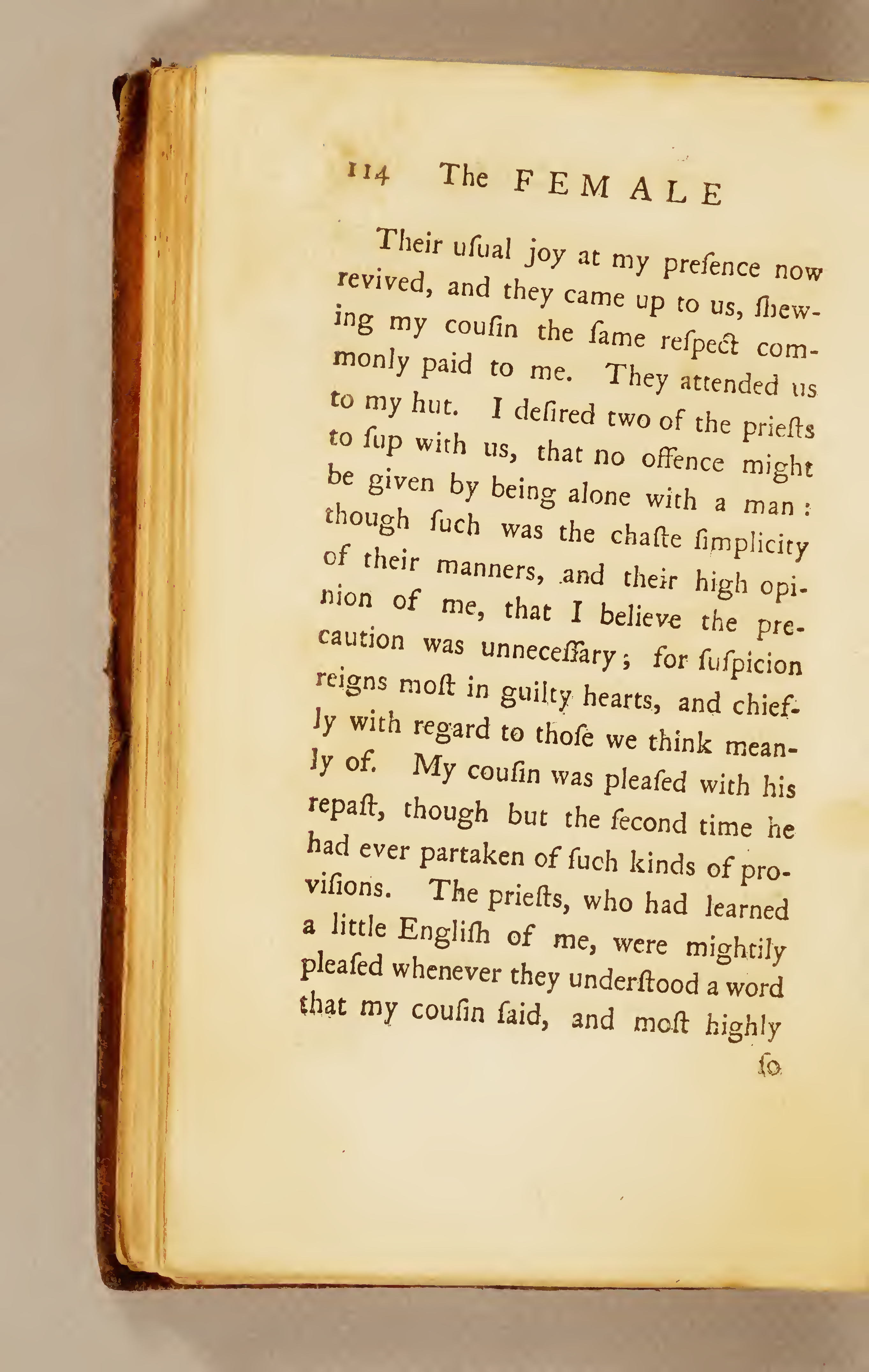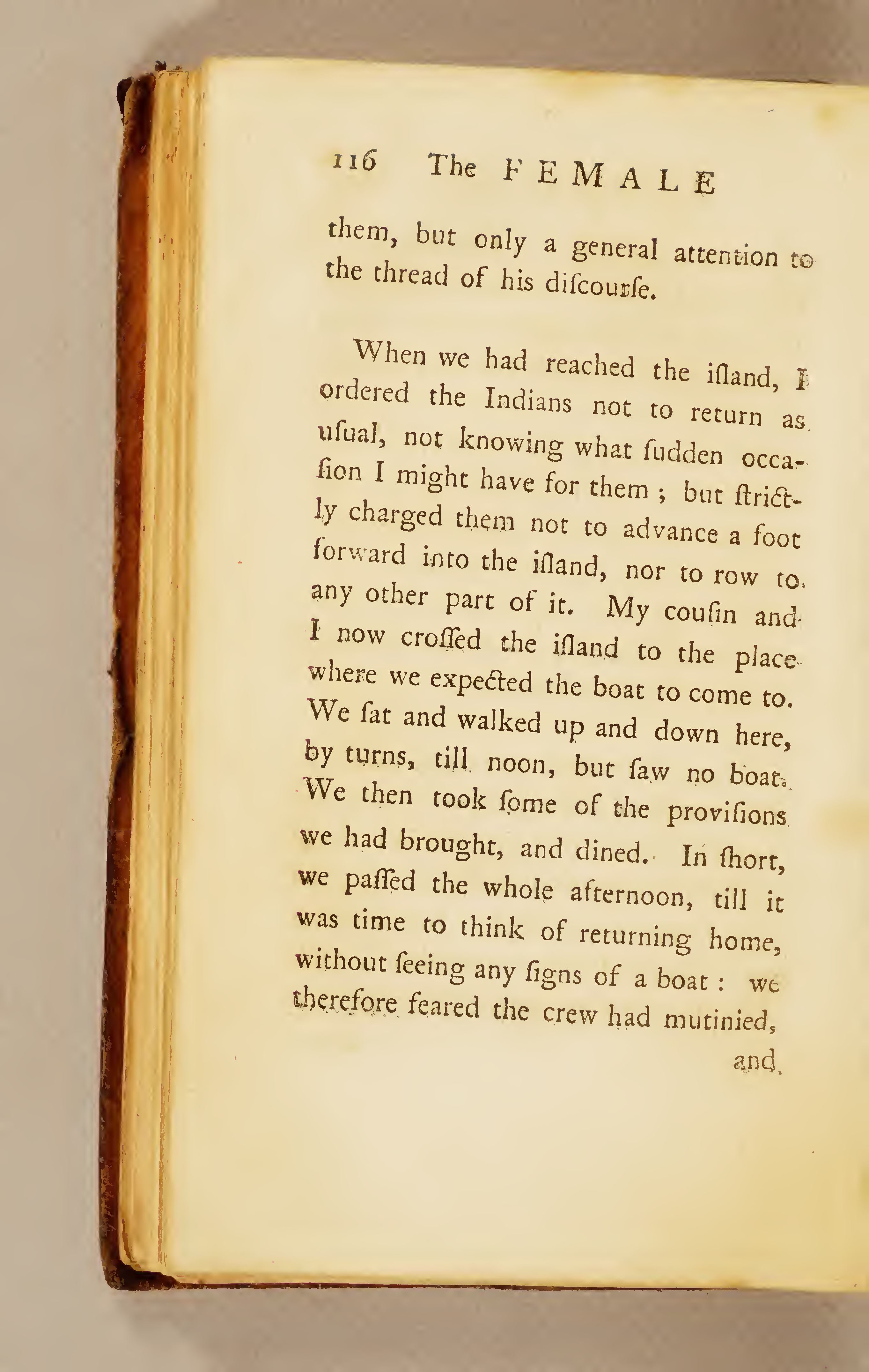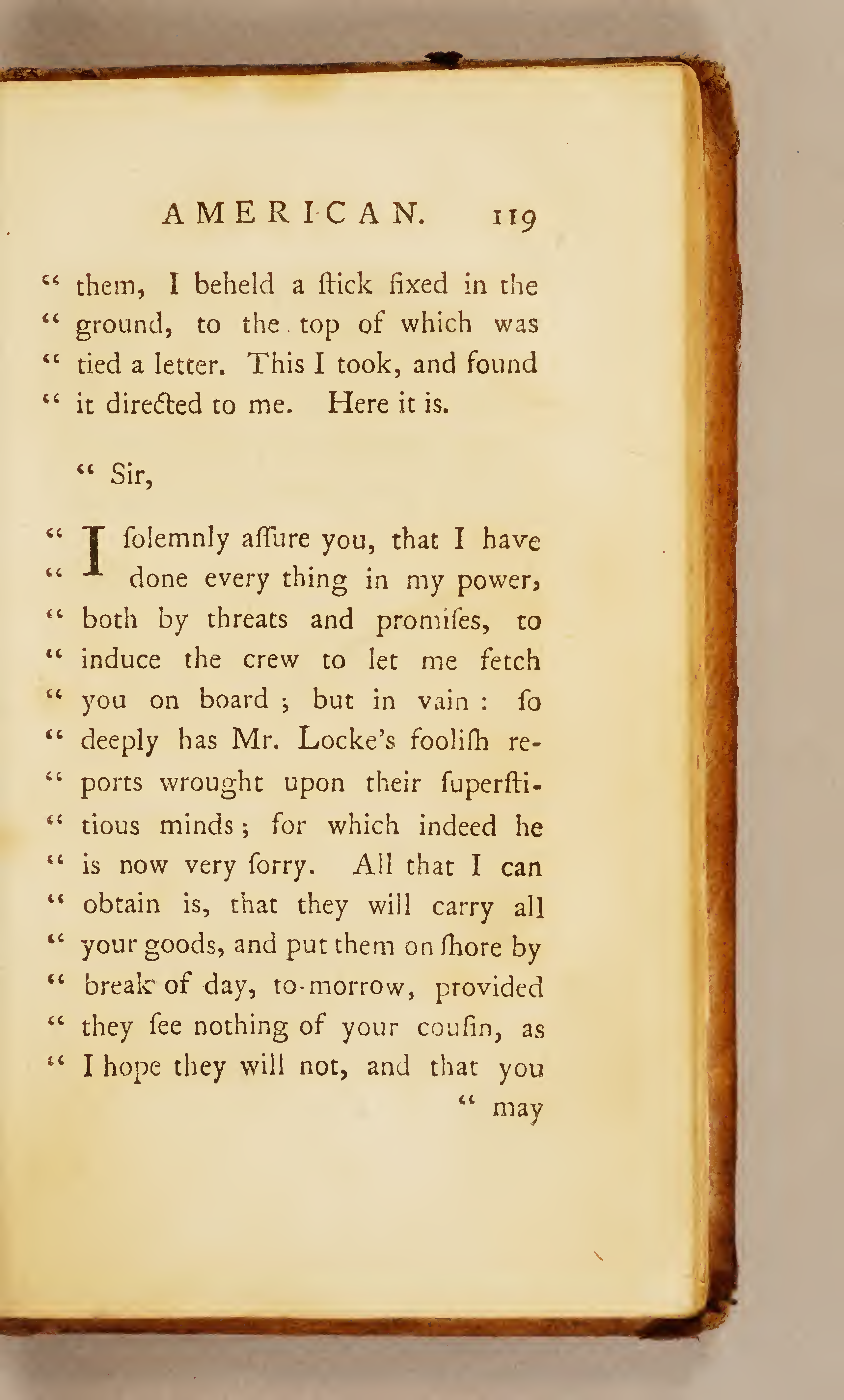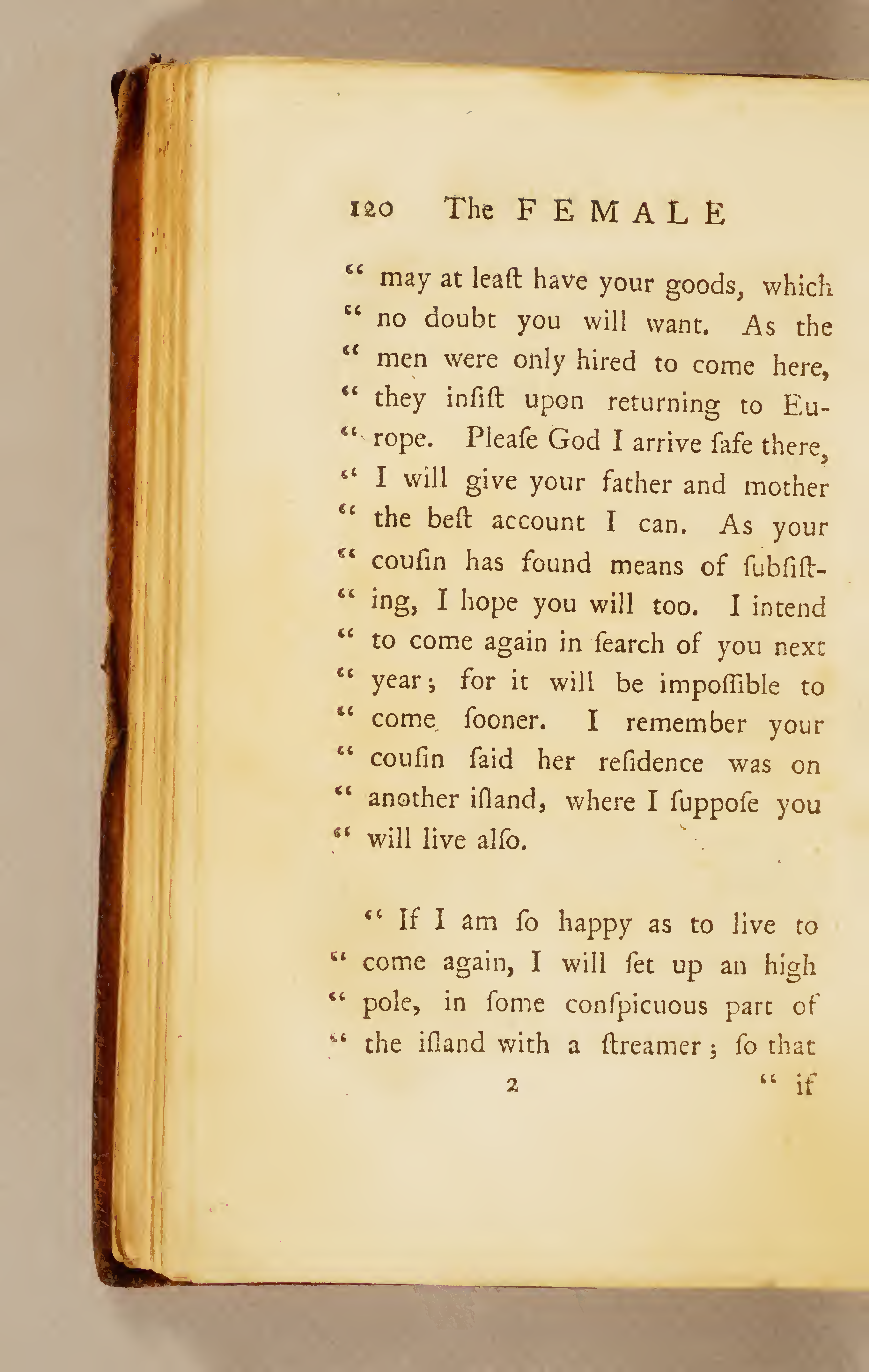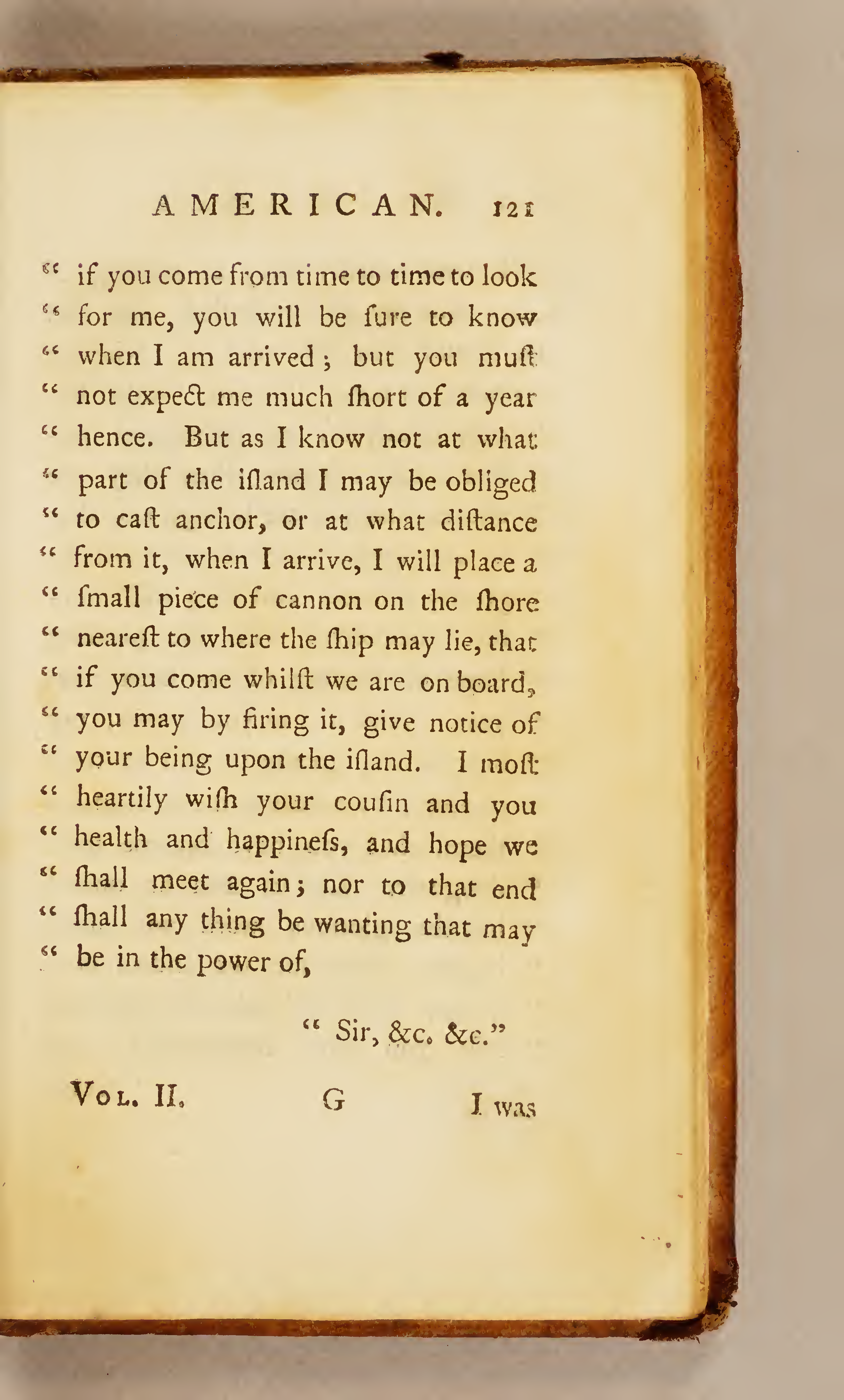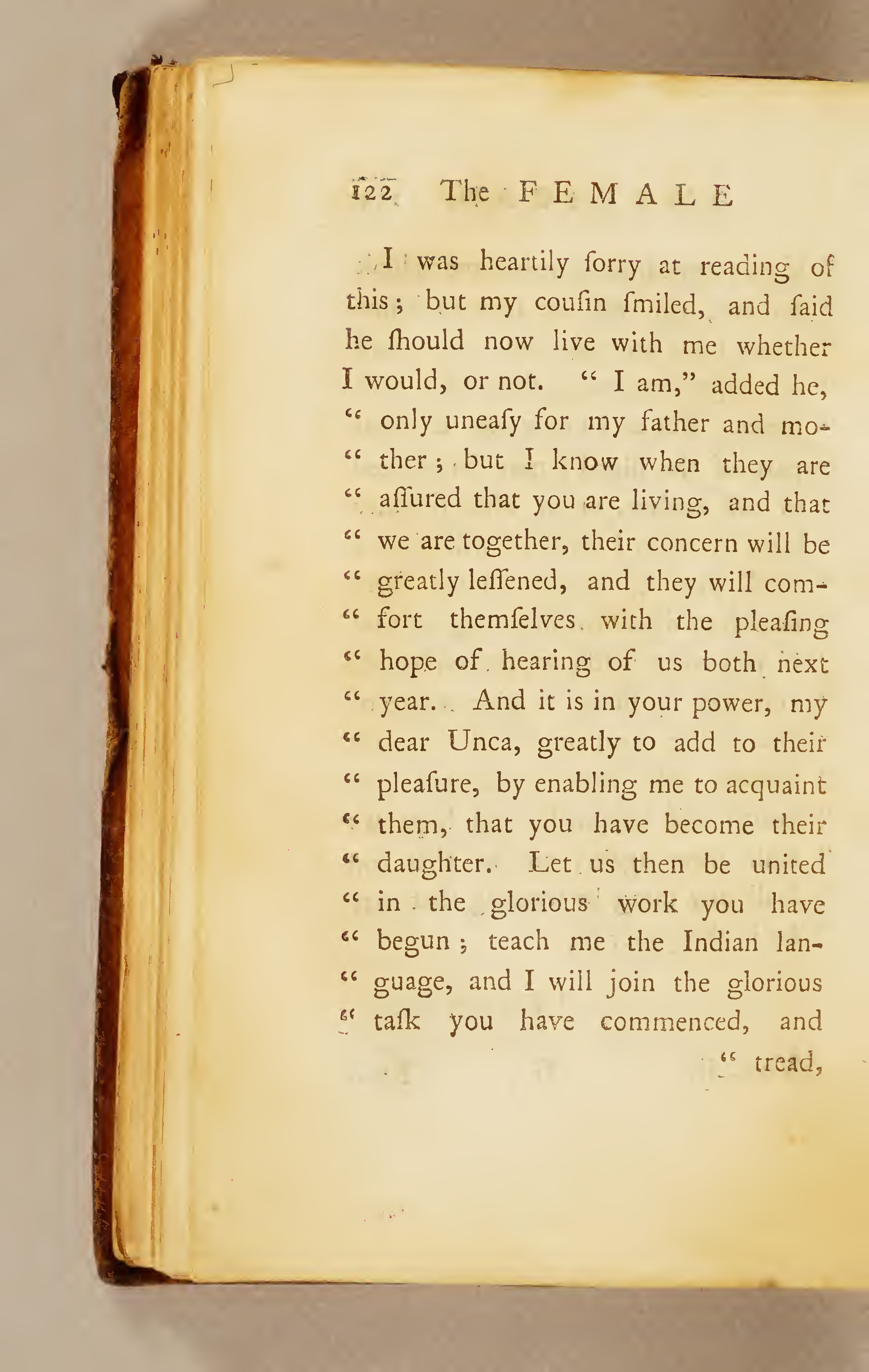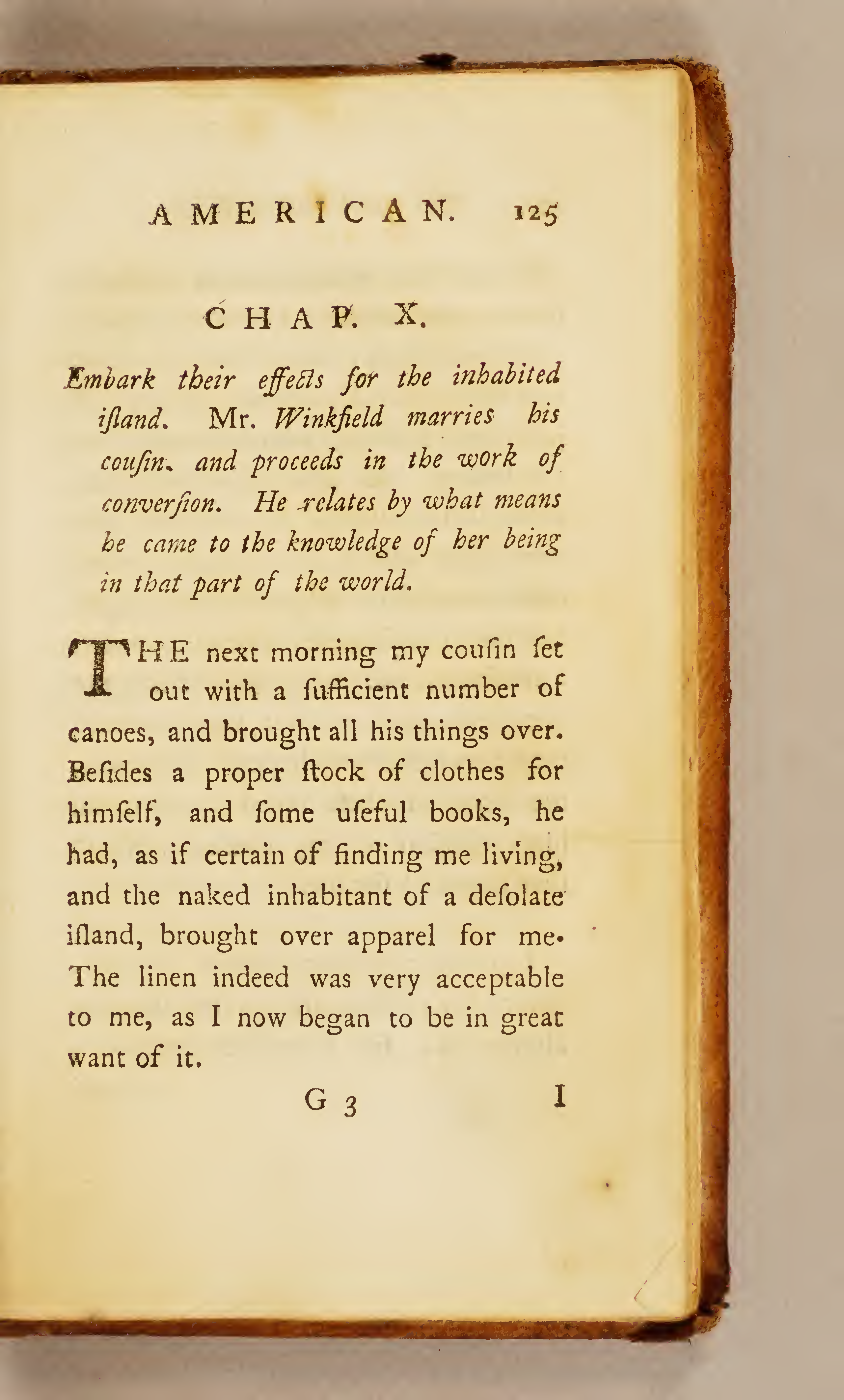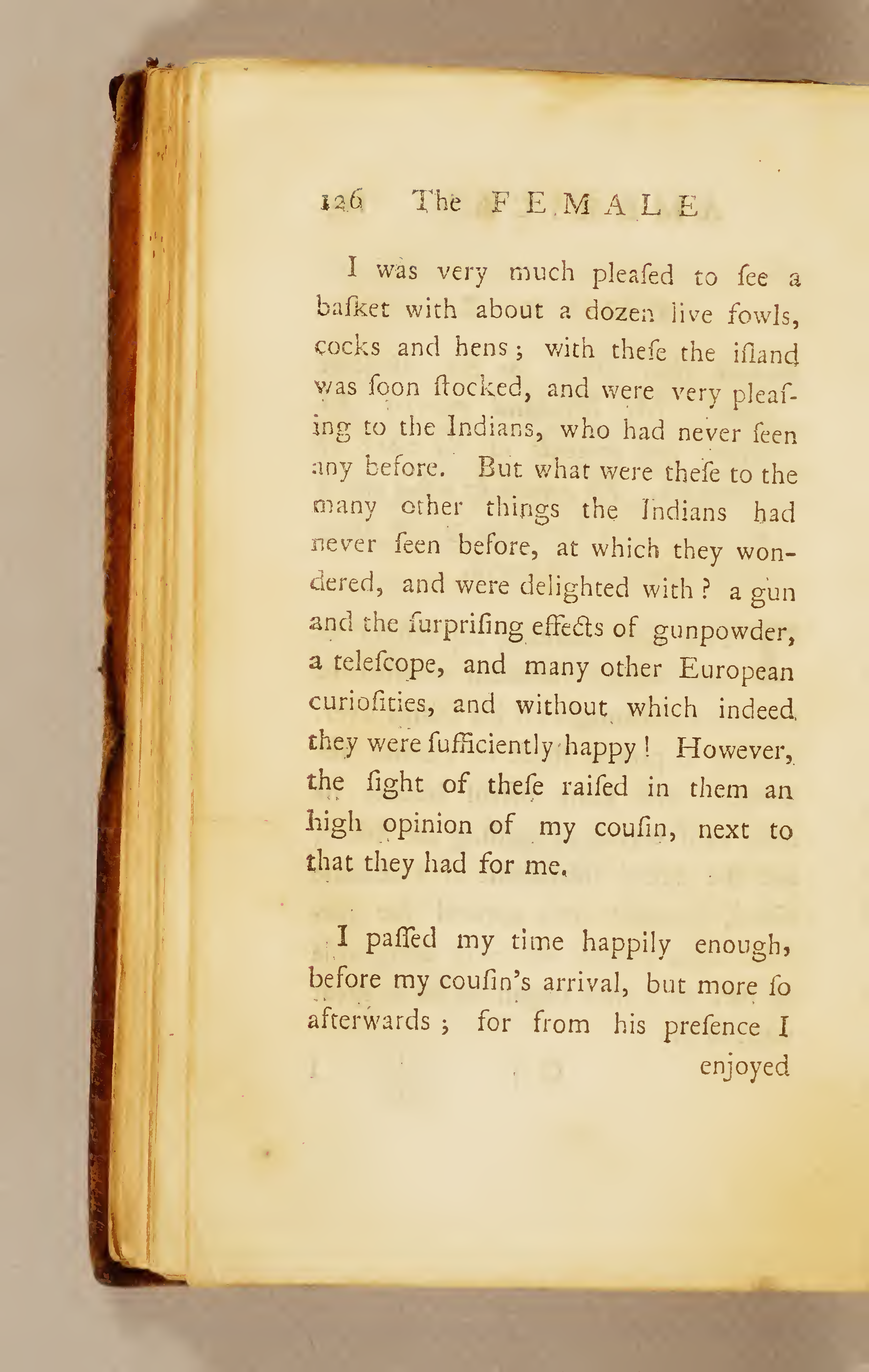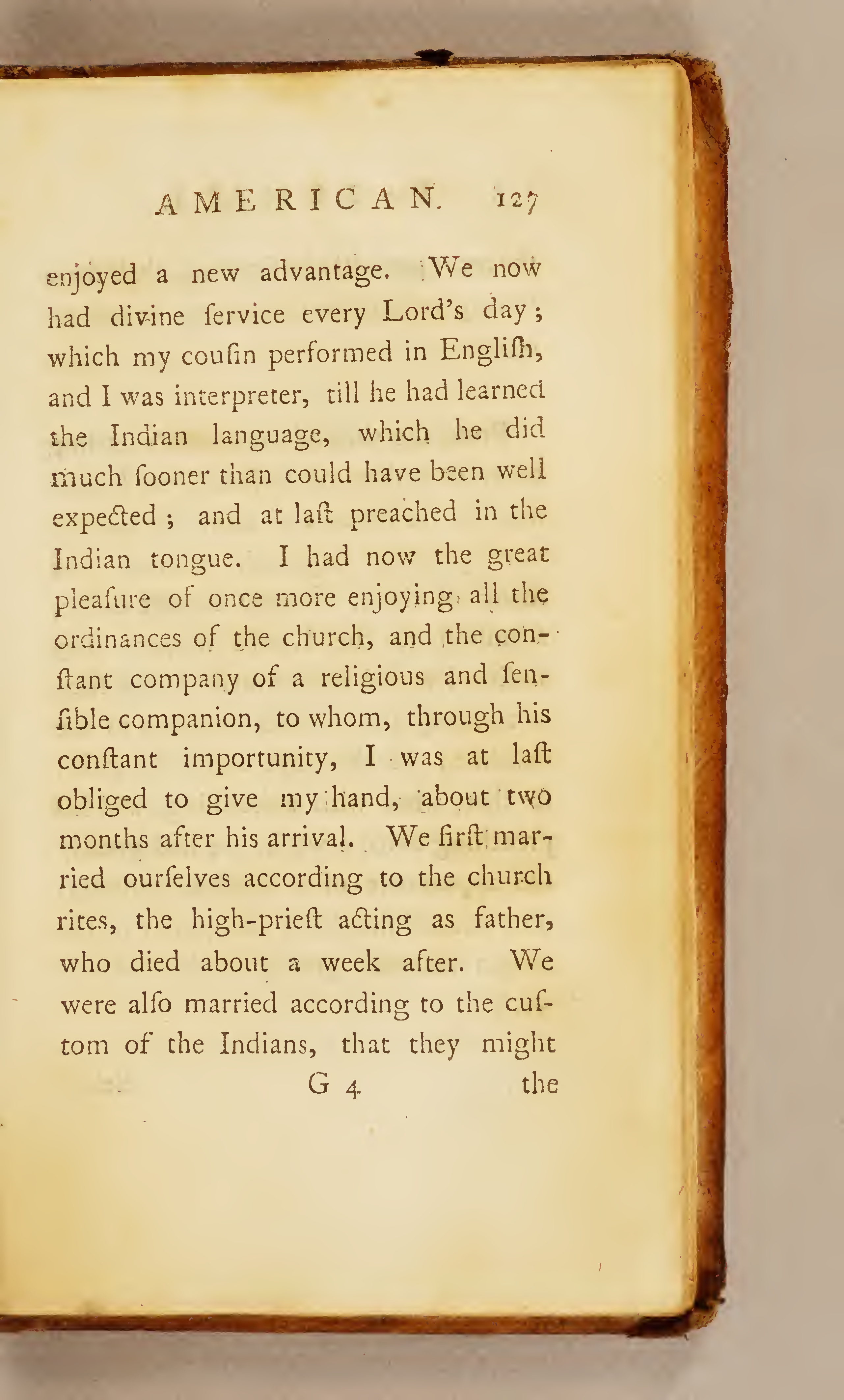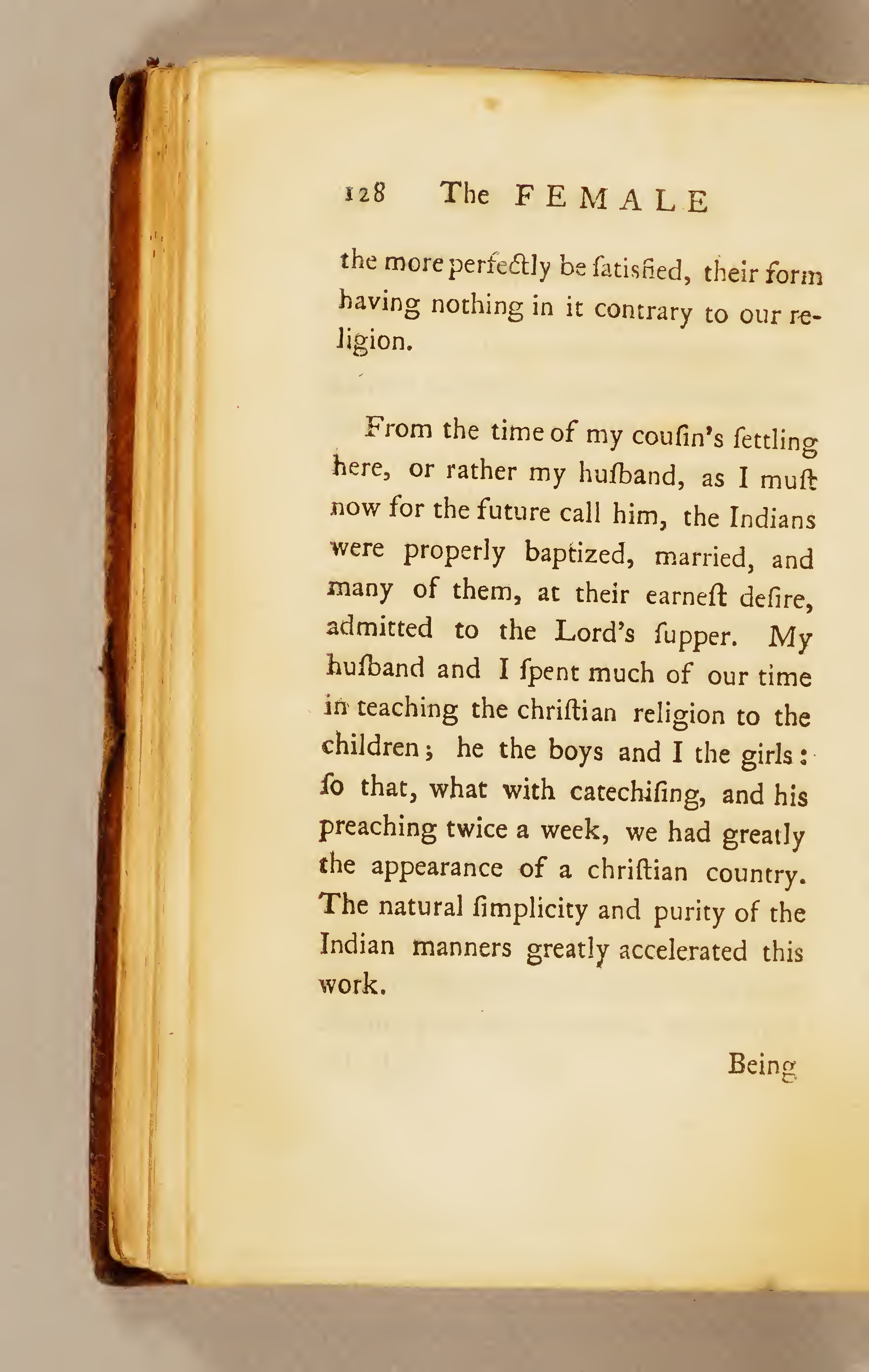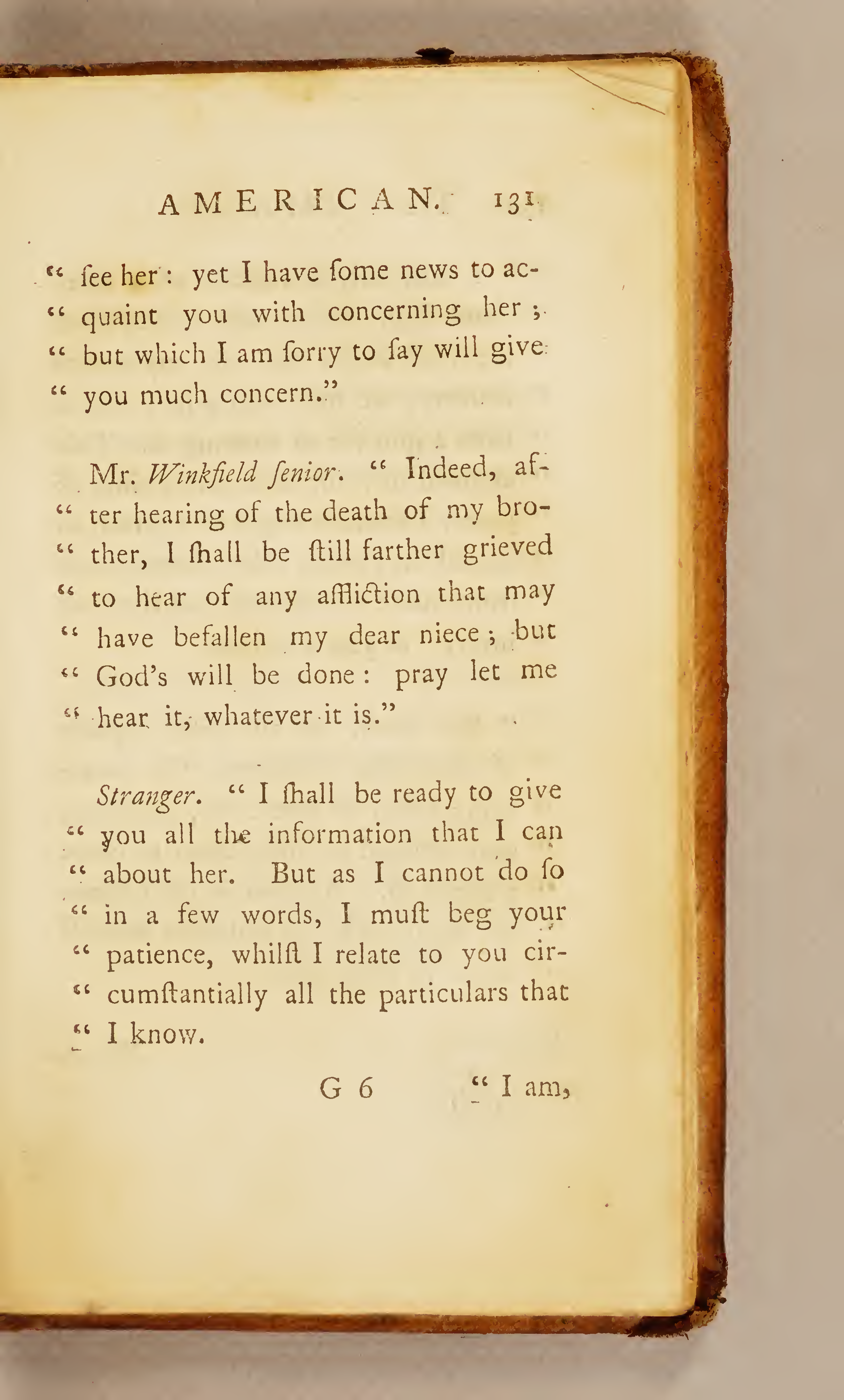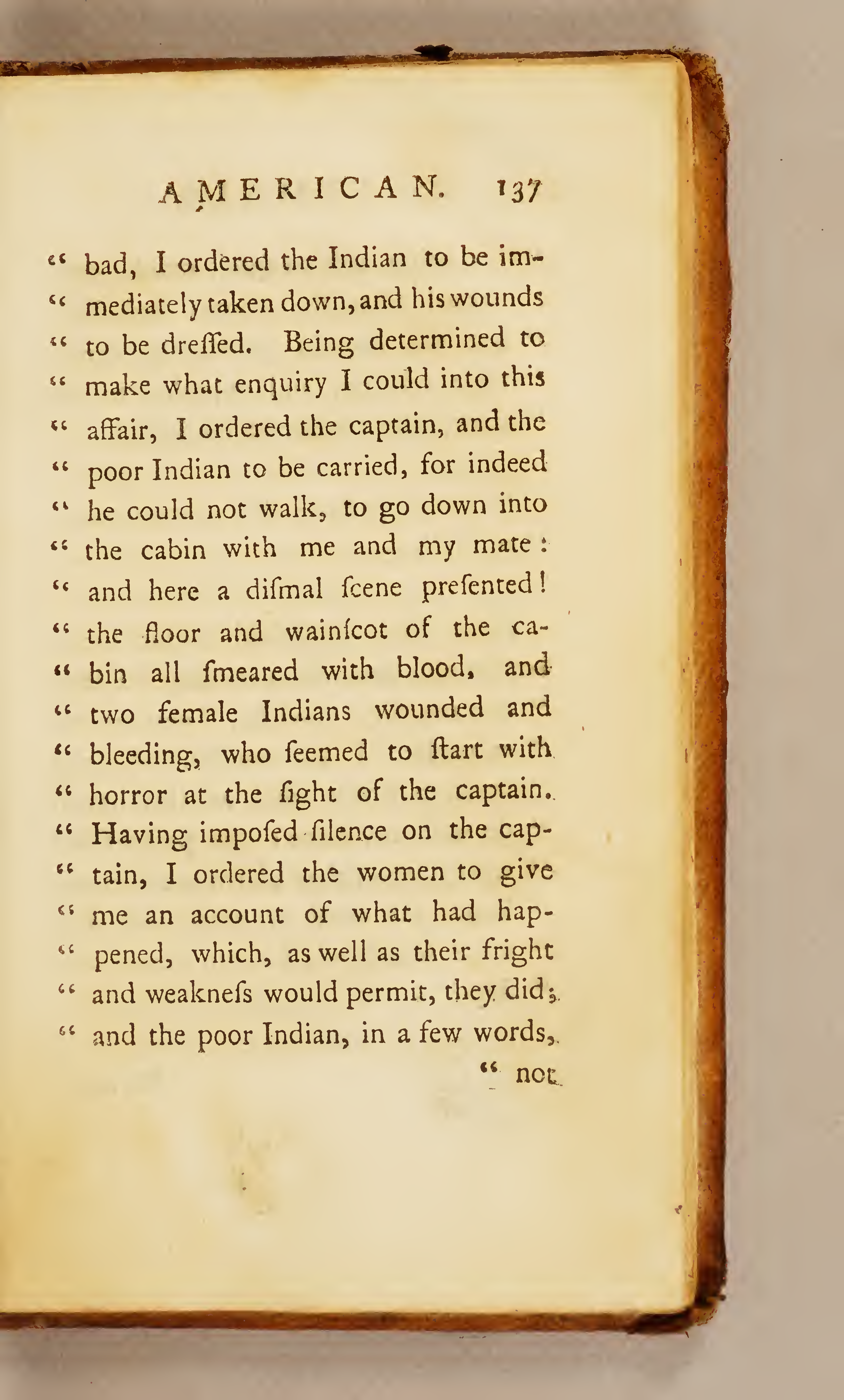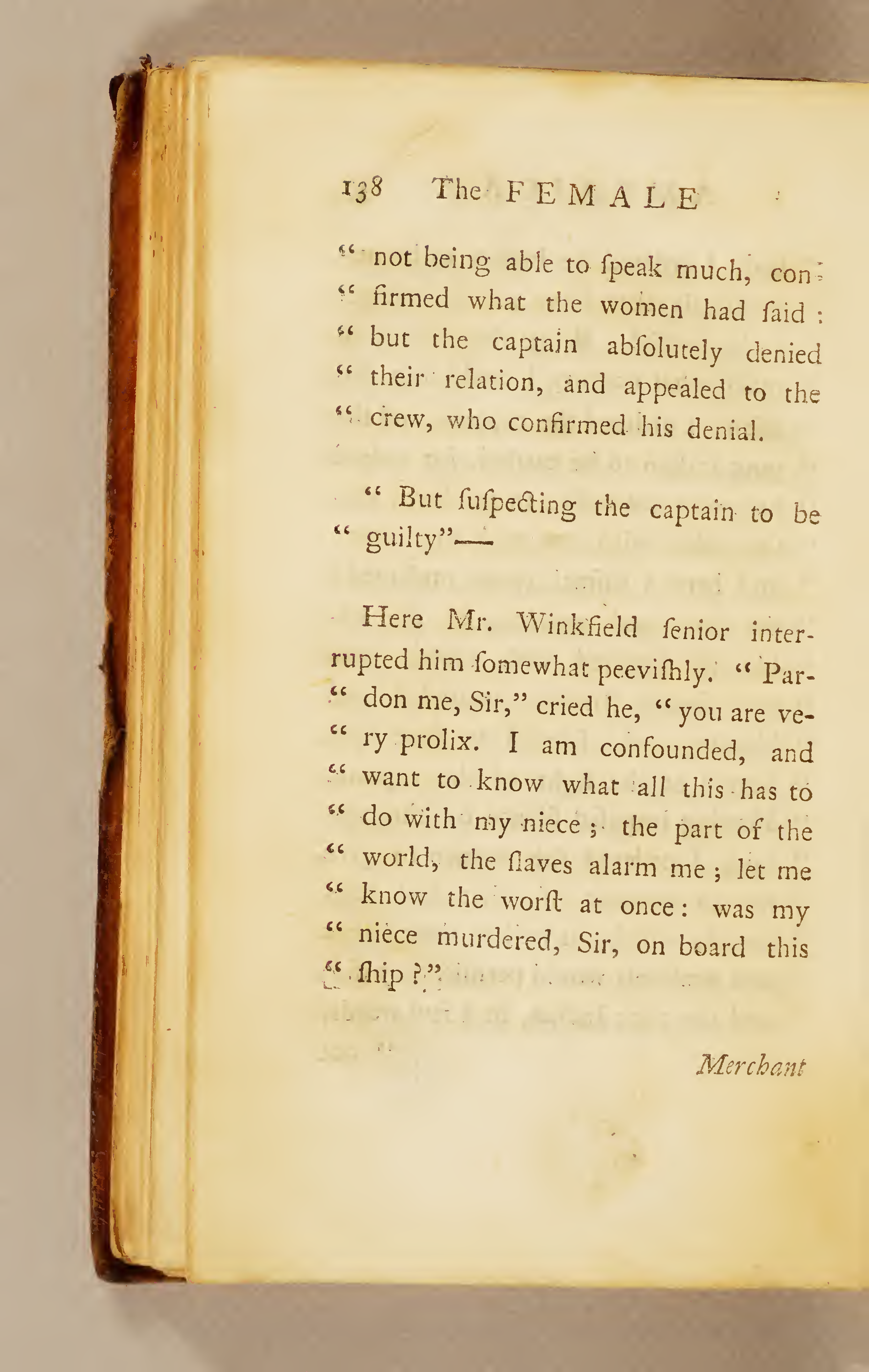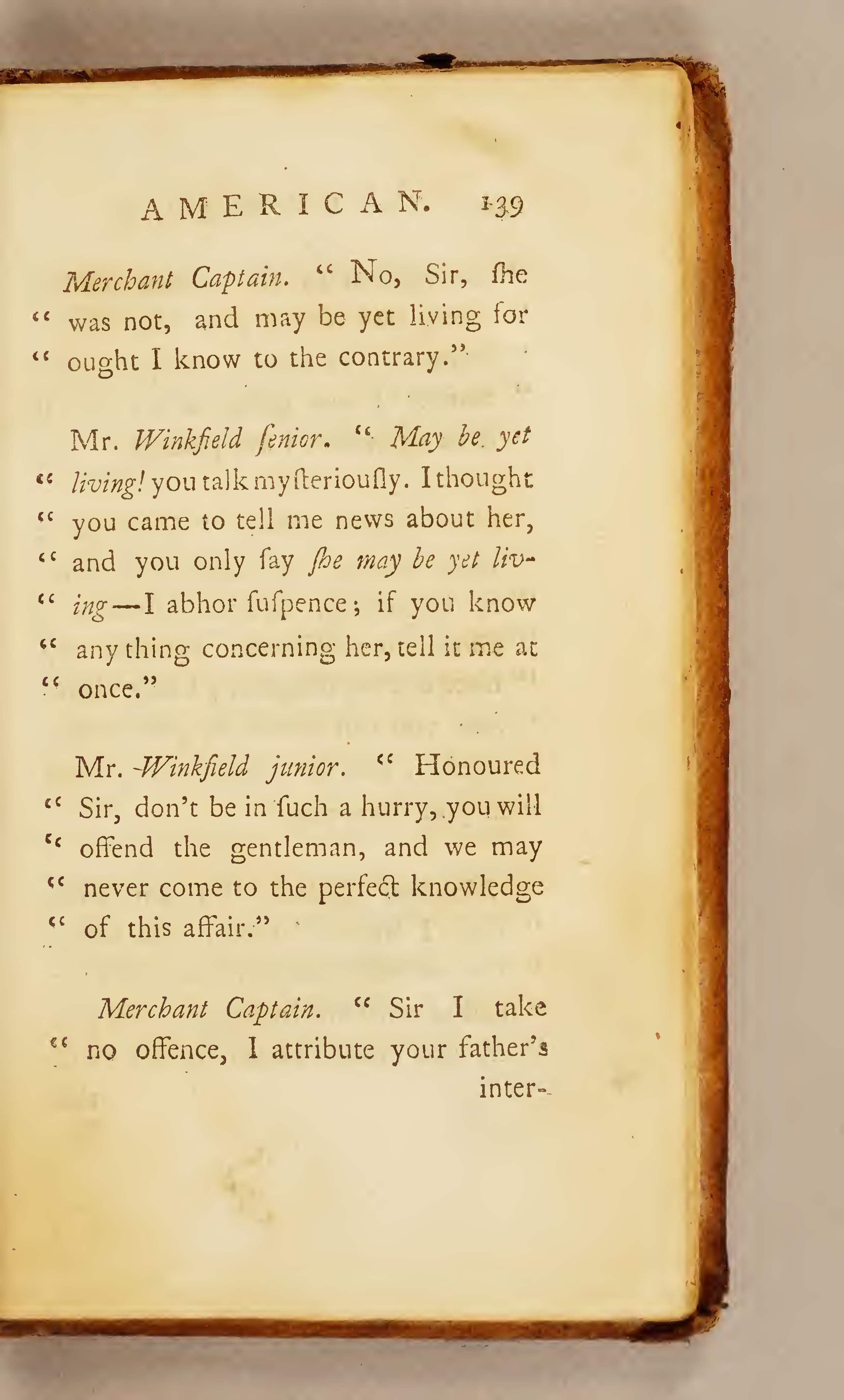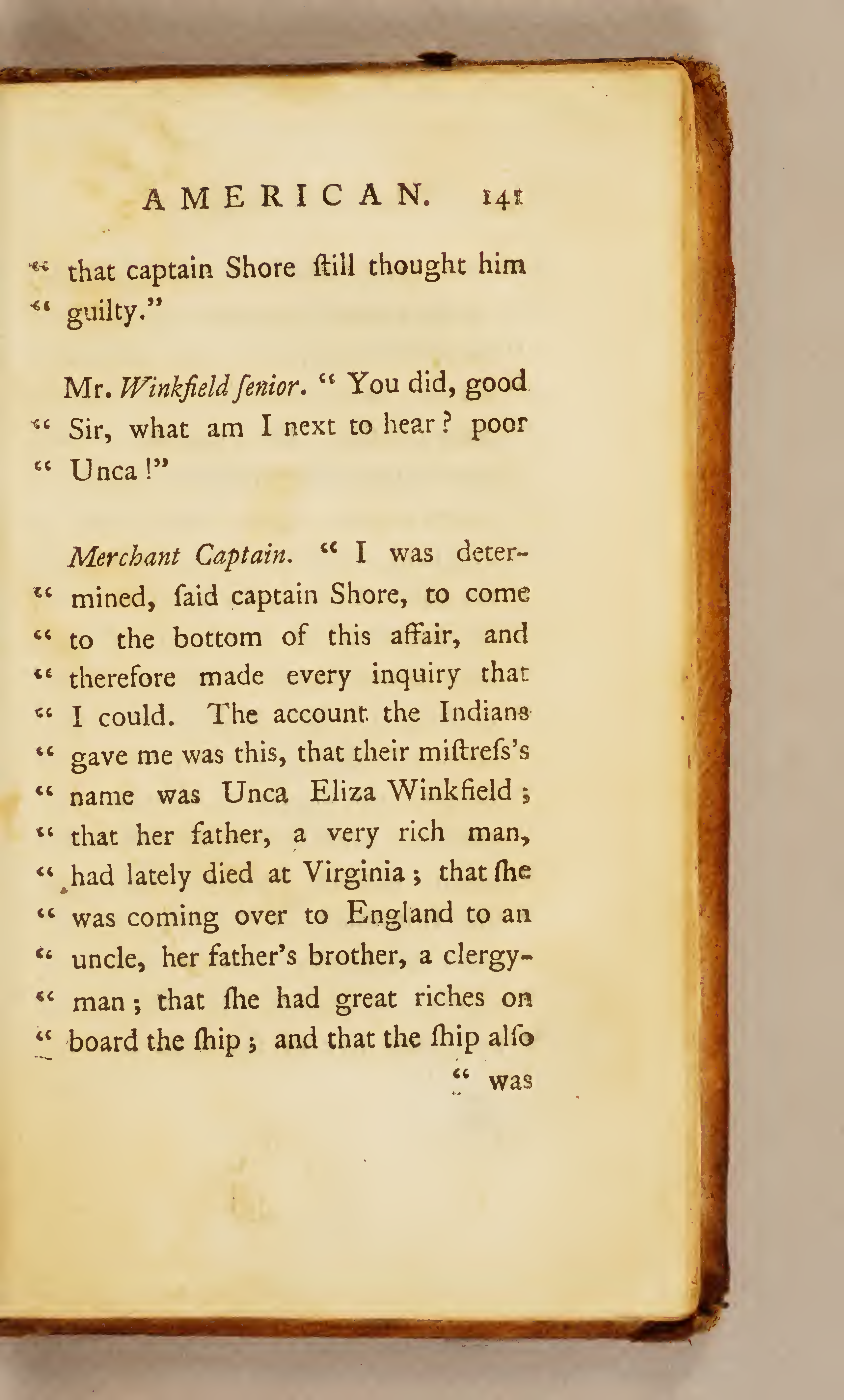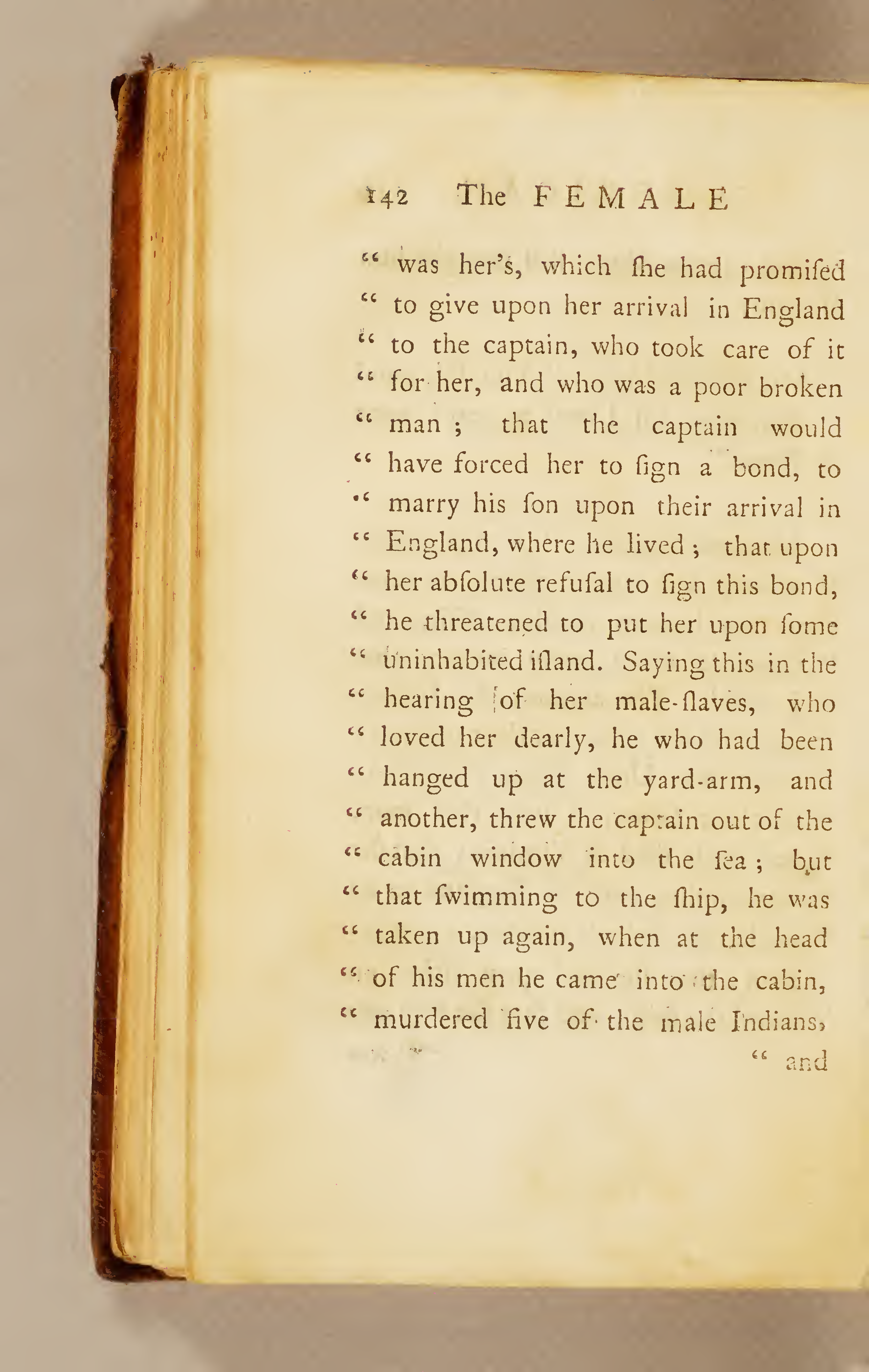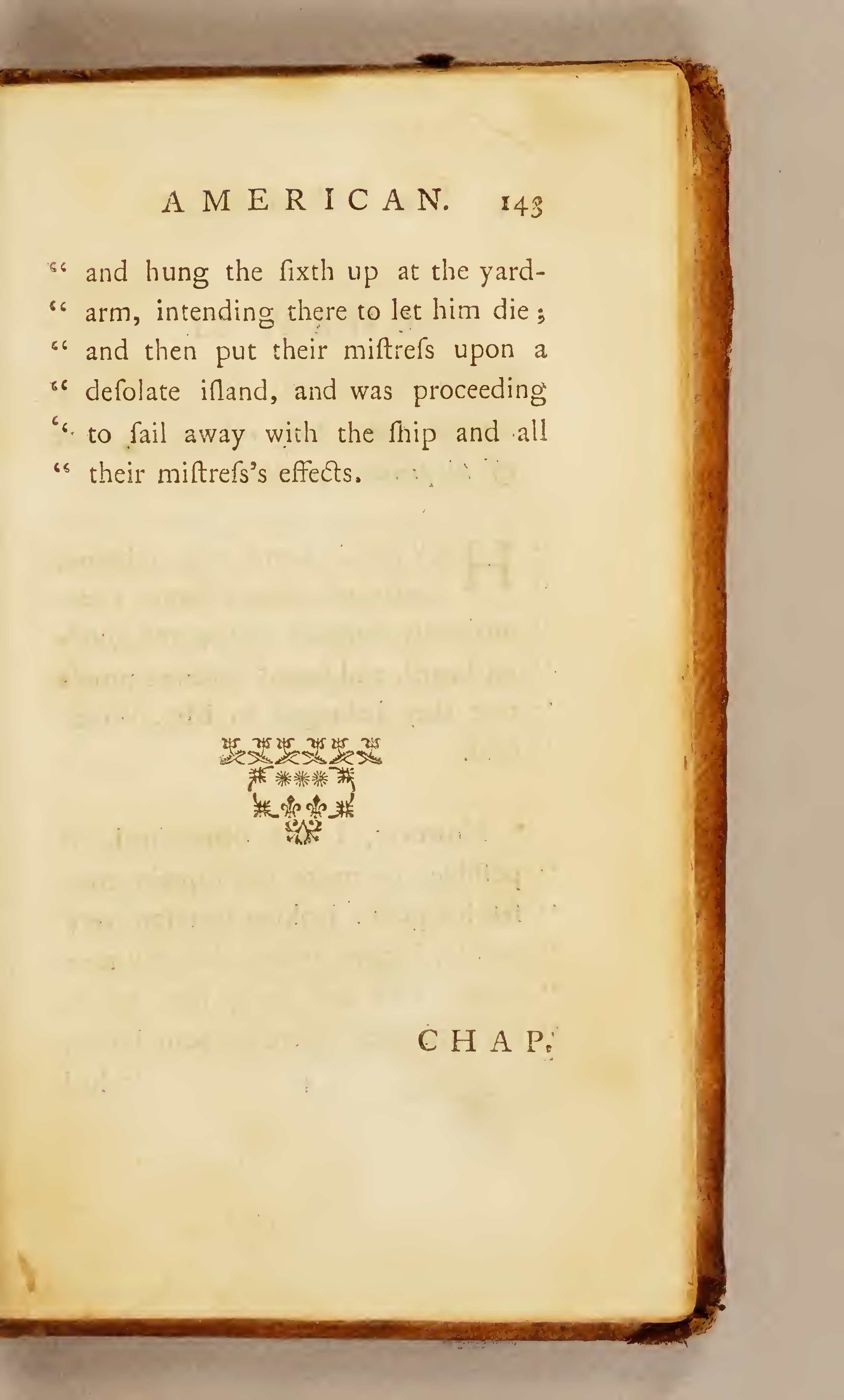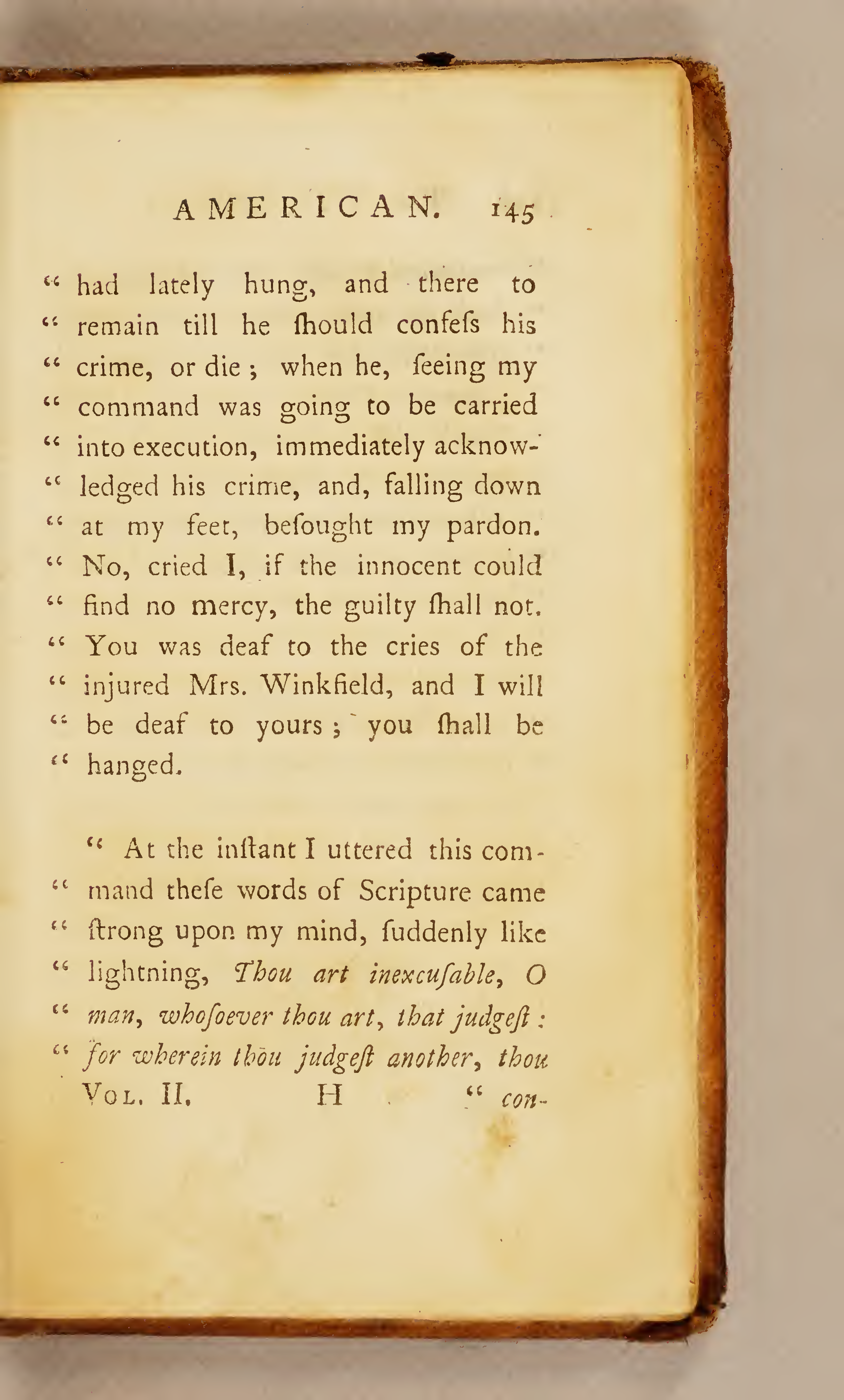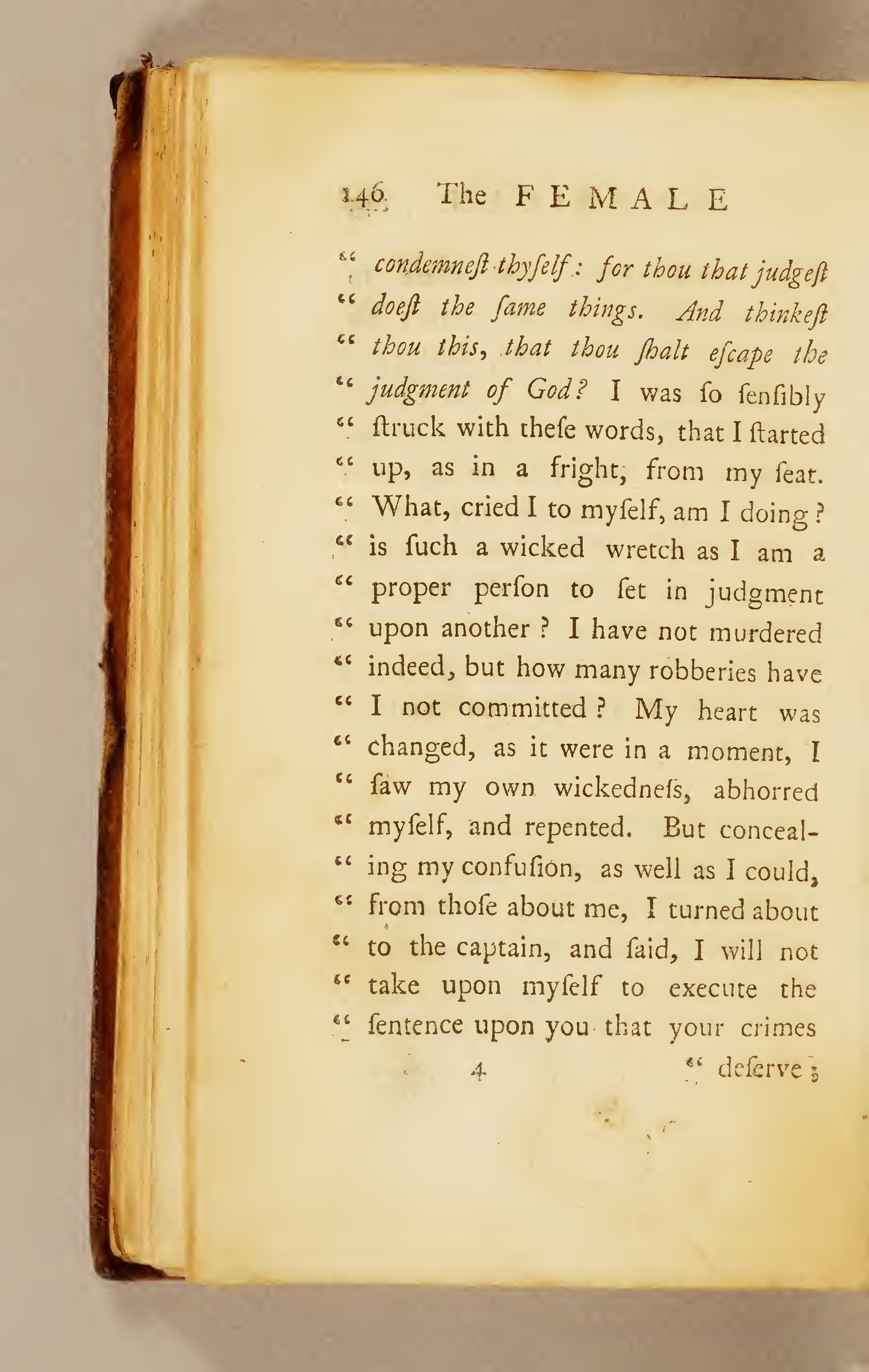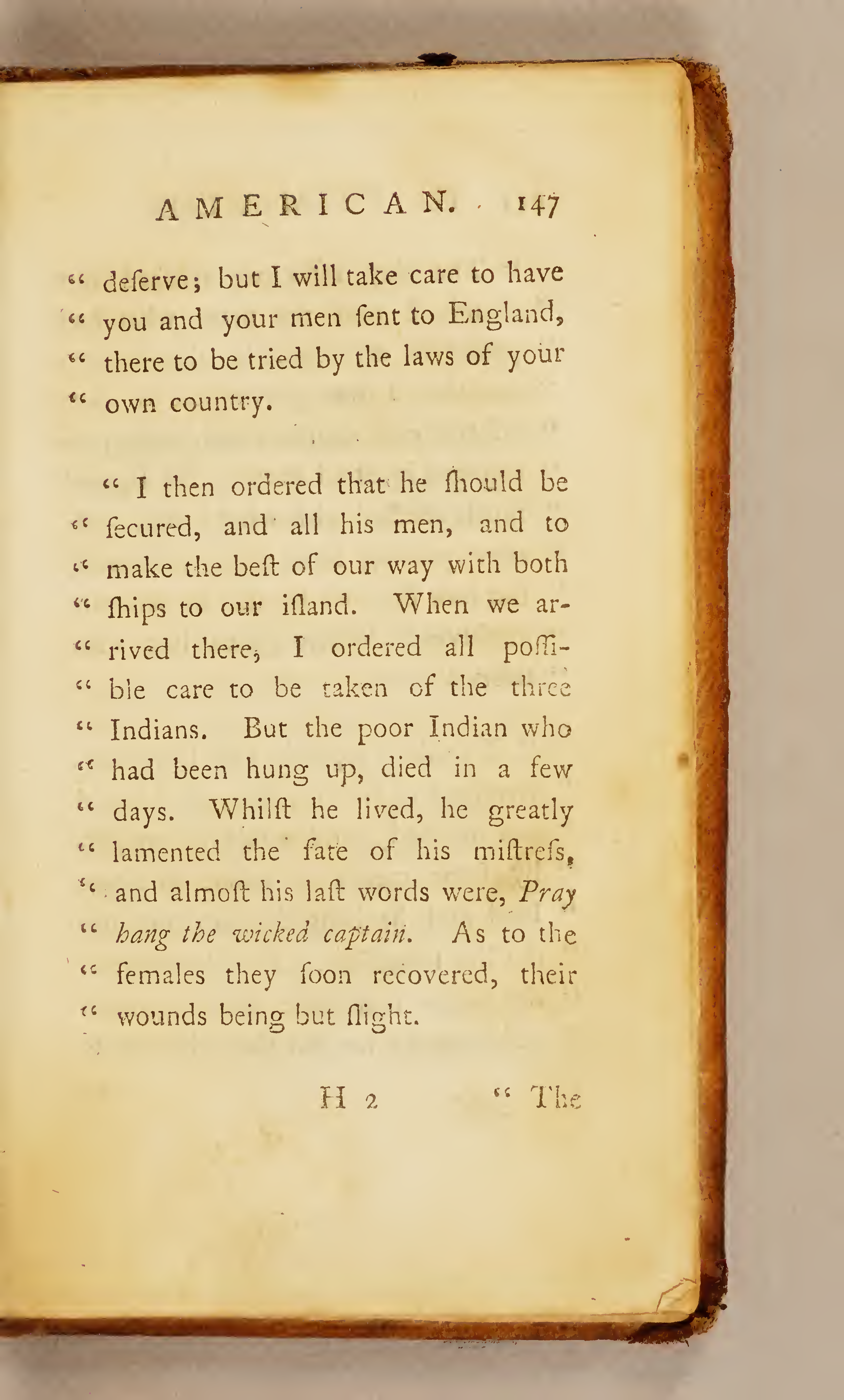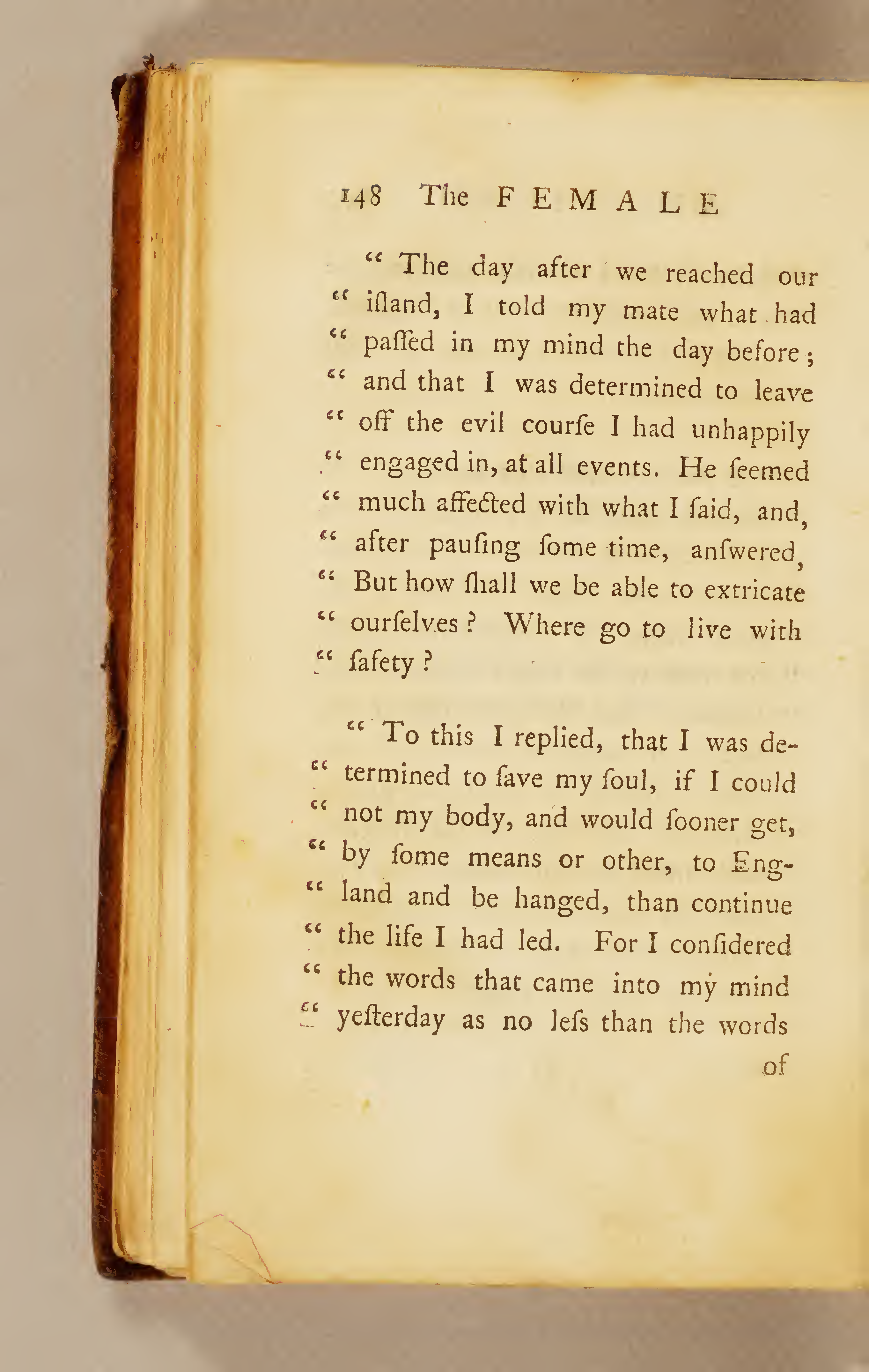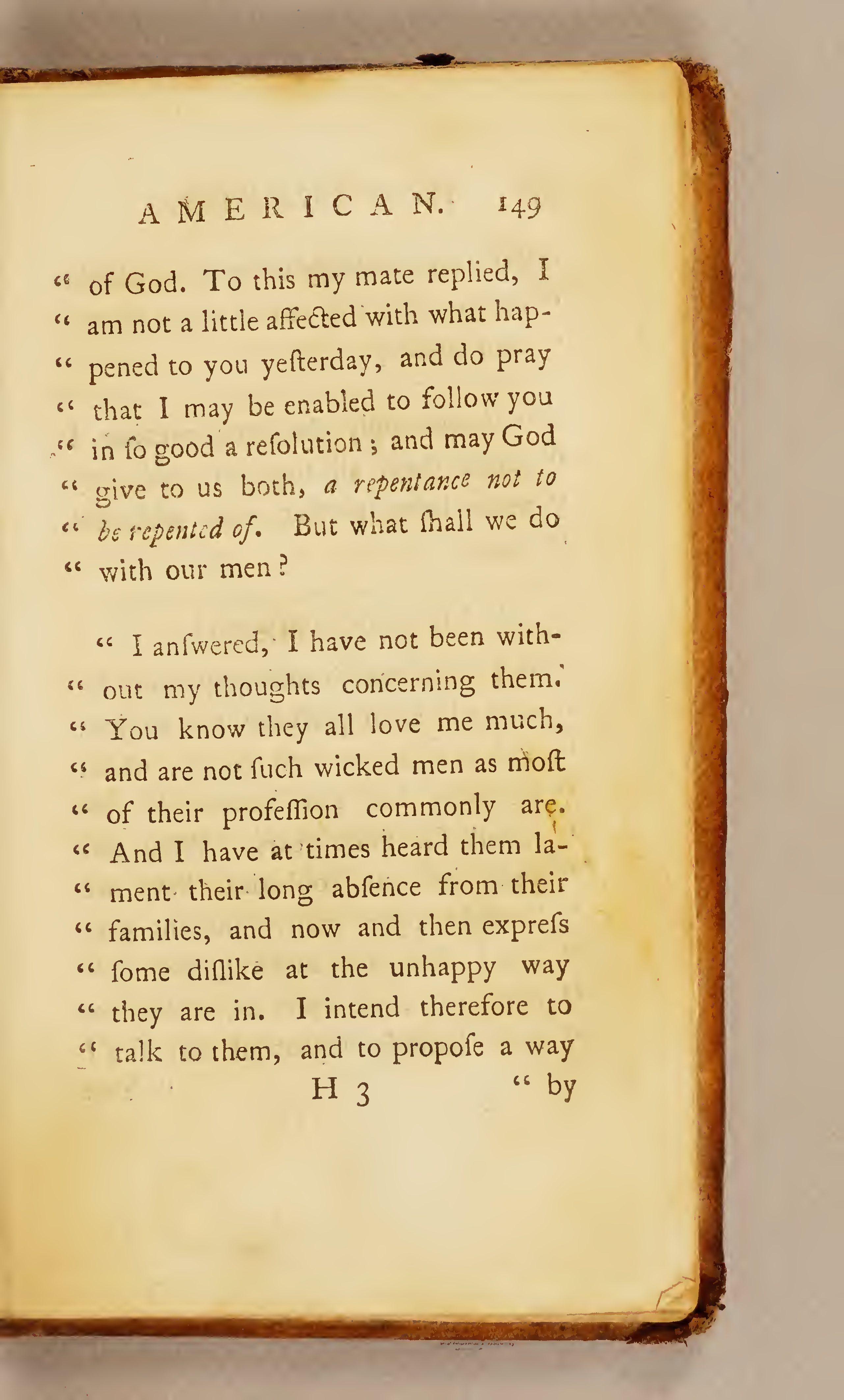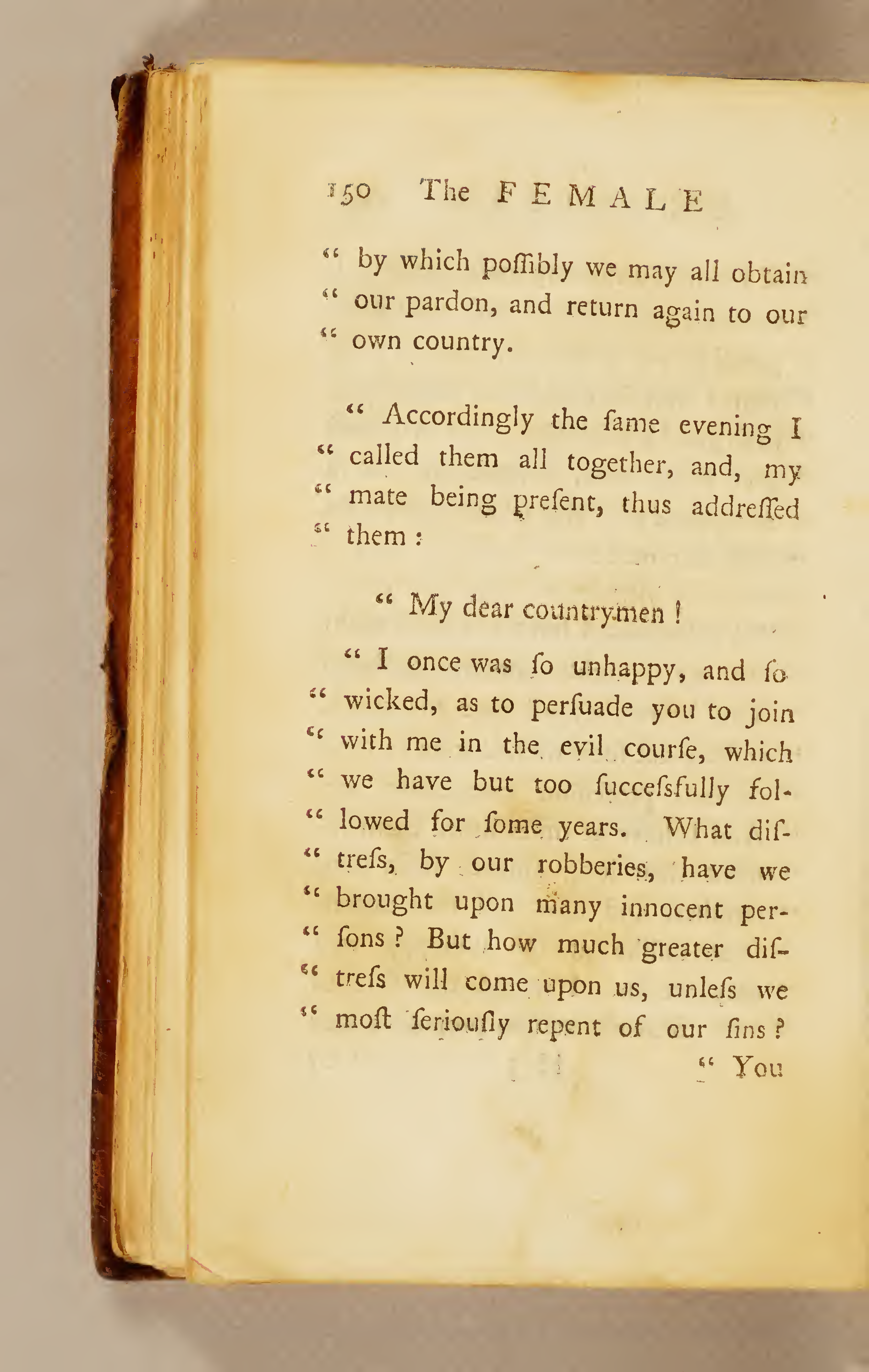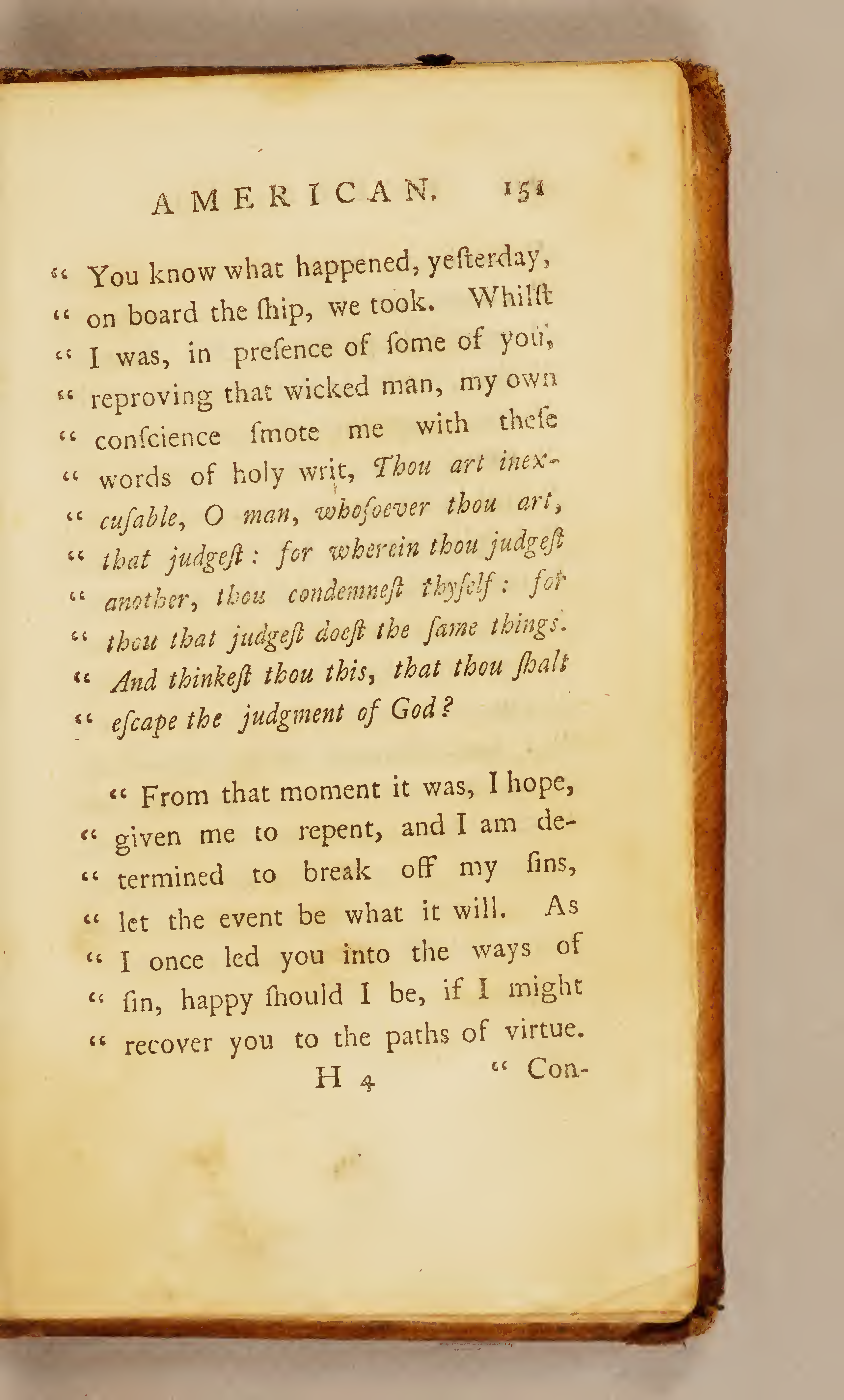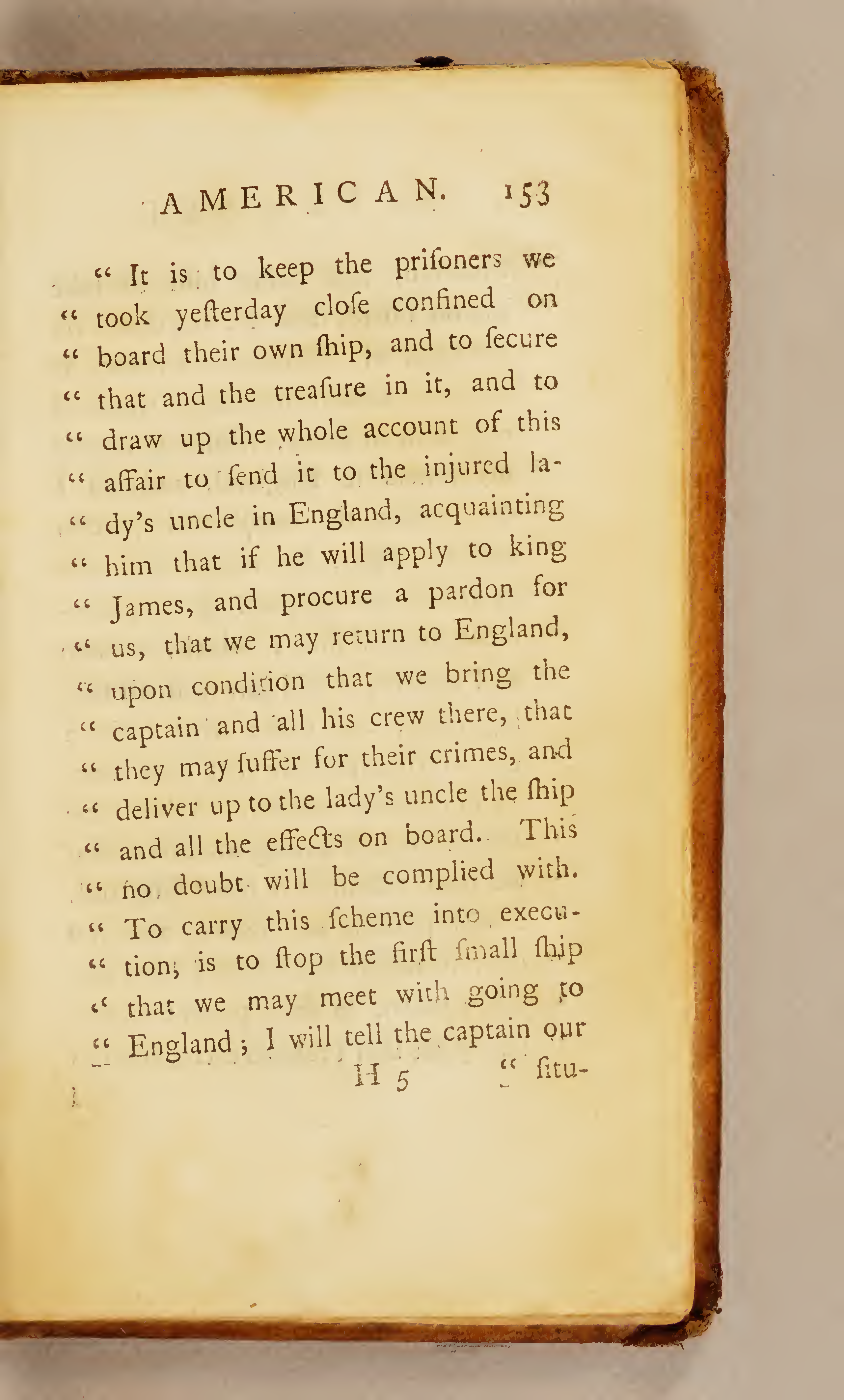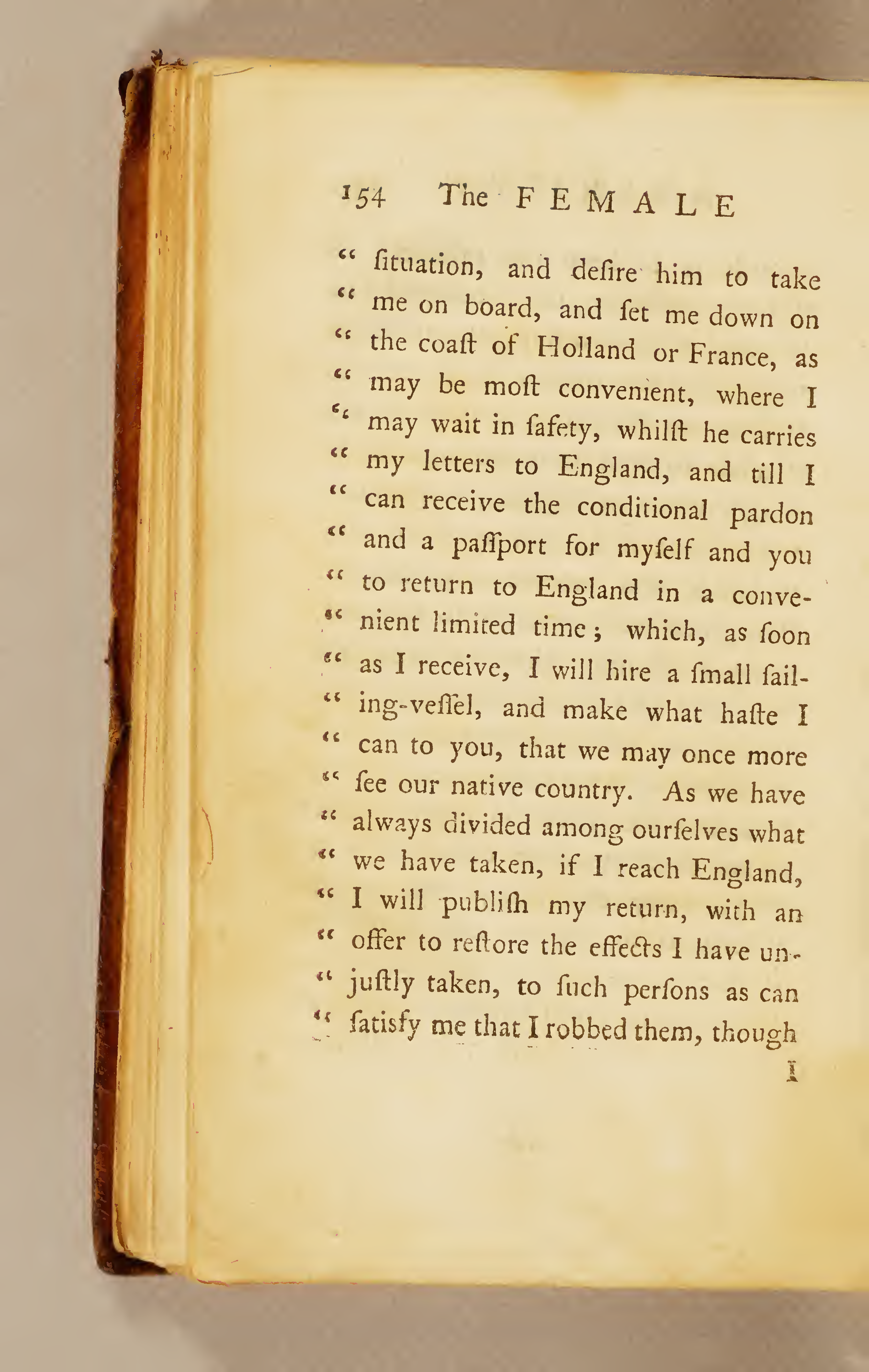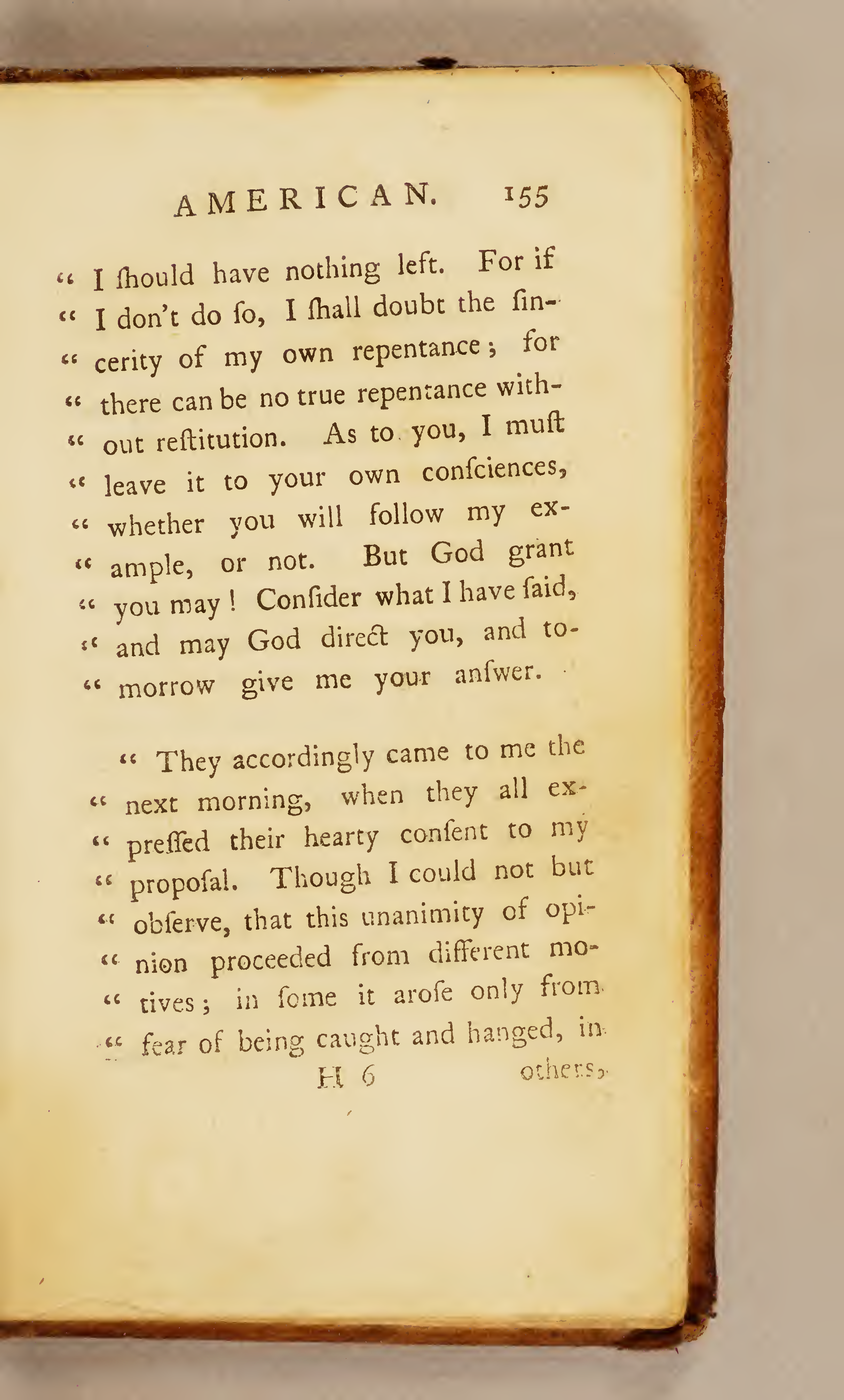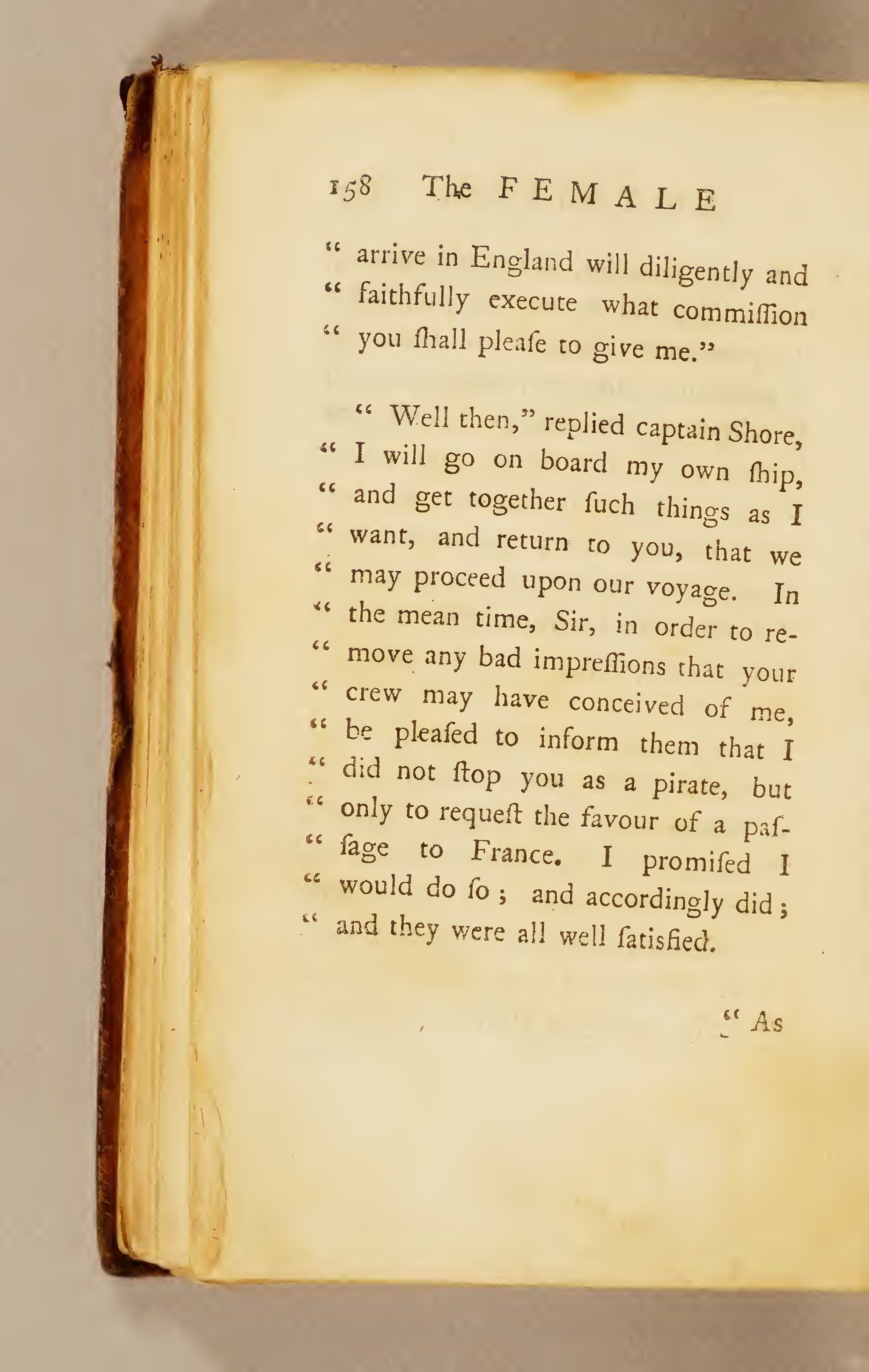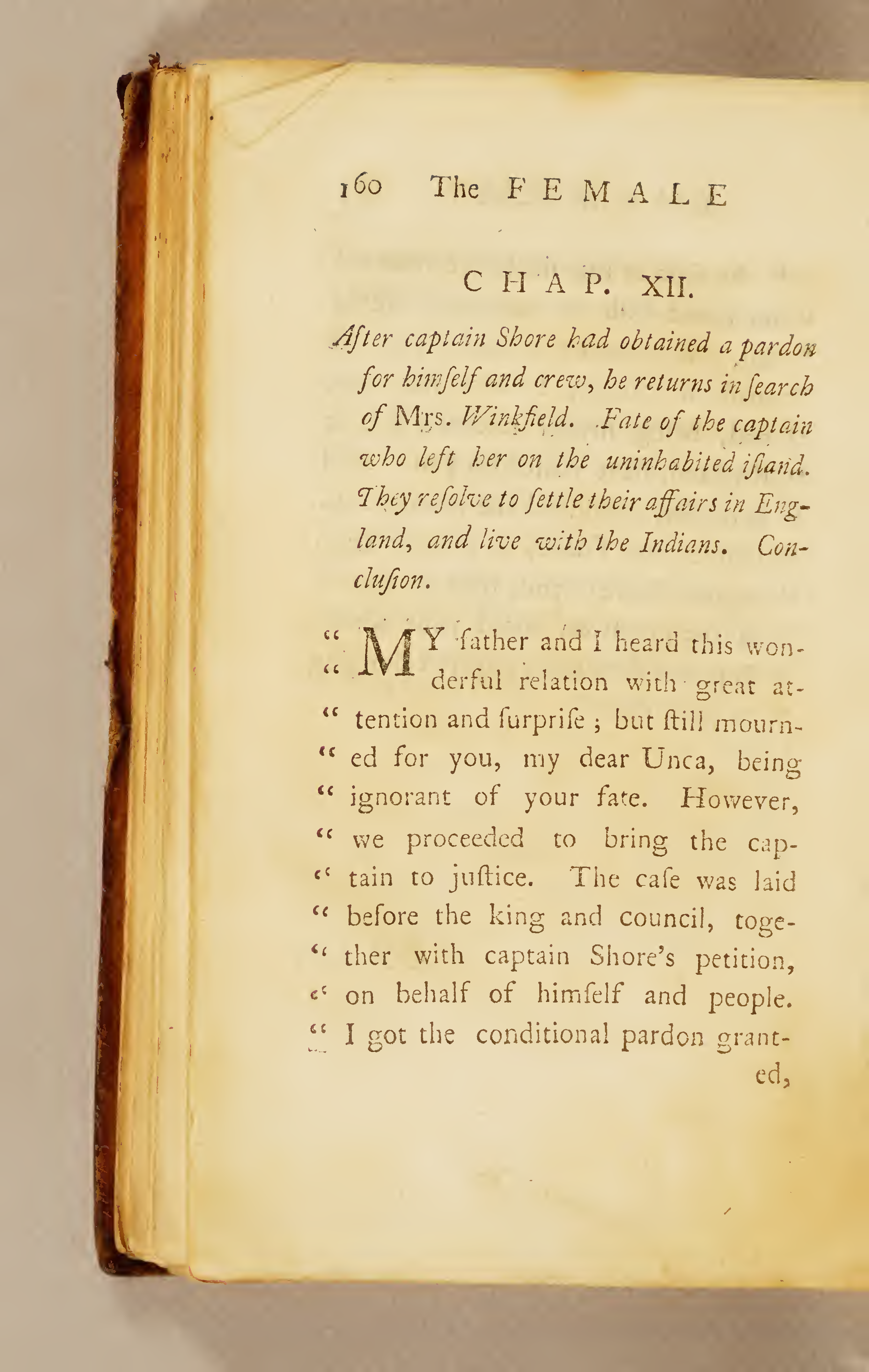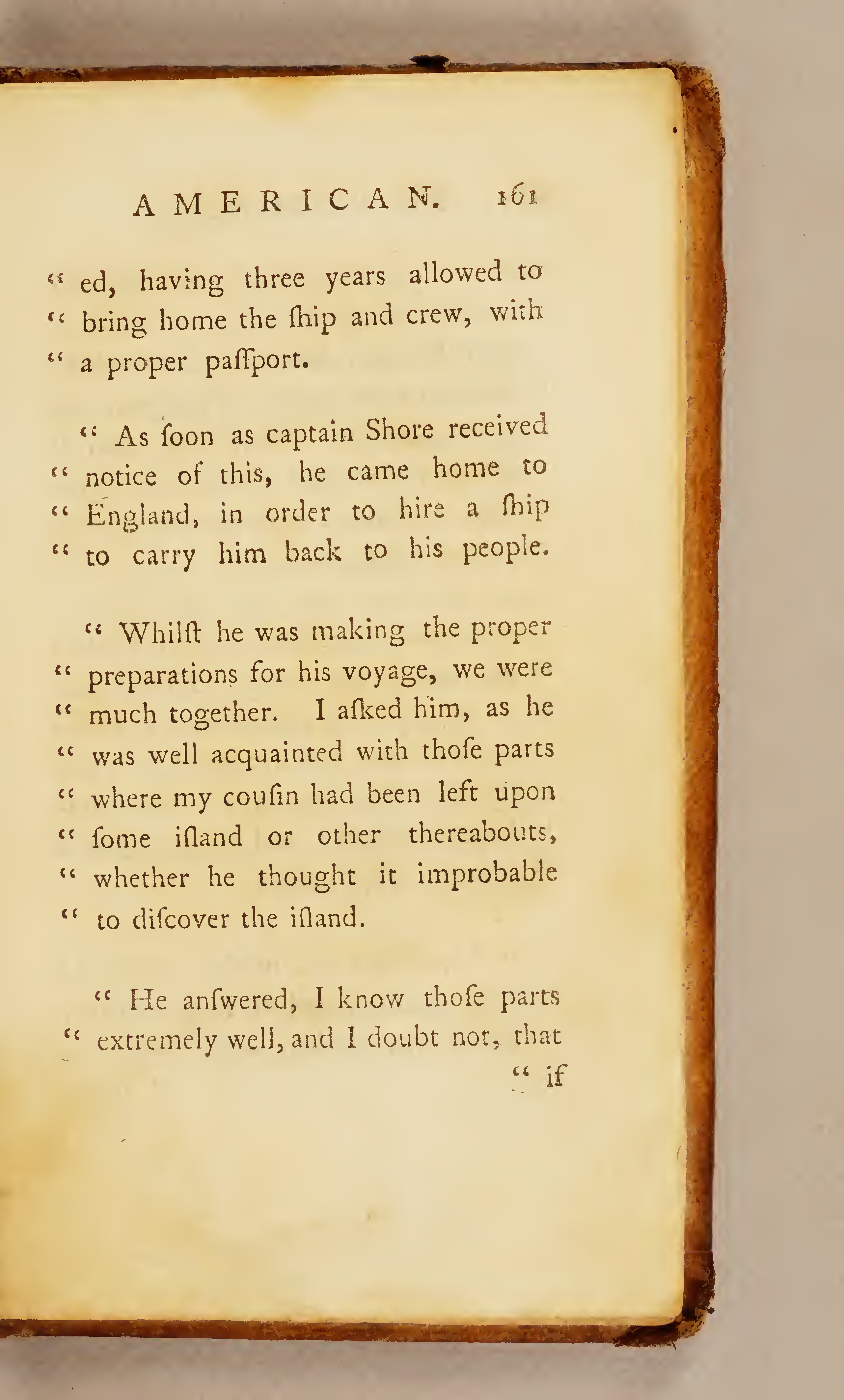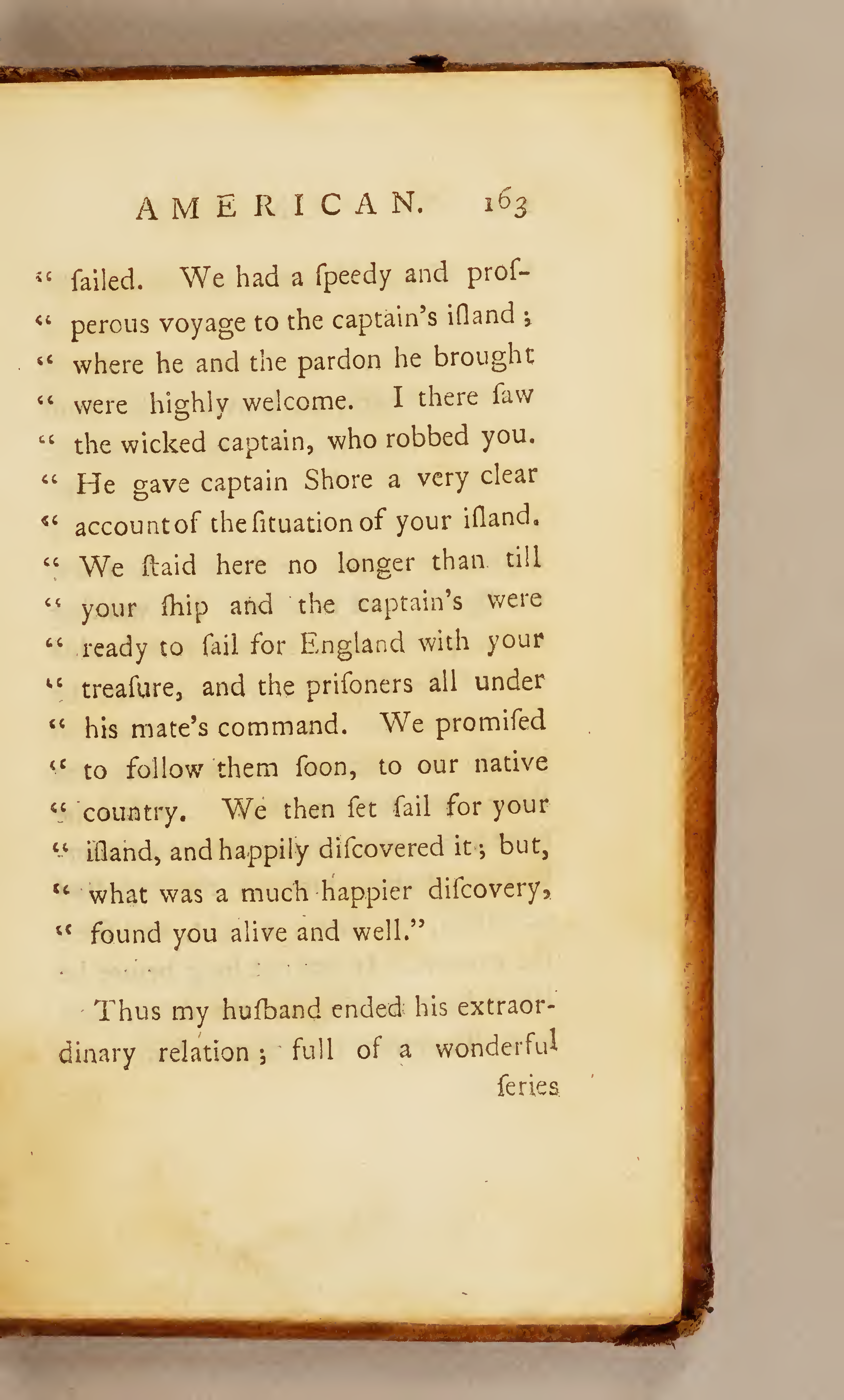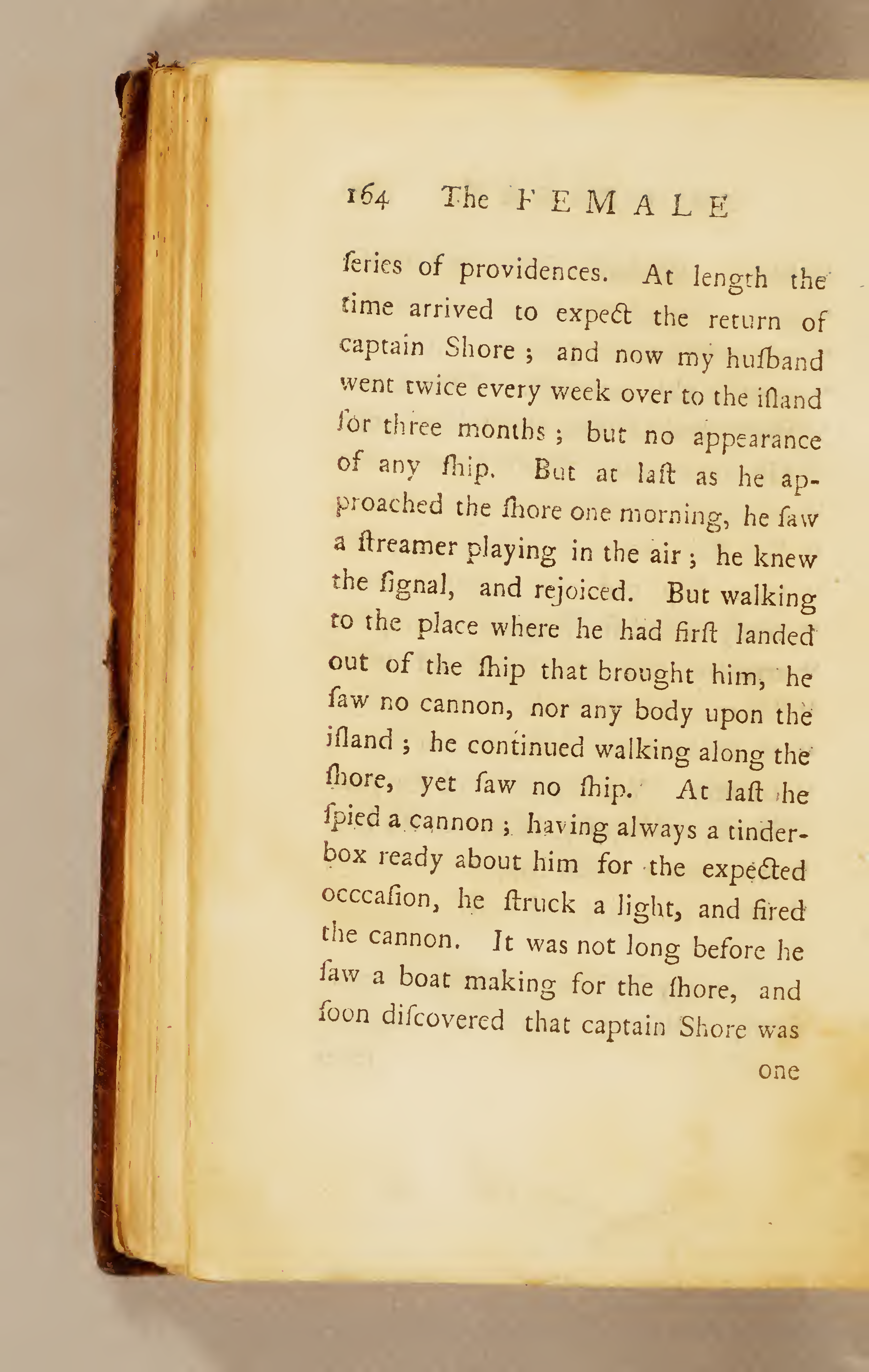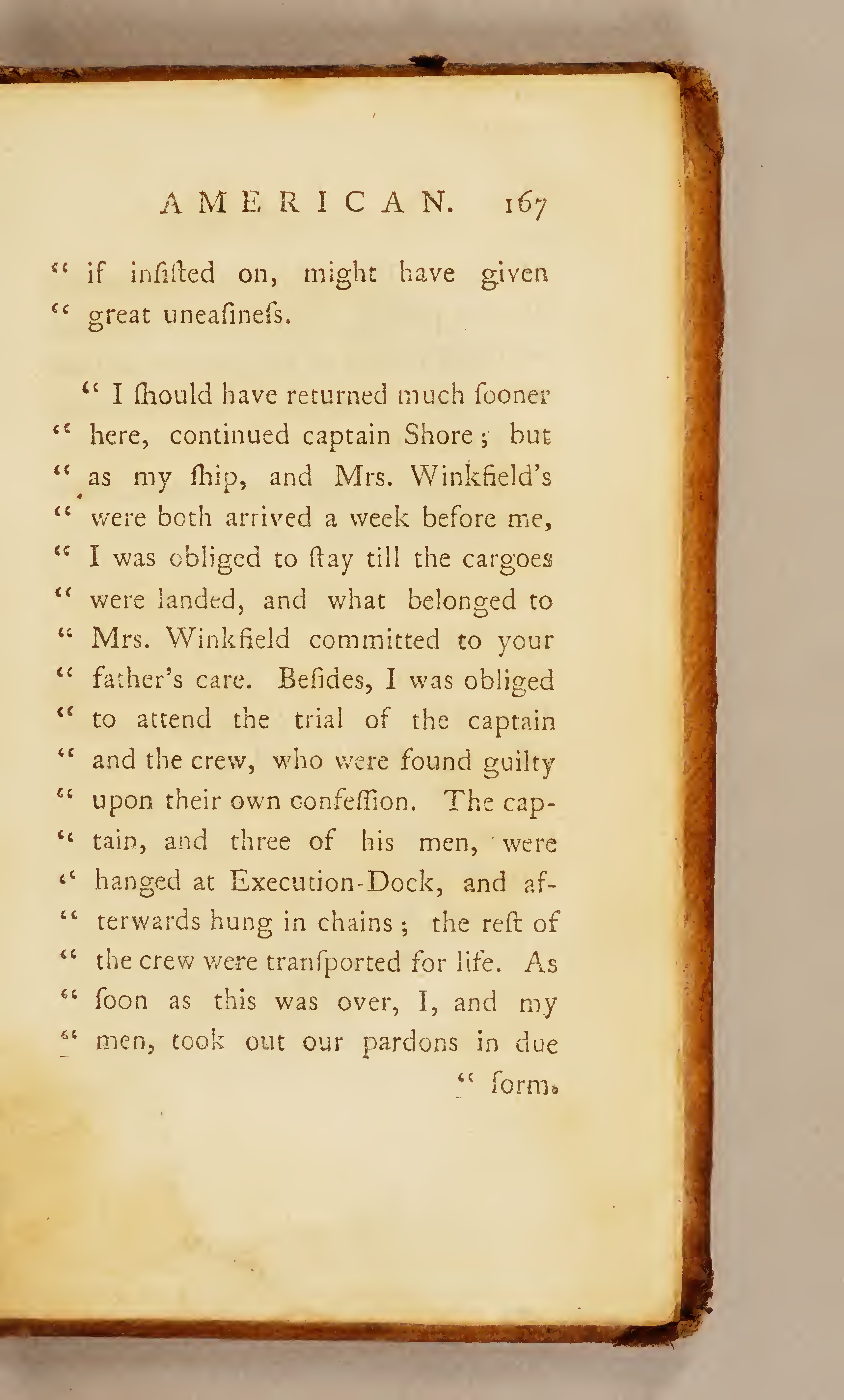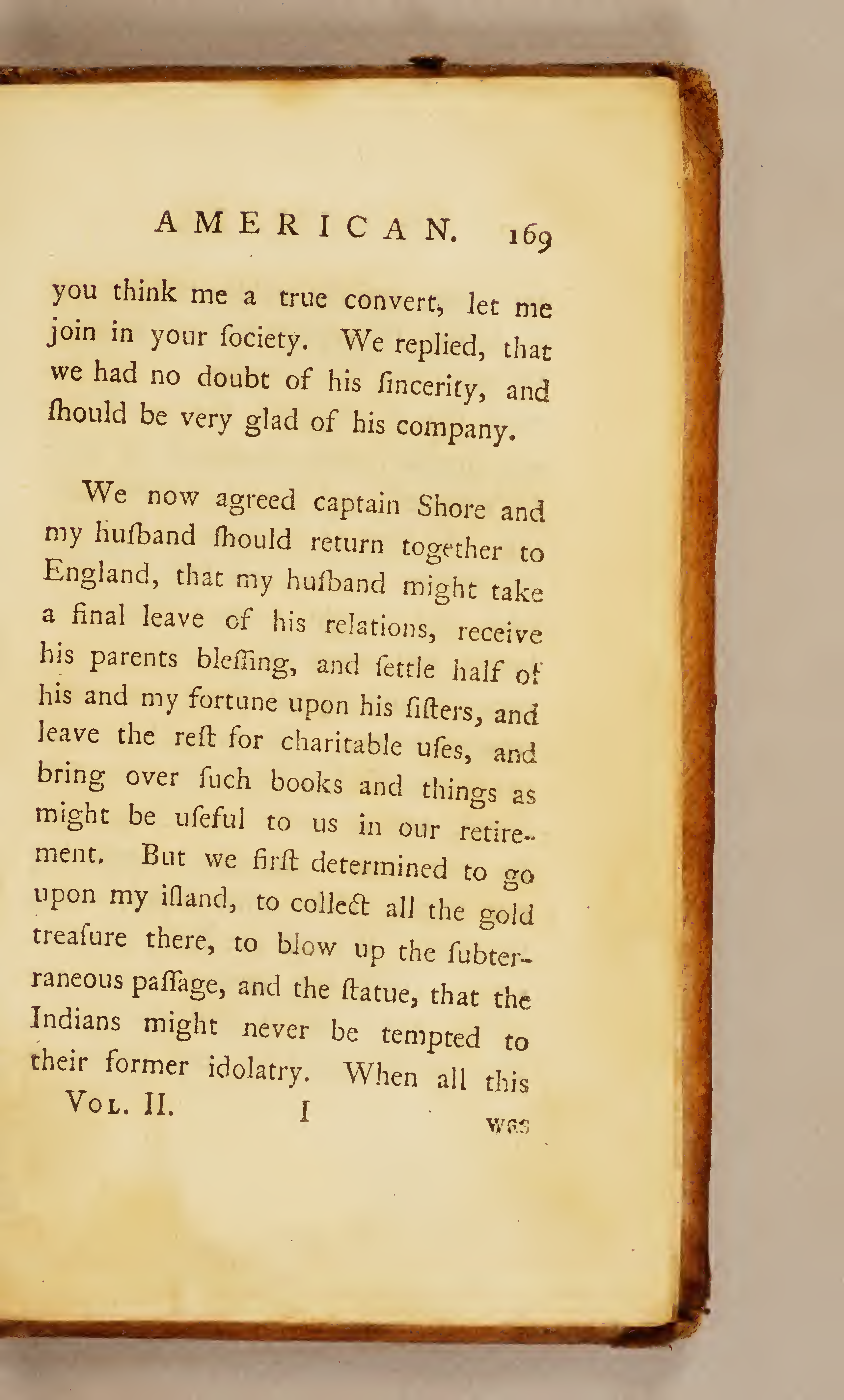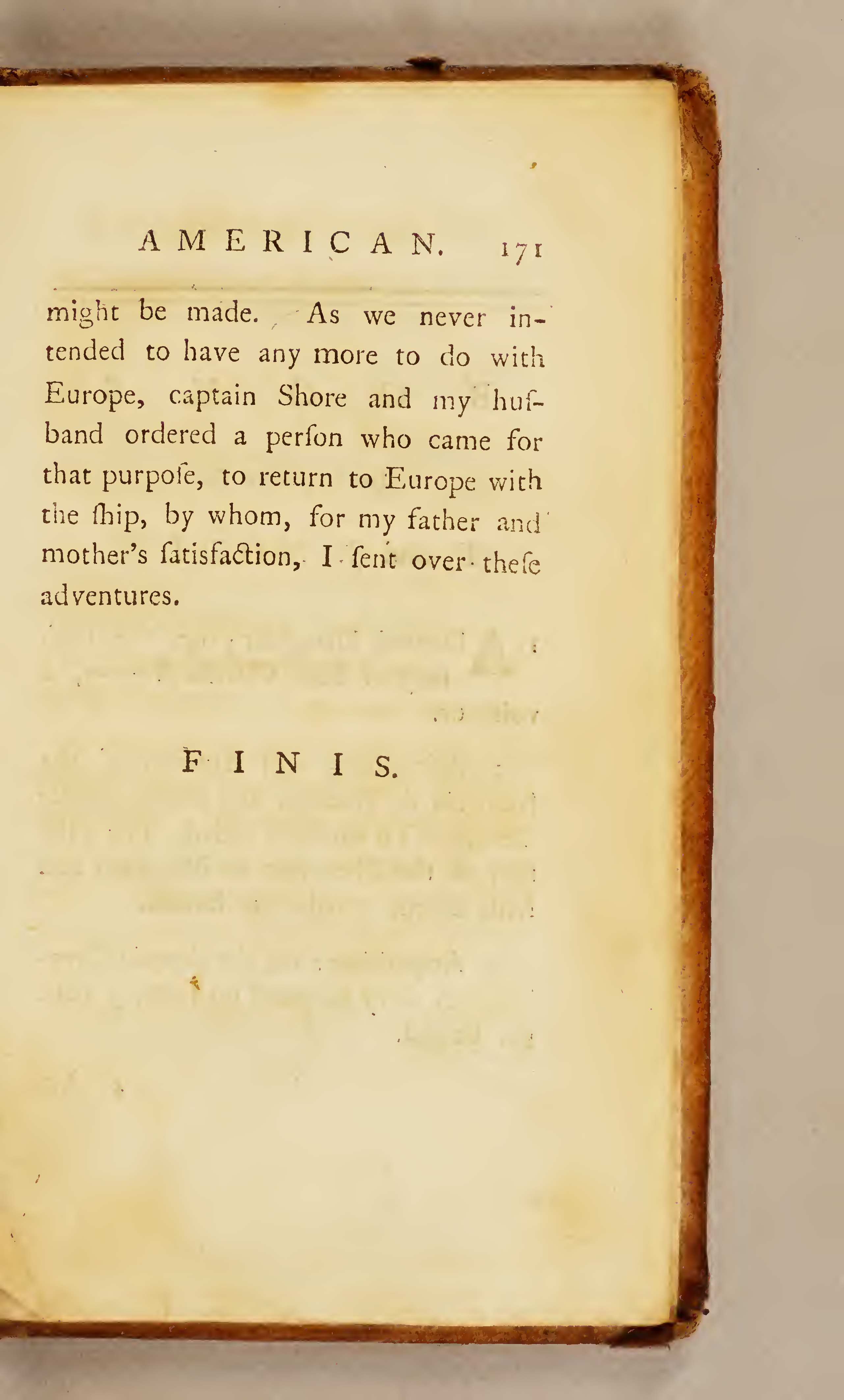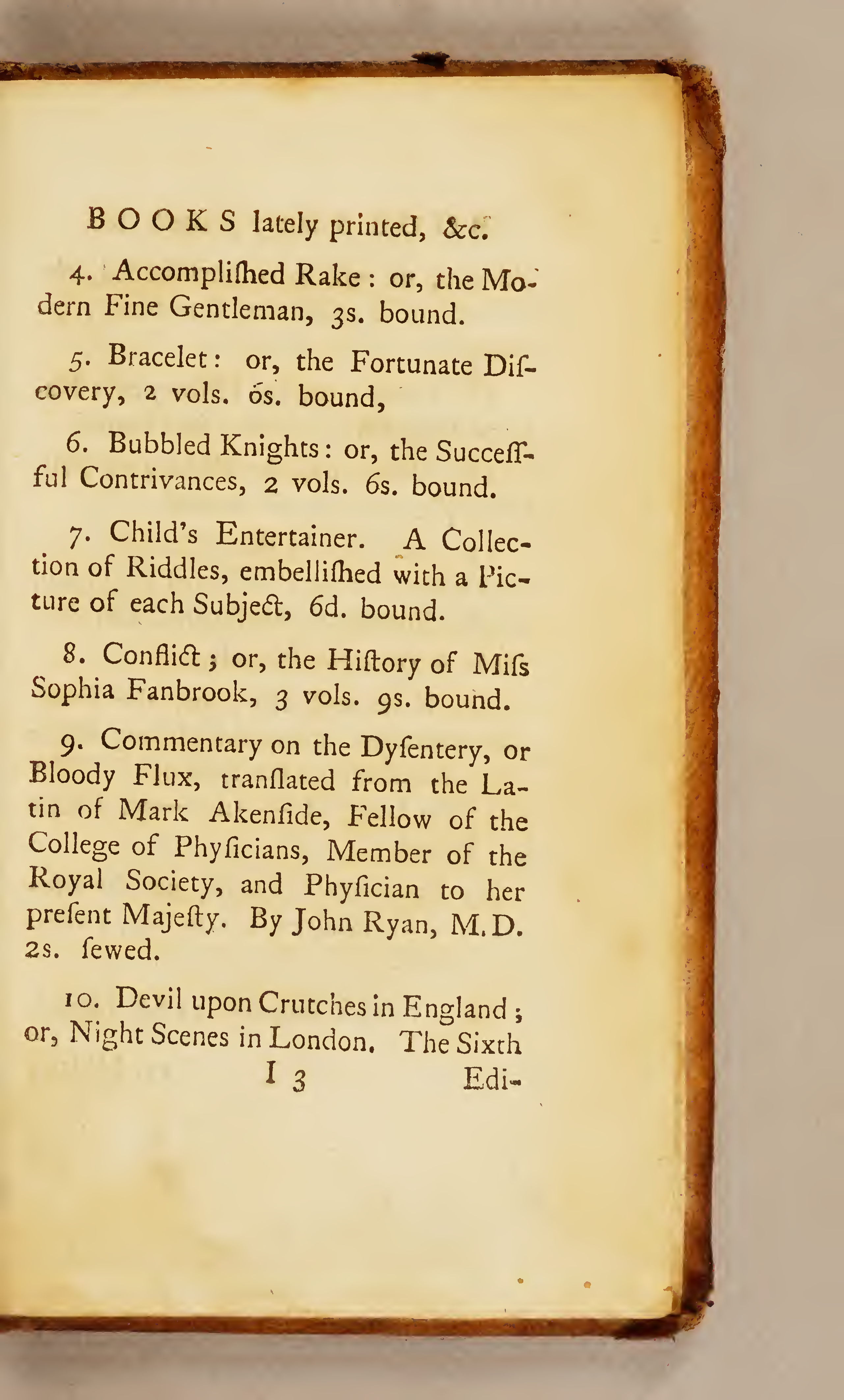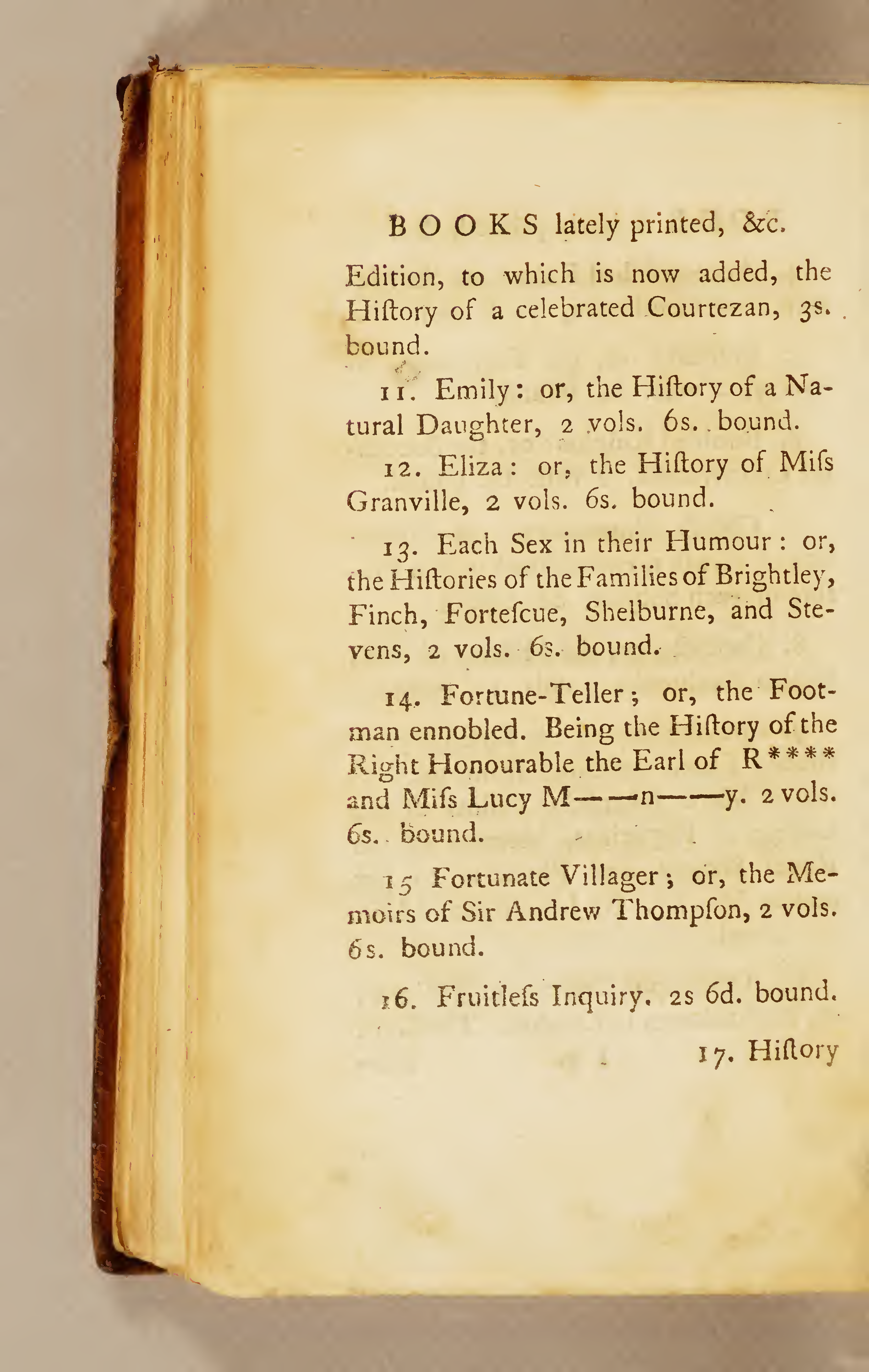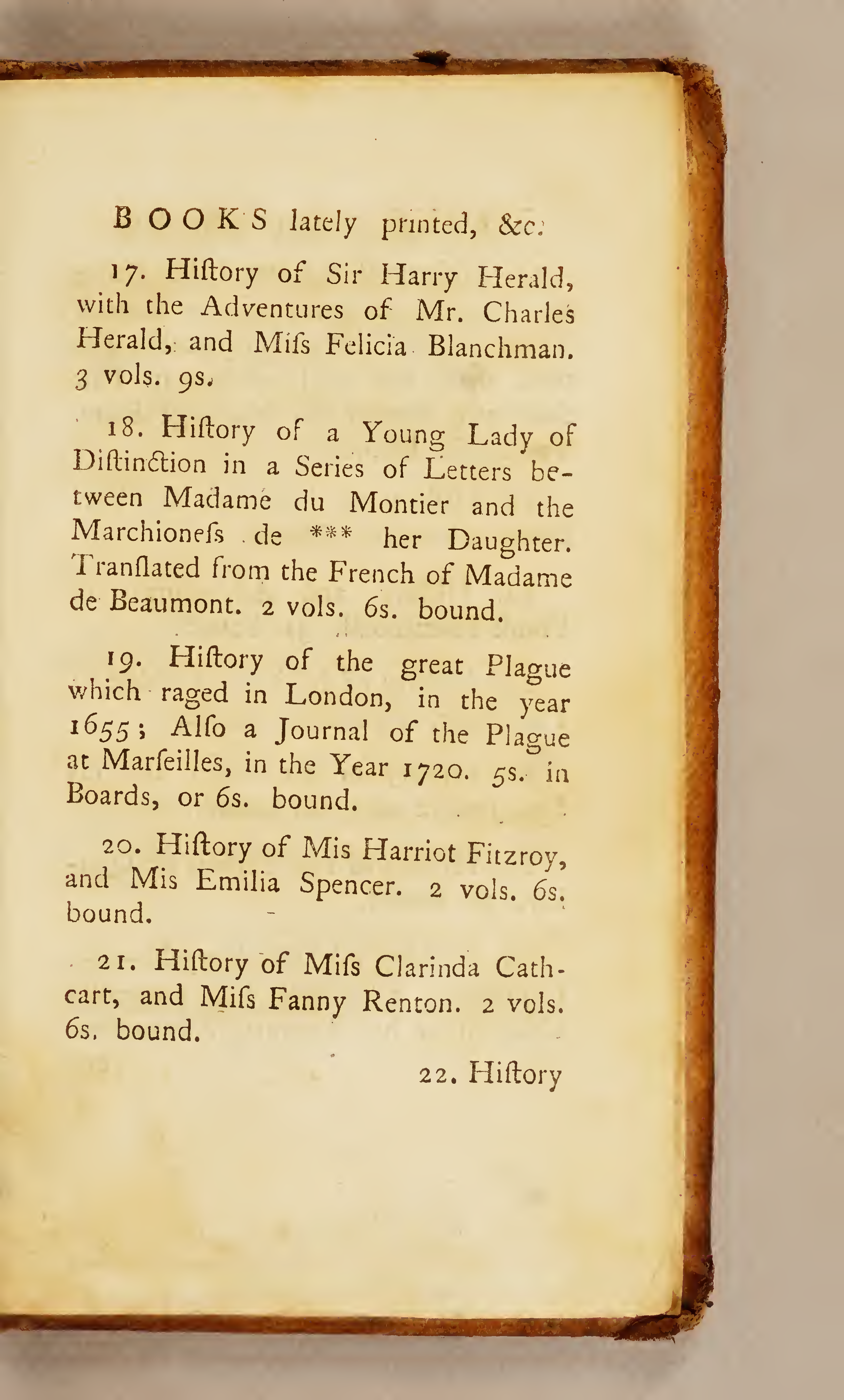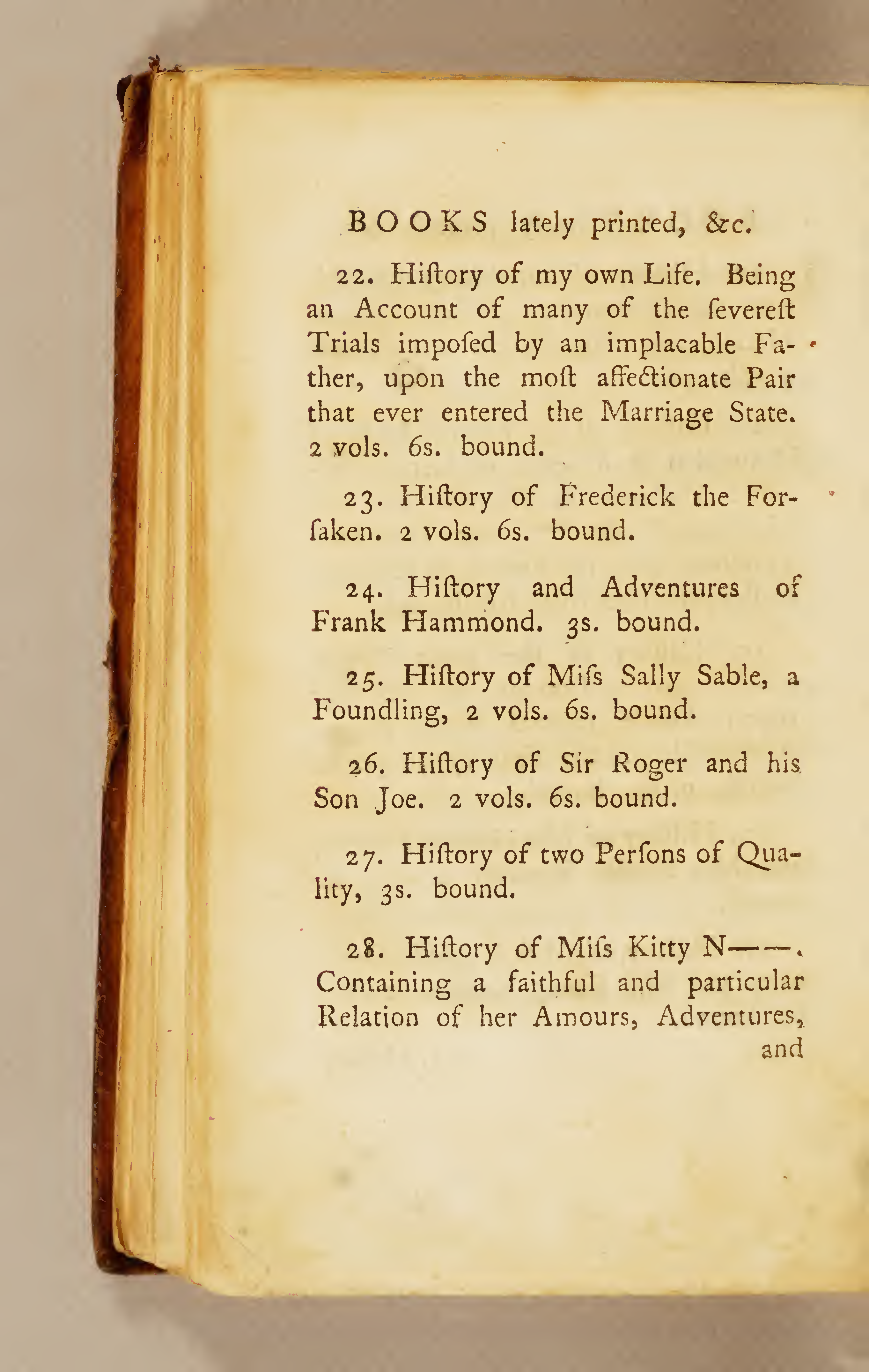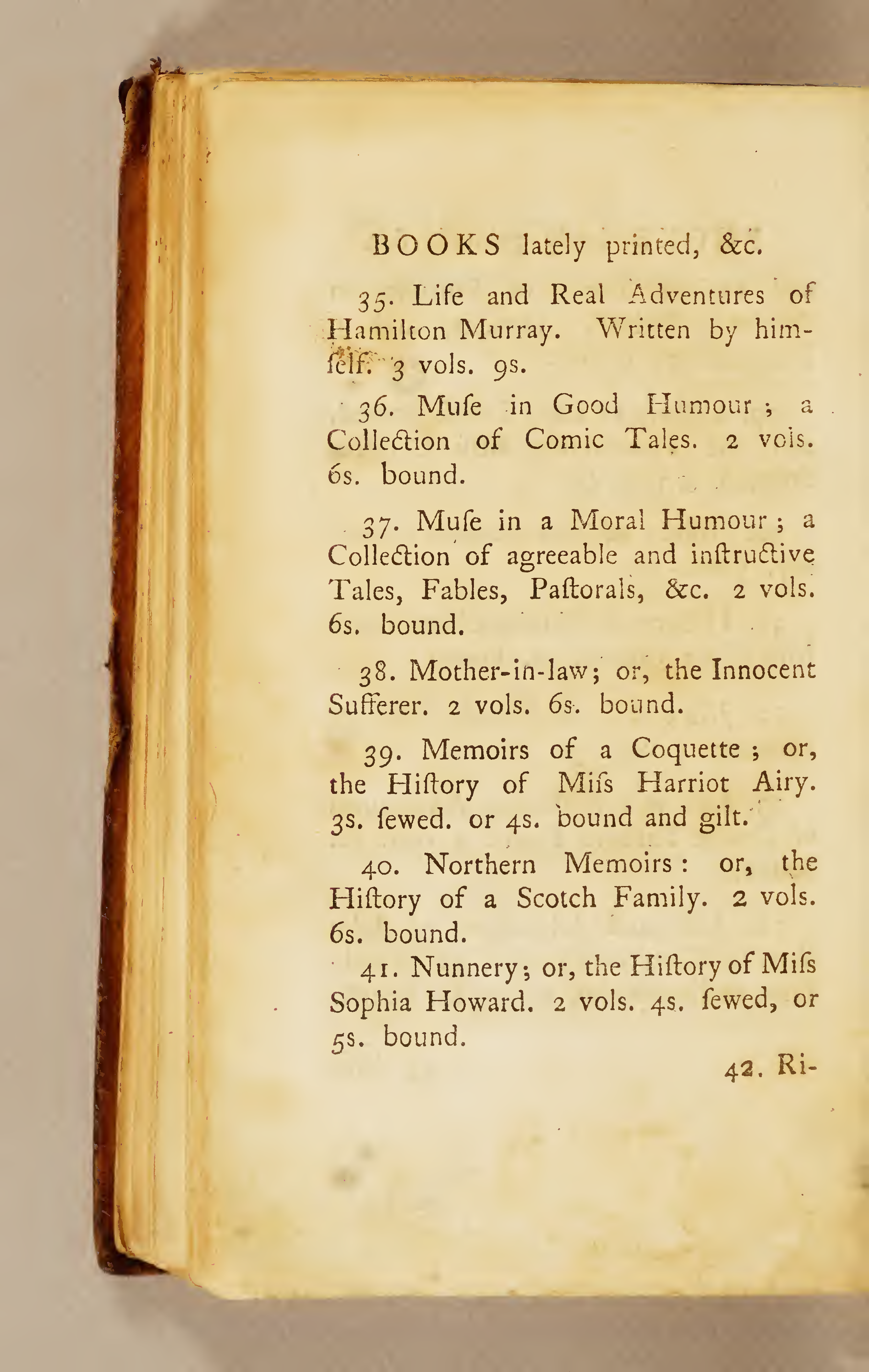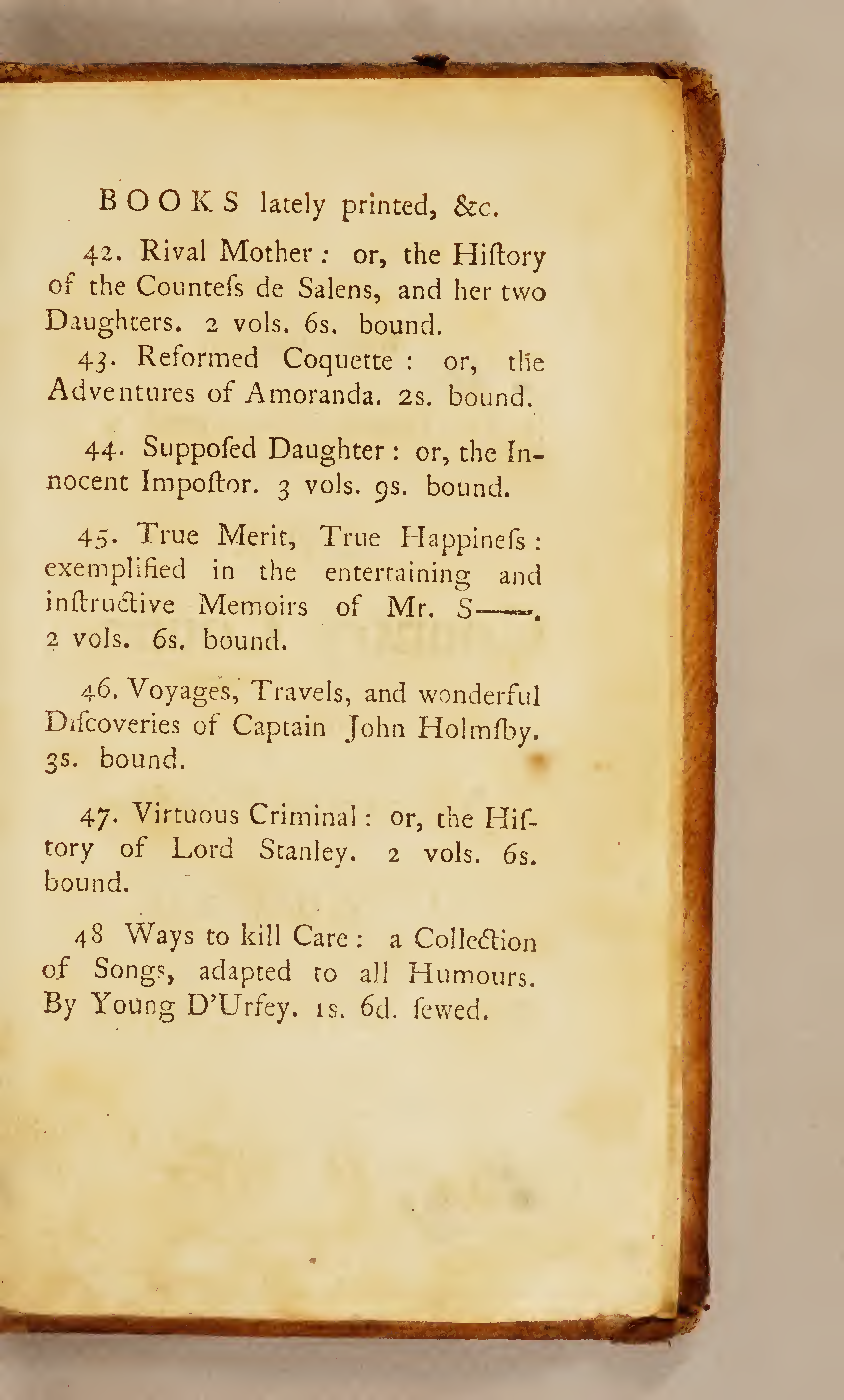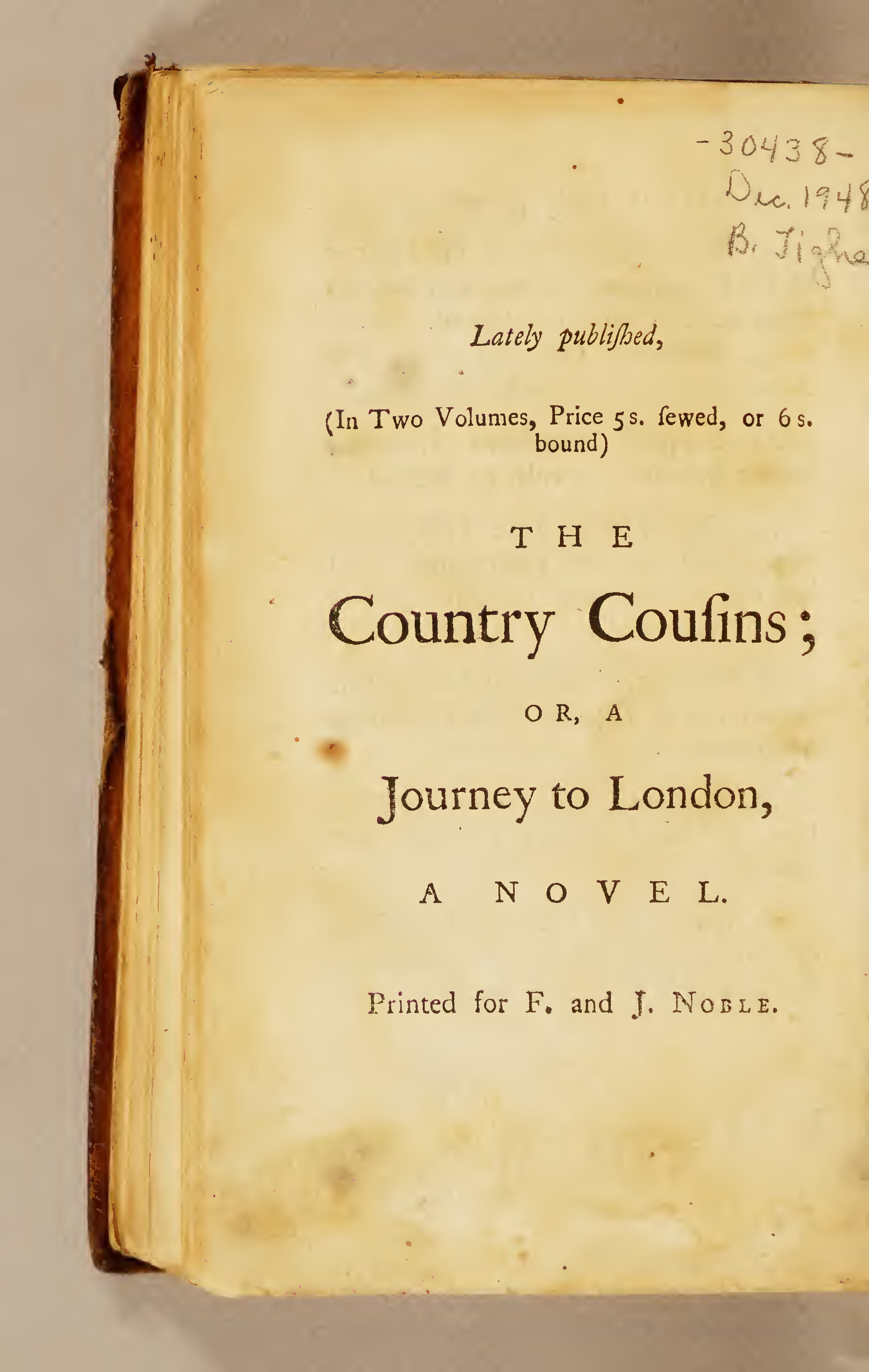The Female American; Or, The Adventures of Unca Eliza Winkfield
(Vol. II)
By
Unca Eliza Winkfield
Textual editing, annotation, and encoding by students and staff at the University of Oregon. Project Leadership by Mattie Burkert. Textual Editing by Chris Lozano, Intisar Alshammari. Technical Editing by Georgia Barrus, Payton Bell, Anthony Borgatta, Tessa Campbell, Sophie Cannon, Ava Chimienti, Isabelle Dana, Olivia Ellerbruch, Jacob Gittelman, Toby Hausler, Rachel Kesich, Kayla Kuo, Sophia Lynn, Mac Maher, Ella Marinace, Jesse Murphy, Claire O'Connor, Broc Rasmussen, Jacob Waufle, Zach Wergeland, Nahla Wilson, Sydney Wolfe. Annotation Research by Elizabeth Bohls, Hanna Beleck, Bridget Collins, Kloee Dillingham, Milan Geurin, Esmeralda Gonzalez, Madeline Peil, Alex Pelayo
library
 Source: Apollo and Athena invite a reader to enjoy John Noble's library of educational and entertaining books. Frontispiece illustration to 'A new catalogue of the large and valuable collection of books: (both English and French) in John Noble's circulating library. Consisting of several thousand volumes...which are lent to read,' circa 1761. Public domain image, Folger Shakespeare Library Digital Collections.
Francis and John Noble were booksellers and publishers who ran a
successful circulating library starting in the 1740s. Rochelle Raineri
Zuck speculates that The Female American may have
been the product of the "stable of writers" the Nobles employed "to
produce new work at a rapid pace" for their libraries-something like the
eighteenth-century equivalent of Internet
content farms. See Zuck, "Who Wrote
The Female American?" in
English Literary History 89.3 (2022): 669.
DOI:10.1353/elh.2022.0023.
- [UOStudStaff]American
Source: Apollo and Athena invite a reader to enjoy John Noble's library of educational and entertaining books. Frontispiece illustration to 'A new catalogue of the large and valuable collection of books: (both English and French) in John Noble's circulating library. Consisting of several thousand volumes...which are lent to read,' circa 1761. Public domain image, Folger Shakespeare Library Digital Collections.
Francis and John Noble were booksellers and publishers who ran a
successful circulating library starting in the 1740s. Rochelle Raineri
Zuck speculates that The Female American may have
been the product of the "stable of writers" the Nobles employed "to
produce new work at a rapid pace" for their libraries-something like the
eighteenth-century equivalent of Internet
content farms. See Zuck, "Who Wrote
The Female American?" in
English Literary History 89.3 (2022): 669.
DOI:10.1353/elh.2022.0023.
- [UOStudStaff]American
 Source: Theodore Galle, 'Allegory of America,' ca. 1600. Public Domain image, Metropolitan Museum of Art.
This engraving by Netherlandish artist Theodoor Galle imitates
Johannes Stradanus' original drawing of Italian explorer Amerigo
Vespucci. In this allegorical image, Vespucci is shown 'awakening'
a woman who personifies America. The caption, 'Americen Americus
retexit, semel vocauit inde semper excitam,' roughly translates to
'Americus rediscovers America, once awakened, always aroused,'
further underscoring the sexualized and racialized ideology of
conquest. Like many depictions from this period, it visualizes
the so-called discovery of the Americas as an act of European male
dominance over feminized, exoticized, and passive land and peoples.
- [OUStudStaff]rivuletsstreams - [UOStudStaff]variegatedvaried - [UOStudStaff]extraordinary
Source: Theodore Galle, 'Allegory of America,' ca. 1600. Public Domain image, Metropolitan Museum of Art.
This engraving by Netherlandish artist Theodoor Galle imitates
Johannes Stradanus' original drawing of Italian explorer Amerigo
Vespucci. In this allegorical image, Vespucci is shown 'awakening'
a woman who personifies America. The caption, 'Americen Americus
retexit, semel vocauit inde semper excitam,' roughly translates to
'Americus rediscovers America, once awakened, always aroused,'
further underscoring the sexualized and racialized ideology of
conquest. Like many depictions from this period, it visualizes
the so-called discovery of the Americas as an act of European male
dominance over feminized, exoticized, and passive land and peoples.
- [OUStudStaff]rivuletsstreams - [UOStudStaff]variegatedvaried - [UOStudStaff]extraordinary
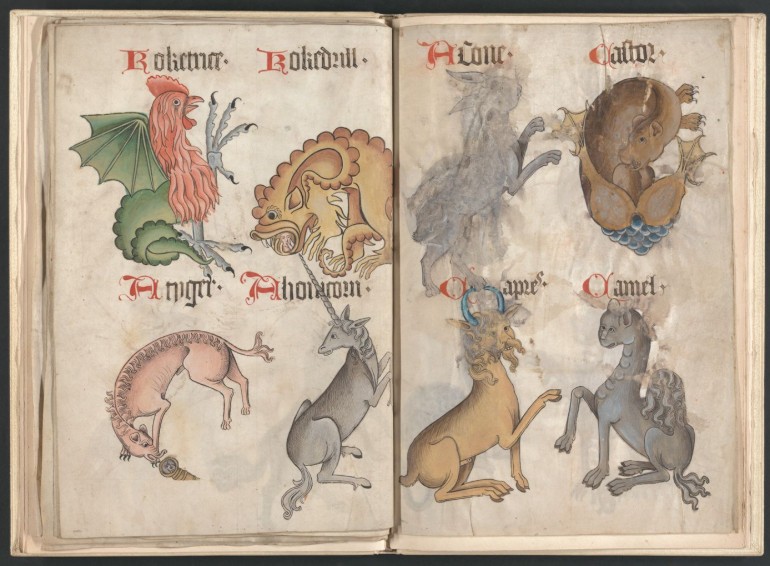 Source: Helmingham Herbal and Bestiary (1500), Yale Center for British Art. Reused under Yale Library's Open Access Policy.
The absurd nature of the fictious animal described in this passage implies
a metaphorical meaning. The animal's only means of survival is deceiving its
prey, pretending to sleep in order to capture it. Anna Brickhouse connects
this description to Unca Eliza's own deception of the island's Indigenous
people, claiming that "Unca Eliza is both transfixed and patently disturbed
by the greed and violence of this strange colonial animal. A nightmarish
embodiment of her own predicament." Brickhouse, "The Indian Slave Trade in
Unca Eliza Winkfield's The Female American."
The Yearbook of English Studies46 (2016): 115-126.
DOI: 10.1353/yes.2016.0008.
- [UOStudStaff]asundersplit apart - [UOStudStaff]providenceGod's divine plan - [UOStudStaff]rowledrolled - [UOStudStaff]herbagestems and leaves - [UOStudStaff]though-a-woman
Source: Helmingham Herbal and Bestiary (1500), Yale Center for British Art. Reused under Yale Library's Open Access Policy.
The absurd nature of the fictious animal described in this passage implies
a metaphorical meaning. The animal's only means of survival is deceiving its
prey, pretending to sleep in order to capture it. Anna Brickhouse connects
this description to Unca Eliza's own deception of the island's Indigenous
people, claiming that "Unca Eliza is both transfixed and patently disturbed
by the greed and violence of this strange colonial animal. A nightmarish
embodiment of her own predicament." Brickhouse, "The Indian Slave Trade in
Unca Eliza Winkfield's The Female American."
The Yearbook of English Studies46 (2016): 115-126.
DOI: 10.1353/yes.2016.0008.
- [UOStudStaff]asundersplit apart - [UOStudStaff]providenceGod's divine plan - [UOStudStaff]rowledrolled - [UOStudStaff]herbagestems and leaves - [UOStudStaff]though-a-woman
 Source: Image from Thomas Heywood's 'The exemplary lives and memorable acts of nine the most worthy women of the world' (1640). Folger Shakespeare Library, CC-0 license.
The phrase "though a woman" serves as a brief but significant
acknowledgment of gendered restrictions on knowledge in eighteenth-century
England. Although Unca Eliza is depicted as a strong and smart
individual who challenges traditional gender roles, she establishes
her credibility by referencing foundational male philosophers,
indicating her awareness of cultural expectations regarding women's
intellectual ability. Scholar Jill Conway asserts that "European
women intellectuals were either declasse, or else they lived a
contemplative life in a religious community." Unca Eliza's isolation
on the island literalizes the social exile faced by intellectual
women at the time. See Conway, "Perspectives on the History of Women's
Education in the United States."
History of Education Quarterly 14.1 (1974): 1–12.
DOI: 10.2307/367602. - [UOStudStaff]aristotle
This moment reflects the complex changing attitudes
towards the capabilities of women during the Enlightenment. Unca Eliza both
establishes her womanhood as something inferior to male intellectuals
and simultaneously places herself above classical scholars. While women
at the time were becoming increasingly established in intellectual fields
they were still seen as inferior to men. In
Women and Enlightenment in Eighteenth Century Britain
(Cambridge University Press, 2009), Karen O'Brien writes that, while the
progress of women in eighteenth-century Britain cannot be likened to feminism
as we know it, the Enlightenment "created a framework and a language for
understanding the gendered structures of society without which nineteenth-century
feminism would not have been possible" (2).
- [UOStudStaff]ignoble
not honourable in character or purpose - [UOStudStaff]conjectureformation of an opinion on grounds insufficient
to furnish proof; action of guessing or surmising - [UOStudStaff]exaltedRaised to a high level of dignity or honor.
- [UOStudStaff]desolate
Source: Image from Thomas Heywood's 'The exemplary lives and memorable acts of nine the most worthy women of the world' (1640). Folger Shakespeare Library, CC-0 license.
The phrase "though a woman" serves as a brief but significant
acknowledgment of gendered restrictions on knowledge in eighteenth-century
England. Although Unca Eliza is depicted as a strong and smart
individual who challenges traditional gender roles, she establishes
her credibility by referencing foundational male philosophers,
indicating her awareness of cultural expectations regarding women's
intellectual ability. Scholar Jill Conway asserts that "European
women intellectuals were either declasse, or else they lived a
contemplative life in a religious community." Unca Eliza's isolation
on the island literalizes the social exile faced by intellectual
women at the time. See Conway, "Perspectives on the History of Women's
Education in the United States."
History of Education Quarterly 14.1 (1974): 1–12.
DOI: 10.2307/367602. - [UOStudStaff]aristotle
This moment reflects the complex changing attitudes
towards the capabilities of women during the Enlightenment. Unca Eliza both
establishes her womanhood as something inferior to male intellectuals
and simultaneously places herself above classical scholars. While women
at the time were becoming increasingly established in intellectual fields
they were still seen as inferior to men. In
Women and Enlightenment in Eighteenth Century Britain
(Cambridge University Press, 2009), Karen O'Brien writes that, while the
progress of women in eighteenth-century Britain cannot be likened to feminism
as we know it, the Enlightenment "created a framework and a language for
understanding the gendered structures of society without which nineteenth-century
feminism would not have been possible" (2).
- [UOStudStaff]ignoble
not honourable in character or purpose - [UOStudStaff]conjectureformation of an opinion on grounds insufficient
to furnish proof; action of guessing or surmising - [UOStudStaff]exaltedRaised to a high level of dignity or honor.
- [UOStudStaff]desolate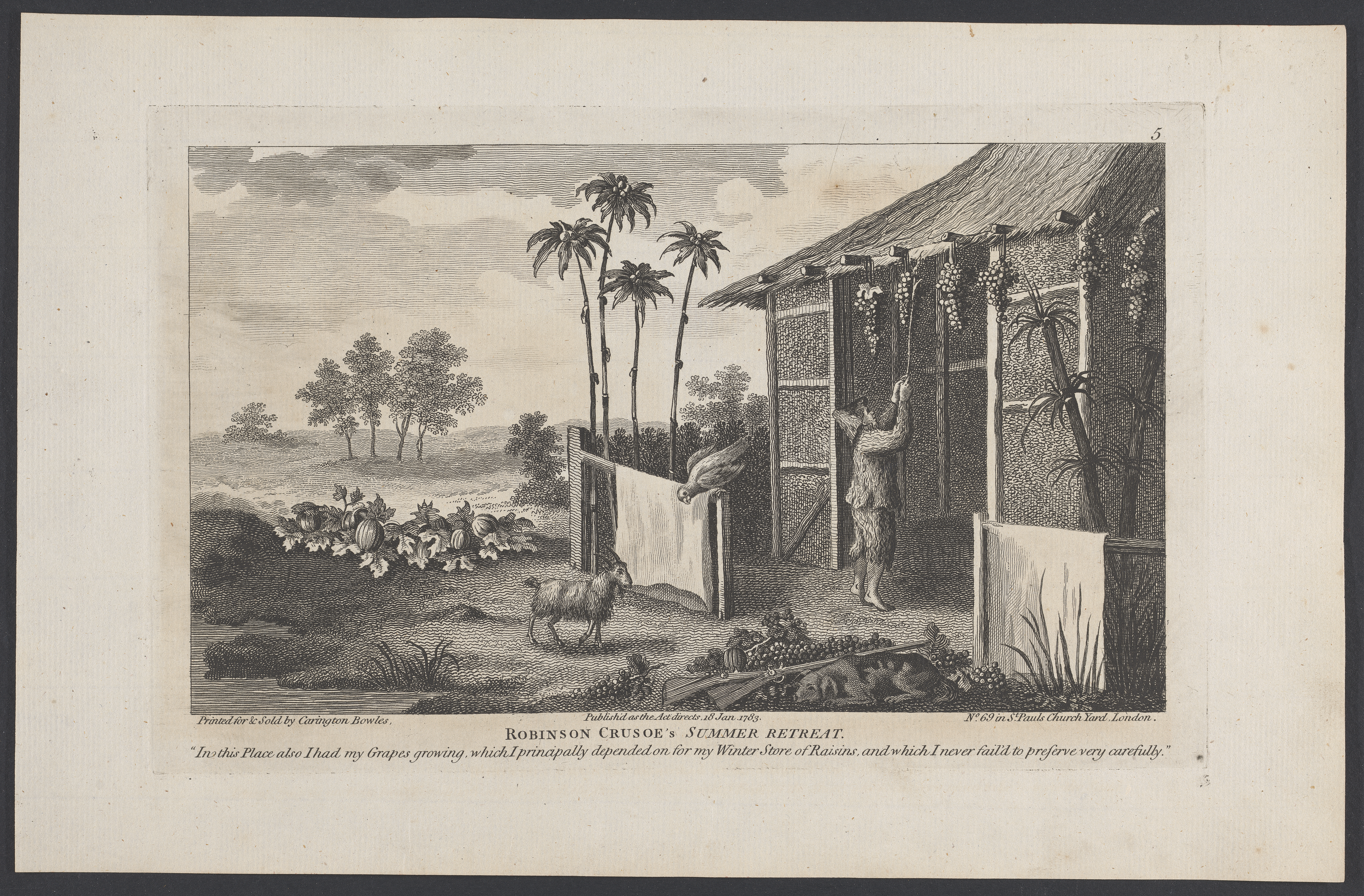 Source: A print from Carington Bowles' (1724-1793), 'Twelve Illustrations of Robinson Crusoe,' shows Crusoe tending to grapes at his 'Summer Retreat,' accompanied by a quote from the novel: 'In this place also I had my grapes growing, which I principally depended on for my Winter Store of Raisins, and which I never fear to preserve very carefully.' Public domain image, Yale Center for British Art.
This allusion to Robinson Crusoe(1719) establishes
Daniel Defoe's castaway novel as inspiration for
The Female American. Like Crusoe, Unca Eliza finds her time on the island
to be especially prosperous, with the necessary provisions appearing as desired.
These occurrences ultimately fuel the protagonists' unending faith and pursuit
of divine providence. Though these tales are similar in content and fabrication,
The Female Americanironically attempts to discredit its
precursor due to its fictitious storyline. To learn more about the parallels
between these two works, see Tremaine McDowell, "An American Robinson Crusoe"
American Literature 1.3 (1929): 307-09. - [UOStudStaff]obeisancesGestures of respect, such as bowing. - [UOStudStaff]high-priest
Unca portrays herself as a woman with strong Anglican beliefs,
yet momentarily forfeits her belief system on the island when she finds the idol.
She begins manipulating the people around her through the influence of the idol,
and internalizes the mindset of its power. She utilizes lies, treasures, costumes
and deceit to reinforce her position as a god-like figure. Scarlet Brown
explores this idea of manipulation, describing Unca's behavior as "an expert stage
director," mannered with "theatrical efforts to persuade the Indians," and further
describes the lengths Unca would go to fulfill her own facade. Bowen,
"Via Media: Transatlantic
Anglicanism in The Female American."
The Eighteenth Century, 53.2 (2012): 189 - 207. - [UOStudStaff]peremptoryInsisting on immediate attention or
obedience, leaving no room for refusal. - [UOStudStaff]natural-religion
Source: A print from Carington Bowles' (1724-1793), 'Twelve Illustrations of Robinson Crusoe,' shows Crusoe tending to grapes at his 'Summer Retreat,' accompanied by a quote from the novel: 'In this place also I had my grapes growing, which I principally depended on for my Winter Store of Raisins, and which I never fear to preserve very carefully.' Public domain image, Yale Center for British Art.
This allusion to Robinson Crusoe(1719) establishes
Daniel Defoe's castaway novel as inspiration for
The Female American. Like Crusoe, Unca Eliza finds her time on the island
to be especially prosperous, with the necessary provisions appearing as desired.
These occurrences ultimately fuel the protagonists' unending faith and pursuit
of divine providence. Though these tales are similar in content and fabrication,
The Female Americanironically attempts to discredit its
precursor due to its fictitious storyline. To learn more about the parallels
between these two works, see Tremaine McDowell, "An American Robinson Crusoe"
American Literature 1.3 (1929): 307-09. - [UOStudStaff]obeisancesGestures of respect, such as bowing. - [UOStudStaff]high-priest
Unca portrays herself as a woman with strong Anglican beliefs,
yet momentarily forfeits her belief system on the island when she finds the idol.
She begins manipulating the people around her through the influence of the idol,
and internalizes the mindset of its power. She utilizes lies, treasures, costumes
and deceit to reinforce her position as a god-like figure. Scarlet Brown
explores this idea of manipulation, describing Unca's behavior as "an expert stage
director," mannered with "theatrical efforts to persuade the Indians," and further
describes the lengths Unca would go to fulfill her own facade. Bowen,
"Via Media: Transatlantic
Anglicanism in The Female American."
The Eighteenth Century, 53.2 (2012): 189 - 207. - [UOStudStaff]peremptoryInsisting on immediate attention or
obedience, leaving no room for refusal. - [UOStudStaff]natural-religion
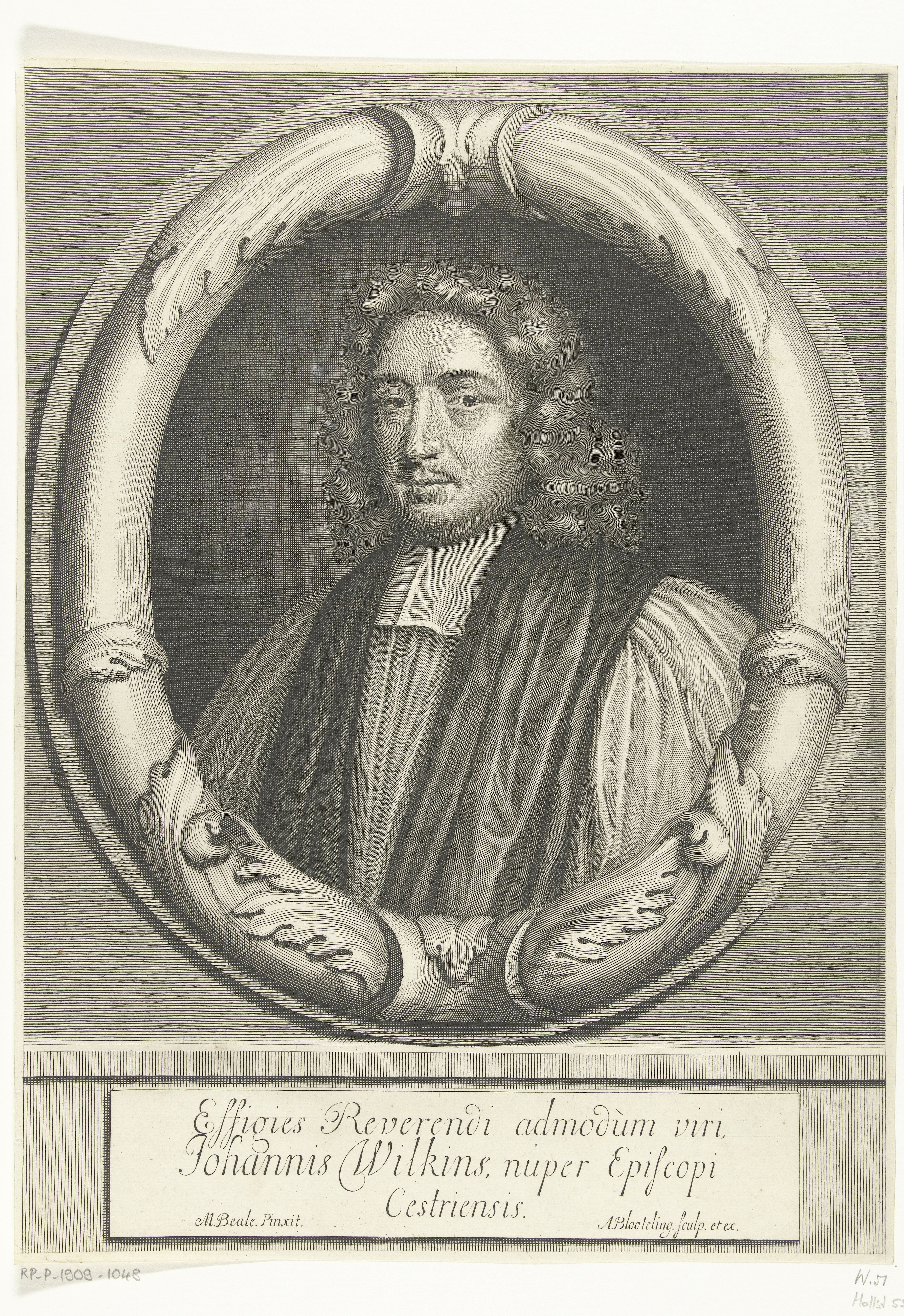 Source: 'Portret van John Wilkins, bisschop van Chester Effigies Reverendi admodum viri, Johannis Wilkins, nuper Episcopi Cestriensis (titel op object), RP-P-1941-141' by Abraham Bloteling was sourced from the Rijks Museum under CCO 1.0.
This verbiage is likely a reference to John Wilkins'
Of The Principles And Duties Of Natural Religion, (1734).
Wilkins (1614-1672) was an Anglican clergyman who proposed that the matter and
form of living things is evidence of God's divine authority. In the context of
The Female American, Unca Winkfield creates the idea of
a Christian deity while simultaneously acknowledging her role in a theological
myth of nature versus God's creation. The bottom of the portrait reads "Effigies
Reverendi admodum viri, Johannis Wilkins, nuper Episcopi Cestriensis," which
translates to "Portrait of the very Reverend John Wilkins, late Bishop of Chester"
in English. Read more inOf the Principles and Duties of Natural
Religion:
Internet Archive.
- [UOStudStaff]arduoushard to accomplish or achieve - [UOStudStaff]abasheduneasy, confused, embarrassed - [UOStudStaff]desiststop, delay, cease - [UOStudStaff]obstinancystubbornness, inflexibility - [UOStudStaff]deludeddeceived, beguiled, led away from truth - [UOStudStaff]Deitydivine being, god - [UOStudStaff]irresoluteunresolved, undecided - [UOStudStaff]attendedwould bring certain misfortune - [UOStudStaff]wretchperson driven from their native country,
exile. - [UOStudStaff]recourseturned to - [UOStudStaff]obedienceThere is tension in Unca Eliza'sbelief system as she plans to manipulate
the Indigenous people utilizing their own deity - simultaneously condemning
the Indigenous religious as idolatrous while participating within their
belief system. In
"Via Media": Transatlantic Anglicanism in "The Female American,"
Scarlet Bowen
explores this manipulation, describing Unca as "an expert stage director,"
using "theatrical" effort (197).
Bowen, Scarlet."‘Via Media': Transatlantic Anglicanism in ‘The
Female American.'"The Eighteenth Century, 53.2, 2012,
pp. 189–207. JSTOR, http://www.jstor.org/stable/41468177. Accessed 26 Feb.
2025. - [UOStudStaff]oracleinstrument or medium through which
the gods were supposed to speak or prophesy. - [UOStudStaff]therein
in that place - [UOStudStaff]bestowgive as a gift, or present - [UOStudStaff]willintention, command, order - [UOStudStaff]grievoussevere - [UOStudStaff]whencefrom a place - [UOStudStaff]hinderdeter, prevent, impede - [UOStudStaff]hitherhere - [UOStudStaff]dumbintentionally silent - [UOStudStaff]drestdressed - [UOStudStaff]conductescort, guide - [UOStudStaff]expedientplan to attain a certain end - [UOStudStaff]procure-obtainobtain, acquire - [UOStudStaff]ensuingapproaching - [UOStudStaff]drestdressed - [UOStudStaff]vestmentsgarments worn by a priest or ecclesiastic
on the occasion of some service or ceremony; priestly robes - [UOStudStaff]cassocka cloak or long coat worn by some soldiers
or horse riders in 16/17th centuries - [UOStudStaff]repositorya place in which something (physical)
accumulates - [UOStudStaff]procurecause or bring about - [UOStudStaff]undertakinga pledge or promise - [UOStudStaff]countenancethe look or expression of a person's face
- [UOStudStaff]prostratedthrew oneself on the ground to
show devotion - [UOStudStaff]affabilityfriendliness, readiness to talk - [UOStudStaff]hitherhere - [UOStudStaff]reverenceRespect - [UOStudStaff]provisionsFood and drink - [UOStudStaff]repastrefreshment - [UOStudStaff]expoundsinterprets, comments on, or
communicates to others - [UOStudStaff]multitudelarge group of people - [UOStudStaff]providencedirection, guidance, or provision from God - [UOStudStaff]prostratedthrew oneself on the ground to show devotion - [UOStudStaff]addressspeech given in front of people - [UOStudStaff]serve
Unca Eliza's narration emphasizes the privilege her colonial hybridity allows
her on the island. Julia Kark Callander suggests that Unca Eliza becomes a
"native royal... at once representative of a community and set apart from it
(i.e., better than its other members)." Unca Eliza's cultural, ethnic, and national
hybridity mesh into a colonial hybridity that is both novel and contradictive--a
paradox that Callander notes is "quite American." "'Attended by a Whole
Nation': The Americas in The Female American."
1650-1850: Ideas, Aesthetics, and Inquiries in the Early Modern
Era18 (2011): 129-149. Print. - [UOStudStaff]dischargecarry out a task - [UOStudStaff]apostle
person who introduces Christianity in a region - [UOStudStaff]taken-upon-me
In calling herself an apostle, or a disciple of Christ,
Unca Eliza demonstrates a key difference between
The Female American(1767) and Daniel Defoe's
Robinson Crusoe(1719). While Robinson Crusoe
finds his religion after he is stranded on the island, Unca Eliza has
always been well versed in Christianity and has "unwavering confidence
in religious knowledge." Jonahs Kneitly,
"The Female Americanand Its Liminal Spaces."
Studies in Religion and the Enlightenment3.1 2023)
28-40, DOI:10.32655/srej.2023.3.1.3 2023
- [UOStudStaff]apprehensionthe act of learning - [UOStudStaff]catechisma book containing the basics of
Christianity, meant to be taught in question-and-answer format - [UOStudStaff]translation
Unca Eliza has a seemingly flawless ability to understand any Indigenous
language that she encounters. This representation neglects the expansive
linguistic diversity of Indigenous communities and, according to Katherine
Whitcomb, "reduces the cultures of different people to such a simplistic
view that the reader cannot differentiate one culture from the next."
"Unca Eliza as Hybrid Colonizer,"
in The Student Theorist: An Open Handbook of
Collective College Theory, Public Commons Publishing, 2018: 80.
- [UOStudStaff]conceivedformed an opinion - [UOStudStaff]Triflingunimportant, minimal - [UOStudStaff]prayer-book
Source: 'Portret van John Wilkins, bisschop van Chester Effigies Reverendi admodum viri, Johannis Wilkins, nuper Episcopi Cestriensis (titel op object), RP-P-1941-141' by Abraham Bloteling was sourced from the Rijks Museum under CCO 1.0.
This verbiage is likely a reference to John Wilkins'
Of The Principles And Duties Of Natural Religion, (1734).
Wilkins (1614-1672) was an Anglican clergyman who proposed that the matter and
form of living things is evidence of God's divine authority. In the context of
The Female American, Unca Winkfield creates the idea of
a Christian deity while simultaneously acknowledging her role in a theological
myth of nature versus God's creation. The bottom of the portrait reads "Effigies
Reverendi admodum viri, Johannis Wilkins, nuper Episcopi Cestriensis," which
translates to "Portrait of the very Reverend John Wilkins, late Bishop of Chester"
in English. Read more inOf the Principles and Duties of Natural
Religion:
Internet Archive.
- [UOStudStaff]arduoushard to accomplish or achieve - [UOStudStaff]abasheduneasy, confused, embarrassed - [UOStudStaff]desiststop, delay, cease - [UOStudStaff]obstinancystubbornness, inflexibility - [UOStudStaff]deludeddeceived, beguiled, led away from truth - [UOStudStaff]Deitydivine being, god - [UOStudStaff]irresoluteunresolved, undecided - [UOStudStaff]attendedwould bring certain misfortune - [UOStudStaff]wretchperson driven from their native country,
exile. - [UOStudStaff]recourseturned to - [UOStudStaff]obedienceThere is tension in Unca Eliza'sbelief system as she plans to manipulate
the Indigenous people utilizing their own deity - simultaneously condemning
the Indigenous religious as idolatrous while participating within their
belief system. In
"Via Media": Transatlantic Anglicanism in "The Female American,"
Scarlet Bowen
explores this manipulation, describing Unca as "an expert stage director,"
using "theatrical" effort (197).
Bowen, Scarlet."‘Via Media': Transatlantic Anglicanism in ‘The
Female American.'"The Eighteenth Century, 53.2, 2012,
pp. 189–207. JSTOR, http://www.jstor.org/stable/41468177. Accessed 26 Feb.
2025. - [UOStudStaff]oracleinstrument or medium through which
the gods were supposed to speak or prophesy. - [UOStudStaff]therein
in that place - [UOStudStaff]bestowgive as a gift, or present - [UOStudStaff]willintention, command, order - [UOStudStaff]grievoussevere - [UOStudStaff]whencefrom a place - [UOStudStaff]hinderdeter, prevent, impede - [UOStudStaff]hitherhere - [UOStudStaff]dumbintentionally silent - [UOStudStaff]drestdressed - [UOStudStaff]conductescort, guide - [UOStudStaff]expedientplan to attain a certain end - [UOStudStaff]procure-obtainobtain, acquire - [UOStudStaff]ensuingapproaching - [UOStudStaff]drestdressed - [UOStudStaff]vestmentsgarments worn by a priest or ecclesiastic
on the occasion of some service or ceremony; priestly robes - [UOStudStaff]cassocka cloak or long coat worn by some soldiers
or horse riders in 16/17th centuries - [UOStudStaff]repositorya place in which something (physical)
accumulates - [UOStudStaff]procurecause or bring about - [UOStudStaff]undertakinga pledge or promise - [UOStudStaff]countenancethe look or expression of a person's face
- [UOStudStaff]prostratedthrew oneself on the ground to
show devotion - [UOStudStaff]affabilityfriendliness, readiness to talk - [UOStudStaff]hitherhere - [UOStudStaff]reverenceRespect - [UOStudStaff]provisionsFood and drink - [UOStudStaff]repastrefreshment - [UOStudStaff]expoundsinterprets, comments on, or
communicates to others - [UOStudStaff]multitudelarge group of people - [UOStudStaff]providencedirection, guidance, or provision from God - [UOStudStaff]prostratedthrew oneself on the ground to show devotion - [UOStudStaff]addressspeech given in front of people - [UOStudStaff]serve
Unca Eliza's narration emphasizes the privilege her colonial hybridity allows
her on the island. Julia Kark Callander suggests that Unca Eliza becomes a
"native royal... at once representative of a community and set apart from it
(i.e., better than its other members)." Unca Eliza's cultural, ethnic, and national
hybridity mesh into a colonial hybridity that is both novel and contradictive--a
paradox that Callander notes is "quite American." "'Attended by a Whole
Nation': The Americas in The Female American."
1650-1850: Ideas, Aesthetics, and Inquiries in the Early Modern
Era18 (2011): 129-149. Print. - [UOStudStaff]dischargecarry out a task - [UOStudStaff]apostle
person who introduces Christianity in a region - [UOStudStaff]taken-upon-me
In calling herself an apostle, or a disciple of Christ,
Unca Eliza demonstrates a key difference between
The Female American(1767) and Daniel Defoe's
Robinson Crusoe(1719). While Robinson Crusoe
finds his religion after he is stranded on the island, Unca Eliza has
always been well versed in Christianity and has "unwavering confidence
in religious knowledge." Jonahs Kneitly,
"The Female Americanand Its Liminal Spaces."
Studies in Religion and the Enlightenment3.1 2023)
28-40, DOI:10.32655/srej.2023.3.1.3 2023
- [UOStudStaff]apprehensionthe act of learning - [UOStudStaff]catechisma book containing the basics of
Christianity, meant to be taught in question-and-answer format - [UOStudStaff]translation
Unca Eliza has a seemingly flawless ability to understand any Indigenous
language that she encounters. This representation neglects the expansive
linguistic diversity of Indigenous communities and, according to Katherine
Whitcomb, "reduces the cultures of different people to such a simplistic
view that the reader cannot differentiate one culture from the next."
"Unca Eliza as Hybrid Colonizer,"
in The Student Theorist: An Open Handbook of
Collective College Theory, Public Commons Publishing, 2018: 80.
- [UOStudStaff]conceivedformed an opinion - [UOStudStaff]Triflingunimportant, minimal - [UOStudStaff]prayer-book
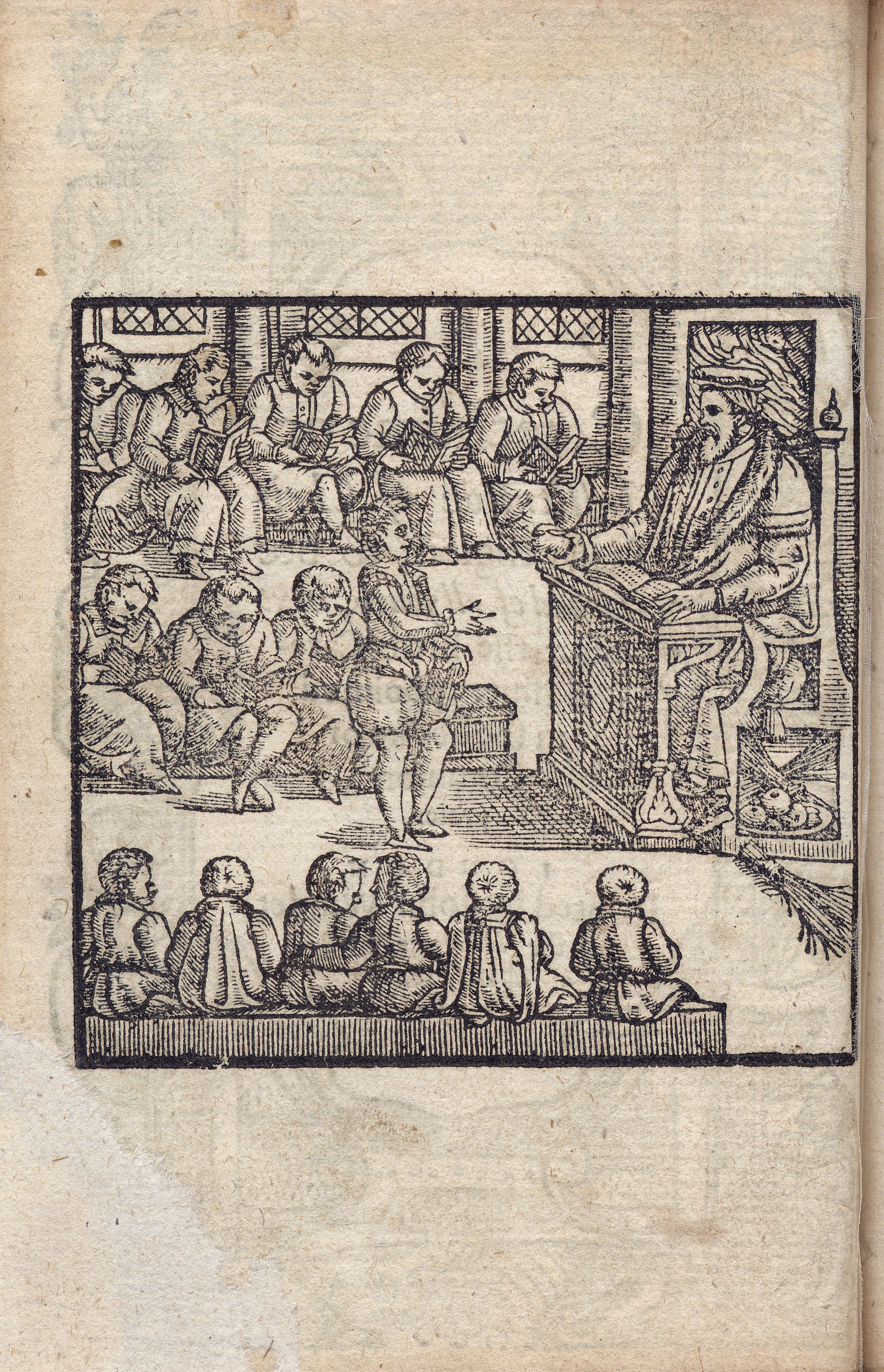 Source: A sixteenth-century title page and verso woodcut from 'A Catechism or Institution of Christian Religion,' Folger Shakespeare Library
The Female American,
like its contemporaryRobinson Crusoe(1719),
reflects the historical reality of Christian efforts that imposed
European literacy and religious practices on Indigenous populations.
Unca Eliza's translation of the Bible and the Common Prayer Book
echoes these real-world initiatives, which
Catherine A. Breckus
and
W. Clark Gilpin
argue functioned as tools of colonial control, reshaping Indigenous
societies to fit European frameworks. See
American Christianities: A History of Dominance and
Diversity (University of North Carolina Press, 2011).
While the novel critiques the violence often associated with
missionary work, it still promotes a "myth of non-colonial conversion,"
as Edward Simon highlights. Christianity is portrayed as a natural
extension of human reason, and any rational individual would willingly
convert upon encountering it which therefore obscures the coercion that
often underpinned such conversions. See Simon,
"Unca Eliza Winkfield and the Fantasy of Non-Colonial Conversion in The Female
American." Women's Studies, 45.7 (2016): 649–59. - [UOStudStaff]idolatrypractice of worshipping idols,
especially in the derogatory sense of worshiping a false god - [UOStudStaff]baptize
Source: A sixteenth-century title page and verso woodcut from 'A Catechism or Institution of Christian Religion,' Folger Shakespeare Library
The Female American,
like its contemporaryRobinson Crusoe(1719),
reflects the historical reality of Christian efforts that imposed
European literacy and religious practices on Indigenous populations.
Unca Eliza's translation of the Bible and the Common Prayer Book
echoes these real-world initiatives, which
Catherine A. Breckus
and
W. Clark Gilpin
argue functioned as tools of colonial control, reshaping Indigenous
societies to fit European frameworks. See
American Christianities: A History of Dominance and
Diversity (University of North Carolina Press, 2011).
While the novel critiques the violence often associated with
missionary work, it still promotes a "myth of non-colonial conversion,"
as Edward Simon highlights. Christianity is portrayed as a natural
extension of human reason, and any rational individual would willingly
convert upon encountering it which therefore obscures the coercion that
often underpinned such conversions. See Simon,
"Unca Eliza Winkfield and the Fantasy of Non-Colonial Conversion in The Female
American." Women's Studies, 45.7 (2016): 649–59. - [UOStudStaff]idolatrypractice of worshipping idols,
especially in the derogatory sense of worshiping a false god - [UOStudStaff]baptize
 Source: Frontispiece illustration and title page for the 1719 publication of The Life and Strange Surprizing Adventures of Robinson Crusoe, Of York. Public domain image, British Library. - [UOStudStaff]deisticalof the nature of or pertaining to deists or
deism. - [UOStudStaff]deism
Source: Frontispiece illustration and title page for the 1719 publication of The Life and Strange Surprizing Adventures of Robinson Crusoe, Of York. Public domain image, British Library. - [UOStudStaff]deisticalof the nature of or pertaining to deists or
deism. - [UOStudStaff]deism
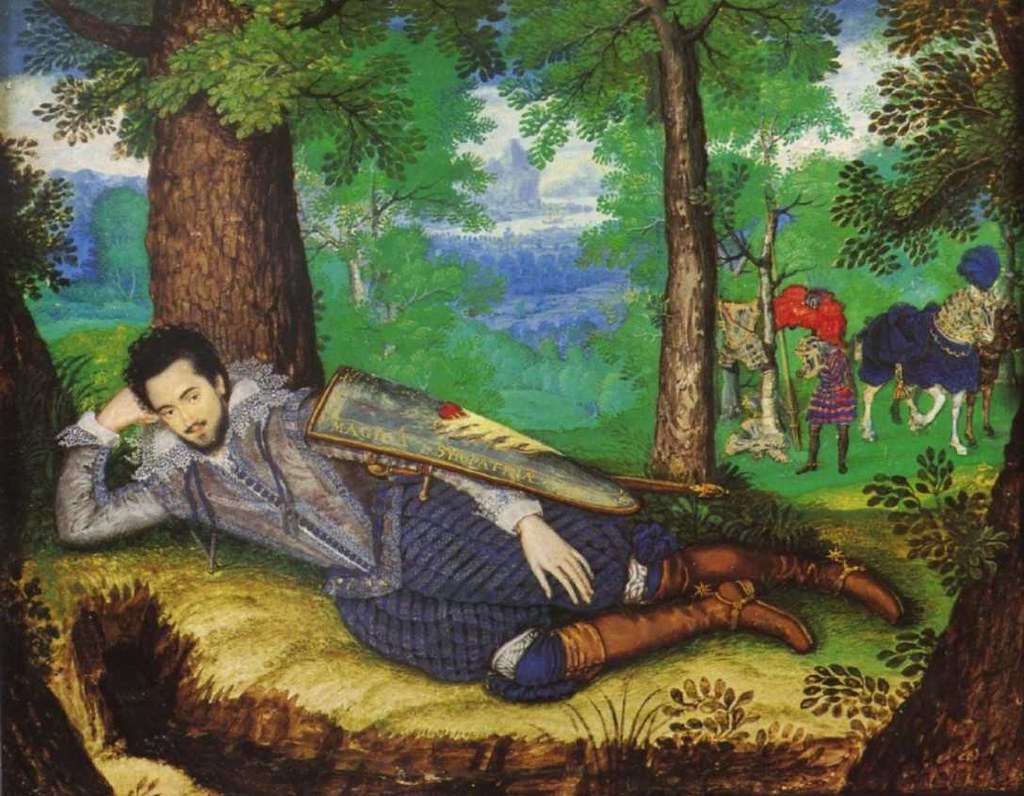 Source: A painting of Lord Edward Herbert by Isaac Oliver, ca. 1613-1614, via Wikimedia Commons..The writers that Unca Eliza remembers from her
uncle's study likely include Deists like Lord Edward Herbert(1583 - 1648, pictured),
Charles Blount (1562 - 1606),
Anthony Collins (1676-1729), and
Matthew Tindal (1657-1733),
who believed that God created the universe and then allowed it to operate
under natural law (
Oxford English Dictionary). Unca Eliza's familiarity with these writers
demonstrates to readers that, like the Deists, she believes that--as
Darren Staloff puts it--"religious truth should be subject to the authority
of human reason rather than divine revelation.” See Staloff,
"Deism and the Founding of the United
States" (2008). - [UOStudStaff]fastenedfortified, secured - [UOStudStaff]oracularresembling divine authority or ancient oracles - [UOStudStaff]slave
Source: A painting of Lord Edward Herbert by Isaac Oliver, ca. 1613-1614, via Wikimedia Commons..The writers that Unca Eliza remembers from her
uncle's study likely include Deists like Lord Edward Herbert(1583 - 1648, pictured),
Charles Blount (1562 - 1606),
Anthony Collins (1676-1729), and
Matthew Tindal (1657-1733),
who believed that God created the universe and then allowed it to operate
under natural law (
Oxford English Dictionary). Unca Eliza's familiarity with these writers
demonstrates to readers that, like the Deists, she believes that--as
Darren Staloff puts it--"religious truth should be subject to the authority
of human reason rather than divine revelation.” See Staloff,
"Deism and the Founding of the United
States" (2008). - [UOStudStaff]fastenedfortified, secured - [UOStudStaff]oracularresembling divine authority or ancient oracles - [UOStudStaff]slave
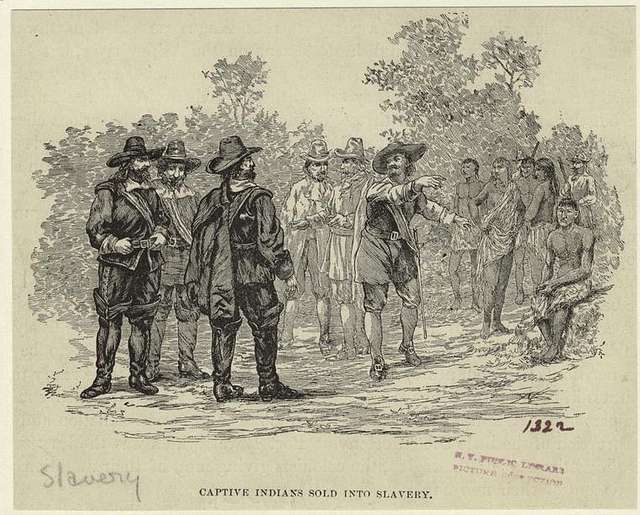 Source: 'Captive Indians Sold Into Slavery,' ca. 1890. Public domain image from the New York Public Library
The Female Americanwas written and published
around the peak of the "Indian Slave Trade." At this time, Europeans
had the Indigenous peoples captured sometimes by their own people.
They were then sold off to be tortured or harmed by those colonizing
them. She fears the Europeans could capture the island Natives and
treat them like they did with her ancestors. More on the enslavement
of Indigenous peoples referenced inThe Female
Americancan be found in Anna Brickhouse's "The Indian Slave
Trade in Unca Eliza Winkfield'sThe Female American.
"The Yearbook of English Studies46 (2016): 115-26.
DOI: 10.5699/yearenglstud.46.2016.0115. - [UOStudStaff]deign
think worthy of oneself - [UOStudStaff]piousshowing reverence or obedience to God - [UOStudStaff]subterraneousunderground - [UOStudStaff]drestdressed - [UOStudStaff]insularpertaining to or located on an island - [UOStudStaff]surprizesurprise - [UOStudStaff]melodiouscharacterized by melody; having a sweet
or pleasant sound; tuneful - [UOStudStaff]credulousToo willing to believe, especially
on weak or insufficient grounds - [UOStudStaff]portendfortell by supernatural means - [UOStudStaff]gallantrypolite display of attention - [UOStudStaff]subsistedsurvived - [UOStudStaff]musickmusic - [UOStudStaff]tawnytan - [UOStudStaff]wraptcovered - [UOStudStaff]apacequickly, promptly - [UOStudStaff]croniesintimate friends or associates - [UOStudStaff]mutineersomeone who revolts against or openly resists
authority - [UOStudStaff]chearfullycheerfully - [UOStudStaff]regardUnca's assertion that the Indigenous people don't
question the authority ofEuropeans
aligns with eighteenth century imperialist ideologies, which frame Indigenous people
as submissive to conversion efforts. In
"Christian
Mission,"Michael Sievernich
discusses the state-supported Christian missions in the eighteenth century which
destroyed Indigenous traditions and reinforced colonial dominance under the diguise
of religious salvation. "Christian Mission."European History
Online, Institute of European History, 19 May 2011,
www.ieg-ego.eu/en/threads/europe-and-the-world/mission. - [UOStudStaff]befallenhappened - [UOStudStaff]providences which was provided, provisions - [UOStudStaff]fulfilfulfill, make complete - [UOStudStaff]plainsimple; straightforward - [UOStudStaff]holy-ordersthe status of an ordained minister of the
Christian church - [UOStudStaff]pious-religionfaithful to religious duties and observances - [UOStudStaff]leaveask permission to do something - [UOStudStaff]handpledge of marriage - [UOStudStaff]mortificationembarassment, humiliation - [UOStudStaff]affabilityfriendliness, readiness to talk - [UOStudStaff]shewingshowing - [UOStudStaff]supeat supper - [UOStudStaff]repastfood, meal - [UOStudStaff]professeddeclared; already affirmed - [UOStudStaff]chagrinedtroubled, vexed, worried, grieved - [UOStudStaff]conspicuousvisible, apparent - [UOStudStaff]streamera flag streaming or waving in the air - [UOStudStaff]conversionchange ones faith - [UOStudStaff]ordinancesprescribed practices - [UOStudStaff]importunitypressing persistence - [UOStudStaff]two-monthsUnca Eliza's marriage to her cousin
is not done out of love for him - [UOStudStaff]catechisingteaching the elements of religion - [UOStudStaff]my-husband
Source: 'Captive Indians Sold Into Slavery,' ca. 1890. Public domain image from the New York Public Library
The Female Americanwas written and published
around the peak of the "Indian Slave Trade." At this time, Europeans
had the Indigenous peoples captured sometimes by their own people.
They were then sold off to be tortured or harmed by those colonizing
them. She fears the Europeans could capture the island Natives and
treat them like they did with her ancestors. More on the enslavement
of Indigenous peoples referenced inThe Female
Americancan be found in Anna Brickhouse's "The Indian Slave
Trade in Unca Eliza Winkfield'sThe Female American.
"The Yearbook of English Studies46 (2016): 115-26.
DOI: 10.5699/yearenglstud.46.2016.0115. - [UOStudStaff]deign
think worthy of oneself - [UOStudStaff]piousshowing reverence or obedience to God - [UOStudStaff]subterraneousunderground - [UOStudStaff]drestdressed - [UOStudStaff]insularpertaining to or located on an island - [UOStudStaff]surprizesurprise - [UOStudStaff]melodiouscharacterized by melody; having a sweet
or pleasant sound; tuneful - [UOStudStaff]credulousToo willing to believe, especially
on weak or insufficient grounds - [UOStudStaff]portendfortell by supernatural means - [UOStudStaff]gallantrypolite display of attention - [UOStudStaff]subsistedsurvived - [UOStudStaff]musickmusic - [UOStudStaff]tawnytan - [UOStudStaff]wraptcovered - [UOStudStaff]apacequickly, promptly - [UOStudStaff]croniesintimate friends or associates - [UOStudStaff]mutineersomeone who revolts against or openly resists
authority - [UOStudStaff]chearfullycheerfully - [UOStudStaff]regardUnca's assertion that the Indigenous people don't
question the authority ofEuropeans
aligns with eighteenth century imperialist ideologies, which frame Indigenous people
as submissive to conversion efforts. In
"Christian
Mission,"Michael Sievernich
discusses the state-supported Christian missions in the eighteenth century which
destroyed Indigenous traditions and reinforced colonial dominance under the diguise
of religious salvation. "Christian Mission."European History
Online, Institute of European History, 19 May 2011,
www.ieg-ego.eu/en/threads/europe-and-the-world/mission. - [UOStudStaff]befallenhappened - [UOStudStaff]providences which was provided, provisions - [UOStudStaff]fulfilfulfill, make complete - [UOStudStaff]plainsimple; straightforward - [UOStudStaff]holy-ordersthe status of an ordained minister of the
Christian church - [UOStudStaff]pious-religionfaithful to religious duties and observances - [UOStudStaff]leaveask permission to do something - [UOStudStaff]handpledge of marriage - [UOStudStaff]mortificationembarassment, humiliation - [UOStudStaff]affabilityfriendliness, readiness to talk - [UOStudStaff]shewingshowing - [UOStudStaff]supeat supper - [UOStudStaff]repastfood, meal - [UOStudStaff]professeddeclared; already affirmed - [UOStudStaff]chagrinedtroubled, vexed, worried, grieved - [UOStudStaff]conspicuousvisible, apparent - [UOStudStaff]streamera flag streaming or waving in the air - [UOStudStaff]conversionchange ones faith - [UOStudStaff]ordinancesprescribed practices - [UOStudStaff]importunitypressing persistence - [UOStudStaff]two-monthsUnca Eliza's marriage to her cousin
is not done out of love for him - [UOStudStaff]catechisingteaching the elements of religion - [UOStudStaff]my-husband
 Source: William Hogarth's painting 'Marriage Settlement' (c.1743) portrays an arranged marriage between wealthy families. The scene displayes the tie between family expectations and marriage during the eighteenth century. Public domain image from the Metropolition Museum of Art
Unca Eliza refers to Mr. Winkfield as her cousin until they are married,
after she refers to him as her husband. Marriage among family members was
socially acceptable throughout the eighteenth century. Commonly, the upper
class chose familial marriages to maintain wealth and respected social
status. Susan Mckinnon, "Cousin Marriage, Hierarchy, and Heredity:
Contestations over Domestic and National Body Politics in 19th-century America."
Journal of the British Academy7 (2019): 61-88.
DOI:10.5871/jba/007.061
- [UOStudStaff]sea-faringa person who made their living by traveling
the sea - [UOStudStaff]acquaintmake someone aware of - [UOStudStaff]befallenhappened - [UOStudStaff]unmolestedundisturbed, untroubled - [UOStudStaff]discoursediscussion of conversation - [UOStudStaff]readilywillingly - [UOStudStaff]yard-armeither of two outer extremity ends of a
ship's yard - [UOStudStaff]wainscotpanel-work of oak or other wood, used to line
the walls of an apartment. - [UOStudStaff]prolixgiven to or characterized by tedious lengthiness
in speech or writing - [UOStudStaff]reprovingrebuking or reprimanding - [UOStudStaff]smoteHit me with godly punishment (smite in past tense)
- [UOStudStaff]befallscomes upon - [UOStudStaff]unanimityunanimous - [UOStudStaff]execution-dock
Source: William Hogarth's painting 'Marriage Settlement' (c.1743) portrays an arranged marriage between wealthy families. The scene displayes the tie between family expectations and marriage during the eighteenth century. Public domain image from the Metropolition Museum of Art
Unca Eliza refers to Mr. Winkfield as her cousin until they are married,
after she refers to him as her husband. Marriage among family members was
socially acceptable throughout the eighteenth century. Commonly, the upper
class chose familial marriages to maintain wealth and respected social
status. Susan Mckinnon, "Cousin Marriage, Hierarchy, and Heredity:
Contestations over Domestic and National Body Politics in 19th-century America."
Journal of the British Academy7 (2019): 61-88.
DOI:10.5871/jba/007.061
- [UOStudStaff]sea-faringa person who made their living by traveling
the sea - [UOStudStaff]acquaintmake someone aware of - [UOStudStaff]befallenhappened - [UOStudStaff]unmolestedundisturbed, untroubled - [UOStudStaff]discoursediscussion of conversation - [UOStudStaff]readilywillingly - [UOStudStaff]yard-armeither of two outer extremity ends of a
ship's yard - [UOStudStaff]wainscotpanel-work of oak or other wood, used to line
the walls of an apartment. - [UOStudStaff]prolixgiven to or characterized by tedious lengthiness
in speech or writing - [UOStudStaff]reprovingrebuking or reprimanding - [UOStudStaff]smoteHit me with godly punishment (smite in past tense)
- [UOStudStaff]befallscomes upon - [UOStudStaff]unanimityunanimous - [UOStudStaff]execution-dock
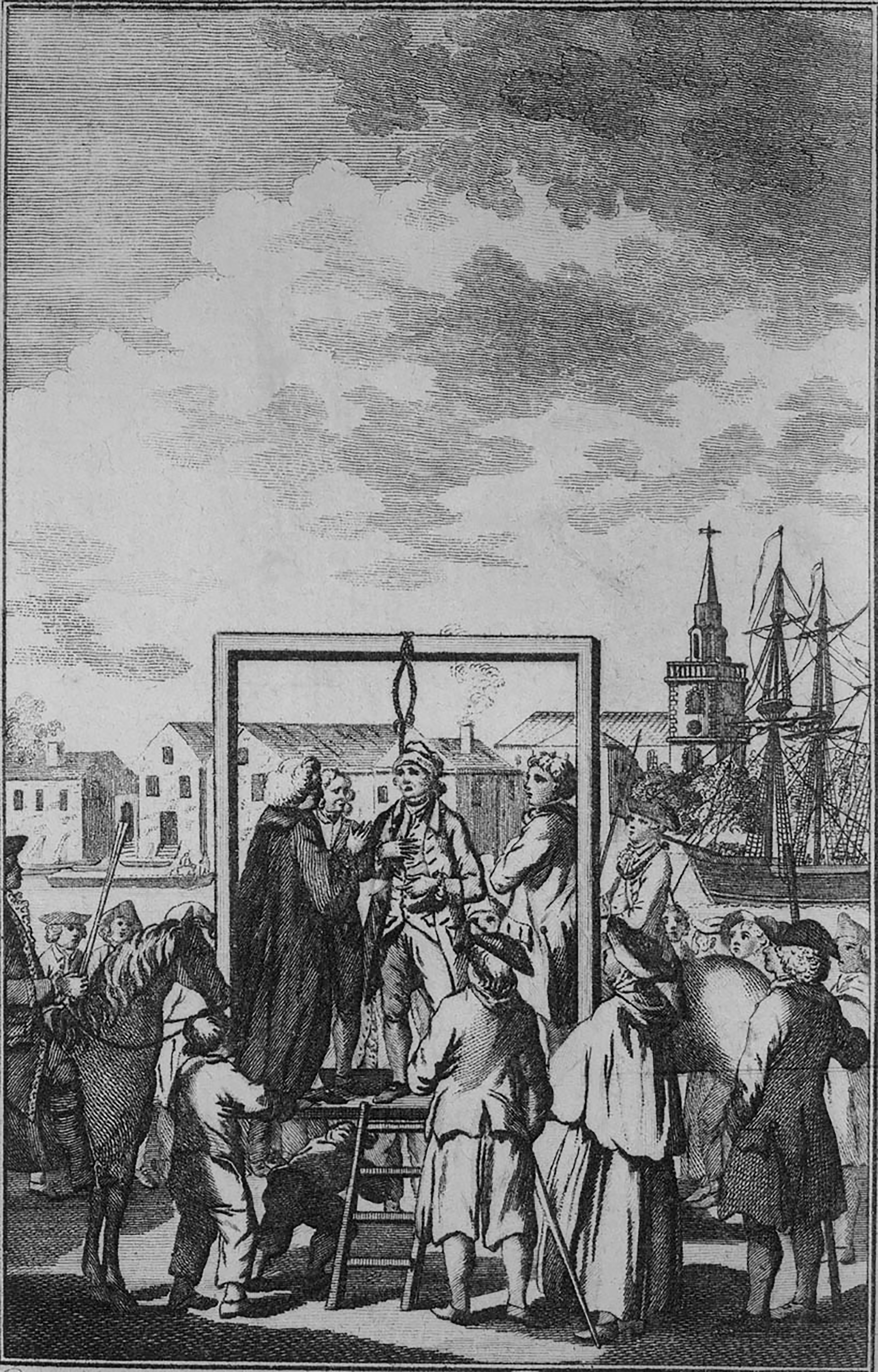 Source: Engraving, ca. 1795. Royal Museum Greenwich, CC-BY-NC-ND license
A pirate, thought to be Captain James Lowry, is awaiting execution by hanging at
Execution-Dock,
a gallows in London by the
Thames River.
Digital image made available by the
National Maritime Museum,
Greenwich. - [UOStudStaff]tempted
Source: Engraving, ca. 1795. Royal Museum Greenwich, CC-BY-NC-ND license
A pirate, thought to be Captain James Lowry, is awaiting execution by hanging at
Execution-Dock,
a gallows in London by the
Thames River.
Digital image made available by the
National Maritime Museum,
Greenwich. - [UOStudStaff]tempted
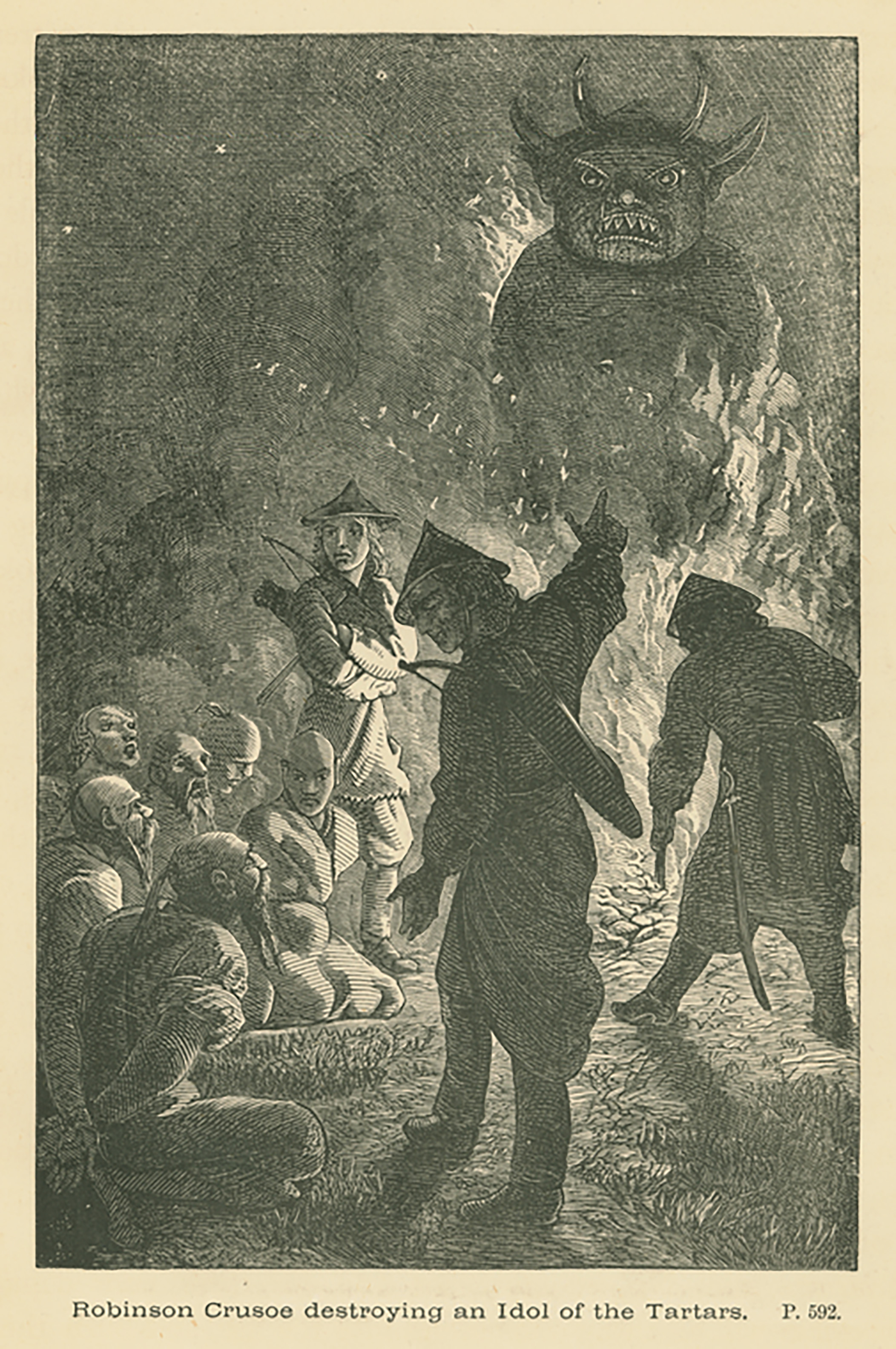 Source: Johann Baptist Zwecker, 'Robinson Crusoe destroying an Idol of the Tartars' (1872). Public Domain image from New York Public Library Digital Collections. In this 19th-century illustration, Robinson Crusoe destroys Cham Chi-Thaungu, referred to in the engraving's original caption as the 'idol' of the 'Tartars' --a historically inaccurate label often used in European literature to describe various Central and East Asian peoples.
The destruction of the idol possibly suggests Unca Eliza's 'confirmation of Christian
conversion' (41) of the Indigenous peoples, in the removal of what she believes to be
an idolatrous figure. Yet, Roslyn Irving reads this moment as symbolic of Unca Eliza'
integration with the Indigenous people in America, where 'removing the statue is
perhaps symbolic of a conversion narrative never fully realised.'
'Reading for Friday
inthe Female American(1767),'
Nordic Journal of English Studies,23 (2024): 41.
DOI: 10.35360/njes.2024.23287.
- [UOStudStaff]rakea vain, immoral and/or promiscuous man
- [UOStudStaff]
Source: Johann Baptist Zwecker, 'Robinson Crusoe destroying an Idol of the Tartars' (1872). Public Domain image from New York Public Library Digital Collections. In this 19th-century illustration, Robinson Crusoe destroys Cham Chi-Thaungu, referred to in the engraving's original caption as the 'idol' of the 'Tartars' --a historically inaccurate label often used in European literature to describe various Central and East Asian peoples.
The destruction of the idol possibly suggests Unca Eliza's 'confirmation of Christian
conversion' (41) of the Indigenous peoples, in the removal of what she believes to be
an idolatrous figure. Yet, Roslyn Irving reads this moment as symbolic of Unca Eliza'
integration with the Indigenous people in America, where 'removing the statue is
perhaps symbolic of a conversion narrative never fully realised.'
'Reading for Friday
inthe Female American(1767),'
Nordic Journal of English Studies,23 (2024): 41.
DOI: 10.35360/njes.2024.23287.
- [UOStudStaff]rakea vain, immoral and/or promiscuous man
- [UOStudStaff]
 Source: Apollo and Athena invite a reader to enjoy John Noble's library of educational and entertaining books. Frontispiece illustration to 'A new catalogue of the large and valuable collection of books: (both English and French) in John Noble's circulating library. Consisting of several thousand volumes...which are lent to read,' circa 1761. Public domain image, Folger Shakespeare Library Digital Collections.
Francis and John Noble were booksellers and publishers who ran a
successful circulating library starting in the 1740s. Rochelle Raineri
Zuck speculates that The Female American may have
been the product of the "stable of writers" the Nobles employed "to
produce new work at a rapid pace" for their libraries-something like the
eighteenth-century equivalent of Internet
content farms. See Zuck, "Who Wrote
The Female American?" in
English Literary History 89.3 (2022): 669.
DOI:10.1353/elh.2022.0023.
- [UOStudStaff]American
Source: Apollo and Athena invite a reader to enjoy John Noble's library of educational and entertaining books. Frontispiece illustration to 'A new catalogue of the large and valuable collection of books: (both English and French) in John Noble's circulating library. Consisting of several thousand volumes...which are lent to read,' circa 1761. Public domain image, Folger Shakespeare Library Digital Collections.
Francis and John Noble were booksellers and publishers who ran a
successful circulating library starting in the 1740s. Rochelle Raineri
Zuck speculates that The Female American may have
been the product of the "stable of writers" the Nobles employed "to
produce new work at a rapid pace" for their libraries-something like the
eighteenth-century equivalent of Internet
content farms. See Zuck, "Who Wrote
The Female American?" in
English Literary History 89.3 (2022): 669.
DOI:10.1353/elh.2022.0023.
- [UOStudStaff]American
 Source: Theodore Galle, 'Allegory of America,' ca. 1600. Public Domain image, Metropolitan Museum of Art.
This engraving by Netherlandish artist Theodoor Galle imitates
Johannes Stradanus' original drawing of Italian explorer Amerigo
Vespucci. In this allegorical image, Vespucci is shown 'awakening'
a woman who personifies America. The caption, 'Americen Americus
retexit, semel vocauit inde semper excitam,' roughly translates to
'Americus rediscovers America, once awakened, always aroused,'
further underscoring the sexualized and racialized ideology of
conquest. Like many depictions from this period, it visualizes
the so-called discovery of the Americas as an act of European male
dominance over feminized, exoticized, and passive land and peoples.
- [OUStudStaff]rivuletsstreams - [UOStudStaff]variegatedvaried - [UOStudStaff]extraordinary
Source: Theodore Galle, 'Allegory of America,' ca. 1600. Public Domain image, Metropolitan Museum of Art.
This engraving by Netherlandish artist Theodoor Galle imitates
Johannes Stradanus' original drawing of Italian explorer Amerigo
Vespucci. In this allegorical image, Vespucci is shown 'awakening'
a woman who personifies America. The caption, 'Americen Americus
retexit, semel vocauit inde semper excitam,' roughly translates to
'Americus rediscovers America, once awakened, always aroused,'
further underscoring the sexualized and racialized ideology of
conquest. Like many depictions from this period, it visualizes
the so-called discovery of the Americas as an act of European male
dominance over feminized, exoticized, and passive land and peoples.
- [OUStudStaff]rivuletsstreams - [UOStudStaff]variegatedvaried - [UOStudStaff]extraordinary
 Source: Helmingham Herbal and Bestiary (1500), Yale Center for British Art. Reused under Yale Library's Open Access Policy.
The absurd nature of the fictious animal described in this passage implies
a metaphorical meaning. The animal's only means of survival is deceiving its
prey, pretending to sleep in order to capture it. Anna Brickhouse connects
this description to Unca Eliza's own deception of the island's Indigenous
people, claiming that "Unca Eliza is both transfixed and patently disturbed
by the greed and violence of this strange colonial animal. A nightmarish
embodiment of her own predicament." Brickhouse, "The Indian Slave Trade in
Unca Eliza Winkfield's The Female American."
The Yearbook of English Studies46 (2016): 115-126.
DOI: 10.1353/yes.2016.0008.
- [UOStudStaff]asundersplit apart - [UOStudStaff]providenceGod's divine plan - [UOStudStaff]rowledrolled - [UOStudStaff]herbagestems and leaves - [UOStudStaff]though-a-woman
Source: Helmingham Herbal and Bestiary (1500), Yale Center for British Art. Reused under Yale Library's Open Access Policy.
The absurd nature of the fictious animal described in this passage implies
a metaphorical meaning. The animal's only means of survival is deceiving its
prey, pretending to sleep in order to capture it. Anna Brickhouse connects
this description to Unca Eliza's own deception of the island's Indigenous
people, claiming that "Unca Eliza is both transfixed and patently disturbed
by the greed and violence of this strange colonial animal. A nightmarish
embodiment of her own predicament." Brickhouse, "The Indian Slave Trade in
Unca Eliza Winkfield's The Female American."
The Yearbook of English Studies46 (2016): 115-126.
DOI: 10.1353/yes.2016.0008.
- [UOStudStaff]asundersplit apart - [UOStudStaff]providenceGod's divine plan - [UOStudStaff]rowledrolled - [UOStudStaff]herbagestems and leaves - [UOStudStaff]though-a-woman
 Source: Image from Thomas Heywood's 'The exemplary lives and memorable acts of nine the most worthy women of the world' (1640). Folger Shakespeare Library, CC-0 license.
The phrase "though a woman" serves as a brief but significant
acknowledgment of gendered restrictions on knowledge in eighteenth-century
England. Although Unca Eliza is depicted as a strong and smart
individual who challenges traditional gender roles, she establishes
her credibility by referencing foundational male philosophers,
indicating her awareness of cultural expectations regarding women's
intellectual ability. Scholar Jill Conway asserts that "European
women intellectuals were either declasse, or else they lived a
contemplative life in a religious community." Unca Eliza's isolation
on the island literalizes the social exile faced by intellectual
women at the time. See Conway, "Perspectives on the History of Women's
Education in the United States."
History of Education Quarterly 14.1 (1974): 1–12.
DOI: 10.2307/367602. - [UOStudStaff]aristotle
This moment reflects the complex changing attitudes
towards the capabilities of women during the Enlightenment. Unca Eliza both
establishes her womanhood as something inferior to male intellectuals
and simultaneously places herself above classical scholars. While women
at the time were becoming increasingly established in intellectual fields
they were still seen as inferior to men. In
Women and Enlightenment in Eighteenth Century Britain
(Cambridge University Press, 2009), Karen O'Brien writes that, while the
progress of women in eighteenth-century Britain cannot be likened to feminism
as we know it, the Enlightenment "created a framework and a language for
understanding the gendered structures of society without which nineteenth-century
feminism would not have been possible" (2).
- [UOStudStaff]ignoble
not honourable in character or purpose - [UOStudStaff]conjectureformation of an opinion on grounds insufficient
to furnish proof; action of guessing or surmising - [UOStudStaff]exaltedRaised to a high level of dignity or honor.
- [UOStudStaff]desolate
Source: Image from Thomas Heywood's 'The exemplary lives and memorable acts of nine the most worthy women of the world' (1640). Folger Shakespeare Library, CC-0 license.
The phrase "though a woman" serves as a brief but significant
acknowledgment of gendered restrictions on knowledge in eighteenth-century
England. Although Unca Eliza is depicted as a strong and smart
individual who challenges traditional gender roles, she establishes
her credibility by referencing foundational male philosophers,
indicating her awareness of cultural expectations regarding women's
intellectual ability. Scholar Jill Conway asserts that "European
women intellectuals were either declasse, or else they lived a
contemplative life in a religious community." Unca Eliza's isolation
on the island literalizes the social exile faced by intellectual
women at the time. See Conway, "Perspectives on the History of Women's
Education in the United States."
History of Education Quarterly 14.1 (1974): 1–12.
DOI: 10.2307/367602. - [UOStudStaff]aristotle
This moment reflects the complex changing attitudes
towards the capabilities of women during the Enlightenment. Unca Eliza both
establishes her womanhood as something inferior to male intellectuals
and simultaneously places herself above classical scholars. While women
at the time were becoming increasingly established in intellectual fields
they were still seen as inferior to men. In
Women and Enlightenment in Eighteenth Century Britain
(Cambridge University Press, 2009), Karen O'Brien writes that, while the
progress of women in eighteenth-century Britain cannot be likened to feminism
as we know it, the Enlightenment "created a framework and a language for
understanding the gendered structures of society without which nineteenth-century
feminism would not have been possible" (2).
- [UOStudStaff]ignoble
not honourable in character or purpose - [UOStudStaff]conjectureformation of an opinion on grounds insufficient
to furnish proof; action of guessing or surmising - [UOStudStaff]exaltedRaised to a high level of dignity or honor.
- [UOStudStaff]desolate Source: A print from Carington Bowles' (1724-1793), 'Twelve Illustrations of Robinson Crusoe,' shows Crusoe tending to grapes at his 'Summer Retreat,' accompanied by a quote from the novel: 'In this place also I had my grapes growing, which I principally depended on for my Winter Store of Raisins, and which I never fear to preserve very carefully.' Public domain image, Yale Center for British Art.
This allusion to Robinson Crusoe(1719) establishes
Daniel Defoe's castaway novel as inspiration for
The Female American. Like Crusoe, Unca Eliza finds her time on the island
to be especially prosperous, with the necessary provisions appearing as desired.
These occurrences ultimately fuel the protagonists' unending faith and pursuit
of divine providence. Though these tales are similar in content and fabrication,
The Female Americanironically attempts to discredit its
precursor due to its fictitious storyline. To learn more about the parallels
between these two works, see Tremaine McDowell, "An American Robinson Crusoe"
American Literature 1.3 (1929): 307-09. - [UOStudStaff]obeisancesGestures of respect, such as bowing. - [UOStudStaff]high-priest
Unca portrays herself as a woman with strong Anglican beliefs,
yet momentarily forfeits her belief system on the island when she finds the idol.
She begins manipulating the people around her through the influence of the idol,
and internalizes the mindset of its power. She utilizes lies, treasures, costumes
and deceit to reinforce her position as a god-like figure. Scarlet Brown
explores this idea of manipulation, describing Unca's behavior as "an expert stage
director," mannered with "theatrical efforts to persuade the Indians," and further
describes the lengths Unca would go to fulfill her own facade. Bowen,
"Via Media: Transatlantic
Anglicanism in The Female American."
The Eighteenth Century, 53.2 (2012): 189 - 207. - [UOStudStaff]peremptoryInsisting on immediate attention or
obedience, leaving no room for refusal. - [UOStudStaff]natural-religion
Source: A print from Carington Bowles' (1724-1793), 'Twelve Illustrations of Robinson Crusoe,' shows Crusoe tending to grapes at his 'Summer Retreat,' accompanied by a quote from the novel: 'In this place also I had my grapes growing, which I principally depended on for my Winter Store of Raisins, and which I never fear to preserve very carefully.' Public domain image, Yale Center for British Art.
This allusion to Robinson Crusoe(1719) establishes
Daniel Defoe's castaway novel as inspiration for
The Female American. Like Crusoe, Unca Eliza finds her time on the island
to be especially prosperous, with the necessary provisions appearing as desired.
These occurrences ultimately fuel the protagonists' unending faith and pursuit
of divine providence. Though these tales are similar in content and fabrication,
The Female Americanironically attempts to discredit its
precursor due to its fictitious storyline. To learn more about the parallels
between these two works, see Tremaine McDowell, "An American Robinson Crusoe"
American Literature 1.3 (1929): 307-09. - [UOStudStaff]obeisancesGestures of respect, such as bowing. - [UOStudStaff]high-priest
Unca portrays herself as a woman with strong Anglican beliefs,
yet momentarily forfeits her belief system on the island when she finds the idol.
She begins manipulating the people around her through the influence of the idol,
and internalizes the mindset of its power. She utilizes lies, treasures, costumes
and deceit to reinforce her position as a god-like figure. Scarlet Brown
explores this idea of manipulation, describing Unca's behavior as "an expert stage
director," mannered with "theatrical efforts to persuade the Indians," and further
describes the lengths Unca would go to fulfill her own facade. Bowen,
"Via Media: Transatlantic
Anglicanism in The Female American."
The Eighteenth Century, 53.2 (2012): 189 - 207. - [UOStudStaff]peremptoryInsisting on immediate attention or
obedience, leaving no room for refusal. - [UOStudStaff]natural-religion
 Source: 'Portret van John Wilkins, bisschop van Chester Effigies Reverendi admodum viri, Johannis Wilkins, nuper Episcopi Cestriensis (titel op object), RP-P-1941-141' by Abraham Bloteling was sourced from the Rijks Museum under CCO 1.0.
This verbiage is likely a reference to John Wilkins'
Of The Principles And Duties Of Natural Religion, (1734).
Wilkins (1614-1672) was an Anglican clergyman who proposed that the matter and
form of living things is evidence of God's divine authority. In the context of
The Female American, Unca Winkfield creates the idea of
a Christian deity while simultaneously acknowledging her role in a theological
myth of nature versus God's creation. The bottom of the portrait reads "Effigies
Reverendi admodum viri, Johannis Wilkins, nuper Episcopi Cestriensis," which
translates to "Portrait of the very Reverend John Wilkins, late Bishop of Chester"
in English. Read more inOf the Principles and Duties of Natural
Religion:
Internet Archive.
- [UOStudStaff]arduoushard to accomplish or achieve - [UOStudStaff]abasheduneasy, confused, embarrassed - [UOStudStaff]desiststop, delay, cease - [UOStudStaff]obstinancystubbornness, inflexibility - [UOStudStaff]deludeddeceived, beguiled, led away from truth - [UOStudStaff]Deitydivine being, god - [UOStudStaff]irresoluteunresolved, undecided - [UOStudStaff]attendedwould bring certain misfortune - [UOStudStaff]wretchperson driven from their native country,
exile. - [UOStudStaff]recourseturned to - [UOStudStaff]obedienceThere is tension in Unca Eliza'sbelief system as she plans to manipulate
the Indigenous people utilizing their own deity - simultaneously condemning
the Indigenous religious as idolatrous while participating within their
belief system. In
"Via Media": Transatlantic Anglicanism in "The Female American,"
Scarlet Bowen
explores this manipulation, describing Unca as "an expert stage director,"
using "theatrical" effort (197).
Bowen, Scarlet."‘Via Media': Transatlantic Anglicanism in ‘The
Female American.'"The Eighteenth Century, 53.2, 2012,
pp. 189–207. JSTOR, http://www.jstor.org/stable/41468177. Accessed 26 Feb.
2025. - [UOStudStaff]oracleinstrument or medium through which
the gods were supposed to speak or prophesy. - [UOStudStaff]therein
in that place - [UOStudStaff]bestowgive as a gift, or present - [UOStudStaff]willintention, command, order - [UOStudStaff]grievoussevere - [UOStudStaff]whencefrom a place - [UOStudStaff]hinderdeter, prevent, impede - [UOStudStaff]hitherhere - [UOStudStaff]dumbintentionally silent - [UOStudStaff]drestdressed - [UOStudStaff]conductescort, guide - [UOStudStaff]expedientplan to attain a certain end - [UOStudStaff]procure-obtainobtain, acquire - [UOStudStaff]ensuingapproaching - [UOStudStaff]drestdressed - [UOStudStaff]vestmentsgarments worn by a priest or ecclesiastic
on the occasion of some service or ceremony; priestly robes - [UOStudStaff]cassocka cloak or long coat worn by some soldiers
or horse riders in 16/17th centuries - [UOStudStaff]repositorya place in which something (physical)
accumulates - [UOStudStaff]procurecause or bring about - [UOStudStaff]undertakinga pledge or promise - [UOStudStaff]countenancethe look or expression of a person's face
- [UOStudStaff]prostratedthrew oneself on the ground to
show devotion - [UOStudStaff]affabilityfriendliness, readiness to talk - [UOStudStaff]hitherhere - [UOStudStaff]reverenceRespect - [UOStudStaff]provisionsFood and drink - [UOStudStaff]repastrefreshment - [UOStudStaff]expoundsinterprets, comments on, or
communicates to others - [UOStudStaff]multitudelarge group of people - [UOStudStaff]providencedirection, guidance, or provision from God - [UOStudStaff]prostratedthrew oneself on the ground to show devotion - [UOStudStaff]addressspeech given in front of people - [UOStudStaff]serve
Unca Eliza's narration emphasizes the privilege her colonial hybridity allows
her on the island. Julia Kark Callander suggests that Unca Eliza becomes a
"native royal... at once representative of a community and set apart from it
(i.e., better than its other members)." Unca Eliza's cultural, ethnic, and national
hybridity mesh into a colonial hybridity that is both novel and contradictive--a
paradox that Callander notes is "quite American." "'Attended by a Whole
Nation': The Americas in The Female American."
1650-1850: Ideas, Aesthetics, and Inquiries in the Early Modern
Era18 (2011): 129-149. Print. - [UOStudStaff]dischargecarry out a task - [UOStudStaff]apostle
person who introduces Christianity in a region - [UOStudStaff]taken-upon-me
In calling herself an apostle, or a disciple of Christ,
Unca Eliza demonstrates a key difference between
The Female American(1767) and Daniel Defoe's
Robinson Crusoe(1719). While Robinson Crusoe
finds his religion after he is stranded on the island, Unca Eliza has
always been well versed in Christianity and has "unwavering confidence
in religious knowledge." Jonahs Kneitly,
"The Female Americanand Its Liminal Spaces."
Studies in Religion and the Enlightenment3.1 2023)
28-40, DOI:10.32655/srej.2023.3.1.3 2023
- [UOStudStaff]apprehensionthe act of learning - [UOStudStaff]catechisma book containing the basics of
Christianity, meant to be taught in question-and-answer format - [UOStudStaff]translation
Unca Eliza has a seemingly flawless ability to understand any Indigenous
language that she encounters. This representation neglects the expansive
linguistic diversity of Indigenous communities and, according to Katherine
Whitcomb, "reduces the cultures of different people to such a simplistic
view that the reader cannot differentiate one culture from the next."
"Unca Eliza as Hybrid Colonizer,"
in The Student Theorist: An Open Handbook of
Collective College Theory, Public Commons Publishing, 2018: 80.
- [UOStudStaff]conceivedformed an opinion - [UOStudStaff]Triflingunimportant, minimal - [UOStudStaff]prayer-book
Source: 'Portret van John Wilkins, bisschop van Chester Effigies Reverendi admodum viri, Johannis Wilkins, nuper Episcopi Cestriensis (titel op object), RP-P-1941-141' by Abraham Bloteling was sourced from the Rijks Museum under CCO 1.0.
This verbiage is likely a reference to John Wilkins'
Of The Principles And Duties Of Natural Religion, (1734).
Wilkins (1614-1672) was an Anglican clergyman who proposed that the matter and
form of living things is evidence of God's divine authority. In the context of
The Female American, Unca Winkfield creates the idea of
a Christian deity while simultaneously acknowledging her role in a theological
myth of nature versus God's creation. The bottom of the portrait reads "Effigies
Reverendi admodum viri, Johannis Wilkins, nuper Episcopi Cestriensis," which
translates to "Portrait of the very Reverend John Wilkins, late Bishop of Chester"
in English. Read more inOf the Principles and Duties of Natural
Religion:
Internet Archive.
- [UOStudStaff]arduoushard to accomplish or achieve - [UOStudStaff]abasheduneasy, confused, embarrassed - [UOStudStaff]desiststop, delay, cease - [UOStudStaff]obstinancystubbornness, inflexibility - [UOStudStaff]deludeddeceived, beguiled, led away from truth - [UOStudStaff]Deitydivine being, god - [UOStudStaff]irresoluteunresolved, undecided - [UOStudStaff]attendedwould bring certain misfortune - [UOStudStaff]wretchperson driven from their native country,
exile. - [UOStudStaff]recourseturned to - [UOStudStaff]obedienceThere is tension in Unca Eliza'sbelief system as she plans to manipulate
the Indigenous people utilizing their own deity - simultaneously condemning
the Indigenous religious as idolatrous while participating within their
belief system. In
"Via Media": Transatlantic Anglicanism in "The Female American,"
Scarlet Bowen
explores this manipulation, describing Unca as "an expert stage director,"
using "theatrical" effort (197).
Bowen, Scarlet."‘Via Media': Transatlantic Anglicanism in ‘The
Female American.'"The Eighteenth Century, 53.2, 2012,
pp. 189–207. JSTOR, http://www.jstor.org/stable/41468177. Accessed 26 Feb.
2025. - [UOStudStaff]oracleinstrument or medium through which
the gods were supposed to speak or prophesy. - [UOStudStaff]therein
in that place - [UOStudStaff]bestowgive as a gift, or present - [UOStudStaff]willintention, command, order - [UOStudStaff]grievoussevere - [UOStudStaff]whencefrom a place - [UOStudStaff]hinderdeter, prevent, impede - [UOStudStaff]hitherhere - [UOStudStaff]dumbintentionally silent - [UOStudStaff]drestdressed - [UOStudStaff]conductescort, guide - [UOStudStaff]expedientplan to attain a certain end - [UOStudStaff]procure-obtainobtain, acquire - [UOStudStaff]ensuingapproaching - [UOStudStaff]drestdressed - [UOStudStaff]vestmentsgarments worn by a priest or ecclesiastic
on the occasion of some service or ceremony; priestly robes - [UOStudStaff]cassocka cloak or long coat worn by some soldiers
or horse riders in 16/17th centuries - [UOStudStaff]repositorya place in which something (physical)
accumulates - [UOStudStaff]procurecause or bring about - [UOStudStaff]undertakinga pledge or promise - [UOStudStaff]countenancethe look or expression of a person's face
- [UOStudStaff]prostratedthrew oneself on the ground to
show devotion - [UOStudStaff]affabilityfriendliness, readiness to talk - [UOStudStaff]hitherhere - [UOStudStaff]reverenceRespect - [UOStudStaff]provisionsFood and drink - [UOStudStaff]repastrefreshment - [UOStudStaff]expoundsinterprets, comments on, or
communicates to others - [UOStudStaff]multitudelarge group of people - [UOStudStaff]providencedirection, guidance, or provision from God - [UOStudStaff]prostratedthrew oneself on the ground to show devotion - [UOStudStaff]addressspeech given in front of people - [UOStudStaff]serve
Unca Eliza's narration emphasizes the privilege her colonial hybridity allows
her on the island. Julia Kark Callander suggests that Unca Eliza becomes a
"native royal... at once representative of a community and set apart from it
(i.e., better than its other members)." Unca Eliza's cultural, ethnic, and national
hybridity mesh into a colonial hybridity that is both novel and contradictive--a
paradox that Callander notes is "quite American." "'Attended by a Whole
Nation': The Americas in The Female American."
1650-1850: Ideas, Aesthetics, and Inquiries in the Early Modern
Era18 (2011): 129-149. Print. - [UOStudStaff]dischargecarry out a task - [UOStudStaff]apostle
person who introduces Christianity in a region - [UOStudStaff]taken-upon-me
In calling herself an apostle, or a disciple of Christ,
Unca Eliza demonstrates a key difference between
The Female American(1767) and Daniel Defoe's
Robinson Crusoe(1719). While Robinson Crusoe
finds his religion after he is stranded on the island, Unca Eliza has
always been well versed in Christianity and has "unwavering confidence
in religious knowledge." Jonahs Kneitly,
"The Female Americanand Its Liminal Spaces."
Studies in Religion and the Enlightenment3.1 2023)
28-40, DOI:10.32655/srej.2023.3.1.3 2023
- [UOStudStaff]apprehensionthe act of learning - [UOStudStaff]catechisma book containing the basics of
Christianity, meant to be taught in question-and-answer format - [UOStudStaff]translation
Unca Eliza has a seemingly flawless ability to understand any Indigenous
language that she encounters. This representation neglects the expansive
linguistic diversity of Indigenous communities and, according to Katherine
Whitcomb, "reduces the cultures of different people to such a simplistic
view that the reader cannot differentiate one culture from the next."
"Unca Eliza as Hybrid Colonizer,"
in The Student Theorist: An Open Handbook of
Collective College Theory, Public Commons Publishing, 2018: 80.
- [UOStudStaff]conceivedformed an opinion - [UOStudStaff]Triflingunimportant, minimal - [UOStudStaff]prayer-book
 Source: A sixteenth-century title page and verso woodcut from 'A Catechism or Institution of Christian Religion,' Folger Shakespeare Library
The Female American,
like its contemporaryRobinson Crusoe(1719),
reflects the historical reality of Christian efforts that imposed
European literacy and religious practices on Indigenous populations.
Unca Eliza's translation of the Bible and the Common Prayer Book
echoes these real-world initiatives, which
Catherine A. Breckus
and
W. Clark Gilpin
argue functioned as tools of colonial control, reshaping Indigenous
societies to fit European frameworks. See
American Christianities: A History of Dominance and
Diversity (University of North Carolina Press, 2011).
While the novel critiques the violence often associated with
missionary work, it still promotes a "myth of non-colonial conversion,"
as Edward Simon highlights. Christianity is portrayed as a natural
extension of human reason, and any rational individual would willingly
convert upon encountering it which therefore obscures the coercion that
often underpinned such conversions. See Simon,
"Unca Eliza Winkfield and the Fantasy of Non-Colonial Conversion in The Female
American." Women's Studies, 45.7 (2016): 649–59. - [UOStudStaff]idolatrypractice of worshipping idols,
especially in the derogatory sense of worshiping a false god - [UOStudStaff]baptize
Source: A sixteenth-century title page and verso woodcut from 'A Catechism or Institution of Christian Religion,' Folger Shakespeare Library
The Female American,
like its contemporaryRobinson Crusoe(1719),
reflects the historical reality of Christian efforts that imposed
European literacy and religious practices on Indigenous populations.
Unca Eliza's translation of the Bible and the Common Prayer Book
echoes these real-world initiatives, which
Catherine A. Breckus
and
W. Clark Gilpin
argue functioned as tools of colonial control, reshaping Indigenous
societies to fit European frameworks. See
American Christianities: A History of Dominance and
Diversity (University of North Carolina Press, 2011).
While the novel critiques the violence often associated with
missionary work, it still promotes a "myth of non-colonial conversion,"
as Edward Simon highlights. Christianity is portrayed as a natural
extension of human reason, and any rational individual would willingly
convert upon encountering it which therefore obscures the coercion that
often underpinned such conversions. See Simon,
"Unca Eliza Winkfield and the Fantasy of Non-Colonial Conversion in The Female
American." Women's Studies, 45.7 (2016): 649–59. - [UOStudStaff]idolatrypractice of worshipping idols,
especially in the derogatory sense of worshiping a false god - [UOStudStaff]baptize
 Source: Frontispiece illustration and title page for the 1719 publication of The Life and Strange Surprizing Adventures of Robinson Crusoe, Of York. Public domain image, British Library. - [UOStudStaff]deisticalof the nature of or pertaining to deists or
deism. - [UOStudStaff]deism
Source: Frontispiece illustration and title page for the 1719 publication of The Life and Strange Surprizing Adventures of Robinson Crusoe, Of York. Public domain image, British Library. - [UOStudStaff]deisticalof the nature of or pertaining to deists or
deism. - [UOStudStaff]deism
 Source: A painting of Lord Edward Herbert by Isaac Oliver, ca. 1613-1614, via Wikimedia Commons..The writers that Unca Eliza remembers from her
uncle's study likely include Deists like Lord Edward Herbert(1583 - 1648, pictured),
Charles Blount (1562 - 1606),
Anthony Collins (1676-1729), and
Matthew Tindal (1657-1733),
who believed that God created the universe and then allowed it to operate
under natural law (
Oxford English Dictionary). Unca Eliza's familiarity with these writers
demonstrates to readers that, like the Deists, she believes that--as
Darren Staloff puts it--"religious truth should be subject to the authority
of human reason rather than divine revelation.” See Staloff,
"Deism and the Founding of the United
States" (2008). - [UOStudStaff]fastenedfortified, secured - [UOStudStaff]oracularresembling divine authority or ancient oracles - [UOStudStaff]slave
Source: A painting of Lord Edward Herbert by Isaac Oliver, ca. 1613-1614, via Wikimedia Commons..The writers that Unca Eliza remembers from her
uncle's study likely include Deists like Lord Edward Herbert(1583 - 1648, pictured),
Charles Blount (1562 - 1606),
Anthony Collins (1676-1729), and
Matthew Tindal (1657-1733),
who believed that God created the universe and then allowed it to operate
under natural law (
Oxford English Dictionary). Unca Eliza's familiarity with these writers
demonstrates to readers that, like the Deists, she believes that--as
Darren Staloff puts it--"religious truth should be subject to the authority
of human reason rather than divine revelation.” See Staloff,
"Deism and the Founding of the United
States" (2008). - [UOStudStaff]fastenedfortified, secured - [UOStudStaff]oracularresembling divine authority or ancient oracles - [UOStudStaff]slave
 Source: 'Captive Indians Sold Into Slavery,' ca. 1890. Public domain image from the New York Public Library
The Female Americanwas written and published
around the peak of the "Indian Slave Trade." At this time, Europeans
had the Indigenous peoples captured sometimes by their own people.
They were then sold off to be tortured or harmed by those colonizing
them. She fears the Europeans could capture the island Natives and
treat them like they did with her ancestors. More on the enslavement
of Indigenous peoples referenced inThe Female
Americancan be found in Anna Brickhouse's "The Indian Slave
Trade in Unca Eliza Winkfield'sThe Female American.
"The Yearbook of English Studies46 (2016): 115-26.
DOI: 10.5699/yearenglstud.46.2016.0115. - [UOStudStaff]deign
think worthy of oneself - [UOStudStaff]piousshowing reverence or obedience to God - [UOStudStaff]subterraneousunderground - [UOStudStaff]drestdressed - [UOStudStaff]insularpertaining to or located on an island - [UOStudStaff]surprizesurprise - [UOStudStaff]melodiouscharacterized by melody; having a sweet
or pleasant sound; tuneful - [UOStudStaff]credulousToo willing to believe, especially
on weak or insufficient grounds - [UOStudStaff]portendfortell by supernatural means - [UOStudStaff]gallantrypolite display of attention - [UOStudStaff]subsistedsurvived - [UOStudStaff]musickmusic - [UOStudStaff]tawnytan - [UOStudStaff]wraptcovered - [UOStudStaff]apacequickly, promptly - [UOStudStaff]croniesintimate friends or associates - [UOStudStaff]mutineersomeone who revolts against or openly resists
authority - [UOStudStaff]chearfullycheerfully - [UOStudStaff]regardUnca's assertion that the Indigenous people don't
question the authority ofEuropeans
aligns with eighteenth century imperialist ideologies, which frame Indigenous people
as submissive to conversion efforts. In
"Christian
Mission,"Michael Sievernich
discusses the state-supported Christian missions in the eighteenth century which
destroyed Indigenous traditions and reinforced colonial dominance under the diguise
of religious salvation. "Christian Mission."European History
Online, Institute of European History, 19 May 2011,
www.ieg-ego.eu/en/threads/europe-and-the-world/mission. - [UOStudStaff]befallenhappened - [UOStudStaff]providences which was provided, provisions - [UOStudStaff]fulfilfulfill, make complete - [UOStudStaff]plainsimple; straightforward - [UOStudStaff]holy-ordersthe status of an ordained minister of the
Christian church - [UOStudStaff]pious-religionfaithful to religious duties and observances - [UOStudStaff]leaveask permission to do something - [UOStudStaff]handpledge of marriage - [UOStudStaff]mortificationembarassment, humiliation - [UOStudStaff]affabilityfriendliness, readiness to talk - [UOStudStaff]shewingshowing - [UOStudStaff]supeat supper - [UOStudStaff]repastfood, meal - [UOStudStaff]professeddeclared; already affirmed - [UOStudStaff]chagrinedtroubled, vexed, worried, grieved - [UOStudStaff]conspicuousvisible, apparent - [UOStudStaff]streamera flag streaming or waving in the air - [UOStudStaff]conversionchange ones faith - [UOStudStaff]ordinancesprescribed practices - [UOStudStaff]importunitypressing persistence - [UOStudStaff]two-monthsUnca Eliza's marriage to her cousin
is not done out of love for him - [UOStudStaff]catechisingteaching the elements of religion - [UOStudStaff]my-husband
Source: 'Captive Indians Sold Into Slavery,' ca. 1890. Public domain image from the New York Public Library
The Female Americanwas written and published
around the peak of the "Indian Slave Trade." At this time, Europeans
had the Indigenous peoples captured sometimes by their own people.
They were then sold off to be tortured or harmed by those colonizing
them. She fears the Europeans could capture the island Natives and
treat them like they did with her ancestors. More on the enslavement
of Indigenous peoples referenced inThe Female
Americancan be found in Anna Brickhouse's "The Indian Slave
Trade in Unca Eliza Winkfield'sThe Female American.
"The Yearbook of English Studies46 (2016): 115-26.
DOI: 10.5699/yearenglstud.46.2016.0115. - [UOStudStaff]deign
think worthy of oneself - [UOStudStaff]piousshowing reverence or obedience to God - [UOStudStaff]subterraneousunderground - [UOStudStaff]drestdressed - [UOStudStaff]insularpertaining to or located on an island - [UOStudStaff]surprizesurprise - [UOStudStaff]melodiouscharacterized by melody; having a sweet
or pleasant sound; tuneful - [UOStudStaff]credulousToo willing to believe, especially
on weak or insufficient grounds - [UOStudStaff]portendfortell by supernatural means - [UOStudStaff]gallantrypolite display of attention - [UOStudStaff]subsistedsurvived - [UOStudStaff]musickmusic - [UOStudStaff]tawnytan - [UOStudStaff]wraptcovered - [UOStudStaff]apacequickly, promptly - [UOStudStaff]croniesintimate friends or associates - [UOStudStaff]mutineersomeone who revolts against or openly resists
authority - [UOStudStaff]chearfullycheerfully - [UOStudStaff]regardUnca's assertion that the Indigenous people don't
question the authority ofEuropeans
aligns with eighteenth century imperialist ideologies, which frame Indigenous people
as submissive to conversion efforts. In
"Christian
Mission,"Michael Sievernich
discusses the state-supported Christian missions in the eighteenth century which
destroyed Indigenous traditions and reinforced colonial dominance under the diguise
of religious salvation. "Christian Mission."European History
Online, Institute of European History, 19 May 2011,
www.ieg-ego.eu/en/threads/europe-and-the-world/mission. - [UOStudStaff]befallenhappened - [UOStudStaff]providences which was provided, provisions - [UOStudStaff]fulfilfulfill, make complete - [UOStudStaff]plainsimple; straightforward - [UOStudStaff]holy-ordersthe status of an ordained minister of the
Christian church - [UOStudStaff]pious-religionfaithful to religious duties and observances - [UOStudStaff]leaveask permission to do something - [UOStudStaff]handpledge of marriage - [UOStudStaff]mortificationembarassment, humiliation - [UOStudStaff]affabilityfriendliness, readiness to talk - [UOStudStaff]shewingshowing - [UOStudStaff]supeat supper - [UOStudStaff]repastfood, meal - [UOStudStaff]professeddeclared; already affirmed - [UOStudStaff]chagrinedtroubled, vexed, worried, grieved - [UOStudStaff]conspicuousvisible, apparent - [UOStudStaff]streamera flag streaming or waving in the air - [UOStudStaff]conversionchange ones faith - [UOStudStaff]ordinancesprescribed practices - [UOStudStaff]importunitypressing persistence - [UOStudStaff]two-monthsUnca Eliza's marriage to her cousin
is not done out of love for him - [UOStudStaff]catechisingteaching the elements of religion - [UOStudStaff]my-husband
 Source: William Hogarth's painting 'Marriage Settlement' (c.1743) portrays an arranged marriage between wealthy families. The scene displayes the tie between family expectations and marriage during the eighteenth century. Public domain image from the Metropolition Museum of Art
Unca Eliza refers to Mr. Winkfield as her cousin until they are married,
after she refers to him as her husband. Marriage among family members was
socially acceptable throughout the eighteenth century. Commonly, the upper
class chose familial marriages to maintain wealth and respected social
status. Susan Mckinnon, "Cousin Marriage, Hierarchy, and Heredity:
Contestations over Domestic and National Body Politics in 19th-century America."
Journal of the British Academy7 (2019): 61-88.
DOI:10.5871/jba/007.061
- [UOStudStaff]sea-faringa person who made their living by traveling
the sea - [UOStudStaff]acquaintmake someone aware of - [UOStudStaff]befallenhappened - [UOStudStaff]unmolestedundisturbed, untroubled - [UOStudStaff]discoursediscussion of conversation - [UOStudStaff]readilywillingly - [UOStudStaff]yard-armeither of two outer extremity ends of a
ship's yard - [UOStudStaff]wainscotpanel-work of oak or other wood, used to line
the walls of an apartment. - [UOStudStaff]prolixgiven to or characterized by tedious lengthiness
in speech or writing - [UOStudStaff]reprovingrebuking or reprimanding - [UOStudStaff]smoteHit me with godly punishment (smite in past tense)
- [UOStudStaff]befallscomes upon - [UOStudStaff]unanimityunanimous - [UOStudStaff]execution-dock
Source: William Hogarth's painting 'Marriage Settlement' (c.1743) portrays an arranged marriage between wealthy families. The scene displayes the tie between family expectations and marriage during the eighteenth century. Public domain image from the Metropolition Museum of Art
Unca Eliza refers to Mr. Winkfield as her cousin until they are married,
after she refers to him as her husband. Marriage among family members was
socially acceptable throughout the eighteenth century. Commonly, the upper
class chose familial marriages to maintain wealth and respected social
status. Susan Mckinnon, "Cousin Marriage, Hierarchy, and Heredity:
Contestations over Domestic and National Body Politics in 19th-century America."
Journal of the British Academy7 (2019): 61-88.
DOI:10.5871/jba/007.061
- [UOStudStaff]sea-faringa person who made their living by traveling
the sea - [UOStudStaff]acquaintmake someone aware of - [UOStudStaff]befallenhappened - [UOStudStaff]unmolestedundisturbed, untroubled - [UOStudStaff]discoursediscussion of conversation - [UOStudStaff]readilywillingly - [UOStudStaff]yard-armeither of two outer extremity ends of a
ship's yard - [UOStudStaff]wainscotpanel-work of oak or other wood, used to line
the walls of an apartment. - [UOStudStaff]prolixgiven to or characterized by tedious lengthiness
in speech or writing - [UOStudStaff]reprovingrebuking or reprimanding - [UOStudStaff]smoteHit me with godly punishment (smite in past tense)
- [UOStudStaff]befallscomes upon - [UOStudStaff]unanimityunanimous - [UOStudStaff]execution-dock
 Source: Engraving, ca. 1795. Royal Museum Greenwich, CC-BY-NC-ND license
A pirate, thought to be Captain James Lowry, is awaiting execution by hanging at
Execution-Dock,
a gallows in London by the
Thames River.
Digital image made available by the
National Maritime Museum,
Greenwich. - [UOStudStaff]tempted
Source: Engraving, ca. 1795. Royal Museum Greenwich, CC-BY-NC-ND license
A pirate, thought to be Captain James Lowry, is awaiting execution by hanging at
Execution-Dock,
a gallows in London by the
Thames River.
Digital image made available by the
National Maritime Museum,
Greenwich. - [UOStudStaff]tempted
 Source: Johann Baptist Zwecker, 'Robinson Crusoe destroying an Idol of the Tartars' (1872). Public Domain image from New York Public Library Digital Collections. In this 19th-century illustration, Robinson Crusoe destroys Cham Chi-Thaungu, referred to in the engraving's original caption as the 'idol' of the 'Tartars' --a historically inaccurate label often used in European literature to describe various Central and East Asian peoples.
The destruction of the idol possibly suggests Unca Eliza's 'confirmation of Christian
conversion' (41) of the Indigenous peoples, in the removal of what she believes to be
an idolatrous figure. Yet, Roslyn Irving reads this moment as symbolic of Unca Eliza'
integration with the Indigenous people in America, where 'removing the statue is
perhaps symbolic of a conversion narrative never fully realised.'
'Reading for Friday
inthe Female American(1767),'
Nordic Journal of English Studies,23 (2024): 41.
DOI: 10.35360/njes.2024.23287.
- [UOStudStaff]rakea vain, immoral and/or promiscuous man
- [UOStudStaff]
Source: Johann Baptist Zwecker, 'Robinson Crusoe destroying an Idol of the Tartars' (1872). Public Domain image from New York Public Library Digital Collections. In this 19th-century illustration, Robinson Crusoe destroys Cham Chi-Thaungu, referred to in the engraving's original caption as the 'idol' of the 'Tartars' --a historically inaccurate label often used in European literature to describe various Central and East Asian peoples.
The destruction of the idol possibly suggests Unca Eliza's 'confirmation of Christian
conversion' (41) of the Indigenous peoples, in the removal of what she believes to be
an idolatrous figure. Yet, Roslyn Irving reads this moment as symbolic of Unca Eliza'
integration with the Indigenous people in America, where 'removing the statue is
perhaps symbolic of a conversion narrative never fully realised.'
'Reading for Friday
inthe Female American(1767),'
Nordic Journal of English Studies,23 (2024): 41.
DOI: 10.35360/njes.2024.23287.
- [UOStudStaff]rakea vain, immoral and/or promiscuous man
- [UOStudStaff]A1r
THE Female American;
OR, THE ADVENTURES
OF UNCA ELIZA WINKFIELD,
COMPILED BY HERSELF.
IN TWO VOLUMES.
VOL. II.
LONDON:
Printed for FRANCIS NOBLE, at his Circulating
Library, opposite Gray's-Inn Gate, Holbourn;
AND JOHN NOBLE, at his Circulating Library library Source: Apollo and Athena invite a reader to enjoy John Noble's library of educational and entertaining books. Frontispiece illustration to 'A new catalogue of the large and valuable collection of books: (both English and French) in John Noble's circulating library. Consisting of several thousand volumes...which are lent to read,' circa 1761. Public domain image, Folger Shakespeare Library Digital Collections.
Francis and John Noble were booksellers and publishers who ran a
successful circulating library starting in the 1740s. Rochelle Raineri
Zuck speculates that The Female American may have
been the product of the "stable of writers" the Nobles employed "to
produce new work at a rapid pace" for their libraries-something like the
eighteenth-century equivalent of Internet
content farms. See Zuck, "Who Wrote
The Female American?" in
English Literary History 89.3 (2022): 669.
DOI:10.1353/elh.2022.0023.
- [UOStudStaff]
, in
Source: Apollo and Athena invite a reader to enjoy John Noble's library of educational and entertaining books. Frontispiece illustration to 'A new catalogue of the large and valuable collection of books: (both English and French) in John Noble's circulating library. Consisting of several thousand volumes...which are lent to read,' circa 1761. Public domain image, Folger Shakespeare Library Digital Collections.
Francis and John Noble were booksellers and publishers who ran a
successful circulating library starting in the 1740s. Rochelle Raineri
Zuck speculates that The Female American may have
been the product of the "stable of writers" the Nobles employed "to
produce new work at a rapid pace" for their libraries-something like the
eighteenth-century equivalent of Internet
content farms. See Zuck, "Who Wrote
The Female American?" in
English Literary History 89.3 (2022): 669.
DOI:10.1353/elh.2022.0023.
- [UOStudStaff]
, in
St. Martin's-Court, near
Leicester-square.
MDCCLXVII.
OR, THE ADVENTURES
OF UNCA ELIZA WINKFIELD,
COMPILED BY HERSELF.
IN TWO VOLUMES.
VOL. II.
LONDON:
Printed for FRANCIS NOBLE, at his Circulating
Library, opposite Gray's-Inn Gate, Holbourn;
AND JOHN NOBLE, at his Circulating Library library
 Source: Apollo and Athena invite a reader to enjoy John Noble's library of educational and entertaining books. Frontispiece illustration to 'A new catalogue of the large and valuable collection of books: (both English and French) in John Noble's circulating library. Consisting of several thousand volumes...which are lent to read,' circa 1761. Public domain image, Folger Shakespeare Library Digital Collections.
Francis and John Noble were booksellers and publishers who ran a
successful circulating library starting in the 1740s. Rochelle Raineri
Zuck speculates that The Female American may have
been the product of the "stable of writers" the Nobles employed "to
produce new work at a rapid pace" for their libraries-something like the
eighteenth-century equivalent of Internet
content farms. See Zuck, "Who Wrote
The Female American?" in
English Literary History 89.3 (2022): 669.
DOI:10.1353/elh.2022.0023.
- [UOStudStaff]
, in
Source: Apollo and Athena invite a reader to enjoy John Noble's library of educational and entertaining books. Frontispiece illustration to 'A new catalogue of the large and valuable collection of books: (both English and French) in John Noble's circulating library. Consisting of several thousand volumes...which are lent to read,' circa 1761. Public domain image, Folger Shakespeare Library Digital Collections.
Francis and John Noble were booksellers and publishers who ran a
successful circulating library starting in the 1740s. Rochelle Raineri
Zuck speculates that The Female American may have
been the product of the "stable of writers" the Nobles employed "to
produce new work at a rapid pace" for their libraries-something like the
eighteenth-century equivalent of Internet
content farms. See Zuck, "Who Wrote
The Female American?" in
English Literary History 89.3 (2022): 669.
DOI:10.1353/elh.2022.0023.
- [UOStudStaff]
, in
St. Martin's-Court, near
Leicester-square.
MDCCLXVII.
Footnotes
library_
 Source: Apollo and Athena invite a reader to enjoy John Noble's library of educational and entertaining books. Frontispiece illustration to 'A new catalogue of the large and valuable collection of books: (both English and French) in John Noble's circulating library. Consisting of several thousand volumes...which are lent to read,' circa 1761. Public domain image, Folger Shakespeare Library Digital Collections.
Francis and John Noble were booksellers and publishers who ran a
successful circulating library starting in the 1740s. Rochelle Raineri
Zuck speculates that The Female American may have
been the product of the "stable of writers" the Nobles employed "to
produce new work at a rapid pace" for their libraries-something like the
eighteenth-century equivalent of Internet
content farms. See Zuck, "Who Wrote
The Female American?" in
English Literary History 89.3 (2022): 669.
DOI:10.1353/elh.2022.0023.
Source: Apollo and Athena invite a reader to enjoy John Noble's library of educational and entertaining books. Frontispiece illustration to 'A new catalogue of the large and valuable collection of books: (both English and French) in John Noble's circulating library. Consisting of several thousand volumes...which are lent to read,' circa 1761. Public domain image, Folger Shakespeare Library Digital Collections.
Francis and John Noble were booksellers and publishers who ran a
successful circulating library starting in the 1740s. Rochelle Raineri
Zuck speculates that The Female American may have
been the product of the "stable of writers" the Nobles employed "to
produce new work at a rapid pace" for their libraries-something like the
eighteenth-century equivalent of Internet
content farms. See Zuck, "Who Wrote
The Female American?" in
English Literary History 89.3 (2022): 669.
DOI:10.1353/elh.2022.0023.
 Source: Apollo and Athena invite a reader to enjoy John Noble's library of educational and entertaining books. Frontispiece illustration to 'A new catalogue of the large and valuable collection of books: (both English and French) in John Noble's circulating library. Consisting of several thousand volumes...which are lent to read,' circa 1761. Public domain image, Folger Shakespeare Library Digital Collections.
Francis and John Noble were booksellers and publishers who ran a
successful circulating library starting in the 1740s. Rochelle Raineri
Zuck speculates that The Female American may have
been the product of the "stable of writers" the Nobles employed "to
produce new work at a rapid pace" for their libraries-something like the
eighteenth-century equivalent of Internet
content farms. See Zuck, "Who Wrote
The Female American?" in
English Literary History 89.3 (2022): 669.
DOI:10.1353/elh.2022.0023.
Source: Apollo and Athena invite a reader to enjoy John Noble's library of educational and entertaining books. Frontispiece illustration to 'A new catalogue of the large and valuable collection of books: (both English and French) in John Noble's circulating library. Consisting of several thousand volumes...which are lent to read,' circa 1761. Public domain image, Folger Shakespeare Library Digital Collections.
Francis and John Noble were booksellers and publishers who ran a
successful circulating library starting in the 1740s. Rochelle Raineri
Zuck speculates that The Female American may have
been the product of the "stable of writers" the Nobles employed "to
produce new work at a rapid pace" for their libraries-something like the
eighteenth-century equivalent of Internet
content farms. See Zuck, "Who Wrote
The Female American?" in
English Literary History 89.3 (2022): 669.
DOI:10.1353/elh.2022.0023.
American_
 Source: Theodore Galle, 'Allegory of America,' ca. 1600. Public Domain image, Metropolitan Museum of Art.
This engraving by Netherlandish artist Theodoor Galle imitates
Johannes Stradanus' original drawing of Italian explorer Amerigo
Vespucci. In this allegorical image, Vespucci is shown 'awakening'
a woman who personifies America. The caption, 'Americen Americus
retexit, semel vocauit inde semper excitam,' roughly translates to
'Americus rediscovers America, once awakened, always aroused,'
further underscoring the sexualized and racialized ideology of
conquest. Like many depictions from this period, it visualizes
the so-called discovery of the Americas as an act of European male
dominance over feminized, exoticized, and passive land and peoples.
Source: Theodore Galle, 'Allegory of America,' ca. 1600. Public Domain image, Metropolitan Museum of Art.
This engraving by Netherlandish artist Theodoor Galle imitates
Johannes Stradanus' original drawing of Italian explorer Amerigo
Vespucci. In this allegorical image, Vespucci is shown 'awakening'
a woman who personifies America. The caption, 'Americen Americus
retexit, semel vocauit inde semper excitam,' roughly translates to
'Americus rediscovers America, once awakened, always aroused,'
further underscoring the sexualized and racialized ideology of
conquest. Like many depictions from this period, it visualizes
the so-called discovery of the Americas as an act of European male
dominance over feminized, exoticized, and passive land and peoples.
 Source: Theodore Galle, 'Allegory of America,' ca. 1600. Public Domain image, Metropolitan Museum of Art.
This engraving by Netherlandish artist Theodoor Galle imitates
Johannes Stradanus' original drawing of Italian explorer Amerigo
Vespucci. In this allegorical image, Vespucci is shown 'awakening'
a woman who personifies America. The caption, 'Americen Americus
retexit, semel vocauit inde semper excitam,' roughly translates to
'Americus rediscovers America, once awakened, always aroused,'
further underscoring the sexualized and racialized ideology of
conquest. Like many depictions from this period, it visualizes
the so-called discovery of the Americas as an act of European male
dominance over feminized, exoticized, and passive land and peoples.
Source: Theodore Galle, 'Allegory of America,' ca. 1600. Public Domain image, Metropolitan Museum of Art.
This engraving by Netherlandish artist Theodoor Galle imitates
Johannes Stradanus' original drawing of Italian explorer Amerigo
Vespucci. In this allegorical image, Vespucci is shown 'awakening'
a woman who personifies America. The caption, 'Americen Americus
retexit, semel vocauit inde semper excitam,' roughly translates to
'Americus rediscovers America, once awakened, always aroused,'
further underscoring the sexualized and racialized ideology of
conquest. Like many depictions from this period, it visualizes
the so-called discovery of the Americas as an act of European male
dominance over feminized, exoticized, and passive land and peoples.
rivulets_streams
variegated_varied
extraordinary_
 Source: Helmingham Herbal and Bestiary (1500), Yale Center for British Art. Reused under Yale Library's Open Access Policy.
The absurd nature of the fictious animal described in this passage implies
a metaphorical meaning. The animal's only means of survival is deceiving its
prey, pretending to sleep in order to capture it. Anna Brickhouse connects
this description to Unca Eliza's own deception of the island's Indigenous
people, claiming that "Unca Eliza is both transfixed and patently disturbed
by the greed and violence of this strange colonial animal. A nightmarish
embodiment of her own predicament." Brickhouse, "The Indian Slave Trade in
Unca Eliza Winkfield's The Female American."
The Yearbook of English Studies46 (2016): 115-126.
DOI: 10.1353/yes.2016.0008.
Source: Helmingham Herbal and Bestiary (1500), Yale Center for British Art. Reused under Yale Library's Open Access Policy.
The absurd nature of the fictious animal described in this passage implies
a metaphorical meaning. The animal's only means of survival is deceiving its
prey, pretending to sleep in order to capture it. Anna Brickhouse connects
this description to Unca Eliza's own deception of the island's Indigenous
people, claiming that "Unca Eliza is both transfixed and patently disturbed
by the greed and violence of this strange colonial animal. A nightmarish
embodiment of her own predicament." Brickhouse, "The Indian Slave Trade in
Unca Eliza Winkfield's The Female American."
The Yearbook of English Studies46 (2016): 115-126.
DOI: 10.1353/yes.2016.0008.
 Source: Helmingham Herbal and Bestiary (1500), Yale Center for British Art. Reused under Yale Library's Open Access Policy.
The absurd nature of the fictious animal described in this passage implies
a metaphorical meaning. The animal's only means of survival is deceiving its
prey, pretending to sleep in order to capture it. Anna Brickhouse connects
this description to Unca Eliza's own deception of the island's Indigenous
people, claiming that "Unca Eliza is both transfixed and patently disturbed
by the greed and violence of this strange colonial animal. A nightmarish
embodiment of her own predicament." Brickhouse, "The Indian Slave Trade in
Unca Eliza Winkfield's The Female American."
The Yearbook of English Studies46 (2016): 115-126.
DOI: 10.1353/yes.2016.0008.
Source: Helmingham Herbal and Bestiary (1500), Yale Center for British Art. Reused under Yale Library's Open Access Policy.
The absurd nature of the fictious animal described in this passage implies
a metaphorical meaning. The animal's only means of survival is deceiving its
prey, pretending to sleep in order to capture it. Anna Brickhouse connects
this description to Unca Eliza's own deception of the island's Indigenous
people, claiming that "Unca Eliza is both transfixed and patently disturbed
by the greed and violence of this strange colonial animal. A nightmarish
embodiment of her own predicament." Brickhouse, "The Indian Slave Trade in
Unca Eliza Winkfield's The Female American."
The Yearbook of English Studies46 (2016): 115-126.
DOI: 10.1353/yes.2016.0008.
asunder_split apart
rowled_God's divine plan
rowled_rolled
herbage_stems and leaves
though-a-woman_
 Source: Image from Thomas Heywood's 'The exemplary lives and memorable acts of nine the most worthy women of the world' (1640). Folger Shakespeare Library, CC-0 license.
The phrase "though a woman" serves as a brief but significant
acknowledgment of gendered restrictions on knowledge in eighteenth-century
England. Although Unca Eliza is depicted as a strong and smart
individual who challenges traditional gender roles, she establishes
her credibility by referencing foundational male philosophers,
indicating her awareness of cultural expectations regarding women's
intellectual ability. Scholar Jill Conway asserts that "European
women intellectuals were either declasse, or else they lived a
contemplative life in a religious community." Unca Eliza's isolation
on the island literalizes the social exile faced by intellectual
women at the time. See Conway, "Perspectives on the History of Women's
Education in the United States."
History of Education Quarterly 14.1 (1974): 1–12.
DOI: 10.2307/367602.
Source: Image from Thomas Heywood's 'The exemplary lives and memorable acts of nine the most worthy women of the world' (1640). Folger Shakespeare Library, CC-0 license.
The phrase "though a woman" serves as a brief but significant
acknowledgment of gendered restrictions on knowledge in eighteenth-century
England. Although Unca Eliza is depicted as a strong and smart
individual who challenges traditional gender roles, she establishes
her credibility by referencing foundational male philosophers,
indicating her awareness of cultural expectations regarding women's
intellectual ability. Scholar Jill Conway asserts that "European
women intellectuals were either declasse, or else they lived a
contemplative life in a religious community." Unca Eliza's isolation
on the island literalizes the social exile faced by intellectual
women at the time. See Conway, "Perspectives on the History of Women's
Education in the United States."
History of Education Quarterly 14.1 (1974): 1–12.
DOI: 10.2307/367602.
 Source: Image from Thomas Heywood's 'The exemplary lives and memorable acts of nine the most worthy women of the world' (1640). Folger Shakespeare Library, CC-0 license.
The phrase "though a woman" serves as a brief but significant
acknowledgment of gendered restrictions on knowledge in eighteenth-century
England. Although Unca Eliza is depicted as a strong and smart
individual who challenges traditional gender roles, she establishes
her credibility by referencing foundational male philosophers,
indicating her awareness of cultural expectations regarding women's
intellectual ability. Scholar Jill Conway asserts that "European
women intellectuals were either declasse, or else they lived a
contemplative life in a religious community." Unca Eliza's isolation
on the island literalizes the social exile faced by intellectual
women at the time. See Conway, "Perspectives on the History of Women's
Education in the United States."
History of Education Quarterly 14.1 (1974): 1–12.
DOI: 10.2307/367602.
Source: Image from Thomas Heywood's 'The exemplary lives and memorable acts of nine the most worthy women of the world' (1640). Folger Shakespeare Library, CC-0 license.
The phrase "though a woman" serves as a brief but significant
acknowledgment of gendered restrictions on knowledge in eighteenth-century
England. Although Unca Eliza is depicted as a strong and smart
individual who challenges traditional gender roles, she establishes
her credibility by referencing foundational male philosophers,
indicating her awareness of cultural expectations regarding women's
intellectual ability. Scholar Jill Conway asserts that "European
women intellectuals were either declasse, or else they lived a
contemplative life in a religious community." Unca Eliza's isolation
on the island literalizes the social exile faced by intellectual
women at the time. See Conway, "Perspectives on the History of Women's
Education in the United States."
History of Education Quarterly 14.1 (1974): 1–12.
DOI: 10.2307/367602.aristotle_
This moment reflects the complex changing attitudes
towards the capabilities of women during the Enlightenment. Unca Eliza both
establishes her womanhood as something inferior to male intellectuals
and simultaneously places herself above classical scholars. While women
at the time were becoming increasingly established in intellectual fields
they were still seen as inferior to men. In
Women and Enlightenment in Eighteenth Century Britain
(Cambridge University Press, 2009), Karen O'Brien writes that, while the
progress of women in eighteenth-century Britain cannot be likened to feminism
as we know it, the Enlightenment "created a framework and a language for
understanding the gendered structures of society without which nineteenth-century
feminism would not have been possible" (2).
ignoble_
not honourable in character or purpose
conjecture_formation of an opinion on grounds insufficient
to furnish proof; action of guessing or surmising
exalted_Raised to a high level of dignity or honor.
desolate_ Source: A print from Carington Bowles' (1724-1793), 'Twelve Illustrations of Robinson Crusoe,' shows Crusoe tending to grapes at his 'Summer Retreat,' accompanied by a quote from the novel: 'In this place also I had my grapes growing, which I principally depended on for my Winter Store of Raisins, and which I never fear to preserve very carefully.' Public domain image, Yale Center for British Art.
This allusion to Robinson Crusoe(1719) establishes
Daniel Defoe's castaway novel as inspiration for
The Female American. Like Crusoe, Unca Eliza finds her time on the island
to be especially prosperous, with the necessary provisions appearing as desired.
These occurrences ultimately fuel the protagonists' unending faith and pursuit
of divine providence. Though these tales are similar in content and fabrication,
The Female Americanironically attempts to discredit its
precursor due to its fictitious storyline. To learn more about the parallels
between these two works, see Tremaine McDowell, "An American Robinson Crusoe"
American Literature 1.3 (1929): 307-09.
Source: A print from Carington Bowles' (1724-1793), 'Twelve Illustrations of Robinson Crusoe,' shows Crusoe tending to grapes at his 'Summer Retreat,' accompanied by a quote from the novel: 'In this place also I had my grapes growing, which I principally depended on for my Winter Store of Raisins, and which I never fear to preserve very carefully.' Public domain image, Yale Center for British Art.
This allusion to Robinson Crusoe(1719) establishes
Daniel Defoe's castaway novel as inspiration for
The Female American. Like Crusoe, Unca Eliza finds her time on the island
to be especially prosperous, with the necessary provisions appearing as desired.
These occurrences ultimately fuel the protagonists' unending faith and pursuit
of divine providence. Though these tales are similar in content and fabrication,
The Female Americanironically attempts to discredit its
precursor due to its fictitious storyline. To learn more about the parallels
between these two works, see Tremaine McDowell, "An American Robinson Crusoe"
American Literature 1.3 (1929): 307-09.
 Source: A print from Carington Bowles' (1724-1793), 'Twelve Illustrations of Robinson Crusoe,' shows Crusoe tending to grapes at his 'Summer Retreat,' accompanied by a quote from the novel: 'In this place also I had my grapes growing, which I principally depended on for my Winter Store of Raisins, and which I never fear to preserve very carefully.' Public domain image, Yale Center for British Art.
This allusion to Robinson Crusoe(1719) establishes
Daniel Defoe's castaway novel as inspiration for
The Female American. Like Crusoe, Unca Eliza finds her time on the island
to be especially prosperous, with the necessary provisions appearing as desired.
These occurrences ultimately fuel the protagonists' unending faith and pursuit
of divine providence. Though these tales are similar in content and fabrication,
The Female Americanironically attempts to discredit its
precursor due to its fictitious storyline. To learn more about the parallels
between these two works, see Tremaine McDowell, "An American Robinson Crusoe"
American Literature 1.3 (1929): 307-09.
Source: A print from Carington Bowles' (1724-1793), 'Twelve Illustrations of Robinson Crusoe,' shows Crusoe tending to grapes at his 'Summer Retreat,' accompanied by a quote from the novel: 'In this place also I had my grapes growing, which I principally depended on for my Winter Store of Raisins, and which I never fear to preserve very carefully.' Public domain image, Yale Center for British Art.
This allusion to Robinson Crusoe(1719) establishes
Daniel Defoe's castaway novel as inspiration for
The Female American. Like Crusoe, Unca Eliza finds her time on the island
to be especially prosperous, with the necessary provisions appearing as desired.
These occurrences ultimately fuel the protagonists' unending faith and pursuit
of divine providence. Though these tales are similar in content and fabrication,
The Female Americanironically attempts to discredit its
precursor due to its fictitious storyline. To learn more about the parallels
between these two works, see Tremaine McDowell, "An American Robinson Crusoe"
American Literature 1.3 (1929): 307-09.obeisances_Gestures of respect, such as bowing.
high-priest_
Unca portrays herself as a woman with strong Anglican beliefs,
yet momentarily forfeits her belief system on the island when she finds the idol.
She begins manipulating the people around her through the influence of the idol,
and internalizes the mindset of its power. She utilizes lies, treasures, costumes
and deceit to reinforce her position as a god-like figure. Scarlet Brown
explores this idea of manipulation, describing Unca's behavior as "an expert stage
director," mannered with "theatrical efforts to persuade the Indians," and further
describes the lengths Unca would go to fulfill her own facade. Bowen,
"Via Media: Transatlantic
Anglicanism in The Female American."
The Eighteenth Century, 53.2 (2012): 189 - 207.
peremptory_Insisting on immediate attention or
obedience, leaving no room for refusal.
natural-religion
 Source: 'Portret van John Wilkins, bisschop van Chester Effigies Reverendi admodum viri, Johannis Wilkins, nuper Episcopi Cestriensis (titel op object), RP-P-1941-141' by Abraham Bloteling was sourced from the Rijks Museum under CCO 1.0.
This verbiage is likely a reference to John Wilkins'
Of The Principles And Duties Of Natural Religion, (1734).
Wilkins (1614-1672) was an Anglican clergyman who proposed that the matter and
form of living things is evidence of God's divine authority. In the context of
The Female American, Unca Winkfield creates the idea of
a Christian deity while simultaneously acknowledging her role in a theological
myth of nature versus God's creation. The bottom of the portrait reads "Effigies
Reverendi admodum viri, Johannis Wilkins, nuper Episcopi Cestriensis," which
translates to "Portrait of the very Reverend John Wilkins, late Bishop of Chester"
in English. Read more inOf the Principles and Duties of Natural
Religion:
Internet Archive.
Source: 'Portret van John Wilkins, bisschop van Chester Effigies Reverendi admodum viri, Johannis Wilkins, nuper Episcopi Cestriensis (titel op object), RP-P-1941-141' by Abraham Bloteling was sourced from the Rijks Museum under CCO 1.0.
This verbiage is likely a reference to John Wilkins'
Of The Principles And Duties Of Natural Religion, (1734).
Wilkins (1614-1672) was an Anglican clergyman who proposed that the matter and
form of living things is evidence of God's divine authority. In the context of
The Female American, Unca Winkfield creates the idea of
a Christian deity while simultaneously acknowledging her role in a theological
myth of nature versus God's creation. The bottom of the portrait reads "Effigies
Reverendi admodum viri, Johannis Wilkins, nuper Episcopi Cestriensis," which
translates to "Portrait of the very Reverend John Wilkins, late Bishop of Chester"
in English. Read more inOf the Principles and Duties of Natural
Religion:
Internet Archive.
 Source: 'Portret van John Wilkins, bisschop van Chester Effigies Reverendi admodum viri, Johannis Wilkins, nuper Episcopi Cestriensis (titel op object), RP-P-1941-141' by Abraham Bloteling was sourced from the Rijks Museum under CCO 1.0.
This verbiage is likely a reference to John Wilkins'
Of The Principles And Duties Of Natural Religion, (1734).
Wilkins (1614-1672) was an Anglican clergyman who proposed that the matter and
form of living things is evidence of God's divine authority. In the context of
The Female American, Unca Winkfield creates the idea of
a Christian deity while simultaneously acknowledging her role in a theological
myth of nature versus God's creation. The bottom of the portrait reads "Effigies
Reverendi admodum viri, Johannis Wilkins, nuper Episcopi Cestriensis," which
translates to "Portrait of the very Reverend John Wilkins, late Bishop of Chester"
in English. Read more inOf the Principles and Duties of Natural
Religion:
Internet Archive.
Source: 'Portret van John Wilkins, bisschop van Chester Effigies Reverendi admodum viri, Johannis Wilkins, nuper Episcopi Cestriensis (titel op object), RP-P-1941-141' by Abraham Bloteling was sourced from the Rijks Museum under CCO 1.0.
This verbiage is likely a reference to John Wilkins'
Of The Principles And Duties Of Natural Religion, (1734).
Wilkins (1614-1672) was an Anglican clergyman who proposed that the matter and
form of living things is evidence of God's divine authority. In the context of
The Female American, Unca Winkfield creates the idea of
a Christian deity while simultaneously acknowledging her role in a theological
myth of nature versus God's creation. The bottom of the portrait reads "Effigies
Reverendi admodum viri, Johannis Wilkins, nuper Episcopi Cestriensis," which
translates to "Portrait of the very Reverend John Wilkins, late Bishop of Chester"
in English. Read more inOf the Principles and Duties of Natural
Religion:
Internet Archive.
arduous_hard to accomplish or achieve
abashed_uneasy, confused, embarrassed
desist_stop, delay, cease
obstinancy_stubbornness, inflexibility
deluded_deceived, beguiled, led away from truth
Deity_divine being, god
irresolute_unresolved, undecided
attended_would bring certain misfortune
wretch_person driven from their native country,
exile.
recourse_turned to
obedience_There is tension in Unca Eliza'sbelief system as she plans to manipulate
the Indigenous people utilizing their own deity - simultaneously condemning
the Indigenous religious as idolatrous while participating within their
belief system. In
"Via Media": Transatlantic Anglicanism in "The Female American,"
Scarlet Bowen
explores this manipulation, describing Unca as "an expert stage director,"
using "theatrical" effort (197).
Bowen, Scarlet."‘Via Media': Transatlantic Anglicanism in ‘The
Female American.'"The Eighteenth Century, 53.2, 2012,
pp. 189–207. JSTOR, http://www.jstor.org/stable/41468177. Accessed 26 Feb.
2025.
oracle_instrument or medium through which
the gods were supposed to speak or prophesy.
therein_
in that place
bestow_give as a gift, or present
will_intention, command, order
grievous_severe
whence_from a place
hinder_deter, prevent, impede
hither_here
dumb_intentionally silent
drest_dressed
conduct_escort, guide
expedient_plan to attain a certain end
procure-obtain_obtain, acquire
ensuing_approaching
drest_dressed
vestments_garments worn by a priest or ecclesiastic
on the occasion of some service or ceremony; priestly robes
cassock_a cloak or long coat worn by some soldiers
or horse riders in 16/17th centuries
repository_a place in which something (physical)
accumulates
procure_cause or bring about
undertaking_a pledge or promise
countenance_the look or expression of a person's face
prostrated_threw oneself on the ground to
show devotion
affability_friendliness, readiness to talk
hither_here
reverence_Respect
provisions_Food and drink
repast_refreshment
expounds_interprets, comments on, or
communicates to others
multitude_large group of people
providence_direction, guidance, or provision from God
prostrated_threw oneself on the ground to show devotion
address_speech given in front of people
serve_
Unca Eliza's narration emphasizes the privilege her colonial hybridity allows
her on the island. Julia Kark Callander suggests that Unca Eliza becomes a
"native royal... at once representative of a community and set apart from it
(i.e., better than its other members)." Unca Eliza's cultural, ethnic, and national
hybridity mesh into a colonial hybridity that is both novel and contradictive--a
paradox that Callander notes is "quite American." "'Attended by a Whole
Nation': The Americas in The Female American."
1650-1850: Ideas, Aesthetics, and Inquiries in the Early Modern
Era18 (2011): 129-149. Print.
discharge_carry out a task
apostle_
person who introduces Christianity in a region
taken-upon-me_
In calling herself an apostle, or a disciple of Christ,
Unca Eliza demonstrates a key difference between
The Female American(1767) and Daniel Defoe's
Robinson Crusoe(1719). While Robinson Crusoe
finds his religion after he is stranded on the island, Unca Eliza has
always been well versed in Christianity and has "unwavering confidence
in religious knowledge." Jonahs Kneitly,
"The Female Americanand Its Liminal Spaces."
Studies in Religion and the Enlightenment3.1 2023)
28-40, DOI:10.32655/srej.2023.3.1.3 2023
apprehension_the act of learning
catechism_a book containing the basics of
Christianity, meant to be taught in question-and-answer format
translation_
Unca Eliza has a seemingly flawless ability to understand any Indigenous
language that she encounters. This representation neglects the expansive
linguistic diversity of Indigenous communities and, according to Katherine
Whitcomb, "reduces the cultures of different people to such a simplistic
view that the reader cannot differentiate one culture from the next."
"Unca Eliza as Hybrid Colonizer,"
in The Student Theorist: An Open Handbook of
Collective College Theory, Public Commons Publishing, 2018: 80.
conceived_formed an opinion
Trifling_unimportant, minimal
prayer-book_
 Source: A sixteenth-century title page and verso woodcut from 'A Catechism or Institution of Christian Religion,' Folger Shakespeare Library
The Female American,
like its contemporaryRobinson Crusoe(1719),
reflects the historical reality of Christian efforts that imposed
European literacy and religious practices on Indigenous populations.
Unca Eliza's translation of the Bible and the Common Prayer Book
echoes these real-world initiatives, which
Catherine A. Breckus
and
W. Clark Gilpin
argue functioned as tools of colonial control, reshaping Indigenous
societies to fit European frameworks. See
American Christianities: A History of Dominance and
Diversity (University of North Carolina Press, 2011).
While the novel critiques the violence often associated with
missionary work, it still promotes a "myth of non-colonial conversion,"
as Edward Simon highlights. Christianity is portrayed as a natural
extension of human reason, and any rational individual would willingly
convert upon encountering it which therefore obscures the coercion that
often underpinned such conversions. See Simon,
"Unca Eliza Winkfield and the Fantasy of Non-Colonial Conversion in The Female
American." Women's Studies, 45.7 (2016): 649–59.
Source: A sixteenth-century title page and verso woodcut from 'A Catechism or Institution of Christian Religion,' Folger Shakespeare Library
The Female American,
like its contemporaryRobinson Crusoe(1719),
reflects the historical reality of Christian efforts that imposed
European literacy and religious practices on Indigenous populations.
Unca Eliza's translation of the Bible and the Common Prayer Book
echoes these real-world initiatives, which
Catherine A. Breckus
and
W. Clark Gilpin
argue functioned as tools of colonial control, reshaping Indigenous
societies to fit European frameworks. See
American Christianities: A History of Dominance and
Diversity (University of North Carolina Press, 2011).
While the novel critiques the violence often associated with
missionary work, it still promotes a "myth of non-colonial conversion,"
as Edward Simon highlights. Christianity is portrayed as a natural
extension of human reason, and any rational individual would willingly
convert upon encountering it which therefore obscures the coercion that
often underpinned such conversions. See Simon,
"Unca Eliza Winkfield and the Fantasy of Non-Colonial Conversion in The Female
American." Women's Studies, 45.7 (2016): 649–59.
 Source: A sixteenth-century title page and verso woodcut from 'A Catechism or Institution of Christian Religion,' Folger Shakespeare Library
The Female American,
like its contemporaryRobinson Crusoe(1719),
reflects the historical reality of Christian efforts that imposed
European literacy and religious practices on Indigenous populations.
Unca Eliza's translation of the Bible and the Common Prayer Book
echoes these real-world initiatives, which
Catherine A. Breckus
and
W. Clark Gilpin
argue functioned as tools of colonial control, reshaping Indigenous
societies to fit European frameworks. See
American Christianities: A History of Dominance and
Diversity (University of North Carolina Press, 2011).
While the novel critiques the violence often associated with
missionary work, it still promotes a "myth of non-colonial conversion,"
as Edward Simon highlights. Christianity is portrayed as a natural
extension of human reason, and any rational individual would willingly
convert upon encountering it which therefore obscures the coercion that
often underpinned such conversions. See Simon,
"Unca Eliza Winkfield and the Fantasy of Non-Colonial Conversion in The Female
American." Women's Studies, 45.7 (2016): 649–59.
Source: A sixteenth-century title page and verso woodcut from 'A Catechism or Institution of Christian Religion,' Folger Shakespeare Library
The Female American,
like its contemporaryRobinson Crusoe(1719),
reflects the historical reality of Christian efforts that imposed
European literacy and religious practices on Indigenous populations.
Unca Eliza's translation of the Bible and the Common Prayer Book
echoes these real-world initiatives, which
Catherine A. Breckus
and
W. Clark Gilpin
argue functioned as tools of colonial control, reshaping Indigenous
societies to fit European frameworks. See
American Christianities: A History of Dominance and
Diversity (University of North Carolina Press, 2011).
While the novel critiques the violence often associated with
missionary work, it still promotes a "myth of non-colonial conversion,"
as Edward Simon highlights. Christianity is portrayed as a natural
extension of human reason, and any rational individual would willingly
convert upon encountering it which therefore obscures the coercion that
often underpinned such conversions. See Simon,
"Unca Eliza Winkfield and the Fantasy of Non-Colonial Conversion in The Female
American." Women's Studies, 45.7 (2016): 649–59.idolatry_practice of worshipping idols,
especially in the derogatory sense of worshiping a false god
baptize_
 Source: Frontispiece illustration and title page for the 1719 publication of The Life and Strange Surprizing Adventures of Robinson Crusoe, Of York. Public domain image, British Library.
Source: Frontispiece illustration and title page for the 1719 publication of The Life and Strange Surprizing Adventures of Robinson Crusoe, Of York. Public domain image, British Library.
 Source: Frontispiece illustration and title page for the 1719 publication of The Life and Strange Surprizing Adventures of Robinson Crusoe, Of York. Public domain image, British Library.
Source: Frontispiece illustration and title page for the 1719 publication of The Life and Strange Surprizing Adventures of Robinson Crusoe, Of York. Public domain image, British Library.deistical_of the nature of or pertaining to deists or
deism.
deism_
 Source: A painting of Lord Edward Herbert by Isaac Oliver, ca. 1613-1614, via Wikimedia Commons..The writers that Unca Eliza remembers from her
uncle's study likely include Deists like Lord Edward Herbert(1583 - 1648, pictured),
Charles Blount (1562 - 1606),
Anthony Collins (1676-1729), and
Matthew Tindal (1657-1733),
who believed that God created the universe and then allowed it to operate
under natural law (
Oxford English Dictionary). Unca Eliza's familiarity with these writers
demonstrates to readers that, like the Deists, she believes that--as
Darren Staloff puts it--"religious truth should be subject to the authority
of human reason rather than divine revelation.” See Staloff,
"Deism and the Founding of the United
States" (2008).
Source: A painting of Lord Edward Herbert by Isaac Oliver, ca. 1613-1614, via Wikimedia Commons..The writers that Unca Eliza remembers from her
uncle's study likely include Deists like Lord Edward Herbert(1583 - 1648, pictured),
Charles Blount (1562 - 1606),
Anthony Collins (1676-1729), and
Matthew Tindal (1657-1733),
who believed that God created the universe and then allowed it to operate
under natural law (
Oxford English Dictionary). Unca Eliza's familiarity with these writers
demonstrates to readers that, like the Deists, she believes that--as
Darren Staloff puts it--"religious truth should be subject to the authority
of human reason rather than divine revelation.” See Staloff,
"Deism and the Founding of the United
States" (2008).
 Source: A painting of Lord Edward Herbert by Isaac Oliver, ca. 1613-1614, via Wikimedia Commons..The writers that Unca Eliza remembers from her
uncle's study likely include Deists like Lord Edward Herbert(1583 - 1648, pictured),
Charles Blount (1562 - 1606),
Anthony Collins (1676-1729), and
Matthew Tindal (1657-1733),
who believed that God created the universe and then allowed it to operate
under natural law (
Oxford English Dictionary). Unca Eliza's familiarity with these writers
demonstrates to readers that, like the Deists, she believes that--as
Darren Staloff puts it--"religious truth should be subject to the authority
of human reason rather than divine revelation.” See Staloff,
"Deism and the Founding of the United
States" (2008).
Source: A painting of Lord Edward Herbert by Isaac Oliver, ca. 1613-1614, via Wikimedia Commons..The writers that Unca Eliza remembers from her
uncle's study likely include Deists like Lord Edward Herbert(1583 - 1648, pictured),
Charles Blount (1562 - 1606),
Anthony Collins (1676-1729), and
Matthew Tindal (1657-1733),
who believed that God created the universe and then allowed it to operate
under natural law (
Oxford English Dictionary). Unca Eliza's familiarity with these writers
demonstrates to readers that, like the Deists, she believes that--as
Darren Staloff puts it--"religious truth should be subject to the authority
of human reason rather than divine revelation.” See Staloff,
"Deism and the Founding of the United
States" (2008).fastened_fortified, secured
oracular_resembling divine authority or ancient oracles
slave_
 Source: 'Captive Indians Sold Into Slavery,' ca. 1890. Public domain image from the New York Public Library
The Female Americanwas written and published
around the peak of the "Indian Slave Trade." At this time, Europeans
had the Indigenous peoples captured sometimes by their own people.
They were then sold off to be tortured or harmed by those colonizing
them. She fears the Europeans could capture the island Natives and
treat them like they did with her ancestors. More on the enslavement
of Indigenous peoples referenced inThe Female
Americancan be found in Anna Brickhouse's "The Indian Slave
Trade in Unca Eliza Winkfield'sThe Female American.
"The Yearbook of English Studies46 (2016): 115-26.
DOI: 10.5699/yearenglstud.46.2016.0115.
Source: 'Captive Indians Sold Into Slavery,' ca. 1890. Public domain image from the New York Public Library
The Female Americanwas written and published
around the peak of the "Indian Slave Trade." At this time, Europeans
had the Indigenous peoples captured sometimes by their own people.
They were then sold off to be tortured or harmed by those colonizing
them. She fears the Europeans could capture the island Natives and
treat them like they did with her ancestors. More on the enslavement
of Indigenous peoples referenced inThe Female
Americancan be found in Anna Brickhouse's "The Indian Slave
Trade in Unca Eliza Winkfield'sThe Female American.
"The Yearbook of English Studies46 (2016): 115-26.
DOI: 10.5699/yearenglstud.46.2016.0115.
 Source: 'Captive Indians Sold Into Slavery,' ca. 1890. Public domain image from the New York Public Library
The Female Americanwas written and published
around the peak of the "Indian Slave Trade." At this time, Europeans
had the Indigenous peoples captured sometimes by their own people.
They were then sold off to be tortured or harmed by those colonizing
them. She fears the Europeans could capture the island Natives and
treat them like they did with her ancestors. More on the enslavement
of Indigenous peoples referenced inThe Female
Americancan be found in Anna Brickhouse's "The Indian Slave
Trade in Unca Eliza Winkfield'sThe Female American.
"The Yearbook of English Studies46 (2016): 115-26.
DOI: 10.5699/yearenglstud.46.2016.0115.
Source: 'Captive Indians Sold Into Slavery,' ca. 1890. Public domain image from the New York Public Library
The Female Americanwas written and published
around the peak of the "Indian Slave Trade." At this time, Europeans
had the Indigenous peoples captured sometimes by their own people.
They were then sold off to be tortured or harmed by those colonizing
them. She fears the Europeans could capture the island Natives and
treat them like they did with her ancestors. More on the enslavement
of Indigenous peoples referenced inThe Female
Americancan be found in Anna Brickhouse's "The Indian Slave
Trade in Unca Eliza Winkfield'sThe Female American.
"The Yearbook of English Studies46 (2016): 115-26.
DOI: 10.5699/yearenglstud.46.2016.0115.deign_
think worthy of oneself
pious_showing reverence or obedience to God
subterraneous_underground
drest_dressed
insular_pertaining to or located on an island
surprize_surprise
melodious_characterized by melody; having a sweet
or pleasant sound; tuneful
credulous_Too willing to believe, especially
on weak or insufficient grounds
portend_fortell by supernatural means
gallantry_polite display of attention
subsisted_survived
musick_music
tawny_tan
wrapt_covered
apace_quickly, promptly
cronies_intimate friends or associates
mutineer_someone who revolts against or openly resists
authority
chearfully_cheerfully
regard_Unca's assertion that the Indigenous people don't
question the authority ofEuropeans
aligns with eighteenth century imperialist ideologies, which frame Indigenous people
as submissive to conversion efforts. In
"Christian
Mission,"Michael Sievernich
discusses the state-supported Christian missions in the eighteenth century which
destroyed Indigenous traditions and reinforced colonial dominance under the diguise
of religious salvation. "Christian Mission."European History
Online, Institute of European History, 19 May 2011,
www.ieg-ego.eu/en/threads/europe-and-the-world/mission.
befallen_happened
providences_ which was provided, provisions
fulfil_fulfill, make complete
plain_simple; straightforward
holy-orders_the status of an ordained minister of the
Christian church
pious-religion_faithful to religious duties and observances
leave_ask permission to do something
hand_pledge of marriage
mortification_embarassment, humiliation
affability_friendliness, readiness to talk
shewing_showing
sup_eat supper
repast_food, meal
professed_declared; already affirmed
chagrined_troubled, vexed, worried, grieved
conspicuous_visible, apparent
streamer_a flag streaming or waving in the air
conversion_change ones faith
ordinances_prescribed practices
importunity_pressing persistence
two-months_Unca Eliza's marriage to her cousin
is not done out of love for him
catechising_teaching the elements of religion
my-husband_
 Source: William Hogarth's painting 'Marriage Settlement' (c.1743) portrays an arranged marriage between wealthy families. The scene displayes the tie between family expectations and marriage during the eighteenth century. Public domain image from the Metropolition Museum of Art
Unca Eliza refers to Mr. Winkfield as her cousin until they are married,
after she refers to him as her husband. Marriage among family members was
socially acceptable throughout the eighteenth century. Commonly, the upper
class chose familial marriages to maintain wealth and respected social
status. Susan Mckinnon, "Cousin Marriage, Hierarchy, and Heredity:
Contestations over Domestic and National Body Politics in 19th-century America."
Journal of the British Academy7 (2019): 61-88.
DOI:10.5871/jba/007.061
Source: William Hogarth's painting 'Marriage Settlement' (c.1743) portrays an arranged marriage between wealthy families. The scene displayes the tie between family expectations and marriage during the eighteenth century. Public domain image from the Metropolition Museum of Art
Unca Eliza refers to Mr. Winkfield as her cousin until they are married,
after she refers to him as her husband. Marriage among family members was
socially acceptable throughout the eighteenth century. Commonly, the upper
class chose familial marriages to maintain wealth and respected social
status. Susan Mckinnon, "Cousin Marriage, Hierarchy, and Heredity:
Contestations over Domestic and National Body Politics in 19th-century America."
Journal of the British Academy7 (2019): 61-88.
DOI:10.5871/jba/007.061
 Source: William Hogarth's painting 'Marriage Settlement' (c.1743) portrays an arranged marriage between wealthy families. The scene displayes the tie between family expectations and marriage during the eighteenth century. Public domain image from the Metropolition Museum of Art
Unca Eliza refers to Mr. Winkfield as her cousin until they are married,
after she refers to him as her husband. Marriage among family members was
socially acceptable throughout the eighteenth century. Commonly, the upper
class chose familial marriages to maintain wealth and respected social
status. Susan Mckinnon, "Cousin Marriage, Hierarchy, and Heredity:
Contestations over Domestic and National Body Politics in 19th-century America."
Journal of the British Academy7 (2019): 61-88.
DOI:10.5871/jba/007.061
Source: William Hogarth's painting 'Marriage Settlement' (c.1743) portrays an arranged marriage between wealthy families. The scene displayes the tie between family expectations and marriage during the eighteenth century. Public domain image from the Metropolition Museum of Art
Unca Eliza refers to Mr. Winkfield as her cousin until they are married,
after she refers to him as her husband. Marriage among family members was
socially acceptable throughout the eighteenth century. Commonly, the upper
class chose familial marriages to maintain wealth and respected social
status. Susan Mckinnon, "Cousin Marriage, Hierarchy, and Heredity:
Contestations over Domestic and National Body Politics in 19th-century America."
Journal of the British Academy7 (2019): 61-88.
DOI:10.5871/jba/007.061
sea-faring_a person who made their living by traveling
the sea
acquaint_make someone aware of
befallen_happened
unmolested_undisturbed, untroubled
discourse_discussion of conversation
readily_willingly
yard-arm_either of two outer extremity ends of a
ship's yard
wainscot_panel-work of oak or other wood, used to line
the walls of an apartment.
prolix_given to or characterized by tedious lengthiness
in speech or writing
reproving_rebuking or reprimanding
smote_Hit me with godly punishment (smite in past tense)
befalls_comes upon
unanimity_unanimous
execution-dock_
 Source: Engraving, ca. 1795. Royal Museum Greenwich, CC-BY-NC-ND license
A pirate, thought to be Captain James Lowry, is awaiting execution by hanging at
Execution-Dock,
a gallows in London by the
Thames River.
Digital image made available by the
National Maritime Museum,
Greenwich.
Source: Engraving, ca. 1795. Royal Museum Greenwich, CC-BY-NC-ND license
A pirate, thought to be Captain James Lowry, is awaiting execution by hanging at
Execution-Dock,
a gallows in London by the
Thames River.
Digital image made available by the
National Maritime Museum,
Greenwich.
 Source: Engraving, ca. 1795. Royal Museum Greenwich, CC-BY-NC-ND license
A pirate, thought to be Captain James Lowry, is awaiting execution by hanging at
Execution-Dock,
a gallows in London by the
Thames River.
Digital image made available by the
National Maritime Museum,
Greenwich.
Source: Engraving, ca. 1795. Royal Museum Greenwich, CC-BY-NC-ND license
A pirate, thought to be Captain James Lowry, is awaiting execution by hanging at
Execution-Dock,
a gallows in London by the
Thames River.
Digital image made available by the
National Maritime Museum,
Greenwich.tempted_
 Source: Johann Baptist Zwecker, 'Robinson Crusoe destroying an Idol of the Tartars' (1872). Public Domain image from New York Public Library Digital Collections. In this 19th-century illustration, Robinson Crusoe destroys Cham Chi-Thaungu, referred to in the engraving's original caption as the 'idol' of the 'Tartars' --a historically inaccurate label often used in European literature to describe various Central and East Asian peoples.
The destruction of the idol possibly suggests Unca Eliza's 'confirmation of Christian
conversion' (41) of the Indigenous peoples, in the removal of what she believes to be
an idolatrous figure. Yet, Roslyn Irving reads this moment as symbolic of Unca Eliza'
integration with the Indigenous people in America, where 'removing the statue is
perhaps symbolic of a conversion narrative never fully realised.'
'Reading for Friday
inthe Female American(1767),'
Nordic Journal of English Studies,23 (2024): 41.
DOI: 10.35360/njes.2024.23287.
Source: Johann Baptist Zwecker, 'Robinson Crusoe destroying an Idol of the Tartars' (1872). Public Domain image from New York Public Library Digital Collections. In this 19th-century illustration, Robinson Crusoe destroys Cham Chi-Thaungu, referred to in the engraving's original caption as the 'idol' of the 'Tartars' --a historically inaccurate label often used in European literature to describe various Central and East Asian peoples.
The destruction of the idol possibly suggests Unca Eliza's 'confirmation of Christian
conversion' (41) of the Indigenous peoples, in the removal of what she believes to be
an idolatrous figure. Yet, Roslyn Irving reads this moment as symbolic of Unca Eliza'
integration with the Indigenous people in America, where 'removing the statue is
perhaps symbolic of a conversion narrative never fully realised.'
'Reading for Friday
inthe Female American(1767),'
Nordic Journal of English Studies,23 (2024): 41.
DOI: 10.35360/njes.2024.23287.
 Source: Johann Baptist Zwecker, 'Robinson Crusoe destroying an Idol of the Tartars' (1872). Public Domain image from New York Public Library Digital Collections. In this 19th-century illustration, Robinson Crusoe destroys Cham Chi-Thaungu, referred to in the engraving's original caption as the 'idol' of the 'Tartars' --a historically inaccurate label often used in European literature to describe various Central and East Asian peoples.
The destruction of the idol possibly suggests Unca Eliza's 'confirmation of Christian
conversion' (41) of the Indigenous peoples, in the removal of what she believes to be
an idolatrous figure. Yet, Roslyn Irving reads this moment as symbolic of Unca Eliza'
integration with the Indigenous people in America, where 'removing the statue is
perhaps symbolic of a conversion narrative never fully realised.'
'Reading for Friday
inthe Female American(1767),'
Nordic Journal of English Studies,23 (2024): 41.
DOI: 10.35360/njes.2024.23287.
Source: Johann Baptist Zwecker, 'Robinson Crusoe destroying an Idol of the Tartars' (1872). Public Domain image from New York Public Library Digital Collections. In this 19th-century illustration, Robinson Crusoe destroys Cham Chi-Thaungu, referred to in the engraving's original caption as the 'idol' of the 'Tartars' --a historically inaccurate label often used in European literature to describe various Central and East Asian peoples.
The destruction of the idol possibly suggests Unca Eliza's 'confirmation of Christian
conversion' (41) of the Indigenous peoples, in the removal of what she believes to be
an idolatrous figure. Yet, Roslyn Irving reads this moment as symbolic of Unca Eliza'
integration with the Indigenous people in America, where 'removing the statue is
perhaps symbolic of a conversion narrative never fully realised.'
'Reading for Friday
inthe Female American(1767),'
Nordic Journal of English Studies,23 (2024): 41.
DOI: 10.35360/njes.2024.23287.
rake_a vain, immoral and/or promiscuous man
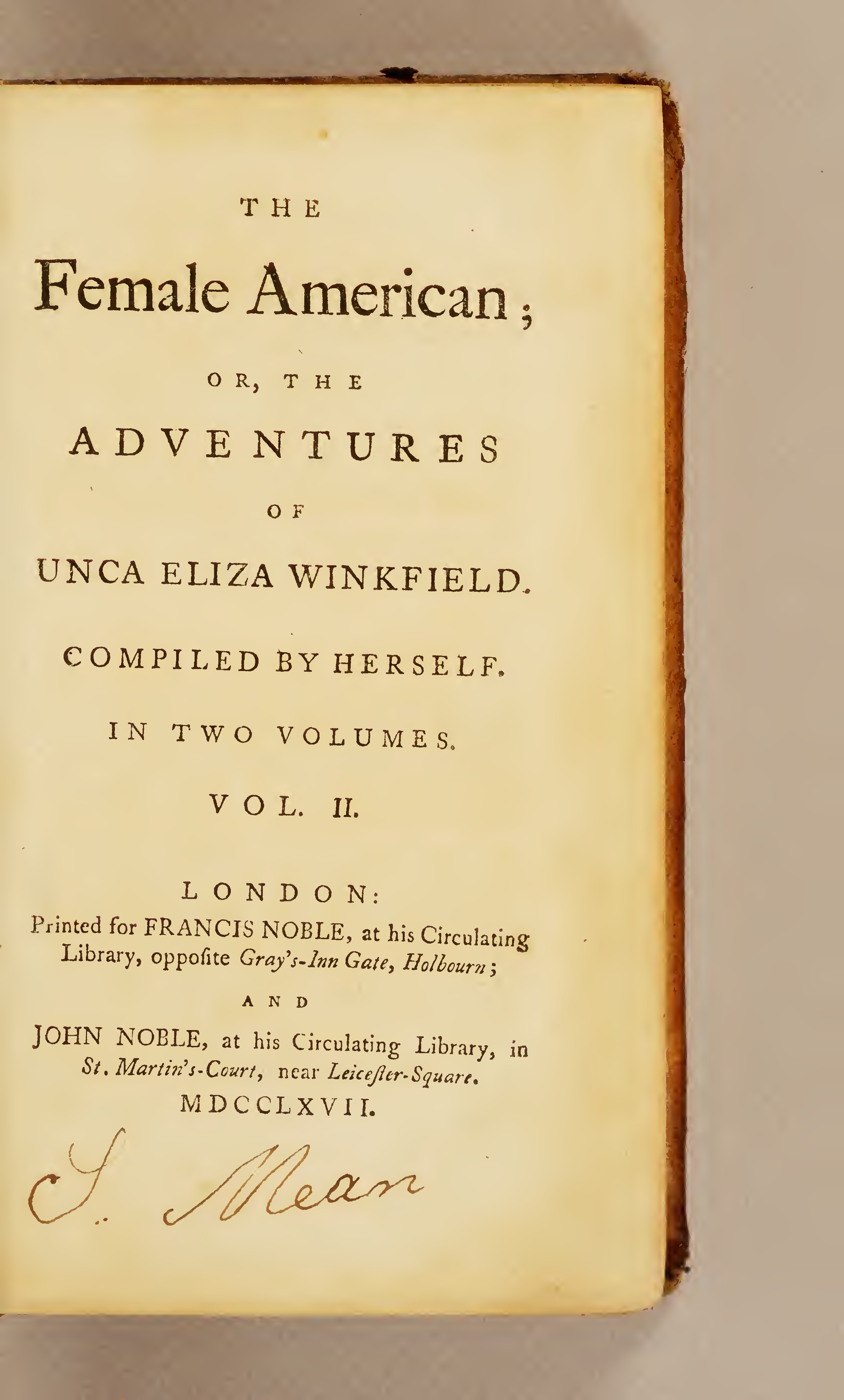











![Page 12 [page breaks after 'ren-']](https://anthologyassetsdev.lib.virginia.edu/winkfield-female-american-2/pageImages/012.png)
